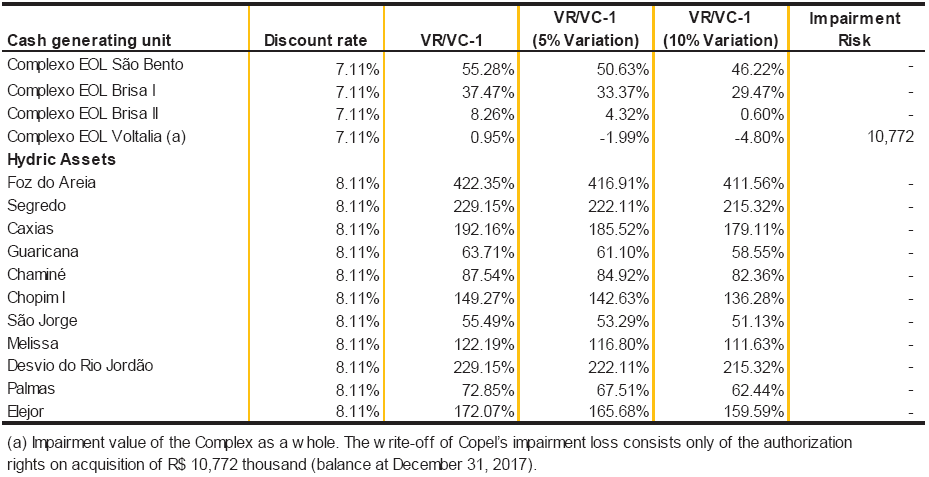
Companhia Paranaense de Energia
Corporate Taxpayer's ID (CNPJ/MF) 76.483.817/0001-20
State Registration 10146326-50
Publicly-Held Company - CVM 1431-1
www.copel.com copel@copel.com
Rua Coronel Dulcídio, 800, Batel - Curitiba - PR
CEP 80420-170
MANAGEMENT’S REPORT
2017

| | | | |
TABLE OF CONTENTS |
| |
| |
| MESSAGE FROM THE CEO | | | 3 |
| 1. | ORGANIZATIONAL PROFILE | | | 5 |
| 2. | GOVERNANCE AND SUSTAINABILITY | | | 10 |
| | 2.1.Governance, Risk and Compliance Management | | 10 | |
| | 2.2.Governance Structure | | 11 | |
| | 2.3.Integrity Practices | | 13 | |
| | 2.4.Sustainability Management | | 15 | |
| 3. | OPERATING PERFORMANCE | | | 17 |
| | 3.1.Macroeconomic analysis | | 17 | |
| | 3.2.Regulatory environment | | 18 | |
| | 3.3.Business Segments | | 24 | |
| 4. | ECONOMIC-FINANCIAL PERFORMANCE | | | 42 |
| | 4.1.Net Operating Revenue | | 42 | |
| | 4.2.Operating Costs and Expenses | | 44 | |
| | 4.3.EBITDA | | 46 | |
| | 4.4.Financial Result | | 47 | |
| | 4.5.Added Value | | 47 | |
| | 4.6.Debt | | 48 | |
| | 4.7.Net income | | 49 | |
| | 4.8.Non-Paying Consumers | | 50 | |
| | 4.9.Investment Program | | 51 | |
| | 4.10.Research & Development - R&D | | 51 | |
| | 4.11.Energy Efficiency Program – PEE | | 52 | |
| 5. | HUMAN RESOURCES | | | 53 |
| | 5.1.People Management | | 53 | |
| 6. | SOCIAL AND ENVIRONMENTAL PERFORMANCE | | | 57 |
| | 6.1.Suppliers | | 57 | |
| | 6.2.Customers | | 57 | |
| | 6.3.Community and Environment | | 58 | |
| 7. | COMPOSITION OF GROUPS RESPONSIBLE FOR GOVERNANCE | | | 67 |
| 8. | COMPOSITION OF GROUPS RESPONSIBLE FOR GOVERNANCE | | | 70 |
2

MESSAGE FROM THE CEO
The year 2017 proved once again the enormous resilience of the Brazilian electric sector to the conjuncture crisis. The opening of the discussion of a new regulatory framework and the incipient economic recovery fuel the expectation of the end of a long winter – both in the electric sector and in macroeconomics.
Copel responded to the challenges of the period in line with market expectations: with financial discipline, aggressive cost reduction program and commitment to consolidate its governance. These are the pillars of a management that has already begun to bear fruit, either through the institutional armor that will guarantee the continuity of its business, or by the positive results in all the areas in which it operates.
Our governance and compliance area, structured a year ago as an executive board, had enormous merit in the recent recognition by Transparency International of our practices to prevent corruption and in favor of transparency, benchmarks among Brazilian state-owned companies.
The recognition of one year of important achievements in the name of our long-term commitments, the most significant being the invitation from the United Nations Organization (UNO) in October to host the first regional center of the Global Compact Cities Program, an outpost of articulation of programs that will contribute to the global challenge of the Sustainable Development Objectives (SDO), in line with the Paraná Government's strategy to promote Agenda 2030 in all the 399 municipalities of the State.
In the same month of October, we joined the list of the 150 best companies to work for in Brazil, Guia Você S/A, a survey that testifies to the dedication and professionalism of each of our more than eight thousand employees, which is a result of their perception of the improvements implemented in recent years in people management.
Achievements like these once again guaranteed our presence in the exclusive B3's sustainability indexes, in ISE of FTSE4Good, of the London Stock Exchange, and in Morgan Stanley's MSCI ESG - ratings that place us among the most committed companies in the global utilities sector.
In economic and financial terms, we have been successful through the renegotiation of short-term debt and the strong investments made, even in a crisis scenario, to complete construction and start generating revenue from a series of major projects already in 2018: the hydroelectric power plants of Baixo Iguaçu and Colíder, as well as the Cutia Wind Complex, totaling 720 MW of installed capacity and more than 1,200 km of the Araraquara II-Taubaté transmission line between São Paulo and Bateias.
In 2017, a work program was also started between Paraná and Santa Catarina in the amount of R$ 500 million, and the Londrina - Assis and Figueira - Ponta Grossa Norte lines, important for energy exchange between the South and Southeast regions of Brazil, were completed. Our transmission assets currently exceed 4,400 km of lines throughout Brazil.
3

In the distribution segment, we have been successful in the research and application of new technologies for monitoring and automation of networks, mainly in the interior of Paraná. Even in a scenario of crisis and reduction of consumption, innovation has allowed us to reduce costs and promote indices of quality of supply at unprecedented levels in the State.
Parallel to the immediate implementation of smart grid solutions - which are bringing the quality of energy supplied to rural and urban areas within the scope of the Plus Clic Rural program - stand out the launching of a public call for partnerships with startups and ongoing research in the areas of energy storage and electric mobility, which already anticipate Copel's vision of acting, in the near future, as operator of a state system of distributed generation.
Reason for being of our distribution concessionaire, the satisfaction of the customers with the services of Copel led, for the sixth time in seven years, the survey of perception of the Abradee (Brazilian Association of Electric Energy Distributors) Award. In the same way, for the fifth time in seven years, we won the title of best distributor in Latin America in consumer opinion.
In addition to the significant and ongoing investment in distribution in recent years - more than R$ 4 billion since 2011 - the performance of our telecommunications subsidiary contributes to the strength of our brand. Customer satisfaction with Copel Telecomunicações, conquered by a fiber optic retail internet network that is the fastest in the country, reflects the management excellence we have been able to bring to bear recently at Copel, the results of which are disclosed in the accompanying report.
Curitiba, May 14, 2018.
Have a good reading.
Jonel Nazareno Iurk
4

1. ORGANIZATIONAL PROFILE
Copel was created in October 1954 and is the largest company in Paraná. It operates with state-of-the-art technology in the areas of generation, transmission, commercialization and distribution of energy, as well as telecommunications and natural gas.
It operates a comprehensive and effective electrical system with its own generator unit of power plants, transmission lines, substations, electric lines and networks of the distribution system and a modern optical telecommunications system that integrates all the cities of the State.
Although the Company is headquartered in Curitiba, Paraná, Copel is present in ten Brazilian states, according to the following map:

5

· Participation in the Market
| | | |
| Main products (%) | Brazil | South Region | Paraná |
| Electricity generation(1) | 3,7 | (2) (3)23,8 | (2) (3)52,7 |
| Electricity transmission(4) | 2.2 | 10,9 | 22,3 |
| Electricity distribution(5) | (6)6,2 | (6)33,8 | (7)97,6 |
| Gas distribution(7) | 3,2 | 25,3 | 100,0 |
| (1)Installed capacity. Equity interest of Copel and w ind farms are not included. | | | |
| (2)Itaipu Pow er Plant not included | | | |
| (3)Paranapanema river pow er plants not included | | | |
| (4)The market refers to Permitted Annual Revenues - RAP | | | |
| (5)Distribution w ire market | | | |
| (6)Source: Empresa de Pesquisa Energética - EPE | | | |
| (7)Estimated | | | |
· Awards and Certifications in 2017
| |
| Awards/Certifications | Certifier |
| | |
| Abradee Award -Social Responsibility | Brazilian Association of Electric Energy Distributors |
| Abradee Award for Customer Evaluation -Best distributor in Brazil | Brazilian Association of Electric Energy Distributors |
| Award -Best Distributor (gold category) | Regional Energy Integration Committee - CIER (Comisíon de Integración Energética Regional) Latin America |
| Selo Weather Parana Ouro | Government of the State of Paraná |
| |
| Award -150 Best Companies to Work For | Você S/A |
| Citizen Company Certificate -information presented in the Social Report | Regional Accounting Council of Rio de Janeiro, Sistema Firjan and Fecomercio |
| |
| 500 Largest Southern Award -Largest Paraná Company | Revista Amanhã |
| |
| 500 Largest Southern Prize -Highest Net Energy Sector Revenue | Revista Amanhã |
| Sesi Seal ODS -Recognition of practices in support of sustainable development objectives | Sesi Paraná |
| Recognition of good practice regarding the objectives of sustainable development | United Nations - UN |
| IASC Brazil Award- Concessionaires above 400 thousand consumer units | Aneel |
| IASC Sul Award -Concessionaires above 400 thousand consumer units | Aneel |
| |
| Award -Best companies to work for (9th place in Paraná) | Great Place to Work |
| |
| Award -Best in management | FNQ - National Quality Foundation |
6

· Strategic Reference
The guidelines expressed in the Company's strategic reference guide its management and all internal and external actions and decisions. They include:
Mission: Provide energy and sustainable development solutions.
Vision: To be a reference in the businesses in which it operates generating value in a sustainable way.
Values:
· Ethics: Result of a collective agreement that defines individual behaviors in line with a common goal.
· Respect for people: Taking others into account.
· Dedication: Ability to engage intensely and completely in the work contributing to the achievement of the organization's goals.
· Transparency: Accountability of the decisions and achievements of the company to report their positive or negative aspects to all stakeholders.
· Safety and Health: Healthy working environment in which workers and managers collaborate to use a process of continuous improvement of the protection and promotion of safety, health and well-being for all.
· Responsibility: Conduct the life of the company in a sustainable manner, respecting the rights of all stakeholders, including future generations and the commitment to support all life forms.
· Innovation: Applying ideas in processes, products or services in order to improve something that already exists or to build something different and better.
Organizational structure
The following chart shows the Company's shareholding structure on December 31, 2017:
7


8

· Copel in Numbers
| | | |
| In R$ thousands (except w hen stated otherwise) | 2017 | 2016 | Change % |
| Accounting Indicators | | | |
| Total assets | 33.162.377 | 30.288.900 | 9,5 |
| Cash and cash equivalents | 1.040.075 | 982.073 | 5,9 |
| Securities | 219.663 | 331.745 | (33,8) |
| Total debt | 9.830.483 | 8.837.102 | 11,2 |
| Net debt | 8.570.745 | 7.523.284 | 13,9 |
| Gross operating revenues | 21.574.289 | 21.061.792 | 2,4 |
| Deductions from revenues | 7.549.716 | 7.960.039 | (5,2) |
| Net operating revenues | 14.024.573 | 13.101.753 | 7,0 |
| Operating costs and expenses | 11.984.931 | 11.279.346 | 6,3 |
| Equity pick-up | 101.739 | 166.411 | (38,9) |
| Income from activities | 2.039.642 | 1.822.407 | 11,9 |
| EBITDA | 2.872.980 | 2.697.114 | 6,5 |
| Financial result | (748.440) | (594.656) | 25,9 |
| IRPJ/CSLL | 274.686 | 519.690 | (47,1) |
| Operating profit | 1.392.941 | 1.394.162 | (0,1) |
| Net income for the year | 1.118.255 | 874.472 | 27,9 |
| Shareholders' Equity | 15.510.503 | 14.978.142 | 3,6 |
| Interest on shareholders equity | 266.000 | 282.947 | (6,0) |
| Dividends | 23.401 | - | - |
| Economic and Financial Indicators | | | |
| Current liquidity (index) | 0,9 | 0,7 | 28,6 |
| Overall liquidity (index) | 0,8 | 0,8 | - |
| EBITDA Margin (%) | 20,5 | 20,6 | (0,5) |
| Earnings per share - Common shares | 3,60754 | 3,12641 | 15,4 |
| Earnings per share - Class "A" preferred shares | 3,96830 | 3,43906 | 15,4 |
| Earnings per share - Class "B" preferred shares | 3,96830 | 3,43906 | 15,4 |
| Equity value per share R$ (shareholders equity/number of shares) | 56,7 | 54,7 | 3,7 |
| Debt on shareholders' equity (%) | 63,4 | 59,0 | 7,5 |
| Operating margin (operating profit / net operating revenue) (%) | 9,9 | 10,6 | (6,6) |
| Net margin (net income/net operating revenues) (%) | 8,0 | 6,7 | 19,4 |
| Participation of third-party capital (%) | 53,2 | 50,5 | 5,3 |
| Return on shareholders' equity (%)(1) | 7,5 | 6,0 | 25,0 |
| (1)LL ÷ (initial PL) | | | |
9

2. GOVERNANCE AND SUSTAINABILITY
Copel's governance model is guided by principles of transparency, equity, accountability and corporate responsibility, according to the best market practices and seeking the best results for the stakeholders. The Company’s corporate governance practices comply with the requirements set for companies listed at B3’s governance level 1, with reference to the Code of Best Practices of Corporate Governance of the Brazilian Institute of Corporate Governance - IBGC.
Copel is guided by values described in its strategic reference, in its Corporate Governance Policy and in its Code of Conduct – all approved by senior management -, in addition to respecting the Global Pact Principles.
2.1. Governance, Risk and Compliance Management
Copel’s Governance, Risk and Compliance Board - DRC, created at the end of 2016, performed with all the Company areas in order to improve governance practices in seeking the best results for stakeholders.
In association with Copel University - Unicopel, the DRC held training sessions that educated senior management and employees to perform according to the legislation in force, the best practices and the rules of the Company itself.
10

2.2. Governance Structure
The Company's governance structure on December 31, 2017 is as follows:
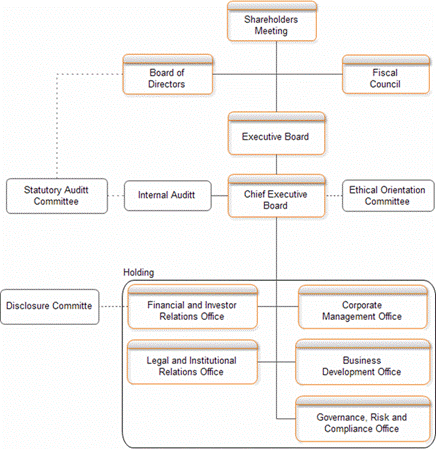

General shareholders’ meeting
It is the forum in which the shareholders decide business guidelines and make strategic decisions.
Fiscal Council
Permanent body that examines the financial statements, gives opinions on the management's report, capital modification, capital budget, dividends distribution and oversees the work of the management. It has five sitting members and five alternates with a one-year term.
11

Board of Directors - BOD
The Board of Directors resolves and sets the overall guidance on business, is responsible for submitting the articles of incorporation to be approved by the General Meeting of Shareholders and for approving the bylaws of the Board of Directors, which set out the matters concerning the economic, environmental and corporate topics for senior executives and other employees of the Company.
The BOD members are selected and appointed in accordance with the rules set forth by Copel’s Corporate Governance Policy and with the legislation in force, made up of nine members, with a two-year term.
Executive Board gathered
The Board fulfills executive duties and applies the Company strategy, including topics involving economic, corporate and environmental issues, pursuant to the articles of incorporation. The Board meets fortnightly, and minutes are drawn up in an own book, reporting to the Board of Directors in accordance with the bylaws. Members are as follows: the chairman, five officers and a deputy officer, with two-year term, after the meeting to elect the Board of Directors, three consecutive reelections being allowed.
Audit Committee
Independent, advisory and standing committee that assists the Board of Directors, engaged mainly in the inspection, review, supervision, monitoring and, where applicable, presentation of recommendations on the Company’s activities. It is also responsible for monitoring the Confidential Communication Channel.
The Committee holds ordinary meeting at least six times a year, according to a preset schedule. Special meetings may also be held, if necessary, with a member of the Boards, of the Independent Audit, of the Internal Audit or of the Fiscal Council.
It is made up of five independent members of the board of directors, as set forth by Rule 10A-3 of the Securities Exchange Act, with a two-year term.
Board of Ethical Guidance - BEG
An administrative board connected to the Presidency, with the duty to contribute with the Company's performance to be permanently driven by ethical principles in the development of its business. It has eleven officers, of whom ten are Copel's employees and one is a representative of the civil society.
Committee of disclosure of material acts and facts
It has thirteen members and supports the Finance and Investor Relations Office in the practice of the Policy for Disclosure of Relevant Information and the Policy for Trading Company's Shares, pursuant to CVM Instruction 358/2002.
12

2.3. Integrity Practices
Copel is committed to the integrity practices and acts for all stakeholders to keep abreast of their ethical principles and the legislation in force. The Company’s integrity practices aim to guarantee that its business is done with transparency and legality, relying on a number of structures and adopting internal tools, made available in the Portal Compliance.
· Integrity Program
The Integrity Program is a platform for disseminating the Company's commitments to transparency and the fight against corruption. In 2017, Copel’s revised Integrity Program was published. The disclosure and dissemination of contents are digitally made from time to time across the Company, and the contents can be accessed through Copel’s internal and external online channels.
In the period under analysis, 8,200 employees took part in the training sessions for dissemination of the Integrity Program. The matters of courses were General Aspects of the Law and of the Anticorruption Decree, Code of Conduct, Risk Management based on ISO 31000 and Risk Management – GRC Methodology and Tool.
The Company’s senior management was given an in-person training on the Anticorruption Law, State-run Companies Law, Corporate Governance, Corporate Strategy, Internal Control and Strategic Management of Corporate Risks.
· Code of Conduct
The Code of Conduct is a key instrument in the fight against corporate corruption, setting the corporate and individual responsibilities. Copel implemented its Code of Conduct in 2003 and keeps it updated through periodic revisions reported to all the Company areas by emails and in the Portal Compliance.
· Corruption Risk Assessment
As part of its Policy of Integrated Management of Corporate Risk, Copel seeks to ensure a constant monitoring of the threat of corruption within the Company and of fraud in the internal control environment.
Due to these safety criteria, all operational processes are annually submitted to the evaluation of risks related to errors or fraud, which may interfere with the results of the financial statements. In this respect, established controls are submitted to tests by the Internal Audit and by the Independent Audit, the results of which are reported to senior management.
13

· Reporting channels
In order to receive opinions, criticisms, complaints, claims and personal inquiries, Copel provides communication channels that, in addition to contributing to the fight against fraud and corruption, also expand the organization's relationship with its stakeholders. They are:
· Confidential Communication Channel: intended to receive complaints and communications of noncompliance with laws and regulations, especially of fraud or irregularities involving issues on the area of finance, auditing or accounting. The channel guarantees protection, preservation of the identity of the person making the claim and an answer to the complaint. It is available 24 hours a day, seven days a week, toll-free call. Phone Number: 0800 643 5665 .
· Ombudsman: There are two channels open to all stakeholders, internal and external, for suggestions, claims and complaints, and are available on weekdays, from 8am to 6pm, with toll-free call. The Copel Distribuição Ombudsman is available through the phone number 0800 647 0606 and also through the email ouvidoria@copel.com. In addition, it can receive the complaints in person or through correspondence sent to its address at Rua Professor Brasílio Ovidio da Costa, 1703, in the Santa Quitéria Neighborhood, CEP: 80310-130, in Curitiba - PR. The Copel Telecomunicações Ombudsman is available through the phone number 0800 649 3949 and through the email ouvidoriatelecom@copel.com., able to receive the complaints in person or through correspondence sent to its address, at Rua Emiliano Perneta, 756, Batel Neighborhood, CEP: 80420-080, in Curitiba - PR.
· Commission for analysis of complaints of harassment - CADAM: assists and supports every employee who is a victim of bullying in his or her work environment. The information is confidential and both the complainant and the respondent have a guarantee of identity preservation. Email:cadam@copel.com
· Ethics Guidance Board – EGB assesses and issues guidance on processes related to ethical conduct in the Company and has a maximum deadline of 90 days to provide a final answer. Email:conselho.etica@copel.com
· External Audit
Under the terms of Instruction 381/2003 of the Brazilian Securities and Exchange Commission, in an internal Corporate Governance standard and under the review and supervision of the Audit Committee, the Company and its wholly-owned subsidiaries have a contract with Deloitte Touche Tohmatsu Auditores Independentes since March 21, 2016, to provide audit services of the financial statements,being that the work necessary for the evaluation of the fiscal year will extend until June 30, 2018, date that will correspond to its final term, and may be formally extended in up to 36 months.
14

Every five years, following the criterion of rotation of the independent auditors according to CVM Instruction 308/99, the Company changes the company responsible for auditing its financial statements.
The amount contracted for the 2017-2018 period was of R$2.6 millionand the total gross amount paid for external audit services rendered in 2017 was R$1.7 million.
When hiring other services from its external auditors, the Company's practice of action foresees the prior review by the Audit Committee of the Board of Directors, which should take into account in this evaluation if the relationship or a service rendered by an independent auditor:(a) creates conflicting interests with its audit client; (b) puts them in a position to audit their own work; (c) results in working as manager or as employee of the audit client; or (d) puts them in a position of being an advocate to the audit client.
The Audit Committee also considers in this type of assessment if any service rendered by the independent audit firm may impair, in fact or apparently, the firm's independence.Whenever necessary, the Audit Committee can count on the technical support of the Internal Audit or also of an independent advisory service for a technical evaluation that may be required in each specific case, with this hiring of an independent advisory service being recorded in the minutes of the meetings of these boards.
2.4. Sustainability Management
The challenges of sustainability are part of Copel's strategic reference contained in the mission and vision of business. The permanent search for improving the performance of the area of sustainability, as well as its communication with stakeholders and the management of matters and indicators are steps of this strategy.
All of this work involves some of the main market practices to direct and assess their performance, as well as compare their practices with world and national references: RobecoSAM questionnaire (Dow Jones Sustainability Index - DJSI), Ethos Indicators for Sustainable and Responsible Business Models, and Corporate Sustainability Index (ISE – B3). To report their performance and engage their stakeholders, the Sustainability Management also adopts references such as Global Reporting Initiative - GRI, Integrated Reporting – IR, Carbon Disclosure Project - CDP and Global Greenhouse Gas Protocol – GHG.
One of the results of Copel's actions was the Company remaining in the group of the most sustainable companies of the São Paulo Stock Exchange (B3). The Company has been part of the ISE portfolio since its creation in 2005. Copel was included in twelve of the thirteen editions of the index.
The Company also continued in the sustainability index of the Morgan Stanley Capital International MSCI, the world leader in the composition of financial indices that work as a reference for investors. The MSCI ESG seal is awarded to companies with excellent performance in the corporate, environmental and corporate governance areas.
15

In 2017, Copel started being listed by FTSE 4Good Emerging Index, a tool for investors, prepared by FTSE, an independent provider of stock market indices comprising the Financial Times and the London Stock Exchange, which gauges the performance of companies in the environmental, corporate and governance realms.
· Southern Brazil UN Global Compact – Cities Program
Since November 2017 Copel has been hosting and coordinating the Southern Brazil UN Global Compact – Cities Program. It performs in association with the State Council for Economic and Social Development of Paraná – CEDES and the Autonomous Social Service Paranacidade. The office duties include: develop actions and projects of multiple associates that promote the Sustainable Development Objectives - ODS of Agenda 2030 of the United Nations Organization; and work in alignment with other UNO agencies that operate in Brazil and in Latin America to advance ODS, including the Local Networks of the Global Pact.
· Voluntary Commitments
Copel — committed to the sustainable development — has made several voluntary commitments throughout its history, namely:
· Global Pact
· National Movement ODS We Can
· Business Contribution for the Promotion of the Green and Inclusive Economy
· Statement Call to Action for Governments in the Fight against Corruption
· Business Pact for Integrity and Against Corruption
· Eradication of Child Labor, Forced Labor or Compulsory Labor
· Fighting Sexual Exploitation of Children and Teenagers
· Fighting the Practice of Discrimination and Valuing Diversity
· Preventing Moral Harassment and Sexual Harassment
· Respecting the Right of Free Association and the Right of Collective Bargaining
· Principles for Sustainable Business Education - PRME
16

3. OPERATIONAL PERFORMANCE
3.1. Macroeconomic analysis
The world economy kept the pace of growth seen in the first months of the year, and it is expected to grow by nearly 3.7%1 by the end of 2017. The fear of an accelerated slowdown in China’s economy turned out to be exaggerated and, together with the behavior of developed economies, set up a situation of synchronized expansion in the world that was not seen since before the international financial crisis. This has been reflected on the expansion of foreign trade and on the increase in capital flows towards emerging countries. The United States of America led the growth among developed countries, securing a robust recovery relying on the increase in consumption and on the strong pace of growth of non-household investments, even taking into consideration the trail of destruction by the hurricanes that hit the U.S. states of Texas and Florida in late August and early September 2017. In the euro zone, the growth seems to be consolidated, with a highlight for the economies of Germany and France. In China, the data of the level of the economic activity also show that the pace of growth is still strong, with a projected growth of 6.9% for 2017.
In the domestic market, the year was marked by the end of recession, but the economy still recorded effects of the crisis, with interruption of public services due to the lack of resources and the critical situation of public accounts of some states. After accumulating a GDP decrease by 7.0% between 2015 and 2016, the Brazilian economy showed signs of recovery since the last quarter of 2016, and consolidated in the first half of 2017. Despite the various indices for longer and still unfavorable periods, it is undeniable the accumulation of positive production indicators in the very short term. While the industry migrates from a strong negative to a positive performance, trading attempts a similar move. The Company also witnesses positive effects of the inflicted crisis,as the strong reduction in negative balances in current transactions of the balance of payments, and others relating to the drop in inflation and easing in nominal interest rates, with the SELIC rate dropping from 14% to 7.0%. By the way, the last two moves allowed a certain recovery of average output of work and of the real income mass, the extension of which for a longer period should represent a significant part of the prospective growth of consumption levels. In this scenario, the national economy recorded an expansion of 1.0% in 2017.
The Paraná has been recording a more vigorous recovery, especially in its transformation industry, including exports. This recovery is partially linked to foreign trade, since exports by the State accumulated expansion of 19.2%, repositioning as the fourth biggest exporter in Brazil in 2017. These trends include the agribusiness performance, which grew by 11.5% versus 2016, thanks to the bumper crop and high productions of soybean, corn, coffee, beans and tobacco. Another positive factor was the industry, which expanded by 1.8%, thanks to the results of machinery and equipment, transportation material and spare parts. Accordingly, the state GDP more than doubled the Brazilian average, recording a 2.5% growth, consolidating the upturn in the economy.
1 International Monetary Fund - World Economic Outlook - WEO
17

3.2. Regulatory environment
Since 2013, the Brazilian electricity sector faces a major crisis that can be divided into three distinct moments: (a) from 2013 onwards, a period of hydrological restrictions, which hindered the production of electricity in the National Interconnected System (SIN); (b) the financial de-restructuring of generation and distribution agents due to the exposure to the short-term market, followed by a strong judicialization, practically halting operations in the national energy market from the end of 2014; (c) renegotiation of the liabilities hired by the agents in this period and attempt to unlock the segment.
In this context, 2015 was a year in which the Brazilian electricity sector had its regulatory environment strongly influenced by the search for solutions to equation this third phase of the crisis.
Following these changes, in 2017 Public Hearing No. 33/2017 was opened in order to improve the legal framework of the Brazilian electricity sector. After the time period for comments from agents, the Ministry of Mines and Energy - MME prepared a document together with a set of proposals to be submitted to the National Congress. The MME comments include: improvements in pricing and market operation, insourcing of environmental external factors regarding emissions, separation of indirect guarantee of assured power and energy, expansion of the free market and changes in the assignment of risks arising from decisions on power delivery on regulated contracting.
· Rationing Risk
Approximately 64%2 of Brazil's capacity currently comes from hydroelectric generation, which makes Brazil and the geographic region in which we operate to be subject to hydrological conditions that are unpredictable due to non-cyclical deviations from average rainfall. Among other things, unfavorable hydrological conditions may lead to comprehensive electricity saving programs such as a rationalization or even mandatory reduction of consumption, which is the case of rationing.
Since 2016, the major water basins of Brazil, where the reservoirs of the Southeast/Midwest and Northeast regions are located, experienced adverse weather situations. Beginning 2017, however, the Southeast/Midwest subsystem recorded a relative improvement, with a slight uptick in the levels of reservoirs. In view of this, the Electricity Sector Monitoring Committee – CMSE highlighted that for 2018 the SIN electroenergetic supply is guaranteed, and the thermal power stations deliver energy in order of merit of cost, within the risk of rationing ranging between 0.0% and 0.6%.
2 Generation Information Bank - Aneel
18

Although the stocks stored in reservoirs are not ideal, from the point of view of regulators, when combined with other variables, they are enough to maintain the risk of deficit within the safety margin established by the National Council for Energy Policy - CNPE (maximum risk of 5.0%) in all subsystems.
· Extension of Concessions
Concerning the extension of the concessions delegated to Copel, it is important to note that, in 2012, a new regulation was established for concessions in the electric energy sector, in which the concession wasextended, provided that several concessions are accepted by the Concessionaire Grantor. At that time, MP 579/2012 was published, later converted into Law 12,783/2013, which provided, among others, for the treatment to be given to the generation, transmission and distribution concessions under articles 17, 19 and 22 of Law 9,074/1995, whose maturity would initially be between 2015 and 2017 and which had already undergone a single extension. This rule also remains valid for the concessions that will expire as of this date.
Generation Concessions
For the concessions of generation, an extension of up to 30 years was established. The extension was granted to the concessionaire and its adoption depended, in addition to the acceptance of anticipation of the original term of its concession, also the express acceptance of the following conditions: (a) remuneration per rate calculated by Aneel for each hydroelectric plant; (b) allocation of quotas of physical guarantee of energy and power of the hydroelectric plant to the concessionaires and permissionaires of the public electricity distribution service of the SIN, to be established by the regulatory agency, according to the regulation of the granting authority; and (c) compliance with the quality of service standards established by Aneel.
Copel Geração e Transmissão, after learning the conditions for the extension, carried out the possible analyses, concluded that it was not feasible to adopt the extension at that moment of the concessions of generation of its four plants due between 2014 and 2015: Rio dos Patos with 1.8 MW of installed capacity, Governador Pedro Viriato Parigot de Souza Plant with 260.0 MW, Mourão with 8.2 MW and Chopim I with 1.8 MW.
Subsequently, MP 688/2015, among other matters, changed the conditions for the renewal of the concession of these plants, which became subject to an auction, being disputed through the highest grant bonus to be offered by the concessionaire in comparison with the lower revenue required. Thus, on November 25, 2015, Auction 12/2015 was held, in which the plants of Mourão and Governador Pedro Viriato Parigot de Souza were offered. After the event, Copel Geração e Transmissão was the winner in Lot B1, in which the HPP Governador Pedro Viriato Parigot de Souza was tendered, thus renewing the concession of the plant for another 30 years. For the Mourão plant, Copel Geração e Transmissão did not present a proposal, being taken over by another concessionaire.
19

As for the Chopim I plant, after the concession was terminated, it became recorded by Copel Geração e Transmissão, pursuant to Law 12,783/2013. Rio dos Patos, in turn, is subject to the quota system introduced by the same law.
The next plant to have its concession expired is TPP Figueira, which has its contractual term scheduled for March 26, 2019. On March 24, 2017, Copel already filed with Aneel its intention to extend the granting of the generation concession of the TPP; however, it highlighted that it will sign the necessary agreements and/or amendments only after knowing and accepting the contractual terms and rules that will guide all process related to the extension of the grant. TPP Figueira has an installed capacity of 20 MW and is currently undergoing a modernization process.
Decree 9,271, recently published on January 25, 2018, opened up the possibility of renewing the concession for up to 30 years for projects with an agreement for concession of public generation service that have been privatized up to 60 months of the inception of the agreement or of the act of grant. In exchange, a grant bonus shall be paid to the federal government, to be calculated with basis on the value of the benefit obtained from the new agreement, with payments proportional to this additional period.
Transmission Concessions
For the concessions of transmission, an extension of up to 30 years was established. The extension was granted to the concessionaire and its adoption depended, in addition to the acceptance of anticipation of the original term of its concession, also the express acceptance of the following conditions: (i) fixed revenues determined in accordance with criteria set by ANEEL; and (ii) submission to levels of service quality set by Aneel.
Having been informed of the conditions for extension, and analyzed and evaluated them, Copel Geração e Transmissão opted for extending its transmission agreement. However, the extension failed to take into account several investments made by concessionaires that were not reimbursed by the concession granting authority. Normative Resolution 589 issued in 2013 set rules for indemnifying investments not yet amortized and/or depreciated existing on May 31, 2000, which were designated as Basic Network of the Existing System - RBSE and RPC (connection and other transmission facilities).
On April 20, 2016, the MME published Ordinance 120/2016 which presented the guidelines for the payment of the indemnities related to the appraisal report on the assets of RBSE and RPC of Copel Geração e Transmissão, which should be recognized from the 2017 tariff cycle.
20

Aneel Resolution 1,272, published on May 9, 2017, validated the appraisal report for R$ 667.6 million, at amounts ruling in December 2012, corresponding to the portion of reversible assets not yet amortized for purposes of compensation to Copel Geração e Transmissão. This amount will be received through two means: in 8 years for the period between 2013 and June 2017, and from July 2017 to the end of the useful life of the assets, limited to the end of the concession agreement. These updated amounts incorporated into the Annual Revenue Allowed – RAP of the transmission concession agreement 060/2001 as of July 2017.
Distribution Concessions
Another matter that called attention in the regulatory environment and that strongly affects the business was the renewal of electricity distribution concessions. A Ministry of Mines and Energy order issued on November 9, 2015 granted the request for extension of Copel Distribuição concession and in early December 2015 the fifth amendment was entered into, formalizing the extension of the Agreement for Public Service Concession for Distribution of Electricity No. 46/1999 until July 7, 2045.
The fifth amendment imposes conditions related to indicators of quality of service and economic and financial sustainability, which will be supported by an investment program focusing automation and new technologies, full implementation of tariff adjustments approved by ANEEL, and the implementation of corporate governance structure defined by Aneel Normative Resolution 787, of October 24, 2017, effective as from January 1, 2018, ensuring the protection and individualization of Copel Distribuição.
The following chart shows the goals set for Copel Distribuição in the first five years of renewal:
| | | | | |
| Year | Economic and Financial Management | Quality - limits(a) | Quality - accomplished |
| | | DECi(b) | FECi(b) | DECi | FECi |
| 2016 | - | 13,61 | 9,24 | 10,80 | 7,14 |
| 2017 | EBITDAe0(d) | 12,54 | 8,74 | 10,41(c) | 6,79(c) |
| 2018 | EBITDA (-) QRRe0(e) | 11,23 | 8,24 | - | - |
| 2019 | {Net Debt / [EBITDA (-) QRRe0]}d1 / (0,8 * Selic)(e) (f) | 10,12 | 7,74 | - | - |
| 2020 | {Net Debt / [EBITDA (-) QRRe0]}d1 / (1,11 * Selic)(e) (f) | 9,83 | 7,24 | - | - |
| (a)According to NT 0335/2015 Aneel. | | | | |
| (b)DECi - Equivalent Duration of Interruption of Internal Origin per Consumer Unit; and FECi - Equivalent Frequency of Interruption of Internal Origin per Consumer Unit. |
| (c)Preliminary data. | | | | |
| (d)Amount w ill be presented in the Regulatory Accounting Statement. | | | | |
| (e)QRR: Regulatory Reintegration Quota or Regulatory Depreciation Expenses. It w ill be the value defined in the last Periodic Tariff Review - RTP, plus the IPCA betw een the month prior to RTP and the month prior to the 12-month period of the economic-financial sustainability measurement. |
| (f)Selic: limited to 12.87% a.a. | | | | |
The Company reiterates its commitment to the economic sustainability of the concession and continued investments backed by management's efforts to cut costs, maximize productivity and improve operational efficiency.
21

Gas Concessions
Companhia Paranaense de Gás - Compagas is a party to an agreement that grants and regulates the concession for public services of piped gas in the State of Paraná, with an effective period of 30 years, which may be extended for the same period through a request by the Concessionaire.
The subject matter of the concession is the exploitation of services for distribution of piped gas and other related activities, to be used by all consuming market segments, whether as a raw material or for generation of energy or other purposes allowed by technological advances.
The gas concession agreement falls within the bifurcated model, in which a portion of investments made by the concessionaire is compensated by the public service users, while the other part is compensated by the Granting Power, i.e. the State of Paraná, at the end of the concession.This model establishes the recognition of a financial asset and of an intangible asset.
As presented in Note 2.1.1, the expiration date of the gas distribution concession of the subsidiary Compagás is under discussion with the granting authority.
In the event of non-extension of the concession, Compagás will be entitled to indemnification for investments made in the last 10 years prior to the end of the concession at its depreciated replacement value, according to the contractual forecast.
22

· Energy Flow (% and GW/hour)
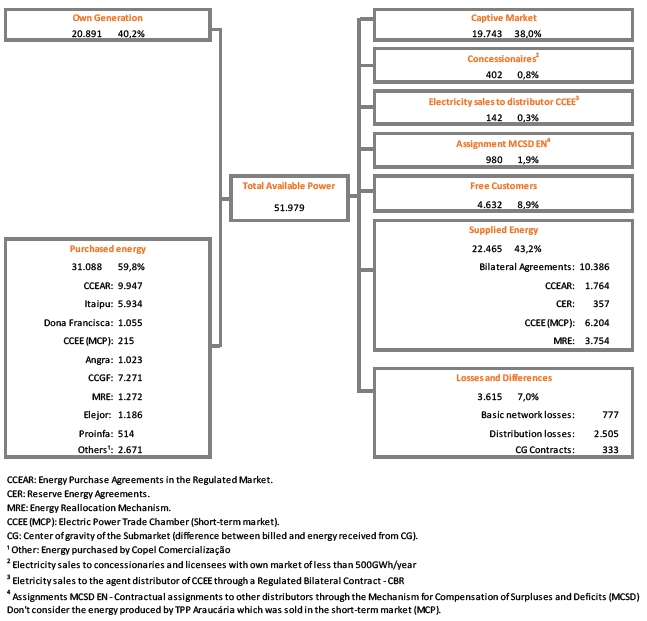
23

3.3. Business Segments
3.3.1. Generation
Copel operates 28 plants of its own and has ownership interests in another 3. Of the total, 17 are hydroelectric, 12 wind powered and 2 thermoelectric plants, with total capacity of 5,313.4 MW and physical guarantee of 2,430.3 MW on average, as shown below:
Plants in Operation - Physical Characteristics
| | | | | | | |
| Developments | Installed
Capacity
(MW) | Physical
Assurance
(Average MW) | Ownership % | Proportional
Installed
Capacity
(MW) | Proportional
Physical
Assurance
(Average MW) | Start of
Commercial
Operations | Concession
expires on |
| Hydroelectric Power Plants | | | | | | | |
| UHE Gov. José Richa (Salto Caxias)(1) | 1.240,0 | 605,6 | 100% | 1.240,0 | 605,6 | 18.02.1999 | 04.05.2030 |
| UHE Gov. Ney Aminthas de Barros Braga (Segredo)(1) | 1.260,0 | 578,5 | 100% | 1.260,0 | 578,5 | 29.09.1992 | 15.11.2029 |
| UHE Gov. Bento Munhos da Rocha Netto (Foz do Areia)(1) | 1.676,0 | 603,3 | 100% | 1.676,0 | 603,3 | 01.10.1980 | 17.09.2023 |
| UHE Gov. Pedro Viriato Parigot de Souza (GPS) | 260,0 | 109,0 | 100% | 260,0 | 109,0 | 03.09.1971 | 05.01.2046 |
| UHE Gov. Jayme Canet Júnior (Mauá) | 361,0 | 197,7 | 51% | 184,1 | 100,8 | 23.11.2012 | 02.07.2042 |
| UHE Guaricana | 36,0 | 16,1 | 100% | 36,0 | 16,1 | 26.09.1957 | 16.08.2026 |
| UHE Chaminé | 18,0 | 11,6 | 100% | 18,0 | 11,6 | 15.03.1931 | 16.08.2026 |
| PCH Cavernoso II | 19,0 | 10,5 | 100% | 19,0 | 10,5 | 15.05.2013 | 27.02.2046 |
| UHE Apucaraninha | 10,0 | 6,7 | 100% | 10,0 | 6,7 | 06.04.1949 | 12.10.2025 |
| UHE Derivação do Rio Jordão | 6,5 | 5,9 | 100% | 6,5 | 5,9 | 02.12.1997 | 15.11.2029 |
| UHE Marumbi | 4,8 | 2,4 | 100% | 4,8 | 2,4 | 05.04.1961 | (2) |
| UHE São Jorge | 2,3 | 1,5 | 100% | 2,3 | 1,5 | 01.01.1945 | 03.12.2024 |
| CGH Chopim I | 2,0 | 1,5 | 100% | 2,0 | 1,5 | 28.05.1963 | (3) |
| UHE Cavernoso | 1,3 | 1,0 | 100% | 1,3 | 1,0 | 08.12.1965 | 07.01.2031 |
| CGH Melissa | 1,0 | 0,6 | 100% | 1,0 | 0,6 | 31.01.1966 | (3) |
| CGH Salto do Vau | 0,9 | 0,6 | 100% | 0,9 | 0,6 | 03.12.1959 | (3) |
| CGH Pitangui | 0,9 | 0,1 | 100% | 0,9 | 0,1 | 09.07.1911 | (3) |
| Total Hydroelectric Power Plants | 4.899,7 | 2.152,6 | | 4.722,8 | 2.055,7 | | |
| Wind Energy Plants | | | | | | | |
| Santa Maria | 29,7 | 15,7 | 100% | 29,70 | 15,7 | 23.04.2015 | 07.05.2047 |
| Santa Helena | 29,7 | 16,0 | 100% | 29,70 | 16,0 | 06.05.2015 | 08.04.2047 |
| Olho d'Água | 30,0 | 15,3 | 100% | 30,00 | 15,3 | 25.02.2015 | 31.05.2046 |
| São Bento do Norte | 30,0 | 14,6 | 100% | 30,00 | 14,6 | 25.02.2015 | 18.05.2046 |
| Eurus IV | 27,0 | 14,7 | 100% | 27,00 | 14,7 | 20.08.2015 | 26.04.2046 |
| Asa Branca I | 27,0 | 14,2 | 100% | 27,00 | 14,2 | 05.08.2015 | 24.04.2046 |
| Asa Branca II | 27,0 | 14,3 | 100% | 27,00 | 14,3 | 15.09.2015 | 30.05.2046 |
| Asa Branca III | 27,0 | 14,5 | 100% | 27,00 | 14,5 | 04.09.2015 | 30.05.2046 |
| Farol | 20,0 | 10,1 | 100% | 20,00 | 10,1 | 25.02.2015 | 19.04.2046 |
| Ventos de Santo Uriel | 16,2 | 9,0 | 100% | 16,20 | 9,0 | 22.05.2015 | 08.04.2047 |
| Boa Vista | 14,0 | 6,3 | 100% | 14,00 | 6,3 | 25.02.2015 | 27.04.2046 |
| Palmas | 2,5 | 0,5 | 100% | 2,50 | 0,5 | 12.11.1999 | 28.09.2029 |
| Total Wind Energy Plants | 280,1 | 145,2 | | 280,1 | 145,2 | | |
| Thermal Power Plants | | | | | | | |
| UTE Figueira | 20,0 | 10,3 | 100% | 20,0 | 10,3 | 08.04.1963 | 26.03.2019 |
| UTE Araucária | 484,1 | 365,2 | 60% | 290,5 | 219,1 | 27.09.2002 | 22.12.2029 |
| Total Thermal Power Plants | 504,1 | 375,5 | | 310,5 | 229,4 | | |
| |
| Total Sources | 5.683,9 | 2.673,3 | | 5.313,4 | 2.430,3 | | |
| (1)Physical Guarantee as a result of the new amounts established by Ordinance MME nº 178 of 03.05.2017, w ith effect from 01.01.2018 | |
| (2)In the process of homologation at ANEEL. | | | | | | | |
| (3)Registration according to Aneel Order n° 182/2002 and Aneel Resolution n° 5373/2015. | | | | |
24

To fulfill important strategic and sustainability guidelines established for the generation business, the Company's main purpose is to profitably and sustainably boost the share of renewable alternative sources in the energy mix.
The composition of the generating park by source is as follows:
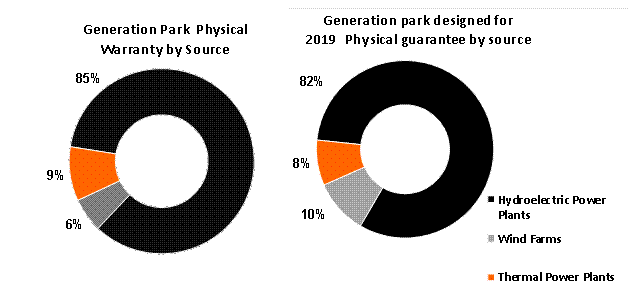
Currently, the Company is focusing its efforts on the construction of 15 plants, which will add 716.8 MW of installed capacity and 355.3 MW on average of physical guarantee to the generator park, with 80% of this physical guarantee expected to start the commercial operation during 2018, according to the table:
25

Power Plant Projects under Construction - Physical Characteristics
| | | | | | | | |
| Development | Installed
Capacity
(MW) | Physical
Assurance
(average MW) | | Ownership % | Proportional
Installed
Capacity (MW) | Proportional
Physical
Assurance
(Average MW) | Commercial
Operations
expected toÂ
start on | Concession
expires on |
| Hydroelectric Power Plants | | | | | | | | |
| UHE Colíder | 300,0 | 178,1 | (1) | 100% | 300,0 | 178,1 | jun/2018 | 16.01.2046 |
| UHE Baixo Iguaçu | 350,0 | 171,3 | (2) | 30% | 105,0 | 51,4 | nov/2018 | 13.09.2049(3) |
| Total Hydroelectric Power Plants | 650,0 | 349,4 | | | 405,0 | 229,5 | | |
| Wind Energy Plants | | | | | | | | |
| GE Maria Helena | 27,3 | 12,0 | | 100% | 27,3 | 12,0 | jul/2018 | 04.01.2042 |
| Potiguar | 27,3 | 11,5 | | 100% | 27,3 | 11,5 | jul/2018 | 10.05.2050 |
| Paraíso dos Ventos do Nordeste | 27,3 | 10,6 | | 100% | 27,3 | 10,6 | jul/2018 | 10.05.2050 |
| GE Jangada | 27,3 | 10,3 | | 100% | 27,3 | 10,3 | jul/2018 | 04.01.2042 |
| Cutia | 23,1 | 9,2 | | 100% | 23,1 | 9,2 | jul/2018 | 04.01.2042 |
| Esperança do Nordeste | 27,3 | 9,1 | | 100% | 27,3 | 9,1 | jul/2018 | 10.05.2050 |
| Guajiru | 21,0 | 8,3 | | 100% | 21,0 | 8,3 | jul/2018 | 04.01.2042 |
| São Bento do Norte I | 23,1 | 9,7 | | 100% | 23,1 | 9,7 | jan/2019 | 03.08.2050 |
| São Bento do Norte II | 23,1 | 10,0 | | 100% | 23,1 | 10,0 | jan/2019 | 03.08.2050 |
| São Bento do Norte III | 22,0 | 9,6 | | 100% | 22,0 | 9,6 | jan/2019 | 03.08.2050 |
| São Miguel I | 21,0 | 8,7 | | 100% | 21,0 | 8,7 | jan/2019 | 03.08.2050 |
| São Miguel II | 21,0 | 8,4 | | 100% | 21,0 | 8,4 | jan/2019 | 03.08.2050 |
| São Miguel III | 21,0 | 8,4 | | 100% | 21,0 | 8,4 | jan/2019 | 03.08.2050 |
| Total Wind Energy Plants | 311,8 | 125,8 | | | 311,8 | 125,8 | | |
| |
| Total Sources | 961,8 | 475,2 | | | 716,8 | 355,3 | | |
| (1)Physical guarantee revised by virtue of the new amounts established by the Ordinance of the Secretariat Planej. and Develop. Energetic nº 258/2016. |
| (2)Physical guarantee revised by virtue of the new amounts established by the Ordinance of the Secretary Planej. and Develop. Energetic nº 11/2017. | |
| (3)According to the 2nd Addendum to the Concession Agreement, w hich considers the exclusion of responsibility for 756 days. | | |
R$4.1 billion were invested in these generation projects up to December 31, 2017, of which R$3.2 billion were until December 31, 2016. Of the total, R$2.9 billion refer to the improvement in fixed assets in progress of our own and consortium plants, and the remainder refers to nvestment in wind farms.
In the segment of electric energy generation, we also highlight:
· | Colíder Hydroelectric Power Plant:The plant located in the Teles Pires River, between the cities of Nova Canaã do Norte and Itaúba, in Mato Grosso, had the construction works started in 2011 and should absorb R$2.4 billion in investments. In 2016, the work of suppression of vegetation around the future reservoir was completed and 94% of the construction works have already been completed. Copel Geração e Transmissão won the concession for the implementation and operation of the plant for 35 years in the energy auction held by Aneel on July 30, 2010. The project, which was expected to be commercially operating in December 2017, will have an installed capacity of 300 MW. Due to acts of God or force majeure, such as fire at the construction site, acts of the public power, which resulted in difficulties involving environmental licenses, among other setbacks such as delays in the delivery of equipment, in electromechanical assembly services in the construction of the transmission line associated to the power station, the project experienced adverse effects on its schedule, so that the commercial generation of the power plant was postponed, and the first generating unit is expected to be operational in June 2018, while the third and last line is expected to be operational in November 2018. |
26

· | Baixo Iguaçu Hydroelectric Power Plant:With a 30% interest in the project, the Company estimates to invest R$720,0 million. After the Baixo Iguaçu Entrepreneurial Consortium (CEBI) having carried out actions to meet the additional requirements of the environmental licensing imposed by the Chico Mendes Institute of Biodiversity Conservation (ICMBio – Instituto Chico Mendes de Conservação da Biodiversidade), in February 2016 the construction work resumed fully. Also in August 2016, Aneelformalized the publication of the 2nd Amendment to the Concession Agreement, in order to formalize the redefinition of the schedule of the HPP Baixo Iguaçu, as well as its final closing date, acknowledging in favor of CEBI an exclusion of liability for the delay in the implementation of the project for a period corresponding to 756 days, recommending to the MME the extension of the term of the grant and establishing that the CCEE must promote the postponement of the beginning of the supply period of the CCEARs for the period of the recognized exclusion of liability. The plant will have an installed capacity of 350.2 MW in partnership with Geração Céu Azul S.A., the forecast of the beginning of the commercial generation of the three generating units is currently expected to occur in the middle of the 4th quarter of 2018. |
· | Modernization of the Figueira Thermoelectric Power Plant: The Company started the modernization work in 2015, in order to increase its efficiency and reduce the emission of gases and particles resulting from the burning of coal. Until the first quarter of 2016, the work developed as it should, but after the second quarter of the same year, as a result of financial difficulties, the company hired to carry out the services showed signs of difficulty to maintain the execution of the activities of the agreement, culminating in the near paralysis of the work. In view of this situation, the Company replaced the company engaged to continue the work, and expects that the project be completed by the end of the last half of 2018. |
· | Cutia and Bento Miguel Wind Farm Complex: Copel’s largest wind farm project is under construction. The project named Cutia is divided into two large complexes, namely: (a) Cutia Complex, comprised of seven wind farms (Guajiru, Jangada, Potiguar, Cutia, Maria Helena, Esperança do Nordeste and Paraíso dos Ventos do Nordeste), with an installed capacity of 180.6 MW, 71.4 MW average physical guarantee, all located in the State of Rio Grande do Norte. Energy to be generated by the parks was traded at the 6th Reserve Auction, held on October 31, 2014, at the average historical price of R$144.00/MWh, adjusted by the variation of the IPCA to R$ 176.64 at December 31, 2017. These parks are expected to be commercially operational in July 2018; and (b) Bento Miguel Complex: comprised of six wind farms (São Bento do Norte I, São Bento do Norte II, São Bento do Norte III, São Miguel I, São Miguel II and São Miguel III) with 132.3 MW of total installed capacity, 54.8 MW average physical guarantee, all located in the State of Rio Grande do Norte. The energy to be generated by wind farms was traded at the 20th Auction of New Energy held on November 28, 2014, at the average historical price of R$ 136.97/MWh, adjusted by the variation of the IPCA to R$ 167.16 at December 31, 2017. These parks are initially expected to become operational in January 2019. Following are the significant highlights of completion of works from January 2016 to December 2017. In January 2016, environmental licenses were obtained, with the construction of access routes, bases and platform of assembly of the generating set. In April 2016, the construction of the Cutia Substation was started, with an installed power of three transformers of 120 MVA and 26 circuits of 34.0 kV, two circuits for each wind farm. In October 2016, with the advanced stage of the civil services in some farms the first generating sets started to be delivered, and the Torres Production Center became operational, structure in which pre-cast elements are being prepared, which will consist of the supporting towers of air generators. In January 2017, the process of assembly of air generator towers began. |
27

3.3.2. Transmission
The main responsibility of the segment is to provide electric energy transportation and transformation services, and is responsible for the construction, operation and maintenance of substations, as well as lines for the transmission of energy.
The Company owns and participates in transmission concessions in operation, corresponding to 7,025 km of transmission lines and 45 substations of the basic network with a processing power of 14,752 MVA. Below is the breakdown of transmission lines and substations in operation.
28

Transmission Lines and Substations in Operation
| | | | | | | | |
| Linhas e Subestações de Transmissão | | Propriedade | Circuito | Tensão (kV) | Extensão
(km) | Capacidade
Trans-
formação
(MVA) | Previsão
de Operação
Comercial | Vencimento da
Outorga |
| Linhas e Subestações próprias | | | | | 2.658 | 13.152 | | |
| Contrato nº 060/2001 | Instalações de transmissão diversas(1) | | AmbosDiversas | 2.024 | 12.202 | Diversos | 31.12.2042 |
| Contrato nº 075/2001 | LT Bateias - Jaguariaíva | | CS | 230 kV | 137 | - | 01.11.2003 | 16.08.2031 |
| Contrato nº 006/2008 | LT Bateias - Pilarzinho | | CS | 230 kV | 32 | - | 14.09.2009 | 16.03.2038 |
| Contrato nº 027/2009 | LT Foz do Iguaçu - Cascavel Oeste | | CS | 525 kV | 116 | - | 06.12.2012 | 18.11.2039 |
| Contrato nº 015/2010 | SE Cerquilho III | | - | 230/138 kV | - | 300 | 01.06.2014 | 05.10.2040 |
| Contrato nº 022/2012 | LT Londrina - Figueira C2 | | CS | 230 kV | 92 | - | 30.06.2015 | 26.08.2042 |
| | LT Foz do Chopim - Salto Osório C2 | | CS | 230 kV | 10 | - | | |
| Contrato nº 002/2013 | LT Assis - Paraguaçu Paulista II | | CD | 230 kV | 42 | - | 25.01.2016 | 24.02.2043 |
| | SE Paraguaçu Paulista II | | - | 230 kV | - | 200 | | |
| Contrato nº 005/2014 | LT Bateias - Curitiba Norte | | CS | 230 kV | 31 | - | 29.07.2016 | 28.01.2044 |
| | SE Curitiba Norte | | - | 230/138 kV | - | 300 | | |
| Contrato nº 021/2014 | LT Foz do Chopim - Realeza | | CS | 230 kV | 52 | - | 05.03.2017 | 04.09.2044 |
| | SE Realeza | | - | 230/138 kV | - | 150 | | |
| Contrato nº 022/2014 | LT Assis - Londrina C2 | | CS | 500 kV | 122 | - | 05.09.2017 | 04.09.2044 |
| Sociedades de Propósito Específico | | | | | 4.373 | 1.838 | | |
| Costa Oeste Transmissora de Energia S.A. | | 0,51 | | | | | | |
| Contrato nº 001/2012 | LT Cascavel Oeste - Umuarama Sul | | CS | 230 kV | 152 | - | 31.08.2014 | 11.01.2042 |
| | SE Umuarama | | - | 230/138 kV | - | 300 | 27.07.2014 | |
| TSBE Transmissora Sul Brasileira de Energia S.A. | | 0,2 | | | | | | |
| Contrato nº 004/2012 | LT Nova Santa Rita - Camaquã 3 | | CS | 230 kV | 121 | - | 09.12.2014 | 09.05.2042 |
| | LT Camaquã 3 - Quinta | | CS | 230 kV | 167 | - | 09.12.2014 | |
| | LT Salto Santiago - Itá C2 | | CS | 525 kV | 188 | - | 04.02.2014 | |
| | LT Itá - Nova Santa Rita C2 | | CS | 525 kV | 307 | - | 06.08.2014 | |
| | Secc Guaiba 2-Pelotas3-SE Camaquã 3 | | - | - | 2 | - | 09.12.2014 | |
| | SE Camaquã 3 | | - | 230/69/13,8 kV | - | 166 | 09.12.2014 | |
| Caiuá Transmissora de Energia S.A. | | 0,49 | | | | | | |
| Contrato nº 007/2012 | LT Umuarama - Guaíra | | CS | 230 kV | 105 | - | 12.05.2014 | 09.05.2042 |
| | LT Cascavel Oeste - Cascavel Norte | | CS | 230 kV | 37 | - | 02.07.2014 | |
| | SE Santa Quitéria - SF6 | | - | 230/138/13,8 kV | - | 400 | 01.06.2014 | |
| | SE Cascavel Norte | | - | 230/138/13,8 kV | - | 300 | 02.07.2014 | |
| Marumbi Transmissora de Energia S.A. | | 0,8 | | | | | | |
| Contrato nº 008/2012 | LT Curitiba - Curitiba Leste | | CS | 525 kV | 29 | - | 28.06.2015 | 09.05.2042 |
| | SE Curitiba Leste | | - | 525/230 kV | - | 672 | | |
| Integração Maranhense e Transmissora de Energia S.A. | 0,49 | | | | | | |
| Contrato nº 011/2012 | LT Açailândia - Miranda II | | CS | 500 kV | 365 | - | 02.12.2014 | 09.05.2042 |
| Matrinchã Transmissora de Energia (TP NORTE) S.A. | | 0,49 | | | | | | |
| Contrato nº 012/2012 | LT Paranatinga - Ribeirãozinho | | CD | 500 Kv | 355 | - | 29.07.2016 | |
| | LT Paranaíta - Cláudia | | CD | 500 Kv | 300 | - | | |
| | LT Cláudia - Paranatinga | | CD | 500 Kv | 350 | - | | 09.05.2042 |
| | SE Paranaíta (a) | | - | 500 Kv | - | - | | |
| | SE Cláudia (a) | | - | 500 Kv | - | - | | |
| | SE Paranatinga (a) | | - | 500 Kv | - | - | | |
| Guaraciaba Transmissora de Energia S.A. | | 0,49 | | | | | | |
| Contrato nº 013/2012 | LT Ribeirãozinho - Rio Verde Norte C3 | | CS | 500 Kv | 250 | - | 30.08.2016 | |
| | LT Rio Verde Norte - Marimbondo II | | CD | 500 Kv | 350 | - | | 09.05.2042 |
| | SE Marimbondo II (a) | | - | 500 Kv | - | - | | |
| Paranaíba Transmissora de Energia S.A | | 0,245 | | | | | | |
| Contrato nº 007/2013 | LT Barreiras II - Rio das Éguas | | CS | 500 Kv | 239 | - | 30.01.2017 | 02.05.2043 |
| | LT Rio das Éguas - Luziânia | | CS | 500 Kv | 368 | - | | |
| | LT Luziânia - Pirapora 2 | | CS | 500 Kv | 346 | - | | |
| Cantareira Transmissora de Energia S.A. | | 0,49 | | | | | | |
| Contrato nº 019/2014 | LT Estreito - Fernão Dias | | CD | 500 kV | 342 | - | 05.03.2018 | 04.09.2044 |
| Total | | | | | 7.031 | 14.990 | | |
| (1)Concessão prorrogada nos termos da MP nº 579/2012. | | | | | | | | |
The transmission concessions in operation on December 31, 2017 currently generate RAP to Copel Geração e Transmissão of R$777.4 million, proportional to its share in the projects.
Currently, the Company is focusing its efforts on the construction of 3 projects, which will add 1,408 kilometers of range and 4,000 MVA of transformation capacity to the set of own and in partnership transmission lines and substations, as follows:
29

Transmission Lines and Substations Projects - Physical Characteristics
| | | | | | | |
| Transmission Lines and Substations | Property | Circuit | Tension(kV) | Extension
(km) | Transformation
capacity (MVA) | Commercial
Operations
expected to
start on | Concession
expires on |
| | | | | | | | |
| Own lines and Substations | | | | 544,5 | 900 | | |
| Contract No.010/2010 LT Araraquara 2 - Taubaté | | CS | 500 kV | 356,0 | - | 30.06.2017 | 05.10.2040 |
| Contract No.006/2016 LT Curitiba leste - Blumenau | | CS | 525 KV | 142,0 | - | 04.03.2021 | 06.04.2046 |
| LT Baixo Iguaçu - Realeza | | CS | 230 KV | 38,0 | - | | |
| LT Curitiba centro | | Subterrâneo | 230 KV | 8,5 | - | | |
| SE Medianeira | | - | 230/138 KV | - | 300 | 04.09.2019 | 06.04.2046 |
| SE Curitiba centro | | - | 230/138 KV | - | 300 | | |
| SE Andira leste | | - | 230/138 KV | - | 300 | | |
| Special Purpose Entity | | | | 885,0 | 3.600 | | |
| Mata de Santa Genebra Transmissão S.A. | 50,1% | | | | | | |
| Contract No.001/2014 LT Itatiba - Bateias | | CS | 500 Kv | 414,0 | - | | |
| LT Araraquara 2 - Itatiba | | CS | 500 Kv | 222,0 | - | | |
| LT Araraquara 2 - Fernão Dias | | CS | 500 Kv | 249,0 | - | 14.11.2017 | 13.05.2044 |
| SE Santa Bárbara d'Oeste(1) | | - | 440 kV | - | - | | |
| SE Itatiba (a) | | - | 500 kV | - | - | | |
| SE Fernão Dias | | - | 500/440 kV | - | 3.600 | 14.05.2018 | 13.05.2044 |
| Total | | | | 1.430 | 4.500 | | |
| (1) Exclusive for reactive control of transmission lines of the Na tional Interconnected System, improving the quality of the transmitted energy. | |
· Transmission works:
· LT Araraquara — Taubaté: including the implementation of the Transmission Facilities of Lot A - Auction 01/2010. The construction and operation of 334 km of 500 kV Transmission Line, starting at the Araraquara 2 SE porch to the vicinity of SE Taubaté and the respective line entrances, bar interconnections and other equipment, will enable an increase of the RAP to Copel of R$29.0 million. The project is under construction and forecasted to start operating in 2018.
· Lot E - Auction Aneel 005/2015:includes a series of projects that are expected to start operating in September 2019 and March 2021. The project will enable an increase of the RAP to Copel Geração e Transmissão of R$108.6 million. Lot E has been divided into several projects that are in progress.
In addition to the works won in the auctions promoted by Aneel, Copel has the works coming from the authorizing resolutions in order to expand and improve existing facilities.
· Authorization Resolution 5,711/2016:implementation at the 230 kV Figueira substation - of the first 138 kV - 15 Mvar capacitor bank, with an investment of R$4.8 million and RAP of approximately R$0.8 million from the commercial start-up, scheduled for December 2018.
· Authorization Resolution 5,776/2016:implementation at the 230 kV Sarandi substation - of the second 230/138kV - 150 MVA autotransformer, with an investment of approximately R$14.8 million and RAP of approximately R$2.3 million from the commercial start-up scheduled for October 2018.
30

· Authorization Resolution 5,834/2016:implementation at the 230 kV Apucarana substation - of the 138 kV - 30 Mvar capacitor bank, with an investment of approximately R$5.5 million and RAP of approximately R$0.9 million from the commercial start-up scheduled for 2018.
· Authorization Resolution 5,930/2016:implementation at the 500 kV Bateias substation - of a 500 kV - 200 Mvar bank of bar reactor, with an investment of approximately R$30.0 million and a RAP of approximately R$4.3 million from the start-up scheduled for September 2018.
· Other highlights
On March 05, 2017, the operation of the new power substation in Realeza, in the southwest region of Paraná, began. The substation operates at 230 kV and has 150 MVA of total transformation power. The installation also has a backup transformer for emergency situations. The project includes a 52 km long transmission line that connects Realeza Sul to substation Foz do Chopim, already in operation. The set has the function of improving the flow of energy from thermal plants to the biomass existing in the region, given the increase in the electricity demand registered mainly in the cities of Presidente Prudente, Assis and Salto Grande. This venture adds RAP to the Company of R $ 7.2 million.
With the start-up of commercial operations in September 2017, the transmission line 525 kV Londrina – Assis with a 123 km extension will connect the substations located in the municipality of Londrina, in the North of Paraná, and Assis, in the Southwest of São Paulo. This project will add to the Company a RAP of approximately R$18.9 million.
Also completed in 2017 were the projects authorized for Copel Geração e Transmissão by Aneel Authorization Resolution 4,890/2014. Transmission line 230 kV Figueira – Ponta Grossa Norte, with 142 km of extension, which was reconstructed, and the capacitor banks at 230 kV, with 300 Mvar of reactive power, at the Bateias substation, located in the municipality of Campo Largo, in the metropolitan area of Curitiba, started up in July. The projects add to the Company a RAP of approximately R$ 6.6 million.
3.3.3. Distribution
In the scope of the electric energy distribution, Copel Distribuição's main activities are to provide, operate and maintain the infrastructure, as well as to provide related services, described in the Concession Agreement 046/1999, signed on June 24, 1999, extended until July 7, 2045 by means of the Fifth Amendment Term.
Copel Distribuição's activities are aimed at serving more than 4.6 million energy consumers in 1,113 locations in 394 cities in Paraná and one in Santa Catarina (Porto União). The cities of Guarapuava and Coronel Vivida are partially served. In addition to operating and maintaining the installations at voltage levels up to 34.5 kV, it also operates in installations with voltage levels of 69 and 138 kV.
31

In 2017, new substations and high voltage lines were connected to reinforce the electrical distribution system, improving the quality and increasing the availability of electric energy to consumers. The works of the new substations completed are:
| | | |
| Substation | Power (MVA) | | Location |
| Implantations | | | |
| SE Cafelândia do Oeste 138 kV | 41,66 | | Cafelândia |
| SE Cambé 138 kV | 41,66 | | Cambé |
| SE Catanduvas do Sul 34,5 kV | 7,00 | | Contenda |
| SE Colombo 138 kV | 30,00 | | Colombo |
| SE São Pedro do Ivaí 138 kV | 20,83 | | São Pedro Do Ivaí |
| SE São Valentim 34,5 kV | 7,00 | | Dois Vizinhos |
| SE Sítio Cercado 69 kV | 41,67 | | Curitiba |
| SE Santa Maria 34,5 kV | 0,00 | | Santa Maria Do Oeste |
| Expansions | | | |
| SE Apucarana 230 kV | 83,34 | | Apucarana |
| SE Concórdia 138 kV | 30,00 | | Toledo |
| SE Astorga 138 kV | 83,34 | | Astorga |
| SE Palotina 138 kV | 41,67 | | Palotina |
| SE Maringá 230 kV | 41,67 | | Maringá |
| SE Califórnia 34,5 kV | 7,00 | | Califórnia |
| SE Passo do Iguaçu 138 kV | 20,83 | | União Da Vitória |
| SE Cianorte 138 kV | 41,67 | | Cianorte |
| SE Douradina 34,5 kV | 7,00 | | Douradina |
| SE Xisto 34,5 kV | 7,00 | | São Mateus Do Sul |
32

New 69 kV and 138 kV high voltage lines have been completed:
| | |
| Location | Tension | Extension |
| Sitio Cercado - Seccionamento (CIC-NMU) | 69 kV | 15,4 km |
| Santa Mônica - Guaraituba 2 | 69 kV | 6,21 km |
| Almirante Tamandaré - Rio Branco do Sul | 138 kV | 5,0 km |
| Colombo - Seccionamento (ATM-RBS) | 138 kV | 14,98 km |
| Bateias - Rio Branco do Sul | 138 kV | 0,26 km |
| Rio Branco do Sul - Tunas | 138 kV | 0,26 km |
| Barbosa Ferraz - São Pedro do Ivaí | 138 kV | 28,2 km |
| Cafelândia - Seccionamento (PHS-AND) | 138 kV | 5,5 km |
| Fazenda Rio Grande - Tafisa | 138 kV | 56,4 km |
| Joaquim Távora - Seccionamento (SPL-SQC) | 138 kV | 8,2 km |
| São Cristovão - Coopavel | 138 kV | 2,3 km |
| Umuarama Sul - Douradina | 138 kV | 50,1 km |
| Total | | 192,8 km |
In all, in 2017, these projects have added approximately 553.34 MVA to the distribution system and 192.81 km of new transmission lines.
· Distribution Lines
The following table shows the distribution lines of Copel Distribuição:
| | |
| Distribution Lines - Length in km | dez/17 | dez/16 |
| |
| 13,8 kV | 105.510,6 | 104.556,0 |
| 34,5 kV | 84.639,2 | 84.071,3 |
| 69,0 kV | 866,4 | 695,4 |
| 138,0 kV | 5.935,0 | 5.970,3 |
| 230,0 kV | 0,0 | 165,5 |
| Total | 196.951,2 | 195.458,5 |
33

· Substations
The following table presents the Copel Distribuição substation park, open for voltage:
| | | | |
| Power | Automated substations | MVA |
| | dez/17 | dez/16 | dez/17 | dez/16 |
| 34,5 kV | 225 | 223 | 1.537,9 | 1.488,5 |
| 69 kV | 35 | 35 | 2.406,3 | 2.395,8 |
| 88 kV | - | - | 5,0 | 5,0 |
| 138 kV | 109 | 106 | 7.286,0 | 7.132,6 |
| Total | 369 | 364 | 11.235,2 | 11.021,9 |
· Quality of Supply
Supply quality is measured by indicators that monitor distributors' performance in terms of continuity of service. The Outage Duration Equivalent per Consumer Unit (DEC) measures the number of hours on average that consumers remain without power during a certain period. The Outage Frequency Equivalent per Consumer Unit (FEC) indicates the average number of outages per consumer unit. Based on DEC and FEC, ANEEL establishes individual continuity parameters (DIC, FIC and DMIC) which are itemized in electricity consumers’ monthly bills.
These indicators are reviewed in the Periodic Tariff Review (RTP), and are increasingly becoming stricter in order to improve the quality of customer service. The indicator is established in concession agreements and failing to fulfill the efficiency criterion for quality of service for two consecutive years during the period assessed or in the year 2020, will lead to the concession being canceled.
Copel Distribution's DEC and FEC indicators showed improvement in the number and duration of outages for the year 2017 compared to the previous year, due to investments in performance and expansion work, increase in periodic maintenance, and preventive inspections, as shown below:
34

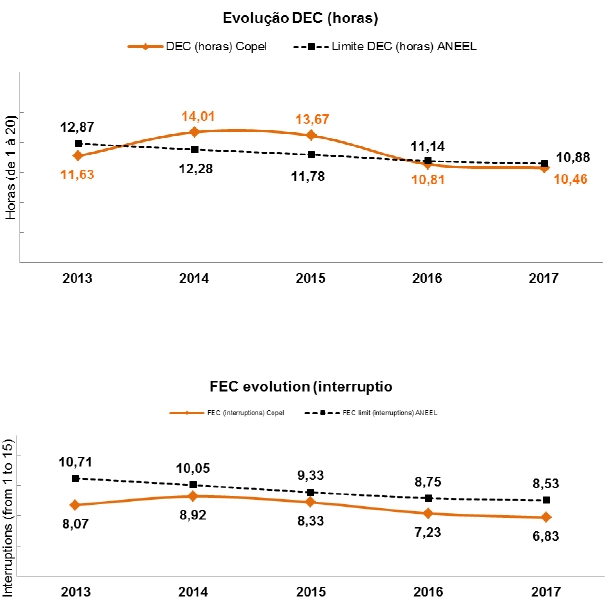
· Management of energy losses
Energy losses are inherent to the nature of the process of transforming, transmission and distribution of electricity. An analysis of the electricity required to serve consumers must bear in mind that not all electricity generated is delivered to end consumers.
In this context, distributor losses may be segmented between losses in the Basic Grid, which are external to the concessionaire's distribution system and are imminently technical in their origin, and distribution losses that may be of a technical or non-technical nature.
35

In 2017, overall distribution losses - technical, non-technical and basic network - accounted for 9.2% of the energy injected into the distribution system. This percentage decreased by nearly 0.4% versus 2016 and kept below the levels seen over the last few years. The Program for Fight against Non-technical Losses held by Copel Distribuição contributed to that decrease.
· Captive market
From January to December the captive market consumption was of 19,743 GWh, with a negative variation of 11.6% in relation to the prior year due to the migration of consumers to the free market.The number of captive consumers billed by Copel Distribuição was 1.8% larger than that in December 2016, totaling 4,560,493 consumers.In 2017, 81,726 captive consumers were added to the system.
The tables show the energy sold and the consumption class in number of consumers:
| | | |
| Captive Market - Copel Distribuição |
| No. of consumers |
| | Dec/17 | Dec/16 | % |
| Residential | 3.682.009 | 3.597.105 | 2,4 |
| Industrial | 76.328 | 82.021 | (6,9) |
| Commercial | 389.844 | 382.121 | 2,0 |
| Rural | 354.829 | 360.066 | (1,5) |
| Others | 57.483 | 57.454 | 0,1 |
| Total | 4.560.493 | 4.478.767 | 1,8 |
| |
| Energy sold (GWh) |
| | Dec/17 | Dec/16 | % |
| Residential | 7.126 | 6.932 | 2,8 |
| Industrial | 3.254 | 5.753 | (43,4) |
| Commercial | 4.651 | 5.059 | (8,1) |
| Rural | 2.257 | 2.179 | 3,6 |
| Others | 2.455 | 2.405 | 2,1 |
| Total | 19.743 | 22.328 | (11,6) |
36

· Wire Market (TUSD)
In 2017, the wire load, which takes into account all consumers who accessed the network of the Distributor, presented an increase of 3.4% when compared to 2016.
The industrial wire market increased by 4.9% in 2017, with the most significant branches of the industrial class being the production of food, pulp, paper and paper products and manufacture of wood products.
| | | |
| Number of consumers |
| | Dec/17 | Dec/16 | % |
| Captive Market | 4.560.493 | 4.478.767 | 1,8 |
| Real Estate Agents | 3 | 4 | (25,0) |
| Free Consumers | 991 | 620 | 59,8 |
| Dealerships Fio | 3 | 2 | 50,0 |
| Wire Market | 4.561.490 | 4.479.393 | 1,8 |
| |
| Distributed energy (GWh) |
| | 2017 | 2016 | % |
| Captive Market | 19.743 | 22.328 | (11,6) |
| Real Estate Agents | 521 | 614 | (15,1) |
| Free Consumers | 8.873 | 5.273 | 68,3 |
| Dealerships Fio | 78 | 52 | 50,0 |
| Wire Market | 29.215 | 28.267 | 3,4 |
· Purchase of Energy
Under the current regulatory reference, the contracting of energy by the distributors mainly occurs through an auction regulated by Aneel. To supply the market in the following years, in 2017 Copel Distribuição participated in the 25th Auction of New Energy (A-4), which took place on December 18, 2017, with a 35 MWmed acquisition and a start-up from January 1, 2021, and in the 26th New Energy Auction (A-6) on December 20, 2017, with the acquisition of 239.5 MWmed and start of supply beginning January 1, 2023.
To serve the market in 2017, the agreements negotiated in prior years started being supplied: 3rd Auction of Structuring Projects, contracted in 2010; 15th New Energy Auction (A-5), contracted in 2012; 19th New Energy Auction (A-3), contracted in 2014, and 3rd Alternative Sources Action, contracted in 2015.
In addition to these events, Copel Distribuição received the compulsory allocation of new physical guarantee quotas from HPP Volta Grande, Miranda, Jaguara and Pery, which started operating under the quotas system in connection with Law 12,783/2013.
The charts show the composition of the Distributor’s energy purchase agreements portfolio by type of agreement and source, respectively:
37

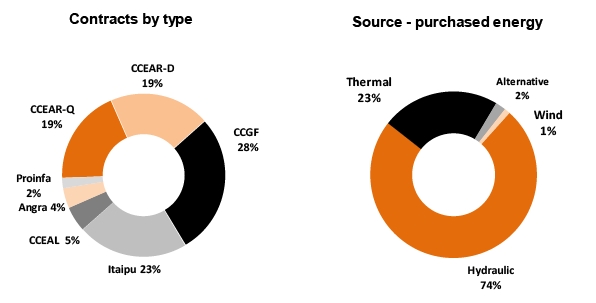
CCEAR – Energy Trading Agreements in the Regulated Environment – By Quantity and Availability
CCGF – Physical Guarantee Quota Agreement
CBR – Bilateral Regulated Agreement
Proinfa – Incentive Program for Alternative Energy Sources
· Overcontracting
In the current regulatory model, the purchase of energy by distributors is regulated by Law 10,484/2014 and by Decree 5,163/2004, which determine that these shall acquire the volume required to serve 100% of market, through auctions of the Regulated Contracting Environment – ACR.
Copel Distribuição experienced an overcontracting scenario during 2017, requiring mitigating measures. All available tools were used for management of contracting, thus seeking to meet the requirement of making utmost efforts to adapt its level of contracting to the regulatory limits.
However, in case the involuntary character of the overcontracting is not recognized, Copel Distribuição shall receive a bonus from the sale of the amount that exceeds the regulatory limit above 105% of PLD, whose values, mainly in the second half of 2017, exceeded our average purchase price.
· Tariff Flags
The purpose of the 'tariff flag' system for consumer prices to reflect conditions under which electricity is generated in the SIN by charging additional amounts in the Energy Tariff (TE), thus enabling consumers to vary their consumption as the real price of electricity changed. Green, yellow and red 'flags' show whether electricity costs more or less depending on conditions for electricity generation. 'Tariff flag' amounts are set in a specific document published by ANEEL each calendar year, in a specific act, and their charge began in January 2015.
38

The table below shows the history of tariff flags and amounts charged over the last two years:
| | | | | | |
| | | | | | | |
| Period | | 2017 | Value applied in the | | 2016 | Value applied in the |
| tariff (every 100 kwh) | | tariff (every 100 kwh) |
| Jan | | Green | | | Red (level 2) | R$ 4,50 |
| Feb | | Green | | | Red (level 1) | R$ 3,00 |
| Mar | | Yellow | R$ 2,00 | | Yellow | R$ 1,50 |
| Apr | | Red (level 1) | R$ 3,00 | | Green | |
| May | | Red (level 1) | R$ 3,00 | | Green | |
| Jun | | Green | | | Green | |
| Jul | | Yellow | R$ 2,00 | | Green | |
| Aug | | Red (level 1) | R$ 3,00 | | Green | |
| Sep | | Yellow | R$ 2,00 | | Green | |
| Oct | | Red (level 2) | R$ 3,50 | | Green | |
| Nov | | Red (level 2) | R$ 5,00 | | Yellow | R$ 1,50 |
| Dec | | Red (level 1) | R$ 3,00 | | Green | |
· White Tariff
Beginning January 1, 2018 a new type of tariff will be offered, whose value will range according to the day and time of consumption.
The white tariff aims to rationalize the energy consumption at peak times (5:30 pm to 8:29 pm) and encourage using at low demand periods. This type will be offered to low voltage consuming units (127, 220, 380 or 440 volts), called group B.
The conditions for application of the white tariff are set in Aneel Normative Resolutions 414/2010 and 733/2016.
· Annual Tariff Adjustment - RTA
The Tariff Revision is made by applying the Tariff Revision Index (IRT), which considers the updating of manageable costs of the concessionaire (portion B), deducting the productivity gains in connection with market growth, that is, the annual tariff revision aims to pass on non-manageable costs (portion A) and monetarily adjust the manageable costs (portion B). The tariff revision index arises from the ratio between required revenue (portion A + portion B) and earned revenue corresponding to revenue earned by the concessionaire during the twelve months prior to the tariff revision process, in case the tariffs charged have not been changed since then. Portion A involves costs relating to the acquisition of electric energy, use of transmission systems, sectorial charges and non-recoverable revenue. Portion B regards costs inherent to energy distribution, i.e. operating costs and capital costs.
39

Homologation Resolution 2,255/2017, which recognized the result of the last annual tariff revision of Copel Distribuição, led to an average effect to be charged to consumers of 5.85%, of which 5.62% on average to high voltage consumers, and 6.00% on average to low voltage consumers.
3.3.4. Trading
Copel Comercialização S.A., set in January 2016, was established in the market under the name Copel Energia, working with a specialization in the free market of energy purchase and sale, motivated by the accelerated movement of large consumers to migrate from the regulated market to the Environment of Free Trading - ACL. In addition to operating in the segment of energy purchase and sale, it also offers management services in the free energy market for its customers.
In January 2017 the Electric Energy Trading Chamber (CCEE) was authorized to operate as a retailer, a regime in which a sole agent of commercialization of electric energy represents consumers and generators, with no requirement of becoming CCEE agents. The retail market is a promising one, as the migration to the energy free market comprises mainly special consumers, companies with demand between 500 kW and 3,000 kW, and are the potential customers of the retail market.
At the end of 2017, the Company recorded a significant growth, with more than 300 average megawatts of energy sold, expanding its area of service, with customers in 15 states of Brazil.
3.3.5. Telecommunications
As authorized by the National Telecommunications Agency - Anatel, Copel Telecomunicações offers telecommunication services in the States of Paraná and Santa Catarina.The services are offered since August 1998 through the use of a fiber optic network (totaling 32,4 km of fiber optic cables until the end of 2017). Moreover, it is also involved in the educational project that aims to provide access to the broadband Internet to elementary and high schools in the State of Paraná.
Currently, Copel Telecomunicações is active in 399 municipalities in the State of Paraná and in two municipalities in the State of Santa Catarina.All municipalities are connected to the Company’s optic network (backbone), which uses DWDM - Dense Wavelength Division Multiplexing technology, allowing transmission speeds of up to 40 channels of 200Gbit/s per fiber optic.
40

3.3.6. Ownership interests
Copel has ownership interests and associations with companies, consortiums and other institutions operating in various sectors in addition to energy sector.More information on Notes 1.1, 2, 18 and 19.7 to the Financial Statements.
41

4. ECONOMIC-FINANCIAL PERFORMANCE
4.1. Net Operating Revenue
In 2017, the Net Operating Revenue had an increase of R$922.8 million, representing an increase of 7% when compared to 2016. This variation is mainly due to:
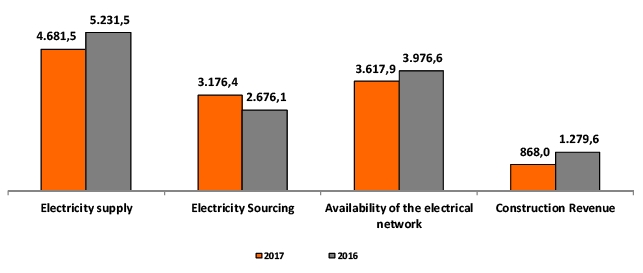
1) Decrease of R$550 million in theRevenue from Electric Energy Supply, mainly due to:
· 11.6% drop in the captive market in comparison with the prior year, due to the exit of captive consumers to the free market and the country's economic situation; and
· 17.9% average decrease in the tariff applied from June 2016;
2) Increase of R$500.3 million in theElectric Energy Supply, mainly due to higher revenues in CCEE in connection with the higher average PLD for the period, R$ 318,15/MWh in 2017 versus R$ 92.40/MWh in 2016 and higher trading in the Free Contracting Environment – ACL;
3) Decrease of R$ 358.6 million inRevenue from Electric Network Availability, due to the recognition of compensation by remeasurement of cash flows in light of MME Ordinance 120, regarding the RBSE assets, recognized in 2016;
4) Decrease of R$ 411.6 million in theConstruction Revenue. The Company accounts for revenue related to the construction or improvement in the infrastructure used in the provision of services of distribution and transmission of electric energy and gas, which totaled R$ 868 million in 2017 and R$ 1,279,6 million in 2016. These expenses are recognized in the statement of income for the period asconstruction cost, as incurred:
42

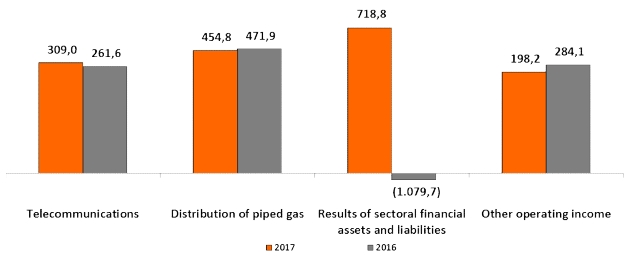
5) An increase of R$47.4 million in theTelecommunications Revenue, mainly due to the increase in the number of customers, especially in the retail market with the Copel Fibra product;
6) Decrease of R$17.1 million inRevenue from Piped Gas Distribution, affected by the retraction of the market when compared to the previous year;
7) Increase of R$1,798.5 million in theResult of financial sector assets and liabilities in connection with the positive result in 2017 of 718.8 million, while in 2016 the result was negative by R$1,079.7 million; and
8) Reduction of R$86 million inOther Operating Revenue reflecting the lower variation in the fair value of the indemnifying asset of the concession in the amount of approximately R$75.7 million, followed by the decrease in services rendered revenues and offset against the increase in revenues relating to the sale of Sanepar's shares.
43

4.2. Operating Costs and Expenses
· Not manageable
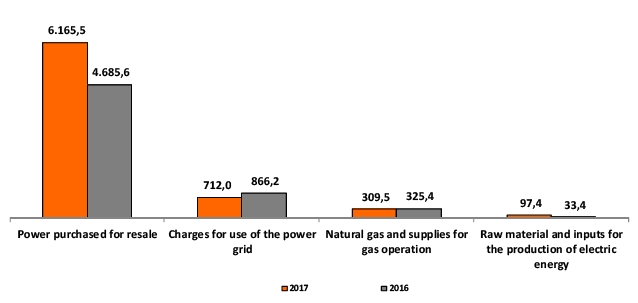
1) Increase of R$1,479.8 million in theElectric Energy Purchased for Resale, mainly due to greater LDP in the period and the impact of the GSF - Generation Scaling Factor (hydrological risk).and increase in trading in ACL;
2) Decrease of R$154.2 million inCharges for the Use of the Electric Network, mainly due to the lower costs with System Service Charges - ESS, in connection with the funds from the reserve electric energy (Coner) and of the charge of the reserve energy - EER, offset against the increase in costs of the basic network costs and transportation of energy, due to the effects of the indemnifications to the energy transmission companies;
3) Reduction R$15.9 million inNatural gas and inputs for the gas operation due to lower consumption; and
44

· Manageable
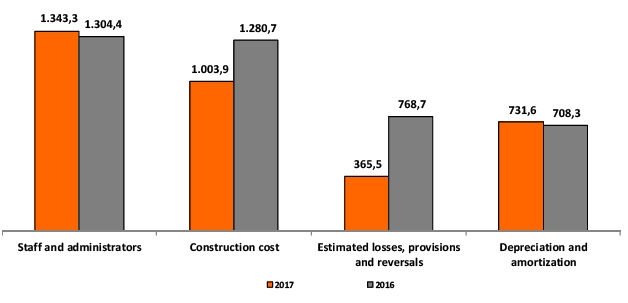
4) Increase of R$38.9 million of the Costs withPersonnel and Management, mainly reflecting the salary adjustment of 1.6% in October 2017 and 9.9% in 2016, pursuant to the collective agreement and to the variation of R$9.1 million of the Provision for indemnifications for voluntary resignations and retirements, offset by the company’s cost reduction program;
5) Decrease in theCost of Construction, from R$1,280.7 million in 2016 to R$1,003.8 million in 2017;
6) Decrease of R$403.1 million inEstimated Losses, Provisions and Reversals, mainly due to the reversal of estimated impairment of assets, effect of the gas trading with Petrobras, and decrease in the provision for estimated losses with doubtful accounts, offset against the increase in the provision for litigation;
45

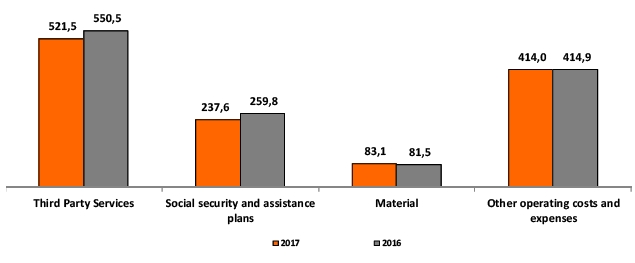
7) Decrease of R$29 million inThird-party services, mainly due to the reduction of services for maintenance of the electric system, advisory and audit, offset against the increase in the communication, processing and data transmission services, also due to the company’s cost reduction program .
8) Decrease of R$22.2 million inSocial security and assistance plans arising from the effects of the actuarial valuation, calculated by the actuary hired.
4.3. EBITDA
| | |
| Consolidated | | |
| In R $ million | 2017 | 2016 |
| Net income attributed to the controlling company's shareholders | 1.118,2 | 874,5 |
| Deferred IRPJ and CSLL | (105,2) | (69,6) |
| IRPJ and CSLL | 379,9 | 589,3 |
| Financial expenses (income), net | 748,4 | 594,6 |
| Lajir/Ebit | 2.141,3 | 1.988,8 |
| Depreciation and amortization | 731,6 | 708,3 |
| Lajida/Ebitda | 2.872,9 | 2.697,1 |
| Net Operating Revenue - ROL | 14.024,6 | 13.101,8 |
| Ebitda Margin% (Ebitda ÷ ROL) | 20,5% | 20,6% |
The Company's EBITDA in 2017 was of R$2,872.9 million, an increase of R$175.8 million when compared to 2016, representing an increase of 6.5%.
46

4.4. Financial Result
The financial result showed a decrease of R$153,8 million mainly due to the 22.6% drop in financial revenues mainly arising from lower fees on late payments of energy bills and deflation of financial indexes that update financial revenue.
4.5. Added Value
In 2017, Copel recorded R$11,772.8 million in Added Value - total 7.7% lower than the previous year. The full statement is available in the Financial Statements.
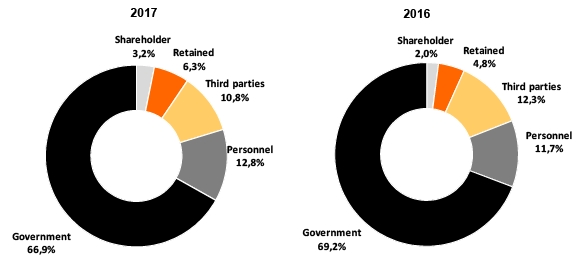
47

4.6. Debt
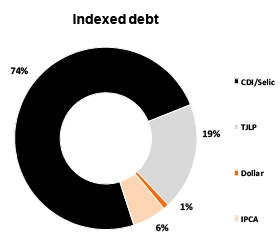 |
The Company meets its liquidity and capital requirements primarily with cash from operations and external financing used to expand and modernize business related to generation, transmission, trade and distribution, and telecommunications.
An important point to note is that the Company aims to invest in ownership interest using both credit facilities available in the market that make sense for Copel's capital structure in terms of financial leveragecompared to returns from projects. It is worth noting that prospects for financing as well as cash and cash equivalents will be sufficient to cover the fiscal year's investment plan. |
In 2017, there were the following outflows of funds:
| | | |
| Inflow - 2017 (In R$ millions) | Company | Financing Agent | Montante |
| Debentures | Holding | Debenturistas | 520 |
| Debentures | Copel Geração e Transmissão | Debenturistas | 1.000 |
| Debentures | Copel Distribuição | Debenturistas | 500 |
| Debentures | Copel Telecomunicações | Debenturistas | 220 |
| Debentures | Compagas | Debenturistas | 2 |
| NCI 306.401.445 | Holding | Banco do Brasil | 77 |
| Promissory Notes - 3rd issue | Copel Geração e Transmissão | Notistas | 500 |
| BNDES - FINAME | Copel Distribuição | BNDES | 0 |
| CFX 17/35959-7 | Copel Distribuição | Banco do Brasil | 75 |
| CCB 21/00851-5 | Copel Distribuição | Banco do Brasil | 39 |
| CCB 17/35960-0 | Copel Distribuição | Banco do Brasil | 50 |
| CFX 17/35958-9 | Copel Distribuição | Banco do Brasil | 58 |
| Total | | | 3.042 |
Payments made in the year totaled R$3,042 million, of which R$1,887 million principal and R$1,155 million charges.
48

The long-term debt repayment schedule, comprising loans, financing and debentures, is as follows:
| | | | | | | |
| | 2019 | 2020 | 2021 | 2022 | 2023 | After 2023 | Total |
| Foreign Currency | - | - | - | - | - | 88.485 | 88.485 |
| Brazilian Currency | 3.192.751 | 1.103.102 | 759.627 | 1.003.861 | 204.403 | 1.061.526 | 7.325.270 |
| Total | 3.192.751 | 1.103.102 | 759.627 | 1.003.861 | 204.403 | 1.150.011 | 7.413.755 |
4.7. Net Income
In 2017, net income attributable to the parent company's shareholders was R$1,033.6 million, which was 15.4%, up by R$895.8 million against the previous year.
The legal reserve, proposed dividends and other corporate impacts recorded in stockholders' equity in the financial statements for the year ended 12.31.2016 were originally made based on the profit disclosed in those financial statements and did not change due to the restatement quoted in Note 4.1 since the information available at the time indicated that the corporate impacts would be those approved by the competent bodies.
Distribution of dividends and interest on equity
| | | | | | | |
| | | 2017 | | | 2016 | | 2015 |
| | Total | DIV | JCP | Total | DIV | JCP | Single Parcel |
| Approval by AGO | | | | 27/04/17 | 27/04/17 | 27/04/17 | 28/04/16 |
| Approval by CAD | | | 13/12/17 | 27/03/17 | 27/03/17 | 27/03/17 | 15/03/16 |
| Payment date | to be defined | to be defined | to be defined | 28/12/17 | 28/12/17 | 30/06/17 | 15/06/16 |
| Adjusted Net Income | 1.053.594 | | | 1.012.425 | | | 1.223.542 |
| Value of ON Shares | 146.193 | 11.859 | 134.334 | 255.930 | 113.018 | 142.912 | 164.924 |
| Value of PNA Shares | 949 | - | 949 | 949 | - | 949 | 960 |
| Value of PNB Shares | 142.258 | 11.542 | 130.717 | 249.333 | 110.247 | 139.086 | 160.912 |
| Total Distribution | 289.400 | 23.401 | 266.000 | 506.212 | 223.265 | 282.947 | 326.796 |
Of the net income verified in 2017, calculated in accordance with the corporate law, the Company proposes to distribute to shareholders, the amount of R$289.4 million, distributed as follows: a) interest on equity in place of dividends, in the gross amount of R$266 million, worth R$0.92624 per common share (ON), R$2.89050 per class "A" preferred share (PNA) and R$1.01887 per class "B" preferred share (PNB); and b) dividends for R$ 23.4 million, worth R$ 0.08177 per common share (ON) and R$ 0.08996 per class “B” preferred share (PNB).
The date of payment will be decided at the Annual General Meeting.
49

· Shares
Volume traded in 2017:
| | | | | |
| | Volume traded | ON (CPLE3) | PNB (CPLE6) |
| | | Total | Daily average | Total | Daily average |
| | Trades | 55.357 | 225 | 932.069 | 3.789 |
| | Quantity | 16.576.500 | 67.384 | 192.357.800 | 781.942 |
| B3 | Volume (R$ thousands) | 366.631 | 1.490 | 5.551.491 | 22.567 |
| | Presence in trade sessions | 246 | 100% | 246 | 100% |
| | Quantity | 321.743 | 1.797 | 128.316.176 | 511.220 |
| NYSE | Volume (US$ thousands) | 2.110 | 12 | 1.118.770 | 4.457 |
| | Presence in trade sessions | 179 | 71% | 251 | 100% |
| | Quantity | - | - | 1.515.580 | 12.736 |
| Latibex | Volume (€ thousands) | - | - | 496 | 4 |
| | Presence in trade sessions | - | - | 119 | 46% |
Performance of the share price:
| | | | |
| | Share | | 2016 | Change % |
| | ON (CPLE3) | R$ 21,40 | R$ 19,08 | 12,2 |
| | ON average | R$ 22,40 | R$ 19,14 | 17,0 |
| B3 | PNB (CPLE6) | R$ 24,95 | R$ 27,36 | (8,8) |
| | PNB average | R$ 28,29 | R$ 28,76 | (1,6) |
| | Ibovespa | 76.402 | 60.227 | 26,9 |
| | Electricity Index | 39.732 | 36.108 | 10,0 |
| | ON (ELPVY) | US$ 6,30 | US$ 5,86 | 7,5 |
| | ON average | US$ 6,88 | US$ 5,45 | 26,1 |
| NYSE | PNB (ELP) | US$ 7,63 | US$ 8,48 | (10,0) |
| | PNB average | US$ 8,87 | US$ 8,39 | 5,8 |
| | Dow Jones Index | 24.719,22 | 19.762,60 | 25,1 |
| | PNB (XCOP) | € 6,29 | € 8,08 | (22,2) |
| Latibex | PNB average | € 7,98 | € 7,43 | 7,4 |
| | Latibex Index | 1.974,20 | 1.811,60 | 9,0 |
4.8. Non-Paying Consumers
Since 2003, Copel calculates the non-payment rate of the product "electric energy supply", whose calculation methodology considers a non-paying consumer as those overdue past 15 days up to 360 days, in accordance with the notice period (ANEEL Resolution 414/2010), and recognition of losses on past due debits was excluded.
In December 2017, Copel Distribuição's amount overdue by consumers was of R$226.5 million, equivalent to 1.52% of its revenues, while in 2016 Concessionaire reached R$267.3 million, 1.61% of revenues.
50

Another control indicator of the Company is Abradee, whose methodology considers debts overdue between 1 and 90 days. The economic scenario in 2017 led directly to the increase in this indicator, up by 18.35% in relation to 2016, due to the concentration of debts overdue between 1 and 30 days.
| | | |
| Indicador | 2017 | 2016 | Change % |
| Abradee Non-Payment | 2,58% | 2,18% | 18,35% |
| Company Non-Payment | 1,52% | 1,61% | -5,59% |
4.9. Investment Program
The investment program for 2018 was approved on December 13, 2017 by the 173rd ordinary meeting of the BOD. Investments made and planned are shown below:
| | | | | |
| | | Realized | | Change % | Estimated |
| Companies | (in R$ millions) | 2017 | 2016 | 2017-2016 | 2018 |
| Generation and Transmission | 1.071,3 | 1.879,2 | (43,0) | 743,6 |
| Distribution | | 630,4 | 777,1 | (18,9) | 790,0 |
| Telecommunication | | 241,1 | 193,8 | 24,4 | 340,2 |
| Wind Energy Developments (1) | 566,0 | 722,2 | (21,6) | 1.051,4 |
| Other (2) | | - | 3,1 | (100,0) | 3,4 |
| Total | | 2.508,8 | 3.575,4 | (29,8) | 2.928,6 |
| (1)Includes Brisa Potiguar, Cutia Empreendimentos Eólicos, São Bento Energia. | | | |
| (2)Includes Holding, Copel Renováveis, among other. | | | | |
4.10. Research & Development - R&D
Pursuant to Law 9,991/2000, concessionaires, permissionaires and authorized companies of the electric energy sector must annually apply a minimum percentage of their Net Operating Revenue - ROL in projects of Technological Research and Development of the Electric Energy Sector - R&D, according to regulations established by Aneel. R&D projects in the electric energy sector must be original and innovative. In addition to these amounts, a collection to the FNDCT - National Fund for Scientific and Technological Development and the Ministry of Mines and Energy is also made, which in 2017 was of R$43.9 million.
Generation and Transmission
In 2017, Copel Geração e Transmissão invested R$17.9 million in the execution of 29 R&D projects, of which 7 are strategic, whose themes were established by Aneel through Call for Projects.In 11 projects, it participated cooperatively with other companies.It also applied R$600 thousand in the management of R&D projects through the management project, totaling R$18.5 million invested in R&D.
51

Distribution
In 2017, R$18.4 million were invested in: a) 40 R&D projects, of which four were completed during the year, with 36 projects in execution; b) cooperating with other companies in the electric energy sector in 9 projects, among them two strategic projects whose themes were established by Aneel, through Calls for Projects.
12 new projects were contracted through two Public Calls in connection with calls for comments published by Aneel as “Strategic Project: Technical and Commercial Arrangements for Inclusion of Energy Storage Systems in the Brazilian Electricity Sector” and “Priority Project for Energy Efficiency and R&D Strategy: Energy Efficiency and Minigeneration in Public Institutions of Higher Education”. The investments reach R$ 85 million and will be made within four years.
4.11. Energy Efficiency Program – PEE
The Energy Efficiency Program promotes efficiency in the final use of electric energy, through the application of financial resources, establishing a minimum percentage of the Net Operating Revenue - ROL, according to Law 9,991/2000 and Aneel Normative Resolution 556/2013.
Copel Distribuição invested R$ 15.2 million in PEE projects in 2017.
52

5. HUMAN RESOURCES
5.1. People Management
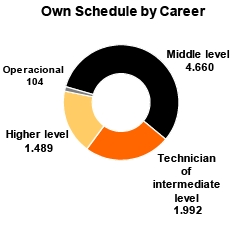 | Considering Copel Holding, Copel Distribuição, Copel Geração e Transmissão, Copel Telecomunicações and Copel Comercialização, the Company has 8,245 employees in its own staff. 71 new employees were admitted in 2017 through a public tender. During the same period, 356 employees left the Company. The turnover rate was of 2.5% in 2017, and 1.7% in 2016. |
· People Development
In an era in which people and their knowledge became the main competitive differential of companies, encourage and promote the education and development of employees, always relying on qualified and experienced professionals, is Copel’s strategy to face this challenge, allowing all of its professionals to bring to bear their potential in an environment conducive to the development of their skills and development of their career. To this end, several educational actions are promoted, ranging from basic training to graduate and research courses. These actions are organized in corporate programs, training courses (for basic training to perform duties), compulsory training (courses for specific activities), training for professional improvement, events (seminars, lectures, workshops, congresses, etc.) and research and development projects.
Copel also offers training for outsourced employees, provided for in an agreement or due to the Company's interest, focused on integration and specific activities to be carried out by the professionals when rendering services to Copel.
The Corporate Education model is based on the synergistic and cooperative performance of its Corporate University and the Training Areas of the Wholly-Owned Subsidiaries, focusing on the business competitiveness and profitability.
53

In 2017, R$7.5 million were invested in personnel training and development. In all, 2,781 training events were held, with 41,407 participations, totaling 459,782 hours of training, with an average of 53.35 hours of training per employee and 119 participations in long-term events (language courses and graduate courses).
Corporate education actions (integrity, sustainability, foreign language training, leadership, preparation for the future, integration, among others) are coordinated by UniCopel and aim to build learning focused on areas of knowledge that are directly in line with the Company's skills and business.
We highlight, in 2017, the expansion of the Distance Learning actions of Copel, and the continuity of the Leadership Program, having the first results presented, and the strengthening of the Integrity Program and Accessibility.
Distance Learning Platform of Copel
In 2017 there was a leap in the number of distance courses offered by both UniCopel and the training areas of its wholly-owned subsidiaries. The use of this type of education has allowed more people access to knowledge, to improve their activities and their personal and professional development. In addition, distance education has been a powerful ally in the communication of significant and/or mandatory information to all employees, such as the Code of Conduct, Cost Management and Anticorruption Law.
In order to support the growth in the use of this modality, UniCopel made several improvements in the distance education platform in 2017 and has studied new tools and methodologies to increase the learning and the results obtained by this means.
Transformational Leadership Program
The Transformational Leadership program, implemented in 2016, continued throughout 2017. There were several actions aimed at better preparing Copel's management staff and changing the Company's management culture. The program's main objective has been to train leaders prepared for responsible business management and concerned with the well-being and development of the people around them.
The educational actions of the program included specific in-person training for each management level, distance courses on elements considered essential for good management and face-to-face events with all of the Company's leaders to discuss strategic issues for Copel.
Also in 2017 the first results of the program could be seen. A survey conducted with all employees at the end of the year pointed out that there is already a positive perception about a new attitude being adopted by the Company's management.
Accessibility Program
Copel's commitment to accessibility and inclusion of people with disabilities - PcDs - in the company's day-to-day business has been a long-standing one. Reaffirming this commitment, several seminars and trainings were held in 2017 in different cities of Paraná to raise awareness and knowledge among the Company's employees about the main difficulties faced by the PcDs and to present ways to improve their inclusion in Copel’s routines.
54

Other programs
In addition to its own training and qualification programs, the Company encourages the training of its professionals through the following initiatives:
• Foreign Language Training Program: a program established in 2012 for employees performing activities in which another language is required. In 2017, 94 employees participated in the program, learning German, Spanish and English.
• Graduate courses: a program focused on the professional development in specific and strategic subjects focused on the production of researches, dissertations, theses, generating innovations and improvements for the Company and for the electric sector. In 2017, 25 employees started a graduate course atLato sensu andStricto sensu levels.
• Exchanges and Courses abroad: provide constant updating on matters related to the Company's business, as well as exchanges of experiences and discussion of work and research.
· Benefits
In addition to legally required benefits, those directly available for all Copel employees include tuition grants; advances on vacation pay and additional payment of 1/3 of salary in addition to legally required amounts; advance payment of the first portion of the annual bonus (aka 13th salary) in January; profit sharing; quality of life incentives, such as Copel choir and company games; food and meal vouchers; subsidies for daycare and disablement and employees with disabled dependents; extended parental leave; supplementary sickness pay; and other benefits provided under an agreement between Copel and Brazil`s Social Security (INSS). Additionally, Copel`s Pension and Social Security Foundation, for which Copel acts as sponsor, runs a private pension plan to supplement official social security as well as health and dental care plans. Copel Foundation also provides a portfolio of loans for participants under legal provisions governing the investment of its pension fund’s reserves.
· Compensation policy
Copel`s practices for compensation, recognition and incentives are based on two pillars: fixed pay (reflecting market levels and individual merit) and variable pay (profit sharing program [PLR]).Copel's employee profit sharing program complies with Federal Law 10,101/2000, State Decree 1,978/2007 and State Law 16,560/2010 and income is distributed equally to all employees.The lowest salary paid by the Company in December 2017 (R$1,764.78) was 1.88 times the national minimum wage on that date (R$937.00); in the same period, there was no material difference between men and women in terms of basic salaries paid.
55

· Labor relations
There are 19 trade unions representing the various classes of workers, and Copel holds meetings with them to discuss matters of mutual interest. In the collective bargaining month (October), this relationship intensifies when unions and Copel discuss demands for the official collective bargaining agreement (ACT), which mitigates any problems with unions or employees. Additionally, any 'just cause' dismissals are preceded by administrative proceedings regulated by internal administrative rules, which assure employee of the right to defense.
· Performance assessment
Copel's performance management program (called “Our Energy”) comprises two axes, namely: Organizational Competencies and Results as well as different approaches in relation to careers, compensation and professional development, such as promotions, meritocracy, vocational aptitudes, lectures or talks, training programs, grants for graduate and language course. The program started in 2013 and developed specifically assertive improvements based on the experience of previous cycles and managers and employees’ views on Copel's performance management practices. From each cycle, we aim to learn lessons and make improvements to boost adherence to the company’s culture and reality.
56

6. SOCIAL AND ENVIRONMENTAL PERFORMANCE
6.1. Suppliers
Copel is a mixed-capital company, subject to Law 8,666/93 and to State Law 15,608/2007. Since the entire supplier selection process is restricted by these laws, the Company does not choose suppliers based on labor, human rights and environmental issues in this process, however, Copel demands compliance with labor and tax legislation in the bidding documents, contractual articles, supplier registration manuals, and standards and technical manuals that are permanently available online.
The social, environmental, human rights and labor issues are addressed by Copel during the integration process, carried out with each new supplier. They are also included in specific articles of agreements for the acquisition of construction works and services. The breach results in the suspension of the agreement and the impediment, for up to two years, of participating in new bids of the Company.
Copel classifies suppliers considered critical by the Company in order to minimize potential risks in the supply of products and services, as well as to better protect the business. The partners are classified based on the identification by Copel of significant risks, considering the following aspects: legal, financial, environmental, occupational health and safety, population safety, image of the company, customer and society perception, and processes.
6.2. Customer
Copel believes that the sustainability of its business model depends on the ongoing dialogue with several stakeholders: shareholders, consumers, employees, suppliers, government and communities. The relationship with all these groups, with quality and in a transparent manner, is evaluated by the Company as a competitive advantage.
For this reason, Copel maintains a working group dedicated to executing a structured relationship policy, governed by constant planning and activities, with the purpose of guaranteeing levels of excellence of these groups’ satisfaction with the Company
· Copel Distribuição
In 2017, Copel was recognized for the fourth consecutive time as the best distributor in the country according to the clients' evaluation. This recognition originates from Abradee's customer satisfaction survey and awards to the winning company the ISQP (Satisfaction with Perceived Quality Index) award. The survey is carried out with about 50 distributors from all over the country.
57

Abradee also awarded Copel the award of best distributor in the Southern Region, according to the clients' assessment and was recognized as the best company in social responsibility. In addition to this award, the Company carries out a survey with rural clients every four years and with clients of the government in the first and last year of the mayors' term. The satisfaction indicator is also monitored by the annual surveycarried out by Aneel, focusing on residential customers. Cier also awarded Copel the prize Oro. Following are the achievements in 2017 and in the two prior years:
| | | |
| | 2015 | 2016 | 2017 |
| Abradee Satisfaction Survey - Residential Clients | 88,6% | 88,8% | 90,3% |
| Abradee Satisfaction Survey - Non-Residential Group B Clients | 86,5% | 84,8% | Did not participate |
| Abradee Satisfaction Survey - Group A clients | 78,6% | 85,9% | 82,4% |
| Aneel Client Satisfaction Survey - IASC | 60,3% | 73,1% | 80,7% |
| Customer Satisfaction Survey | Silver Award | Gold Award | Gold Award |
| Rural Clients Satisfaction Survey | 77,9% | Not conducted | Not conducted |
| Note: Rural Customer Survey is carried out every 4 years | | | |
· Copel Telecomunicações
Copel Telecomunicações has carried out periodic opinion surveys since 2008. From 2015 onwards, it adopted the same data collection instrument used by Anatel, which made it possible to compare the results of the Company's quality indicators with those of other companies in the sector.
6.3. Community and Environment
Power generation, transmission and distribution activities generate positive and negative social and economic impacts in the regions where they are installed. Copel is aware of the impacts generated by its projects and carries out prevention and mitigation actions in accordance with current legislation and the guidelines established by its Sustainability Policy and its Code of Conduct, which reflect the commitments made under the UNO Global Pact.
In cases of population displacement, the evaluation is done through the Social and Economic Register. When there are cases of social vulnerability, COPEL carries out the process of reallocating the family and social compensation for the damages caused by the implementation of its projects, in addition to indemnify the expropriated properties.
· Colíder HPP
In 2017, the execution of the Local Productive Arrangements Program was completed, linked to the environmental licensing process for the implementation of the HPP. Through this initiative, 100 family farming properties in the municipalities of Colíder, Itaúba, Nova Canaã do Norte and Cláudia received monthly technical visits from agronomic engineers who guided residents on sustainable agriculture, primarily organic, as well as holding training workshops on management, processing and marketing of the products of family agriculture to improve the conditions of their insertion in local production chain. The implementation of the program improved the productivity of the farmers covered by the program and reduced expenses with external inputs, which led to a direct increase in income for families. Another highlight was the positive evaluation of the public managers of the four municipalities, strengthening the good relationship between the two spheres and increasing the reliability of the company in the region.
58

· LT 500 kV Araraquara - Taubaté
COPEL mitigates the impacts caused by the installation of transmission lines. In general, properties and residents record territorial and productive losses established by the right-of-way, as well as the change in aspects of the local natural landscape.
The Company provides a compensatory aid to owners for their losses and adopts a series of programs that meet environmental licensing conditions.
When installing the 356 km Araraquara - Taubaté LT 500 kV transmission line, which passes through 28 municipalities in the State of São Paulo, the Company is carrying out the Social Compensation Program due to the loss of economic activities in some communities, and four other programs. In 2017, the last family resident in Araras was reallocated.
· Distribution Networks
In 2017, 619 people were compensated by the institution of right-of-way of High Voltage Distribution Line - LDAT works, which do not generate expropriation of areas, but establish restrictions of use, leading to the payment of indemnities.
When implementing new projects, COPEL carries out awareness actions together with the suppliers that will perform the work and the Community Relations Program, which aims to provide clarification on the work to be carried out.
· Paraná Connected
Copel Telecomunicações maintains the client base of Paraná Connected, a program of broadband internet access in cities of up to 10 thousand inhabitants and low HDI at subsidized cost. In 2017, two schools were contemplated, serving about 400 students. In 2018, the Project will be expanded and will continue in Curitiba and in the interior of Paraná.
59

· Project Internet without Bullying
The Project Internet without Bullying aims at raising awareness of the cyberbullying issue. Bullying is the leading cause of depression and suicide among young people. The project aims to carry out awareness lectures in order to obtain the commitment of the students of the last years of elementary education at state schools.
· Indigenous communities
COPEL develops projects to guarantee indigenous villages access to energy. Communities located in environmental conservation units or in areas where it is not possible to take the grid for energy distribution receive, for example, photovoltaic panels and energy efficient training.
In 2017, 911 indigenous consuming units were enrolled in the Social Tariff of Electric Energy - Low Income and there were no cases of violation of the rights of indigenous peoples.
· Fraternal Light Program (Luz Fraterna)
The Luz Fraterna Program, by the Government of the State of Paraná, pays the bills of consumers enrolled in the Social Electric Energy Tariff, provided that the consumption does not exceed 120 kWh. In 2017, the total resources of the State Government with the program reached R$ 37.3 million, with 158 thousand families served monthly, on average.
· Night Irrigation Tariff Program and Rural Night Tariff Program
Joint programs between Copel, the State Department of Agriculture and Supply - SEAB, Paraná's Institute for Technical Assistance and Rural Extension - Emater and State Department of Environment - Sema. The purpose is to encourage agricultural productivity through a discount of 60% to 70% in the electric energy tariff used for production in the period between 9:30 p.m. and 6:00 a.m., as well as subsidies in the construction/reinforcement of irrigation service networks. Lower values of the energy bill directly reflect the reduction of production costs and make it possible to increase the income of the rural producer. Up to December 2017, around 4,400 farmers benefited from the Night Irrigation Tariff and 12,000 rural consumers from the Rural Night Program.
· Social Electric Energy Tariff
The Social Electric Energy Tariff - TSEE offers discounts on electricity consumption up to the limit of 220 kWh, to families enrolled in the Exclusive Register of Social Programs of the Federal Government, provided that the other criteria set forth in Aneel Resolution 414/2010 are met, resulting in savings for the consumer. In 2017, 299,709 consumer units with regular benefits were served, representing 8.2% of the total households served by Copel Distribuição, totaling R$107.5 million.
60

· Tax Incentives
Through tax relief, Copel supports a number of projects to encourage culture through federal law (Rouanet), state law (State Program to Nurture and Encourage the Culture of Paraná - Profice) and local law (patronage law of the Curitiba Cultural Foundation). In addition to cultural projects, the Company encourages sport projects through the federal law of encouragement to sports and social projects concerning the children and adolescents statute (Fund for Children and Adolescents - FIA), the elderly’s statute (Seniors Fund) or healthcare projects (National Oncology Healthcare Support Program - Pronon and National Healthcare Support Program for Persons with Disabilities – PRONAS).
The highlight, in 2017, was the support to Profice, encouraging 113 projects through the tax relief of ICMS. Copel has encouraged cultural projects in the areas of theater, music, dance, circus, literature, audiovisual, cultural heritage, among others.
· Corporate Volunteering (EletriCidadania)
The program allows employees to spend up to 4 hours per month of their company time on spontaneously voluntary work for community initiatives that go beyond mere welfare to address sustainable development of all aspects of society, be they cultural, educational or occupational. In 2017, a total of 3,045 volunteer-hours was carried out. | 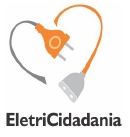 |
· State government housing program (Morar Bem Paraná)
In 2011, Paraná state government issued Decree 2,845/2011 to encourage production and acquisition of new housing units, as well as the upgrading, extension or refurbishing of urban and rural properties, official land title and urbanization for households whose incomes are up to six times the national minimum wage, as well as social housing in the state. Under this agreement, which is managed by the Housing Company of Paraná - Cohapar, Copel Distribuição is responsible for the construction of electricity distribution networks and service entrances for consuming units of housing complexes. In 2017, 1,671 housing units were supported.
61

· Telemedição Grupo A
Invoicing data are obtained automaticall, without the need for meter readers. This type of distance metering enables the automated collection of data in real time (on time), optimizing the process in view of the accuracy of the collection, treatment and availability of data, including for customers, via the Internet.
This system also can monitor use of electricity by emitting alarms when abnormal situations occur, helping to detect defects or irregular metering procedures (tampering) and reducing Copel's commercial losses.
· Paraná Smart Grid Project
The Paraná Smart Grid Project was proposed as part of the actions instituted by State Decree 8,842/2013, in order to improve the telemetry system. It was designed to improve the quality of services and the Company's ability to serve the electric system and the telecommunications system.
The Project was finalized in 2017, and the following conclusions were recorded: for the automation of the measurement there is no standardization among suppliers, making the energy distributor dependent on the proprietary system implemented. With regard to the automation of the medium voltage network, considered one of the main tools to reduce the frequency and duration of interruptions, the tests performed were fundamental for the expansion of the Guaíra, Ponta Grossa, Maringa and Londrina systems, the same philosophy will be implanted for automation in the rural area of the state.
Through the project, studies of microgeneration through intermittent sources and tests with electric vehicles were also carried out. The findings are being used to connect new accessing parties and prepare the network for the future.
· Illuminating Generations Program
The Illuminating Generations Project aims to bring to the communities of the municipalities of the Copel concession area, in their various segments, informative and preventive guidance on sustainability, aware and safe use of electricity, use of natural resources and correct disposal of waste, contributing to raise awareness on the subject. In 2017, the program provided guidelines on the efficient and safe use of energy and sustainability for more than 50,000 students in Paraná, and also works with institutions, companies, fairs and events in communities with approximately 30,000 participants.
62

· + Clic Rural Program
Launched in 2015, it aims to improve the quality of the electricity supply in the rural area, focusing on integrated farming activities with productive processes that are sensitive to disruptions. In 2017, R$ 70 million were invested in new technologies in automation and communication systems, substations of 34/13 kV and improvement and reinforcement works in the network. |  |
The initiative is focused on the four most sensitive sectors to the quality of energy supply in the State of Paraná: pig farmers, tobacco growers, poultry farmers and certain producers. Altogether, these initiatives benefited more than 200 thousand rural consumers in Paraná. Among the main advances made in the period is the deployment of 55 systems of automatic reconfiguration of network, already installed.
· More Than Energy Project
Created in 2014, it aims to implement, expand and consolidate the social investment projects and programs for the community. In the first project, the funds came from the BNDES Social Investments (ISE) line, in an amount of R$750 thousand and the goal was to support institutions and schools for deaf and/or deaf-blind people. |  |
In 2017, a specialized company was engaged to carry out the architectural and complementary projects of the first two selected institutions and the purchase of equipment for another selected project.
· Solidarity Invoice Project
This project aims to expand the number of consumers who receive their energy bills digitally and thus benefit the Associations of Parents and Friends of the People with Special Needs of the State of Paraná (APAEs). For every person who chooses to receive the bill by email Copel donates R$ 1.00 to the Associations of Parents and Friends of the Exceptional of the State of Paraná (APAEs). From the beginning of the project in 2015 until the end of 2017, more than R$ 1 million was donated.
63

· Cultivar Program
The goals are to implement community gardens in Copel's power lines, in partnership with the city's governments and communities. Through the social occupation of idle spaces, the purpose is to promote inclusion, food security and income generation. In 2017, the Term of Assignment for the Use of Non-Remunerated Public Asset of Horta Vila Esperança in Maringá was renewed, and the Terms of Assignment were signed for three new vegetable gardens to be implemented in the city of Cascavel. | 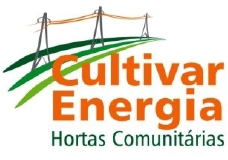 |
· Collection of Third Party Amounts - CVT
It consists of the service and commercial management of launch, control and collection of third-party amounts through bills, by contract or agreement. The limits for donations are at least R$ 1.00 and a maximum of R$1,500.00. In 2017, there was an average of 262 thousand donations/month with monthly average collection of R$2.5 million, distributed among 110 institutions.
· Reservoirs and water quality
In its reservoirs and environments, Copel monitors possible environmental interventions. The company works in accordance with specific actions to address irregularities identified, such as effluent discharge, slope stability, use and occupation of Permanent Protection Areas (APPs), hunting and illegal fishing, etc. To support this process of preservation and other areas of relevant environmental interest, the Company has an agreement with the Environmental Police of the State of Paraná. It actively participates in the Hydrographic Basin Committees and the National and State Council of Water Resources, carrying out a real-time monitoring of the water quality and of the hydrological situation of the rivers where it has reservoirs.
· Ecosystem
Energy generation, transmission and distribution projects can generate impacts on the ecosystem of the region where they are developed. In accordance with its principles and current environmental legislation, Copel conducts environmental studies before beginning the installation of new projects. The results of these studies allow the development of projects based on the least possible negative impact.
64

Hydroelectric generation projects
The ecosystem of regions where hydroelectric generation projects are built can record the reduction of species of flora and fauna, due to the creation of the reservoir and changes in the ecological processes outside the natural range of variation. To mitigate these possible impacts, Copel carries out vegetationsuppression programs, monitoring and rescue of flora and fauna, restoration of Permanent Preservation Areas, restoration of forests, monitoring and archaeological rescue, among others. It should be noted that the areas undergo periodic surveys and studies for the preparation of the Technical Report which, in addition to allowing the prevention and correction of possible impacts, keep the responsible environmental agencies updated on the development of the project.
With regard to wind power generation projects, the main impacts are in the implementation phase when fragmentation and edge effect can occur due to the suppression of vegetation and loss of habitats, increased risk of accidents with the fauna and risks of increased activities of hunting. In order to mitigate this type of impact, during the construction of the wind complexes, the Fauna Scaring and Rescue Program, and the Vegetable Species Rescue and Management Programs.
Transmission and distribution projects
The energy distribution and transmission projects can generate forest fragmentation and population reduction of native species, since there is suppression of vegetation in the right-of-way. Copel defines the layout of its transmission lines and substation area considering the least possible impact. However, if tracing is required, to reduce impact on the region, higher towers are installed in the right-of-way. In 2017, environmental studies and forest inventories were carried out and in none of them highly significant impacts on biodiversity were identified. It should also be noted that the ICMBio approved the work plan of the pilot project of Integrated Management of Vegetation underway, in the coast of Paraná, which reduces the need for brushing in these areas and the environmental impacts caused by such activity.
Copel has supported Cities in the planning of afforestation of public roads since 2007, contributing to the environmental improvement and reducing interruptions in the energy supply caused by the collision of trees to electrical systems. The initiative focuses on the production of seedlings in the Company’s forest garden and more than 40,000 seedlings have already been planted in the afforestation of streets. | 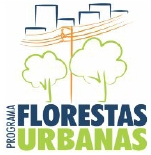 |
65

· Forest Compensation
Since 2012, Copel Geração e Transmissão has an agreement with the Environmental Institute of Paraná for the production of native forest seedlings. These seedlings are used in the restoration of Permanent Preservation Areas, Legal Forest Reserves and Forest Replenishment Areas of the State of Paraná.
Another significant partnership of Copel Geração e Transmissão is with the Environmental Police Battalion - BPAmb to ensure agility and effectiveness in the protection actions of the permanent preservation areas restored around its reservoirs, acting preventively in the protection of water bodies, fauna and flora.
Also within the scope of forest compensation, Copel Generation and Transmission is responsible for protecting and restoring habitats in areas of sustainable use and areas related to natural protection units.
Due to the suppression of vegetation in distribution lines and substations, Copel Distribuição carried out compensatory actions of forest replenishment through the delivery of seedlings to municipalities, for planting in urban areas, a total of 430 native forest seedlings and 1,345 urban afforestation seedlings.
· Carbon Credit Project
Elejor started its carbon credit account in October 2000. Under the name of Fundão Santa Clara Energetic Complex Project (FSCECP), its Project Design Document Form (PDD) was approved by the United Nations Framework Convention on Climate Change (UNFCCC/UN) in 2008.
Certified Emission Reductions (CER) are commoditized and in most cases prices follow BlueNext (www.bluenext.eu), which records all purchase and sale transactions worldwide. Their prices fluctuate in the same way as shares on a conventional stock exchange. The project is valid for 21 years and is reviewed every seven years under current Kyoto Protocol rules.
66

7. SOCIAL BALANCE SHEET
| | | | | | |
| ANNUAL SOCIAL BALANCE SHEET |
| On December 31, 2017 and 2016 |
| (In thousands of Reais, except when indicated otherwise) |
| | | | | 2017 | | 2016 |
| | 1 - CALCULATION BASIS | | | | | |
| NE 32 | Net Revenue (NR) | | 14.024.573 | | 13.101.753 | |
| | 2 - INTERNAL SOCIAL INDICATORS | | | % on RL | | % on RL |
| NE 33.2 | Management compensation | | 23.240 | 0,2 | 20.885 | 0,2 |
| | Employees compensation | | 942.312 | 6,7 | 923.454 | 7,0 |
| | Food (food voucher and other) | | 141.128 | 1,0 | 132.193 | 1,0 |
| | Compulsory payroll charges | | 316.680 | 2,3 | 307.057 | 2,3 |
| | Pension plan | | 80.180 | 0,6 | 76.583 | 0,6 |
| | Health (healthcare plan) | | 179.319 | 1,3 | 205.458 | 1,6 |
| | Training and professional development | | 7.645 | 0,1 | 11.091 | 0,1 |
| NE 33.2 | Profit sharing | | 68.817 | 0,5 | 64.814 | 0,5 |
| | Severance pay | | 53.468 | 0,4 | 44.276 | - |
| (1) | Other benefits | | 15.729 | 0,1 | 16.630 | 0,1 |
| | Total | | 1.828.519 | 13,0 | 1.802.441 | 13,8 |
| |
| | 3 - EXTERNAL SOCIAL INDICATORS | | | % Sobre RL | | % Sobre RL |
| | Culture | | 18.118 | 0,1 | 11.672 | 0,1 |
| | Health and sanitation | | 1.130 | - | 637 | - |
| | Sports | | 1.129 | - | 712 | - |
| | Other | | 72.911 | 0,5 | 63.693 | 0,5 |
| | Research and Development | | 41.318 | 0,3 | 38.485 | 0,3 |
| | Energy Efficiency Program | | 22.451 | 0,2 | 11.459 | 0,1 |
| | Morar Bem Program | | 3.044 | - | 5.142 | 0,0 |
| | Tarifa Noturna Program | | 1.576 | - | 2.447 | - |
| | Other | | 4.522 | - | 6.160 | - |
| | Total contribution to society | | 93.288 | 0,7 | 76.714 | 0,6 |
| | Taxes (except payroll charges) | | 7.626.806 | 54,4 | 8.580.273 | 65,5 |
| | Total | | 7.720.094 | 55,0 | 8.656.987 | 66,1 |
| |
| | 4 ENVIRONMENTAL INDICATORS | | | % Sobre RL | | % Sobre RL |
| | Investments related to corporate operations | | 980.140 | 7,0 | 887.405 | 6,8 |
| | Investments in programs and/or external projects | | 2.178 | - | 703 | - |
| | Total | | 982.318 | 7,0 | 888.108 | 6,8 |
| (2) | Quantity of environmental sanctions | | 4 | | 1 | |
| | Amount of environmental sanctions (R$ thousands) | | 361 | | 19 | |
| | Environmental goals | | | 2017 | | Metas 2018 |
| | | | ( ) has no targets | ( ) has no targets |
| | Regarding the establishment of annual targets to reduce waste;general | ( ) meets 51% to 75% of targets | ( ) meets 51% to 75% of targets |
| | consumption regarding production/operations; and increasing the efficacy inthe | ( ) meets 0% to 50% of targets | ( ) meets 0% to 50% of targets |
| | use of natural resources, the company: | | (X) meets 76% to 100% of targets | (X) meets 76% to 100% of targets |
| |
| | NE - Note | | | | | |
67

| | | | | | | |
| | | | | 2017 | | | 2016 |
| | 5 EMPLOYEES INDICATORS (including subsidiaries) | | | | | | |
| | Employees at the end of the period | | | 8.432 | | | 8.716 |
| | New hires in the period | | | 76 | | | 97 |
| | Level of education of employees: | Homens | Men | Women | Men | Women | Total |
| | Total Post-Secondary and University Extension | 3.132 | 1.311 | 4.443 | 3.098 | 1.320 | 4.418 |
| | Total Senior High School | 3.254 | 585 | 3.839 | 3.500 | 629 | 4.129 |
| | Total Junior High School | 143 | 7 | 150 | 161 | 8 | 169 |
| | Employees Age Grade: | | | | | | |
| | From 18 to 30 years old (exclusive) | | | 678 | | | 878 |
| | From 30 to 45 years old (exclusive) | | | 4.282 | | | 4.290 |
| | From 45 to 60 years old (exclusive) | | | 3.339 | | | 3.432 |
| | Over 60 years old | | | 133 | | | 116 |
| | Women working in the company | | | 1.903 | | | 1.957 |
| | % Women in management positions: | | | | | | |
| | In relation to total number of women | | | 5,7 | | | 5,7 |
| | In relation to total number of managers | | | 20,4 | | | 20,1 |
| | Afro descendants working in the company | | | 1.068 | | | 970 |
| | % Afro descendants in management positions: | | | | | | |
| | In relation to total number of afro-descendants | | | 3,6 | | | 3,6 |
| | In relation to total number of managers | | | 7,2 | | | 6,3 |
| | Persons with special needs | | | 176 | | | 223 |
| | Dependents | | | 15.401 | | | 14.711 |
| (3) | Outsourced | | | 7.009 | | | 5.670 |
| (4) | Apprentices | | | 238 | | | 227 |
| (4) | Interns | | | 239 | | | 292 |
| | No. of labor claims in course at the end of the year | | | | | | |
| | | | | 4.461 | | | 4.476 |
| | No. of labor claims closed in the year | | | 1.391 | | | 1.128 |
| | 6 MATERIAL INFORMATION REGARDING THE EXERCISE OF CORPORATE CITIZENSHIP | | | | | |
| | Ratio between the highest and the lowest salary | | | 19 | | | 19 |
| (5) | Number of Occupational Accidents | | | | | | |
| | (including accidents with outsourced employees) | | | 257 | | | 144 |
| | Total number of consumer complaints and criticisms: | | | | | | |
| | with the company | | | 80.922 | | | 43.453 |
| (6) | with Procon agency | | | 9.558 | | | 5.312 |
| | in Court | | | 4.805 | | | 3.644 |
| | Percentage of complaints and criticisms answered or resolved: | | | | | | |
| | by the company | | | 99,7% | | | 99,0% |
| (6) | by Procon agency | | | 100,0% | | | 94,7% |
| | in Court | | | 14,8% | | | 15,0% |
68

| | |
| | 2017 | Metas 2018 |
| Social and environmental projects developed by the company were defined by | Executive board and managers | executive board and managers |
| Safety and health standards in the workplace were defined by: | all + Cipa | all + Cipa |
| Regarding freedom of association, collective bargaining rights and internal | encourages and follows ILO | encourages and will follow ILO |
| representation of workers, the company: | standards | standards |
| Private pension plans cover: | all | all |
| Profit sharing includes: | all | all |
| In the selection of suppliers, the same ethical, social responsibility and environmental standards adopted by the company: | are required | are required |
| Regarding participation of employees in volunteer work, the company: | organizes and encourages | will organize and encourage |
| 7- WEALTH GENERATION AND DISTRIBUTION | 2017 | 2016 |
| Total added value to be distributed | 11.772.831 | 12.748.363 |
| Value Added Distribution (DVA): | | |
| Third Parties | 10,8% | 12,3% |
| Personnel | 12,8% | 11,7% |
| Government | 66,9% | 69,2% |
| Shareholders | 3,2% | 2,0% |
| Withheld | 6,3% | 4,8% |
| 8 - OTHER INFORMATION | | |
| " Begining 2010, the Brazilian Institute of Social and Economic Analyses (Ibase) no longer requires use of its Social Balance Sheet standard, given that the Institute understands that this tool and methodology are already commonly used by companies, consulting firms and institutes that promote corporate social responsibility in Brazil. Accordingly, Copel, which had already been using this model since 1999, grounded on Ibase guidance, decided to improve the presentation of its Social Balance Sheet by addressing te information requeired by NBCT 15, aiming at transparency of its information. |
| " The Notes (NEs) are na integral part of the Financial Statements and contain other socio-environmental information not included in this Social Balance Sheet. |
| " This Social Balance Sheet includes data about Copel's holding, wholly-owned subsidiaries, subsidiaries and consortiums, due to the consolidation of the Company's results, except when stated otherwise. |
| (1) The item "Other Benefits" includes: additional sick pay, extended maternity leave, insurance, additional transportation ticket, disability allowance, accidental death, day-care assistance, education allowance, culture and occupational and medical safety. |
(2) Information regarding fines and socio-environmental assessments of the holding and Copel Distribuição S.A., Copel Geração e Transmissão S.A, Copel Telecomunicações S.A., Copel Comercialização S.A. and Copel Renováveis S.A. These original amounts may change according to the answer to the administrative defense submitted to the environmental authority. The amounts of the sanctions are proportional to Copel's equity interest in the developments.
Amounts regarding the Deeds of Commitment - TCs and Conduct Adjustment Agreements - TACs are included in external or socio-environmental indicators, depending on their nature. |
| (3) This number corresponds to total outsourced workers hired in the period, regardless of the number of hours worked. It does not include the number of outsourced positions; contractors who work in the implementation of Copel Geração e Transmissão ans the subsidiaries (Plants, Transmission Lines and substations); or those working on the expansion of the Copel Telecom system. |
| (4) Not included in the Company's headcount. | | |
| (5) Calculated using the methodology used in the GRI Sustainability Report G4 - indicator LA6. | |
| (6) Includes the complaints in the Procon, Ombudsman, Consumer Gov.Aneel and Anatel deemed appropriate. | |
69

8. COMPOSITION OF GROUPS RESPONSIBLE FOR GOVERNANCE
BOARD OF DIRECTORS | |
Chairman | MAURICIO SCHULMAN |
Members | Joel nazareno iurk GEORGE HERMANN RODOLFO TORMIN ROGÉRIO PERNA MARCO ANTÔNIO BARBOSA CÂNDIDO LEILA ABRAHAM LORIA OLGA STANKEVICIUS COLPO SÉRGIO ABU JAMRA MISAEL ADRIANA ANGELA ANTONIOLLI |
STATUTORY AUDIT COMMITTEE | |
Chairman | MAURICIO SCHULMAN |
Financial Specialist Members | ROGÉRIO PERNA MARCO ANTÔNIO BARBOSA CÂNDIDO LEILA ABRAHAM LORIA OLGA STANKEVICIUS COLPO |
FISCAL COUNCIL | |
Members | Gilmar Mendes Lourenço MAURO RICARDO MACHADO COSTA ROBERTO LAMB LETÍCIA PEDERCINI ISSA MAIA |
| |
EXECUTIVE BOARD | |
CEO | Jonel nazareno iurk |
Business Management Officer | vago |
Finance and Investor Relations Officer | ADRIANO RUDEK DE MOURA |
Business Development Officer | José marques filho |
Institutional Relations Officer | harry françóia jÚnior |
Governance, Risk and Compliance Officer | vicente loiácono neto |
Deputy Officer | PAULO CESAR KRAUSS |
| |
ACCOUNTANT | |
CRC-PR-045809/O-2 | ADRIANO FEDALTO |
| |
More details on this report: | |
Investor Relations: | Phone: +55 (41) 3222-2027 ri@copel.com |
70


Companhia Paranaense de Energia
Corporate Taxpayer's ID (CNPJ/MF) 76.483.817/0001-20
State registration 10146326-50
Publicly-Held Company - CVM 1431-1
www.copel.com copel@copel.com
Rua Coronel Dulcídio, 800, Batel - Curitiba - PR
CEP 80420-170
FINANCIAL STATEMENTS
2017

CONTENTS
| | | | | |
| FINANCIAL STATEMENTS | | 3 |
| Statements of Financial Position | 3 | |
| Statements of Income | 5 | |
| Statements of Comprehensive Income | 6 | |
| Statements of Changes in Equity | 7 | |
| Statements of Cash Flows | 8 | |
| Statements of Added Value | 10 | |
| NOTES TO THE FINANCIAL STATEMENTS | | 12 |
| 1 | | Operations | 12 | |
| 2 | | Concessions and Authorizations | 14 | |
| 3 | | Basis of Preparation | 17 | |
| 4 | | Significant Accounting Policies | 19 | |
| 5 | | Cash and Cash Equivalents | 39 | |
| 6 | | Bonds and Securities | 40 | |
| 7 | | Trade Accounts Receivable | 41 | |
| 8 | | CRC Transferred to the State Government of Paraná | 43 | |
| 9 | | Net Sectorial Financial Assets and Liabilities | 43 | |
| 10 | | Accounts Receivable Related to the Concession | 48 | |
| 11 | | Accounts Receivable Related to Concession Compensation | 51 | |
| 12 | | Other Receivables | 52 | |
| 13 | | Taxes | 53 | |
| 14 | | Prepaid Expenses | 58 | |
| 15 | | Receivables from Related Parties | 60 | |
| 16 | | Other Temporary Investments | 62 | |
| 17 | | Judicial Deposits | 63 | |
| 18 | | Investments | 63 | |
| 19 | | Property, plant and equipment | 68 | |
| 20 | | Intangible assets | 78 | |
| 21 | | Payroll, Social Charges and Accruals | 81 | |
| 22 | | Suppliers | 82 | |
| 23 | | Loans and Financing | 83 | |
| 24 | | Debentures | 88 | |
| 25 | | Post-employment benefits | 90 | |
| 26 | | Customer Charges Due | 96 | |
| 27 | | Research and Development and Energy Efficiency | 96 | |
| 28 | | Accounts Payable Related to Concession | 97 | |
| 29 | | Other Accounts Payable | 98 | |
| 30 | | Provisions for Legal Claims | 98 | |
| 31 | | Equity | 106 | |
| 32 | | Net Operating Revenue | 110 | |
| 33 | | Operating Costs and Expenses | 114 | |
| 34 | | Financial Results | 118 | |
| 35 | | Operating Segments | 118 | |
| 36 | | Financial Instruments | 122 | |
| 37 | | Related Party Transactions | 137 | |
| 38 | | Commitments | 140 | |
| 39 | | Insurance | 140 | |
| 40 | | Additional Information to the Statement of Cash Flows | 141 | |
| 41 | | Subsequent Events | 141 | |
| INDEPENDENT AUDITOR S REPORT | | 144 |
| SUMMARY OF THE STATUTORY AUDIT COMMITTEE S ANNUAL REPORT | | 151 |
| SUPERVISORY BOARD S OPINION ON THE ANNUAL MANAGEMENT REPORT | | 154 |
| CAPITAL BUDGET PROPOSAL | | 155 |
| STATEMENT | | 156 |
1.1.2

FINANCIAL STATEMENTS
Statements of Financial Position
as of December 31, 2017 and 2016
All amounts expressed in thousands of Brazilian reais
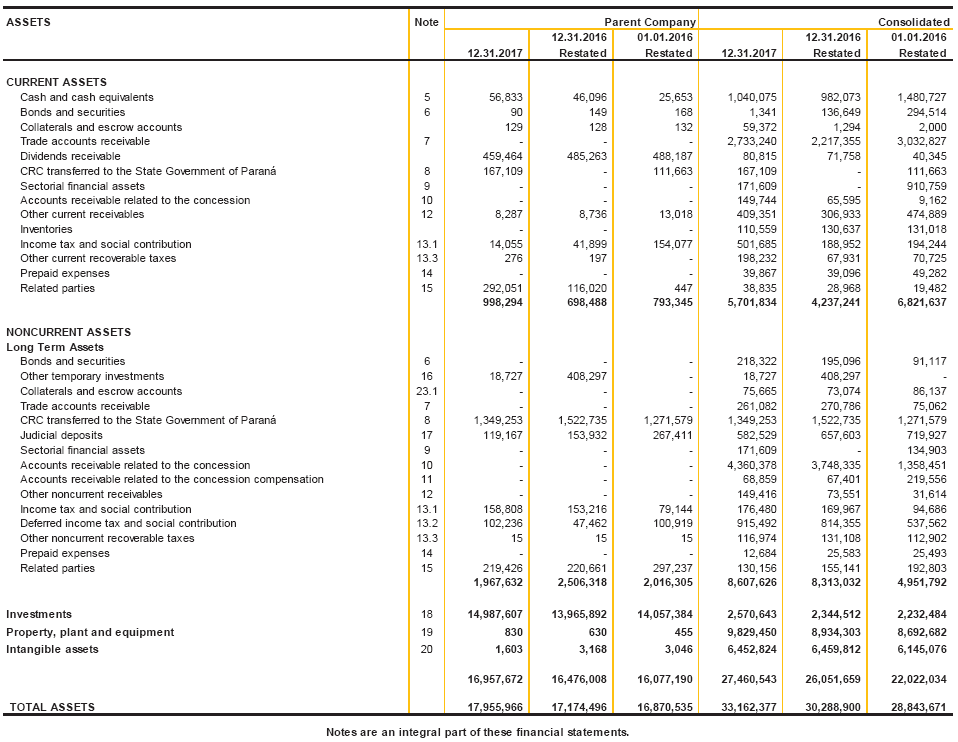
3

Statements of Financial Position
as of December 31, 2017 and December 31, 2016 (continued)
All amounts expressed in thousands of Brazilian reais
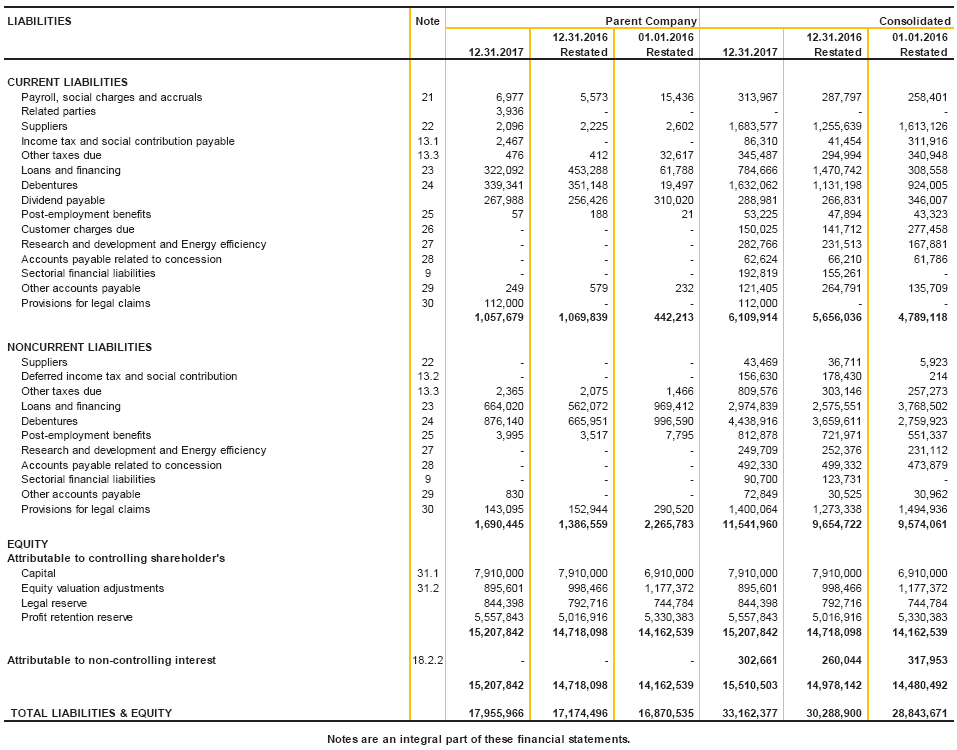
4

Statements of Income
for the years ended December 31, 2017 and 2016
All amounts expressed in thousands of Brazilian reais
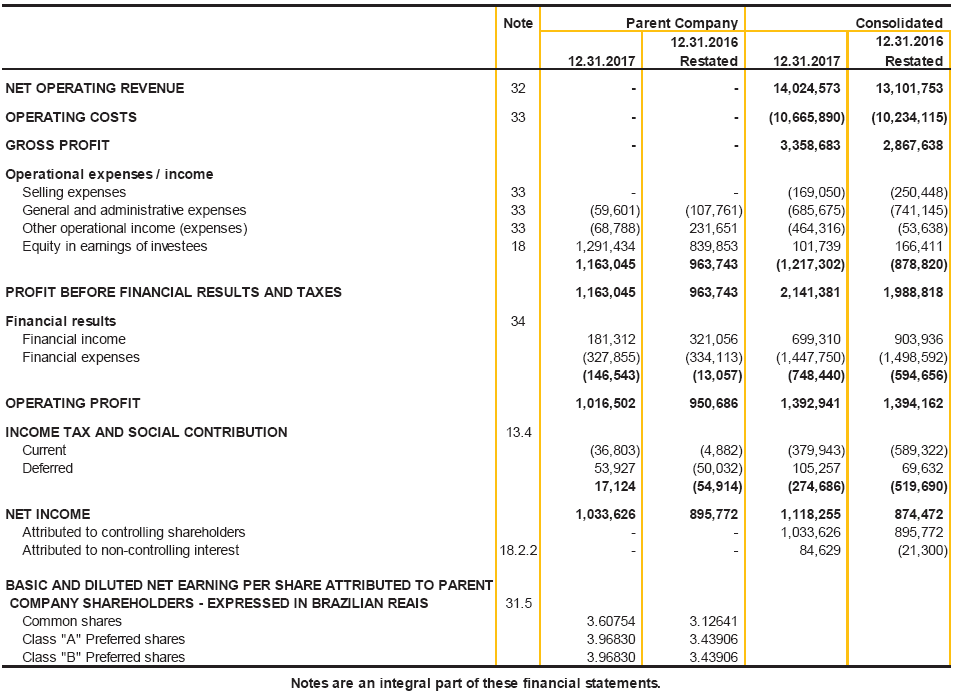
5

Statements of Comprehensive Income
for the years ended December 31, 2017 and 2016
All amounts expressed in thousands of Brazilian reais
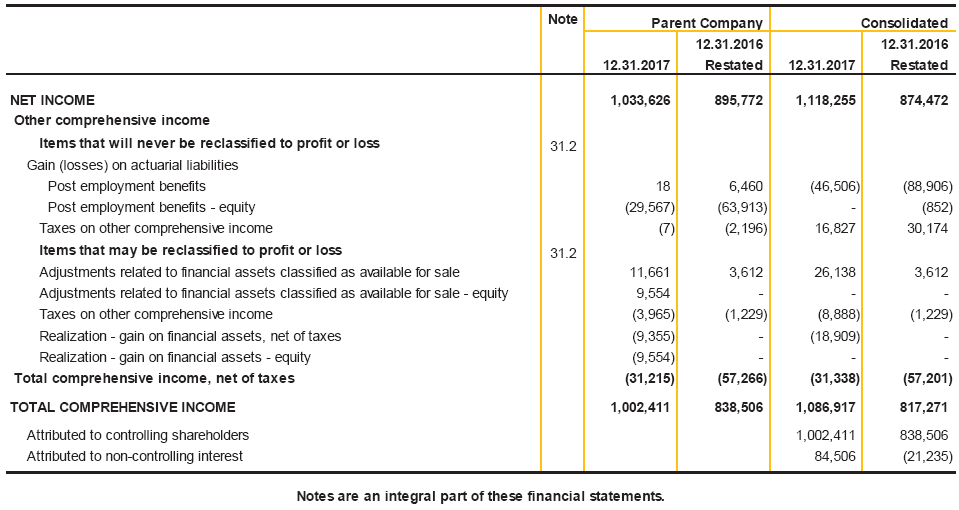
]
6

Statements of Changes in Equity
for the years ended December 31, 2017 and 2016
All amounts expressed in thousands of Brazilian reais
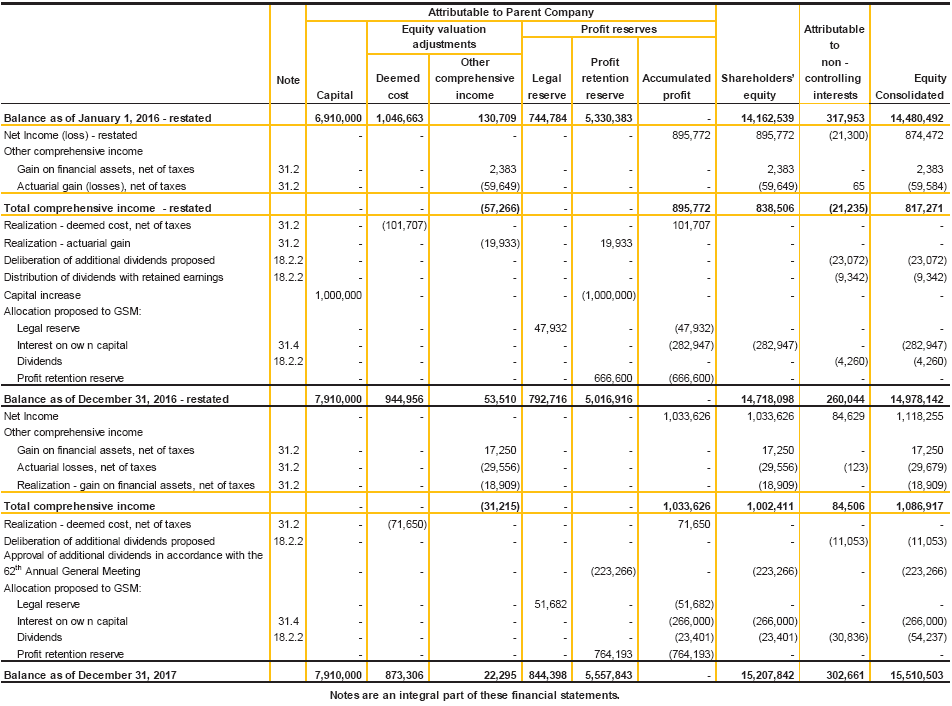
7

Statements of Cash Flows
for the years ended December 31, 2017 and 2016
All amounts expressed in thousands of Brazilian reais
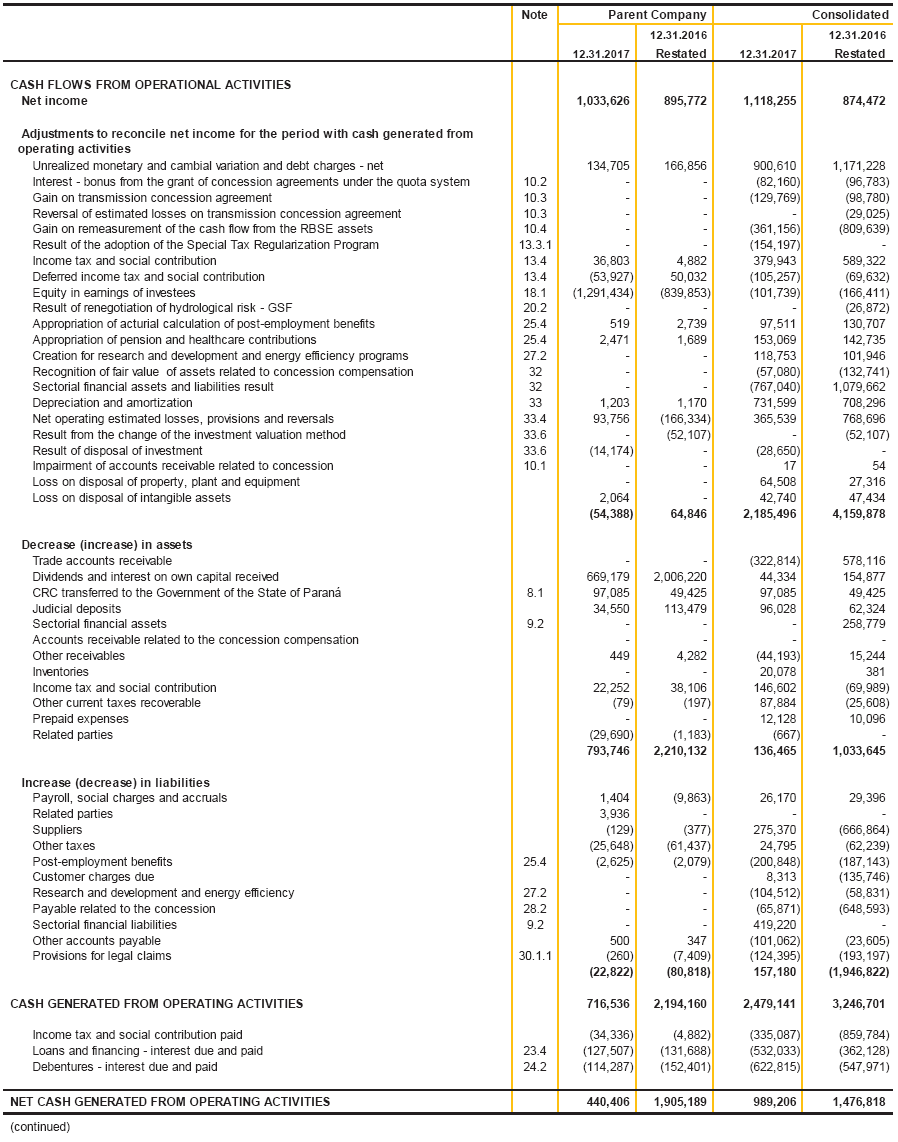
8

Statements of Cash Flows
for the years ended December 31, 2017 and 2016 (continued)
All amounts expressed in thousands of Brazilian reais
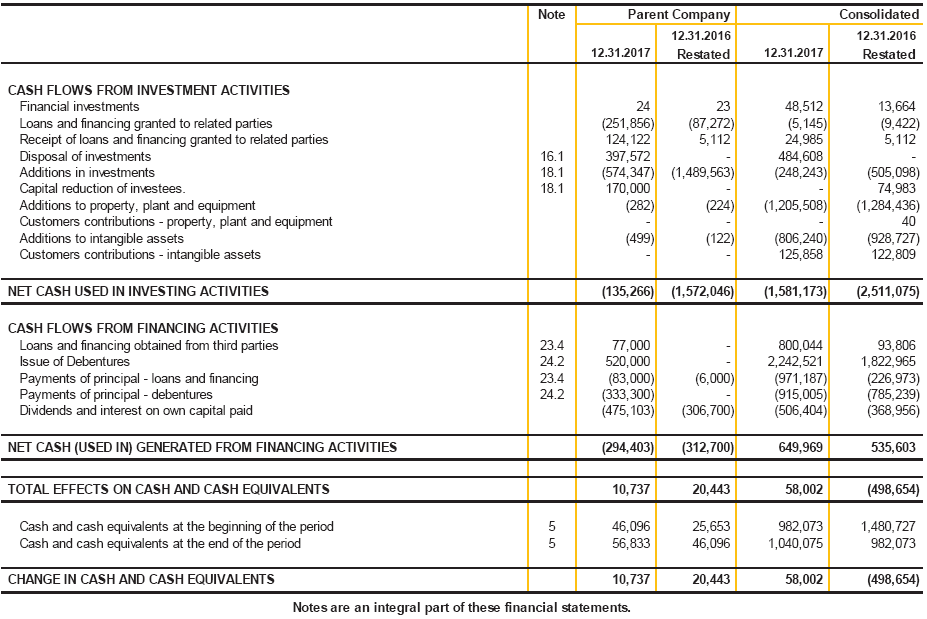
9

Statements of Added Value
for the years ended December 31, 2017 and 2016
All amounts expressed in thousands of Brazilian reais
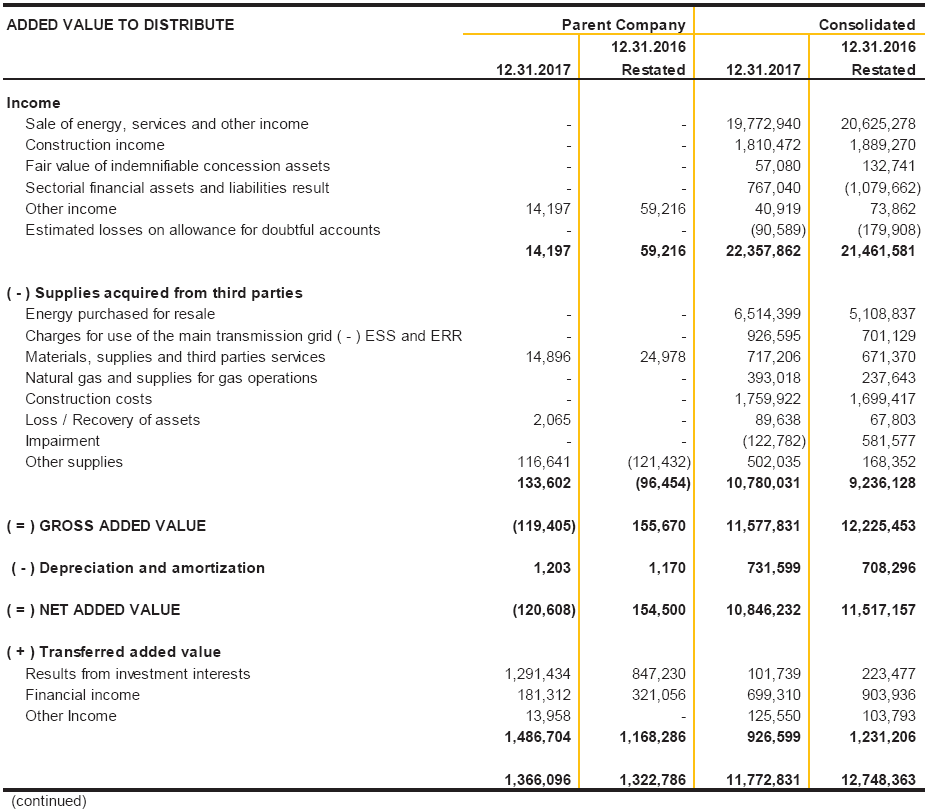
10

Statements of Added Value
for the years ended December 31, 2017 and 2016 (continued)
All amounts expressed in thousands of Brazilian reais
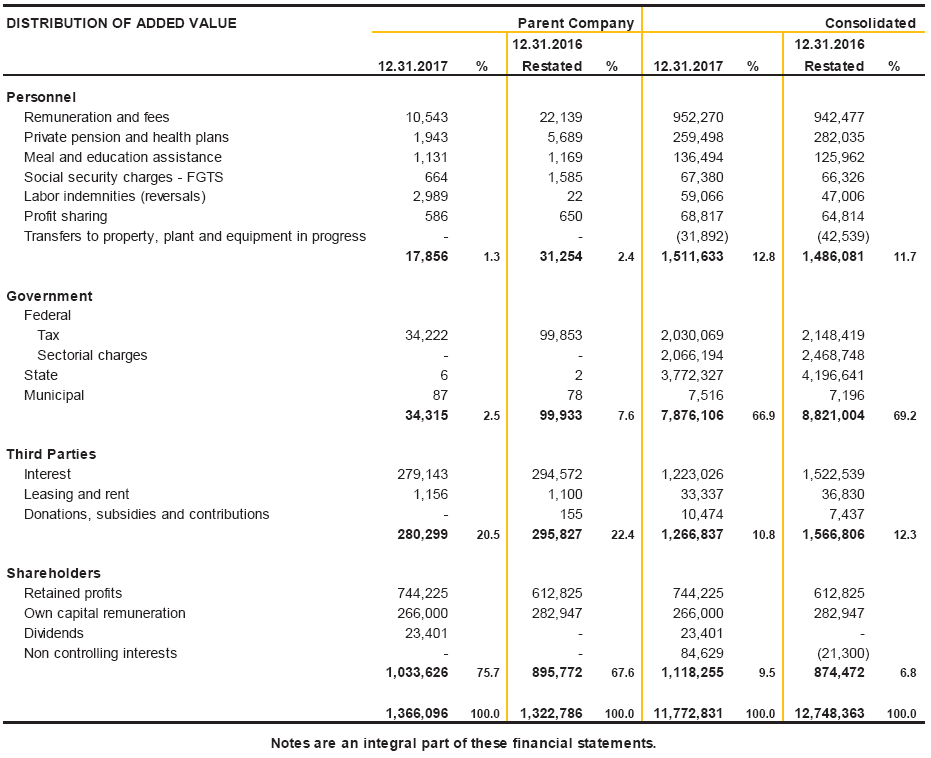
11

NOTES TO THE FINANCIAL STATEMENTS
for the years ended December 31, 2017 and 2016
All amounts expressed in thousands of Brazilian reais, unless otherwise stated
1 Operations
Companhia Paranaense de Energia (Copel, Company or Parent Company), with its headquarters at Rua Coronel Dulcídio, 800, Curitiba - State of Paraná, is a publicly-held mixed capital company controlled by the State of Paraná and its shares are traded on Corporate Governance Level 1 of the Special Segments Listing of B3 S.A. - Brasil, Bolsa Balcão and also on the New York Stock Exchange (NYSE) and on the Madrid Stock Exchange in the Latin American segment (Latibex).
The core activities of Copel and its subsidiaries, regulated by the Brazilian Electricity Regulatory Agency (ANEEL), linked to the Ministry of Mines and Energy (MME), is to research, study, plan, build and explore the production, transformation, distribution and trading of energy in any of its forms, primarily electricity. Furthermore, Copel participates in consortiums and in private sector and mixed-capital companies for the purpose of engaging in activities, primarily in the fields of energy, telecommunications, and natural gas.
1.1 Copel’s equity interests
Copel has direct and indirect interests in subsidiaries (1.1.1), joint ventures (1.1.2), associates (1.1.3) and joint operations (1.1.4).
12

1.1.1 Subsidiaries
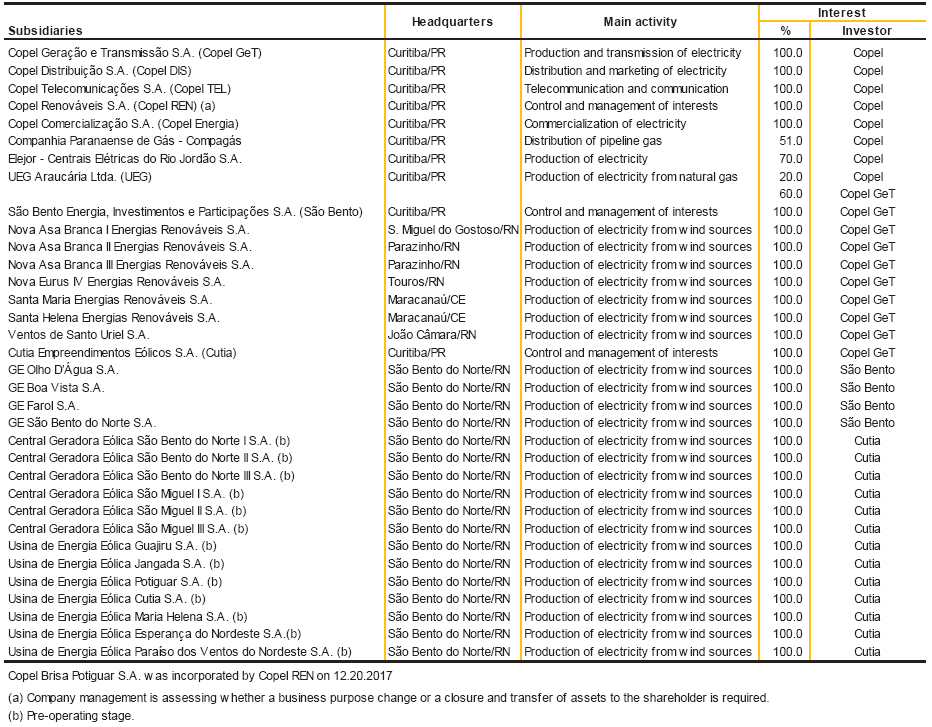
1.1.2 Joint ventures
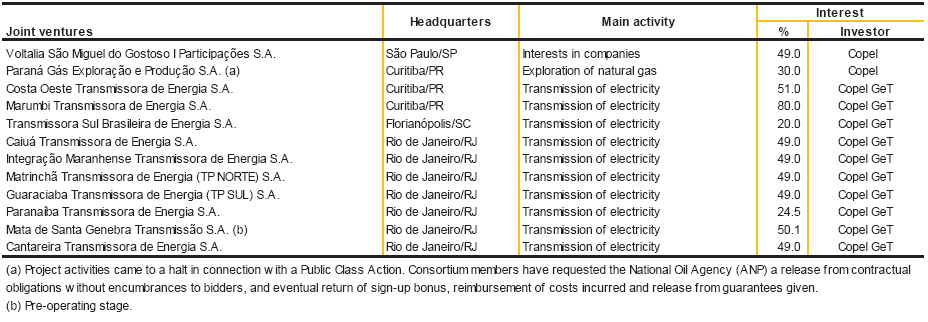
13

1.1.3 Associates

1.1.4 Joint operations (consortiums)

2 Concessions and Authorizations
2.1 Concessions contracts or authorizations obtained by Copel
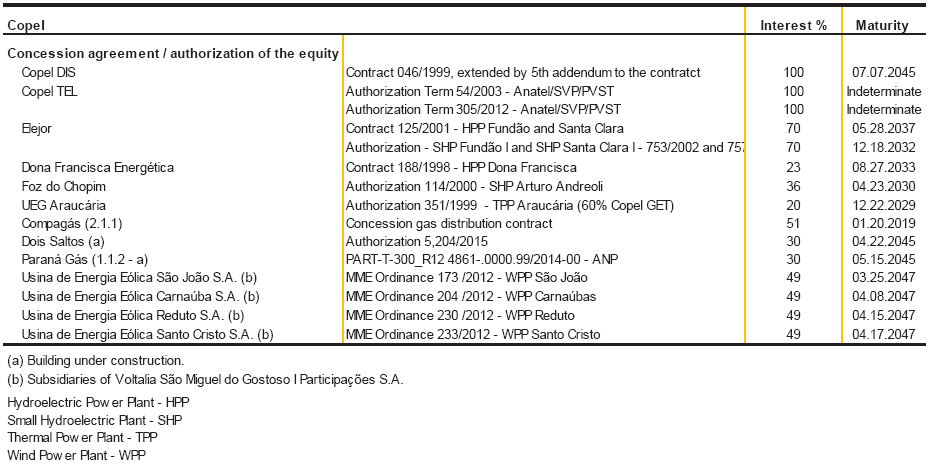
2.1.1 Compagás
Compagás is a party to a concession agreement entered into with the Concession Grantor, the State of Paraná, setting July 6, 2024 as the expiry date of the concession. Such date has always been announced and considered for assessment of the balances of the prior-year financial statements.
14

On December 7, 2017, the State of Paraná published Supplementary Law 205, introducing a new interpretation of the expiry of the concession, understanding that expiry will be on January 1, 2019.
The management board of Compagás, its Parent company and other shareholders are looking into and challenging the effects of the aforesaid law, understanding that they conflict with the provisions of the concession agreement currently in force. However, as by the end of issuance of these financial statements such discussion had not yet been closed and that law continues in force, the effects on the financial statements for 2017 had to be taken into consideration.
Management will continue to make its best efforts to protect the Company interests, aiming to appropriately settle the impacts of the new interpretation given by the Concession Grantor and find alternatives necessary to maintain the concession in a sustainable manner.
The impacts on Compagás financial statements for 2017 by accelerating the expiry of the concession are as follows:

15

2.2 Concession contracts or authorizations obtained by Copel GeT and is investees
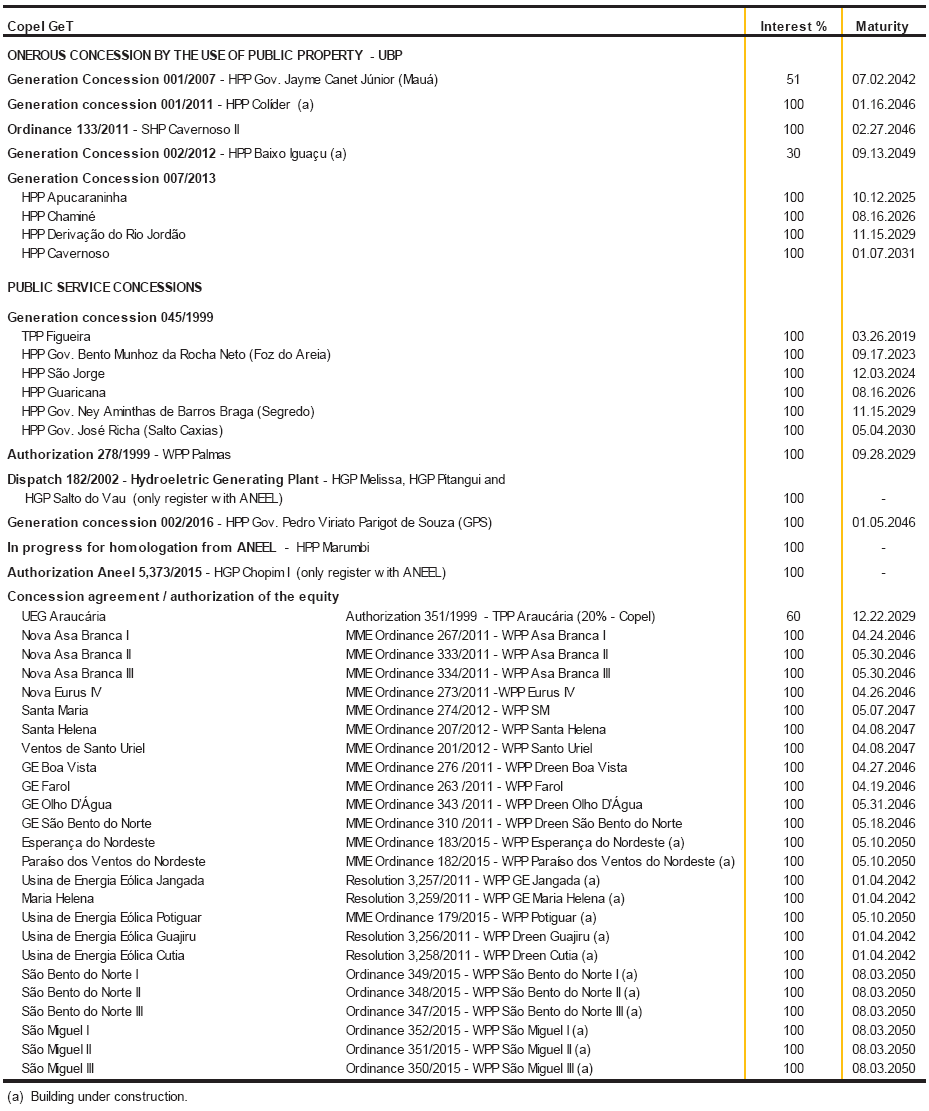
16

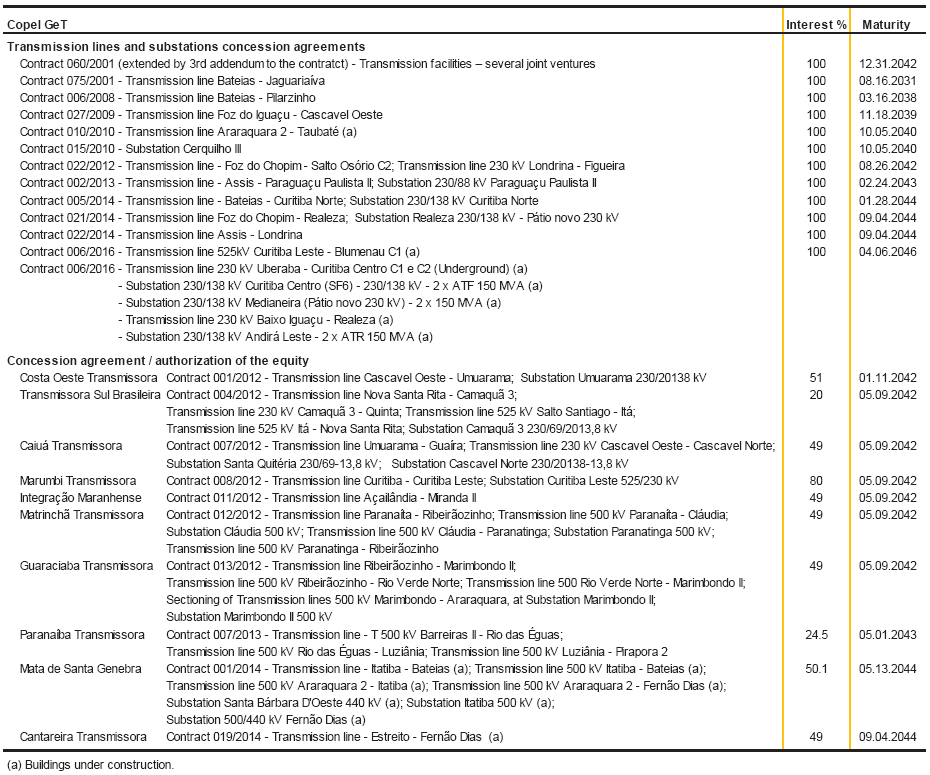
3 Basis of Preparation
3.1 Statement of compliance
The individual financial statements of the Parent Company and the consolidated financial statements have been prepared in accordance with International Financial Reporting Standards (IFRS) issued by the International Accounting Standards Board, IASB, as well as with accounting practices adopted in Brazil (BR GAAP), which comprise the standards, guidelines and interpretations issued by the Accounting Pronouncements Committee (Comitê de Pronunciamentos Contábeis or CPC) and approved by the Brazilian Securities and Exchange Commission (Comissão de Valores Mobiliários or CVM) and Federal Accounting Council (Conselho Federal de Contabilidade – CFC).
Company's management believes that all the relevant information used in its management is evidenced in the individual and consolidated financial statements.
17

On April 12, 2018, the individual and consolidated financial statements were issued subject to qualified opinion in the auditor’s report specifically regarding the investment fund theme maintained by the subsidiary UEG Araucária, as detailed in Note 4.1.1.
The work related to the investigation process was materially completed after that date and the analysis of the classification and measurement of the investment was concluded, taking into account all the information known today that was present and should have been considered at the preparation of the financial statements for 2015 and 2016.
Accordingly, Management concluded on the need to restate individual and consolidated financial statements as of December 31, 2017 with the comparative balances of December 31, 2016 and January 1, 2016. The effect on the balances of the financial statements as of December 31, 2017, considering what was disclosed on April 12, 2018 and the restated on this date, was a reduction of assets and shareholders' equity in the amount of R$19,270, with no impact on net income for 2017. The effects of the restatement of the balances at December 31, 2016 and January 1, 2016 are detailed in Note 4.1.1.
The issuance of these restated individual and consolidated financial statements was approved by Management on May 14, 2018.
3.2 Functional and presentation currency
The individual and consolidated financial statements are presented in Brazilian Reais, which is the functional currency of the Company. The financial information has been rounded to the nearest thousand, unless otherwise indicated.
3.3 Basis of measurement
The financial statements were prepared based on the historical cost, except for certain financial instruments measured at fair value and investments, as described in the respective accounting policies and notes.
3.4 Use of estimates and judgments
In the preparation of these financial statements, Management used judgments, estimates and assumptions that affect the application of accounting policies and the reported amounts of assets, liabilities, income and expenses of the Company and its subsidiaries. Actual results may differ from those estimates.
Estimates and assumptions are reviewed on a continuous basis. Reviews of estimates are recognized in the period in which it is revised (prospective basis).
3.4.1 Judgments
Information about judgment referring to the adoption of accounting policies which impacts significantly the amounts recognized in the consolidated financial statements, except those involving estimates, is included in the following notes:
· Note 4.2 - Basis of consolidation; and
· Note 4.3 - Financial instruments.
18

3.4.2 Uncertainties on assumptions and estimates
Information on uncertainties related to assumptions and estimates that pose a significant risk of resulting in a material adjustment within the next financial year is included in the following notes:
· Notes 4.3.8 and 9 - Sectorial financial assets and liabilities;
· Notes 4.5 and 19 - Property, plant and equipment;
· Notes 4.6 and 20 - Intangible assets;
· Notes 4.7 and 19.9 - Impairment of assets;
· Notes 4.8 and 30 - Provisions for litigation and contingent liabilities;
· Note 4.9.1 - Unbilled revenues;
· Note 4.9.2 – Interest;
· Note 4.11 - Power purchase and sales transactions in the Spot Market (Electric Energy Trading Chamber – CCEE);
· Note 7.3 - Estimated losses for doubtful accounts;
· Note 10.4 - Remeasurement of financial asset RBSE;
· Note 11 - Accounts receivable from the indemnity for the concession;
· Note 13.2 - Deferred income tax and social contribution; and
· Note 25 - Post-employment benefits.
3.5 Management's Judgment on Going Concern
Management has concluded that there are no material uncertainties that cast doubt on the Company’s ability to continue as a going concern. No events or conditions were identified that, individual or in the aggregate, may raise significant doubts on its ability to continue as a going concern.
The main bases of judgment used for such conclusion are: (i) main activities resulting from long-term concessions; (ii) robust shareholders equity; (iii) strong operating cash generation, including financial capacity to settle commitments entered into with financial institutions; (iv) historical series of profits in the last fiscal years; and (v) fulfillment of the objectives and targets set forth in the Company's Strategic Planning, which is approved by Management, monitored and reviewed periodically, seeking the continuity of its activities.
4 Significant Accounting Policies
4.1 Restatement of comparative balances
The Company’s management adjusted the financial statements at December 31, 2016 and January 1, 2016 as follows:
19

4.1.1 Investments
During the preparation of our unaudited consolidated interim financial information as of September 30, 2017, the Company's Management identified an investment by its indirect subsidiary UEG Araucária Ltda. in a Multimarket Investment Fund, which held shares of other investment funds that in turn invested in a private company, whose main asset was a real estate development. As of September 30, 2017, such investment corresponded to R$157,079 and was recognized under “Bonds and Securities”, in current assets, because, according to information delivered by the management of UEG Araucária to the Company’s Management, that investment was made in a wholly-owned fund, whose benchmark was 103.5% of the CDI (Interbank Deposit Certificate) rate and that was composed of shares issued by other investment funds and government bonds, with immediate liquidity and that were available for sale.This investment amounted to R$165,749 as of December 31, 2016 and R$111,760 as of January 1, 2016, and was also recognized under “Bonds and Securities”.
In order to determine the value of such investment and its accounting classification, as well as the extent of any possible impact, the Company's Management relied on independent experts in accordance with best governance practices, including an internal investigation into the circumstances of the investment. The valuation has already been concluded and the investigations are in their final stage. These investigations found that the investment occurred strictly in the UEG Araucária and violated Copel’s investment policy, which authorizes investments in wholly-owned investment funds only to the extent such funds invest exclusively in bonds issued by the Brazilian federal government or by financial institutions controlled by the Brazilian federal government.
Based on the information available during the preparation of the financial statements for 2017, we concluded that it is necessary to recognize a provision for the impairment of the investment in light of its specific characteristics, such as the status of its underlying real estate development and the outlook for its future cash flow generation. It was also evaluated that this provision should have been recorded in prior years if the information known during the preparation of these financial statements, which were already available at the time, had been considered when preparing the financial statements for 2016 and 2015.
In the course of preparing our financial statements, were analyzed all legal and corporate documents of the investment fund and it was concluded that from July 2015, UEG Araucária started to have significant influence in the private company, even though indirectly. Thus, from July 2015, the remaining balance of the investment, until then classified as a financial instrument measured by its fair value, became measured and disclosed as an associate, and the effects of the change in the asset classification were recorded in the company's profit or loss of that year.
Supported by a report prepared in March 2018 by an independent appraisers engaged by Copel, the Company’s Management determined the fair value of the financial instrument as of July 2015, identifying the necessity to reduce the asset by R$99,031. From then on, the remaining balance, became an investment in an associate, was decreased by an additional provision for devaluation of R$4,955. Accordingly, the total reduction on January 1, 2016 was R$103,986.
20

In the fiscal year ended December 31, 2016, was identidied additional provision for devaluation of R$52,201, of which R$55,284 was the result of equity in earnings of investees, R$4,300 as financial expense and R$7,383 as financial income.
Hence, the financial statements at December 31, 2016 and January 1, 2016, presented for comparative purposes, have been restated so that the remaining balances of these investment, in the amounts of R$9,562 at December 31, 2016 and R$7,774 at January 1, 2016 was also reclassified to non-current assets, as Investments.
The impact of the above in the Holding’s individual financial statements was the decrease in “Investments”, recognized in “Equity in Earnings of Investees”, int the amount of R$44,227 as of December 31, 2016 and R$83,189 as of January 1, 2016.
4.1.2 Provisions for legal claims - CVA tax regime
In 2017 Copel DIS recognized prior period adjustments to the account of provisions related to tax litigation due to the taxation of the Offsetting and Variation of Tranche A account - CVA, currently classified as Sectorial financial assets and liabilities. The impact of these adjustments represents at December 31, 2016 an increase by R$31,995 in Financial expenses versus Provision for legal claims, in noncurrent liabilities, and an increase by R$10,878 in Deferred income tax and social contribution in the income statement versus Deferred taxes, in noncurrent assets. The loss for the year incurred by Copel increased by R$21,117.
The effect on the Parent Company’s individual financial statements decreased by R$21,117 in investments versus Equity interest in investees.
4.1.3 Effects of restatement of comparative balances
Based on the guidelines of CPC 23 - Accounting Policies, Changes in Accounting Estimates and Correction of Errors, the Statements of Financial Position and Statements of Income, of Comprehensive Income, of Changes in Equity, of Cash Flows and of Value Added are being restated for comparison purposes:
21


22


4.2 Basis of consolidation
4.2.1 Calculation of equity in earnings of investees
Investments in subsidiaries, joint ventures and associates are recognized in the investor’s individual financial statements using the equity accounting method. Under this method, investments are initially recorded at cost and their carrying value is increased or decreased through the recognition of the investor's interest in profit, loss and other comprehensive income generated by the investees subsequent to their acquisition. The use of this method should be discontinued as from the date on which the investment stops being qualified as subsidiary, joint venture or associate.
Payment of dividends decreases the carrying value of investments.
When required, for calculation of equity in earnings of investees, the investees' financial statements are adjusted to adapt their policies to the Parent Company's accounting policies.
4.2.2 Subsidiaries
The subsidiaries are entities to which the investor is exposed to, or has a right over the variable returns arising from its involvement with them and has the ability to affect those returns exerting its power over the entities.
The financial statements of the subsidiaries are included in the consolidated financial statements as from the date they start to be controlled by the Company until the date such control ceases.
The balances of the subsidiaries’ assets and liabilities, and profit or loss, are consolidated and transactions between consolidated companies are eliminated.
4.2.3 Interest of non-controlling shareholders
Non-controlling interest is presented in equity, separately from the equity attributable to the Parent Company's shareholders. Profits, losses and other comprehensive income are also allocated separately from the ones allocated to the Parent Company's shareholders, even if this results in non-controlling interest having a deficit balance.
23

4.2.4 Joint ventures and associates
Joint ventures are entities over which the Company, subject to an agreement, has the ability to affect returns exerting its power in conjunction with other parties, irrespective of the percentage of interest in the voting capital.
Associates are entities over which the Company exerts significant influence regarding financial and operational decisions, without control.
When the share in losses of a joint venture or associate equals or exceeds the accounting balance of the investor’s equity interest in the investee, the investor should discontinue the recognition of its share in future losses. Additional losses will be considered, and a liability will be recognized, only if the investor incurs legal or constructive obligations, or performs payments on behalf of the investee. Should the investee subsequently determine profits, the investor should resume the recognition of its interest in these profits only subsequent to the point at which the portion to which it is entitled to in these subsequent profits equals its share in unrecognized losses.
4.2.5 Joint operations (consortiums)
Joint operation is a joint business according to which parties that jointly control the business have rights on assets and obligations regarding liabilities related to the business.
Joint operations are recorded in the Company holding the share, in proportion to the quotas of assets, liabilities and income (loss).
4.3 Financial instruments
The Company and its subsidiaries do not use derivative financial instruments.
Non-derivative financial instruments are recognized on the trading date, i.e. when the obligation or right arises. They are initially recognized at fair value plus any directly attributable transaction costs.
Fair values are determined based on the market quotation, for financial instruments traded in active markets, and for those with no quotations available on the market, fair values are determined by the present value of expected cash flows method.
After the initial recognition, the non-derivative financial instruments are measured as described below:
Financial assets
4.3.1 Financial instruments at fair value through profit or loss
Financial instruments designated as such upon initial recognition are classified as held for trading and if the Company and/or its subsidiaries manage these investments and make purchase or sale decisions based on their fair value in the context of an investment and risk management strategy. After initial recognition, transaction costs and attributable interests, when incurred, are recognized through profit and loss.
24

4.3.2 Loans and receivables
This category only comprises non-derivative assets with fixed or determinable payments which are not quoted in any active markets. They are measured using the amortized cost or effective interest rate methods.
4.3.3 Financial instruments available-for-sale
The initial and subsequent measurement of financial instruments classified as “available for sale” is based on their fair value. The changes in the fair value resulting from the difference between the market interest rates and the effective interest rates are recognized in other comprehensive income, net of taxes. Interest set at the beginning of the agreement, calculated based on the effective interest rate method, as well as any changes in expected cash flows, are recognized directly in income for the period. At settlement of a financial instrument classified as available for sale, any gains or losses recognized in OCI are reclassified to income for the year.
4.3.4 Financial instruments held to maturity
If the Company and its subsidiaries are interested in and capable of holding any financial assets until maturity, they are classified as held to maturity. They are measured at amortized cost using the effective interest rate method, deducting any reductions in their recoverable value.
Financial liabilities and equity instruments
4.3.5 Financial liabilities measured at fair value through profit or loss
Financial liabilities designated as such upon initial recognition are classified as held for trading. They are stated at fair value and related gains or losses are recognized in income. The net losses or gains recognized in the income statement also include interest paid on the financial liability.
4.3.6 Other financial liabilities
Other financial liabilities are measured at amortized cost, using the effective interest method. This method is also used to allocate interest expense of these liabilities for the period. The effective interest rate is the rate that exactly discounts estimated future cash flows (including fees paid or received that form an integral part of the effective interest rate, transaction costs and other premiums or discounts) over the expected life of the financial liability or, when appropriate, over a shorter period, to the net carrying amount of the financial liability.
4.3.7 Derecognition of financial liabilities
The Company derecognizes financial liabilities only when its obligations are discharged, cancelled or settled. The difference between the book value of the derecognized financial liability and the corresponding disbursement made or to be made is recorded to income.
25

Net sectorial financial assets and liabilities and related to the concession
4.3.8 Net sectorial financial assets and liabilities
An amendment to the concession agreement of distribution companies, approved by ANEEL Order No. 4,621/2014, provides that, in the event of termination of the concession for any reason, the residual values of Part A items and other financial components not recovered or returned through tariff are incorporated in the calculation of compensation or deducted from unamortized assets indemnity values, thus protecting rights or obligations of the distribution company to the Granting Authority.
Through CVM Resolution No. 732/2014, CPC approved the Technical Guidance OCPC 08 Recognition of Certain Assets and Liabilities in General-Purpose Accounting and Financial Reports of Power Distributors which required, upon signature of a contractual addendum, the recognition of certain assets and liabilities of distribution companies as from the year 2014.
The Company accounts for variations in sectorial financial assets and liabilities when there is a probable expectation that future revenue, equivalent to the costs incurred, will be billed and charged, resulting in the direct transfer of costs at an adjusted tariff according to the parametric formula defined in the concession agreement. The balance of these variations is retained and updated until the next tariff adjustment / review, when the Granting Authority authorizes the transfer in the Company’s tariff basis and consequently the transfer to the consumer in the next annual cycle, which occurs as from June 24 of each year.
4.3.9 Accounts receivable related to the concession
Power transmission concession
These refer to receivables in connection with the power transmission concession agreements and include the following amounts: (i) revenues from the construction of transmission infrastructure for use by system users; (ii) the financial return on these revenues guaranteed by the Granting Authority during the concession period.
Revenues under power transmission concession agreements are collected by making infrastructure available to system users and are not subject to demand risk, and are thus considered guaranteed revenues, called Annual Permitted Revenues (Receita Anual Permitida or RAP, in Portuguese) to be received during the concession period. Amounts are billed monthly to the users of this infrastructure, pursuant to reports issued by the National System Operator (Operador Nacional do Sistema or ONS, in Portuguese). Upon expiration of the concession, any uncollected amounts related to the construction of infrastructure shall be received directly from the Granting Authority, as an unconditional right to cash reimbursement pursuant to the concession agreement, as compensation for investments made and not recovered through tariffs (RAP).
These financial assets do not have active market, have fixed and determinable cash flows, and therefore are classified as “loans and receivables”. They are initially estimated based on their respective fair values and later measured according to the amortized cost calculated under the effective interest rate method.
26

Specifically to the Concession Agreement 060/2001, the subsequent additions, which represents expansion, improvement or enhancement of infrastructure, are recognized as a concession financial asset by virtue of representing the future generation of additional operating cash, according to specific rules from the Granting Authority.
Power distribution service concession
These refer to reimbursements set forth in the public power distribution service concession agreements, which the Company understands as an unconditional right to cash payments from the Granting Authority upon expiration of the concession. These reimbursements are designed to reimburse Copel DIS for the investments made in infrastructure, which have not been recoverable through the collection of tariffs at the end of the concession because of their useful lives being longer than the term of said concession.
Since these financial assets do not have determinable fixed cash flows - as the Company operates under the assumption that the value of the corresponding reimbursements will be based on the replacement cost of the concession assets and as they do not feature the necessary characteristics to be classified under any other category of financial assets – they are classified as “available for sale”. The cash flows related to these assets are determined taking into account the Regulatory Compensation Basis (Base de Remuneração Regulatória or BRR, in Portuguese), defined by the Granting Authority. The methodology of the BRR is based on the replacement cost of the assets that make up the power distribution infrastructure related to the concession. This tariff basis (BRR) is reviewed every four years taking into account several factors. Its goal is to reflect the variation in the prices of physical assets, including write-offs, depreciation, and additions of assets to the concession infrastructure (physical assets).
The return on these financial assets is based on the regulatory Weighted Average Cost of Capital or WACC approved by ANEEL in the periodic rate review process, whose amount is included in the tariffs charged to customers and collected monthly.
1st, 2nd, 3rd and 4th Tariff Readjustment Cycles were conducted every four years and, beginning on the 5th cycle, which started in January 2016, they will be conducted every five years, considering a change introduced by the fifth amendment to the concession agreement.
Gas Concession
Gas concession agreement falls the bifurcated model, where part of the investments made by the concessionaire is paid by users of the public service and the other part is indemnified by the Granting Authority, the State of Paraná, at the end of the concession. This model contemplates the recognition of financial assets and intangible assets.
The amount recognized as a financial asset is the one that will be indemnified by the Granting Authority corresponding to the investments made in the last ten years prior to the end of the concession as foreseen in the agreement and which the Company understands as an unconditional right to cash payments from the Granting Authority upon expiration of the concession.
27

Since these financial assets do not have determinable fixed cash flows – as the Company operates under the assumption that the value of the corresponding reimbursements will be based on the replacement cost of the concession assets and as they do not feature the necessary characteristics to be classified under any other category of financial assets – they are classified as “available for sale”.
4.3.10 Accounts receivable from concession indemnification
Arises from the residual balance of assets of the power transmission and generation infrastructure not yet depreciated and / or amortized existing at the end of the concession.
The amounts are transferred from Accounts receivable related to the concession, Property, plant and equipment and Intangible assets to the power transmission and generation activities, respectively, with the end of the concession.
At the end of each reporting period, Management evaluates the recoverability of the asset, remeasuring its cash flow based on its best estimate.
4.3.11 Accounts payable related to the concession
Refers to the amounts set forth in the concession agreement in connection with the right to explore hydraulic energy potential (onerous concession), whose agreement is signed as Use of Public Property (Uso do Bem Público or UBP, in Portuguese) agreements. The asset is recognized on the date of signature of the concession agreement, corresponding to the present value of future cash payments for the concession. The liability is then remeasured using the effective interest rate and reduced by contracted payments.
4.4 Inventories (including property, plant and equipment and intangible assets - concession agreement)
Materials and supplies in inventory, classified under current assets and those assigned for investments, classified under property, plant and equipment, and intangible assets – concession agreements, have been recorded at their average acquisition cost. Recorded amounts do not exceed their net realizable value.
4.5 Property, plant and equipment
The assets related to the public service concession agreement are depreciated according to the straight-line method based on annual rates set forth and reviewed periodically by ANEEL, which are used and accepted by the market as representative of the economic useful life of the assets related to concession's infrastructure. Assets related to contracts for the use of public property under the independent electricity producer scheme are depreciated based on annual rates established by ANEEL limited to the concession period. All other fixed assets are depreciated using the straight-line method based on estimates of their useful lives.
Costs directly attributable to construction work as well as interest and financial charges on loans from third parties during construction are recorded under property, plant and equipment in progress, if it is probable that they will result in future economic benefits for the Company.
28

4.6 Intangible assets
Software acquired from third parties and those internally developed are measured at acquisition cost and depreciated over five years. Intangibles from Concession Agreements are discussed below.
4.6.1 Onerous concession of electric power generation
Corresponds to acquisition of exploration rights on hydropower potential whose contract is signed as Use of Public Property - UBP.
During construction work, this asset is recognized at the present value of future cash disbursements during the Concession Agreement term. When commercial operation starts, the amount starts to be amortized during the concession period.
4.6.2 Hydrological risk renegotiation (Generation Scaling Factor - GSF)
Asset consisting of the renegotiation of the hydrological risk under the terms of Law No. 13,203, arising from the excess amount between the amounts recovered from the cost with the adjustment of the Energy Reallocation Mechanism - MRE (GSF) subtracted from the total cost of the risk premium to be amortized over the energy supply period in the regulated environment. The amount was transformed by ANEEL into an extension of the concession period, which is amortized on a straight-line basis as from January 1, 2016 until the end of the new concession period, according to note 14.1.
4.6.3 Concession agreement – electricity distribution
These comprise the right to control infrastructure, built or acquired by the operator or provided to be used by the operator as part of the electric energy public service concession agreement (the right to charge fees to the users of the public service provided by the operator), in compliance with CPC 04 / IAS 38 – Intangible Assets, ICPC 01 (R1) and OCPC 05 / IFRIC 12 – Concession Agreements.
Intangible assets are recorded at their fair acquisition and construction value, less accumulated amortization and impairment losses, when applicable.
The amortization of intangible assets reflects the pattern in which it is expected that future economic benefits will flow to Copel DIS during the concession period.
4.6.4 Concession agreement – gas distribution
Intangible assets from the construction of infrastructure and the purchase of assets required for the provision of gas distribution services correspond to the right to charge users for the gas supply.
This intangible asset was initially recognized at acquisition, formation or construction cost, plus interest and other capitalized finance charges. This asset is amortized using the straight-line basis over its estimated useful life, considering the economic benefits generated by intangible assets.
29

4.6.5 Intangible assets acquired separately
Intangible assets with a defined useful life, acquired separately, are recorded at cost, less accumulated amortization and accumulated impairment losses. Amortization is recognized using the straight-line method based on the estimated useful lives of the corresponding assets. The estimated useful lives and the amortization method are reviewed at the end of each reporting period, with the effect of any changes in estimate being accounted for on a prospective basis.
4.6.6 Derecognition of intangible assets
An intangible asset is derecognized when no future economic benefits are expected from use or disposal. Gains or losses arising from disposal of an intangible asset are recognized in profit or loss, measured as the difference between net disposal proceeds and the carrying amount of the asset.
4.7 Impairment of assets
Assets are assessed to detect evidence of impairment.
4.7.1 Financial assets
A financial asset not measured at fair value through profit or loss is assessed at each reporting date to determine whether there is objective evidence that it might be impaired. A financial asset is considered to be impaired if objective evidence indicates that a loss event has occurred after the initial recognition of the asset and that the loss event had a negative effect on the estimated future cash flows that can be reliably estimated.
The Company considers evidence of impairment of receivables at both the individual and collective levels. All individually significant receivables are valued for the specific loss of value.
An impairment of a financial asset measured at amortized cost is calculated as the difference between the carrying amount and the present value of estimated future cash flows, discounted at the effective original interest rate of the financial asset. Losses and their reversals are recognized in profit or loss and reflected in an allowance account against receivables.
4.7.2 Non-financial assets
Assets under formation arising from onerous concession and concession rights and / or authorization to generate electricity, classified as intangible assets, are tested along with the other assets of that cash-generating unit.
Whenever there is a loss resulting from situations where an asset’s carrying value exceeds its recoverable value, defined as the greater between the asset’s value in use and its net selling price, this loss is recognized in profit or loss for the year.
For impairment assessment purposes, assets are grouped at the lowest levels for which there are separately identifiable cash flows (Cash Generating Units - CGU).
30

The amount of the impairment of non-financial assets is reviewed for the analysis of a possible reversal at the reporting date, in case of reversal of loss of prior years, this is recognized in current year's profit or loss.
4.8 Provision
Provisions are recognized when, and only when: i) the Company has a present obligation (legal or constructive) resulting from a past event, ii) it is probable (i.e., more likely than not) that an outflow of resources embodying economic benefits will be required to settle the obligation, and iii) a reliable estimate can be made of the amount to settle the obligation.
The estimates of outcomes and financial impacts are determined by the Company's management judgment, supplemented by experience of similar transactions and, in some cases, by independent expert reports.
Social-environmental liabilities are recognized as the Company assumes formal obligations before regulatory agencies or becomes aware of potential risks related to socio-environmental issues, which may lead to cash disbursements that are deemed probable and that may be estimated. During the project implementation phase, the accrued amounts are recorded against property, plant and equipment (generation), construction cost (transmission) or intangible assets in progress (distribution). At the start of operations, all costs included in the Operating License, whose programs will be executed during the concession and the respective disbursement has not yet occurred, are measured and adjusted to present value according to the estimated cash flow of disbursements and recorded as social-environmental provisions in contra-entry to the assets related to the project, being adjusted periodically.
Once the project enters commercial operation, all costs or expenses incurred with socio-environmental programs related to the project’s operation and maintenance licenses are analyzed according to their nature and recorded directly to profit or loss for the period.
4.9 Revenue recognition
Operating revenues are recognized when: (i) the revenue amount can be reliably measured; (ii) the costs incurred or to be incurred in the transaction are reliably measurable; (iii) it is likely that the economic benefits will be received by the Company; and (iv) the risks and rewards have been fully transferred to the buyer.
Revenue is measured at the fair value of the consideration received or receivable, less discounts and/or bonuses granted and charges on sales.
4.9.1 Unbilled revenues
Refers to revenues from electricity sales to final customers, electricity sales to distributors, use of the main distribution and transmission grid and telecommunication services, from the period between the last billing and the end of each month, by estimate based on the last measurement taken.
31

4.9.2 Interest
Revenue from interest is recognized when it is probable that future economic benefits will flow to the Company and the revenue value can be reliably measured. Interest revenue is recognized at the straight-line basis and based on time and effective interest rate on outstanding principal amounts. The effective interest rate is the one that discounts exactly estimated future cash receipts calculated during the estimated life of the financial asset in relation to initial net book value of that asset.
4.10 Construction revenues and costs
Revenue related to construction services for infrastructure in the power transmission and distribution services, and gas distribution, are recognized using the stage of completion method.
Related costs are recognized in the income statement as construction cost.
Given that Copel DIS and Compagás outsource the construction of distribution infrastructure to unrelated parties and works are carried out over short periods, the construction margin to the power and gas distribution activities result in no significant amounts, resulting in the non-recognition of such margin.
The construction margin adopted for the transmission activity for the years 2017 and 2016 was 1.65%, and results from a calculation methodology which takes into account the respective business risk.
4.11 Power purchase and sales transactions in the Spot Market (Electric Energy Trading Chamber - CCEE)
Power purchase and sales transactions in CCEE are recorded on the accrual basis according to the information disclosed by this Trading Chamber or to estimates prepared by the Management of the subsidiaries when public information is not yet available.
4.12 Leases
Leases are classified as finance leases whenever the terms of the lease transfer substantially all the risks and rewards of ownership to the lessee. Other leases are classified as operating.
4.13 Statements of Value Added - DVA
The purpose of this statement is to disclose the wealth generated by companies and its distribution over a given period. It is presented as required by Brazilian Corporate Law, as part of the financial statements in accordance with accounting practices adopted in Brazil and as supplementary information to the IFRS financial statements, as this statement is not required by IFRS.
4.14 New standards that are not yet in effect
A number of new IFRS standards and amendments to the standards and interpretations were issued by the IASB and had not yet come into effect for the year ended 12/31/2017. Consequently, the Company and its subsidiaries has not adopted them in advance.
The new rules that may have an impact on the Company and its subsidiaries are mentioned below:
32

4.14.1 CPC 48/IFRS 9 - Financial Instruments
CPC 48 / IFRS 9 is effective for the financial statements of an entity prepared in accordance with IFRS for annual periods beginning on or after January 1, 2018 and earlier application is permitted.
This standard establishes new requirements for classification and measurement of financial assets and liabilities. Financial assets are classified into three categories: (i) measured at fair value through profit or loss; (ii) measured at amortized cost, based on the business model within which they are held and the characteristics of their contractual cash flows; and (iii) measured at fair value through other comprehensive income.
With regard to financial liabilities, the main alteration in relation to the requirements already set by IAS 39 / CPC 38 defines that any change in fair value of a financial liability designated at fair value through profit or loss attributable to changes in the liability's credit risk to be stated in other comprehensive income and not in the statement of profit or loss, unless such recognition results in a mismatching in the statement of profit or loss.
In relation to the impairment of financial assets, IFRS 9 / CPC 48 defines an expected credit loss model, as opposed to an incurred credit loss under IAS 39 / CPC 38. The new model requires an entity to account for expected credit losses and changes in those expected credit losses at each reporting date to reflect changes in credit risk since initial recognition. In other words, it is no longer necessary for a credit event to have occurred before credit losses are recognized.
Regarding the modifications related to hedge accounting, IFRS 9 / CPC 48 retains three types of mechanisms currently available in IAS 39 / CPC 38. Under IFRS 9 / CPC 48, greater flexibility has been introduced to the types of transactions that are eligible for hedge accounting, more specifically regarding the types of instruments that qualify as hedging instruments and the types of risk components of nonfinancial items eligible for hedge accounting.
In addition, the effectiveness test has been overhauled and replaced with the principle of an “economic relationship”. Retrospective assessment of hedge effectiveness is also no longer required and enhanced disclosure requirements about an entity’s risk management have also been introduced.
Based on the analysis of the financial assets and liabilities of Copel and its subsidiaries at 12.31.2017, considering the facts and circumstances existing on that date, the Company assessed the impact of IFRS 9 / CPC 48 on the consolidated financial statements, as follows:
Classification and measurement
The Company assessed the classification and measurement of financial assets and, in accordance with the model for management of these assets, early identified the change in the classification of the instruments below. The Company’s management believes that the change in the classification will not significantly affect the measurement of items, thus with no effect on retained earnings.
33


Impairment
CPC 48/IFRS 9 requires the Company’s management to carry out an assessment in light of twelve months or throughout the life of the financial asset and record the effects in case of indication of expected credit losses on financial assets.
The Company will apply the simplified approach and will record expected losses throughout the life of financial assets of trade accounts receivable. Based on the assessment made during 2017, the Company understands that the allowance for doubtful accounts (allowance for impairment of trade accounts receivable) should increase between R$25,000 and R$30,000, which will be recognized in the opening balance sheet in the retained earnings account on January 1, 2018, net of taxes.
The Company did not designate nor does it intend to designate financial liabilities as fair value through profit or loss, thus no impact is expected on the classification of financial liabilities, in accordance with the requirements of CPC 48.
Transition: The changes in accounting policies arising from the adoption of CPC 48/IFRS 9 are generally applied retrospectively. However, the Company will take advantage of the exemption set forth by item 7.2.15 of the standard, whereby it is authorized not to restate prior period’s comparative information in connection with the changes in classification and measurement of financial instruments.
Moreover, as the Company and its subsidiaries do not apply hedge accounting, Management concluded that there will not be impact on its financial statements as a result of the amendments to standard.
4.14.2 CPC 47/IFRS 15 - Clarifications to IFRS 15 Revenue from contracts with customers
CPC 47 / IFRS 15 provides a single, straightforward model for accounting for contracts with customers, and when it comes into effect, it will supersede the current guide for revenue recognition provided in IAS 18 / CPC 30 (R1) – Revenue and IAS 11 / CPC 17 (R1) Construction contracts and related interpretations.
34

The standard establishes that an entity will recognize revenue to depict the transfer of promised goods or services to customers in an amount that reflects the consideration to which the entity expects to be entitled in exchange for those goods or services. The standard introduces a five-step model for revenue recognition: (i) Identify the contract with the customer; (ii) Identify the performance obligations in the contract; (iii) Determine the transaction price; (iv) Allocate the transaction price to the performance obligations in the contract; and (v) Recognize revenue when (or as) the entity satisfies a performance obligation.
Under IFRS 15 / CPC 47, an entity recognizes revenue when (or as) the entity satisfies a performance obligation, i.e., when the "control" over the goods and services in a certain operation is transferred to the customer, and will establish a greater level of detail in the disclosures.
In addition to providing broader disclosures on revenue transactions, the Company does expect the application of IFRS 15 to have a significant effect on the equity and financial position and/or performance of its subsidiaries.In addition, this standard will establish a greater detailing in the disclosures related to contracts with customers.
The Company’s subsidiaries recognize revenues from the following sources:
Electric power supply and delivery (generation, trading and distribution)
The Company recognizes revenue from electric power supply and delivery at fair value of consideration through the delivery of electric power to the customer. Billed revenue consists of the delivery of bills, evidencing the amount of consumption by customer in a given period, multiplied by the tariff in force, validated by ANEEL. Additionally, the Company recognizes unbilled revenue for the period ranging from the last billing to the end of month, on an estimate basis, based on the last metering.
In accordance with CPC 47/IFRS15, the Company shall recognize revenue from a contract with the customer whenever the expected receipt is probable, taking into consideration the customer’s intention to pay. Should no receipt be expected, the Company may not recognize revenue upon billings, but instead upon receipt. Based on data available at December 31, 2017, the Company assessed customers with a long history of payment default that, for a number of reasons, did not have their power supply cut, and also the potential effects of CPC 47/IFRS 15, concluding that the impact is not material and that, in light of the Company’s policies, a provision for loss will be set up on such receivables and monthly monitored.
Availability of use of network
The Company recognizes revenue from the distribution network service made available to captive and free consumers at fair value of consideration, according to the tariff in force and validated by ANEEL.
In the distribution segment, the Company should comply with certain continuity indicators, which will give riseto the calculation of compensation to the consumer, if exceeded. The individual continuity indicators are Individual Interruption Duration - DIC, Individual Interruption Frequency - FIC, Maximum Continuous Interruption Duration - DMIC and Individual Interruption Duration on a critical day - DICRI. They are currently recorded as operating expenses and, in accordance with the assessment, will from now on be recorded as reducing the revenue from electric network availability.
35

The company assessed that the amount that would be reclassified from operating expenses to revenue deduction amounts to nearly R$22,118, based on amounts of 2017, but without effects in the financial statements. From January 1, 2018, the values of the current year will already be recorded as revenue reductions.
This group also includes revenue from operation and maintenance of infrastructure of services for availability of use of the transmission network, corresponding to a percentage of RAP billing. The Company recognizes revenue at fair value of consideration receivable when RAP billing is disclosed. Based on its assessment, the Company does not expect the application of IFRS 15/CPC 47 to have a significant impact on such revenue on its financial statements.
Sale of energy in the spot market - CCEE
The Company recognizes this revenue in accordance with the energy settled in the spot market for the Price of Settlement of Differences - PLD.
The Company assessed the potential effects of the application of CPC 47/IFRS 15 on revenue from sale of spot energy, concluding that there is no impact on its financial statements, except for the requirements of presentation and disclosure, which will be presented in further details beginning 2018.
Revenue from construction
Revenue from construction is recognized over the time based on the percentage of completion of the work at the end of each period and measured in the proportion of costs incurred in relation to total estimated costs of distribution and transmission concession agreements.
The Company assessed the potential effects of the application of CPC 47/IFRS 15 on revenue from construction, concluding that there are no effects on its financial statements, except for the requirements for presentation and disclosure that will be presented in further details beginning 2018.
Results of sectorial financial assets and liabilities
The Company recognizes revenue from results of sectorial financial assets and liabilities in view of the variation between budget and actual value of non-manageable costs of Tranche A (Offsetting and Variation of Tranche A account - CVA) and other financial components. According to the contractual guarantee, residual amounts, if any, not passed on through tariff will be included in the calculation of compensation, as the concession ceases to exist.
The Company assessed the potential effects of the application of CPC 47/IFRS 15 on revenue from result of sectorial financial assets and liabilities, concluding that there are no effects on its financial statements, except for the requirements for presentation and disclosure that will be presented in further details beginning 2018.
36

Revenue from telecommunications
Revenue from telecommunications comprises mainly Connectivity (multimedia communication service), Activation of Customers, Benefits Programs and IT and Communication Services (TIC), which are recognized at fair value of consideration over time.
Revenue from Connectivity is recognized through provision of high speed internet to the customer.
Revenue from Activation is recognized in a specific moment, should the customer opt for non-loyalty to the Connectivity plan. Should the customer opt for loyalty, a discount is given in the amount of provision of service during the plan, and revenue will be deferred over twelve months. The Company assessed that the adjustment of deferred revenue to be recognized in 2018 reaches R$2,961, based on agreements ruling at December 31, 2017.
Revenue from the Benefits Program arises from the availability of exclusive access by third party websites of digital contents by streaming, whose value is included in the connectivity plan. The Company concluded that there is no effect on the financial statements, except for the requirements for presentation and disclosure that will be presented in further details beginning 2018.
Revenue from IT and Communication Services (TIC) is recognized over time, in accordance with the number of hours worked or the fixed value per month in view of the contractual provisions.
The Company assessed the potential effects of the application of CPC 47/IFRS 15, concluding that there are no material effects on its financial statements, except for the requirements for presentation and disclosure that will be presented in further details beginning 2018.
Piped gas distribution
The Company recognized revenue from sale of gas at fair value of consideration through the delivery of piped gas to the customer.
The Company assessed the potential effects of the application of CPC 47/IFRS 15 on revenue from sale of piped gas, concluding that there are no effects on its financial statements, except for the requirements for presentation and disclosure that will be presented in further details beginning 2018.
Other revenues
The Company has other sources of revenue from the concession of public services inherent to its segments.
The Company assessed the potential effects of the application of CPC 47/IFRS 15 on other revenues, concluding that there are no effects on its financial statements, except for the requirements for presentation and disclosure that will be presented in further details beginning 2018.
Transition:For the revenues impacted by the adoption of CPC 47/IFRS 15, the Company adopted the standard on the date of initial application as an adjustment to the opening balance in shareholders' equity, considering only the contracts that are not completed at the date of initial application, accordingly the Appendix C of CPC 47, in its items C3 (b) and C7.
37

4.14.3 IFRS 16 - Leases
Issued on January 13, 2016, establishes, in the lessee’s view, a new form for accounting for leases currently classified as operating leases, which are now recognized similarly to leases classified as finance leases. As regards the lessors, it virtually retains the requirements of IAS 17, including only some additional disclosure aspects.
IFRS 16 is effective for annual periods beginning or on after January 1, 2019, and its early adoption is permitted as long as the entities also early adopt IFRS 15 Revenues from contracts with customers. The Company is assessing the potential impacts of the adoption of this new standard.
4.14.4 IFRIC 22 - Foreign Currency Transactions and Advance Consideration
Issued on December 8, 2016, International Financial Reporting Interpretations Committee - IFRIC 22 deals with the exchange rate to be used in transactions that involve the consideration paid or received in advance in foreign exchange transactions.
This IFRIC is effective for annual periods beginning on or after January 1, 2018, and its early adoption is permitted.
The transactions in foreign currency of the Company and its subsidiaries are currently restricted to debt instruments with international financial institutions, measured at fair value, and to the acquisition of energy from Itaipu. Since assets and liabilities measured at fair value are not within the scope of the IFRIC and that there are no advance payments on transactions with Itaipu, the Company estimates that IFRIC 22 will not have material impacts on its consolidated financial statements.
4.14.5 Amendments to CPC 28 / IAS 40 - Investment Property
Issued on December 8, 2016, the amendments to IAS 40 / CPC 28 clarify the requirements relating to transfers from or to investment properties. The amendments are effective for annual periods beginning on or after January 1, 2018, and its early adoption is permitted.
The Company has assessed the potential impacts of the adoption of IAS 40 / CPC28 and the conclusion is that there is no material impact on its financial statements.
4.14.6 Annual Improvements to IFRS 2014 - 2016 Cycle
Every year, IASB discusses and decides on the proposed improvements to IFRS as they arise during the period. Issued on December 8, 2016, the improvements deal with the following subjects:
i) amendments to IFRS 1 - excludes from the standard some exceptions existing for application in the transition period of the entities that are new IFRS adopters.
ii) amendments to IFRS 12 - clarifies the scope of the pronouncement, in respect of interest of entities in other entities that are classified as available for sale or discontinued operations in accordance with IFRS 5.
iii) amendments to IAS 28 - clarifies if an entity has an option of "investment for investment" to measure the investees at fair value in accordance with IAS 28 for a risk capital organization.
38

Based on a preliminary assessment of the amendments, the Company's management believes that the application of these amendments should not have material impact on the disclosures or amounts recognized in its consolidated financial statements in future periods.
5 Cash and Cash Equivalents

These comprise cash on hand, deposits with banks and short-term highly liquid investments, which can be redeemed in cash within 90 days from the investment date. Temporary short-term investments are recorded at cost at the reporting date, plus earnings accrued. Cash and cash equivalents are subject to an insignificant risk of change in value.
Financial investments refer to Bank Deposit Certificates - CDBs and Repurchase Agreements, which are the sale of a security with the commitment of the seller (Bank) to repurchase it, and of the purchaser to resell it in the future. Investments are remunerated between 65% and 100% of the rate of change of the Interbank Deposit Certificate (Certificado de Depósito Interbancário - CDI).
39

6 Bonds and Securities

Copel and its subsidiaries have securities that yield variable interest rates. The term of these securities ranges from 1 to 60 months from the end of the reporting period.
40

7 Trade Accounts Receivable
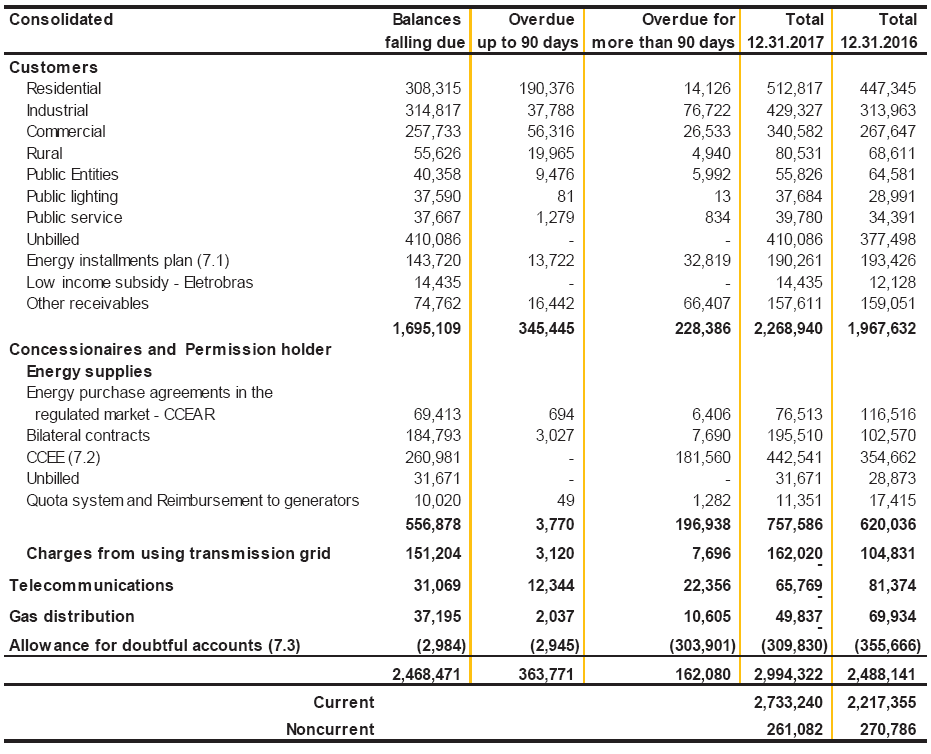
7.1 Energy installments plan
The trade accounts receivable renegotiated are discounted to present value, at December 31, 2017, taking into consideration the future value, the maturity dates, the dates of settlement and the discount rate ranging from 0.09% to 3.39% p.m.
7.2 Electricity Trading Chamber - CCEE
Of the balance presented, the main amount of R$230,902 is related to Copel GeT and R$142,872 to Copel DIS.
41

Of the balance of Copel GeT, R$49,342 were received up to the date of this publication. The remaining balance of R$181,560 derives from sale of energy to be reprocessed by CCEE for the period from January to May 2015, as a result of the request for exemption from responsibility of complying with trading contracts of Colíder Hydroelectric Power Plant for delivery of energy (Note 19.6), of which the contested portion there is a register of estimated losses for doubtful accounts of R$119,665. On March 14, 2017, ANEEL denied the Company's request for reconsideration of ANEEL Order No. 1,580/2016, which had maintained unaltered the implementation schedules and the energy supply schedules related to the plant. Considering that the plant's start-up schedule was impacted by acts of public authorities and unforeseeable or force majeure events occurred during the implementation of the project, the Company referred the matter to the court, succeeding in the total deferral of the request for the prepayment of guardianship in the ordinary share, with the preliminary effect in the reprocessing of the liquidation by the CCEE disclosed at the beginning of May 2018, referring to the jurisdiction in March 2018.
The balance of Copel DIS was fully received.
7.3 Allowance for doubtful accounts
Estimated losses on doubtful accounts - PECLD are recognized in an amount considered sufficient by management to cover losses on accounts receivable from consumers and receivables, the recovery of which is considered improbable.
The consumers’ PECLD is set up in view of the parameters recommended by ANEEL, based on the expected receivables from major debtors, on the analysis of large debts under examinership/bankruptcy, on receivables from household consumers overdue for more than 90 days, from business consumers overdue for more than 180 days, and from industrial, rural, public power, public lighting and public service consumers overdue for more than 360 days, in addition to the experience regarding the history of actual losses.

42

8 CRC Transferred to the State Government of Paraná
By means of a fourth amendment dated January 21, 2005, the Company renegotiated with the State of Paraná the outstanding CRC (Account for Compensation of Income and Losses) balance as of December 31, 2004, in the amount of R$1,197,404, to be paid in 244 installments under the Price amortization system, adjusted according to the IGP-DI inflation index plus interest of 6.65% p.a., which are received monthly, with the first installment due on January 30, 2005 and the others due in subsequent and consecutive months.
The Paraná State Government requested the Novation of the Adjustment Term of CRC, which was approved by the Company’s Board of Directors on June 16, 2016, subject to the consent of the Ministry of Finance. The novation comprises: (i) no principal and interest payments in the period from April to December 2016, and (ii) no payment of principal and monthly payment of interest from January to December 2017. The other clauses were maintained, including the maintenance of the current indexes of correction and interest, thus not affecting the global net present value of referred agreement.
The Company’s management and the State of Paraná formalized on October 31, 2017 the fifth amendment.
The State of Paraná complied with the agreed terms and made monthly interest payments until December 2017. With the end of the grace period, in January 2018 there are remaining 88 monthly installments, which are being paid strictly under contracted conditions.
8.1 Changes in CRC

8.2 Maturity of noncurrent installments

9 Net Sectorial Financial Assets and Liabilities
Net Sectorial Financial Assets and Liabilities refer to the Variance of Parcel “A” Costs (CVA) and other financial components relating to non-manageable costs incurred in the tariff cycle without adequate tariff coverage.
43

The CVA, comprised of the costs of power purchase, transmission costs and sector charges, and financial items, which correspond to overcontracting of energy, neutrality of charges, and other rights and obligations included in the tariff, are transferred entirely to the electricity tariff or covered in the manner defined by the Granting Authority, not affecting the distributor's annual result.
The asset or liability balances represent the positive and negative variances between the amounts projected in the tariff and actual amounts, adjusted using a monetary adjustment index. Annually, in the tariff adjustment/ review processes, they are ratified by ANEEL and transferred as components of the power tariff. Monthly, the amounts approved in previous tariff adjustment / review processes are amortized.
The balance as of 12.31.2017 is composed of the previous cycle (2017 tariff adjustment), under amortization, which represents the balance approved by ANEEL already contemplated in the tariff and by the cycle under constitution (2018 tariff adjustment and 2021 periodic tariff review), whose values will be ratified by ANEEL in the next tariff events.
9.1 Composition of net sectorial financial assets and liabilities balances per tariff cycle

44

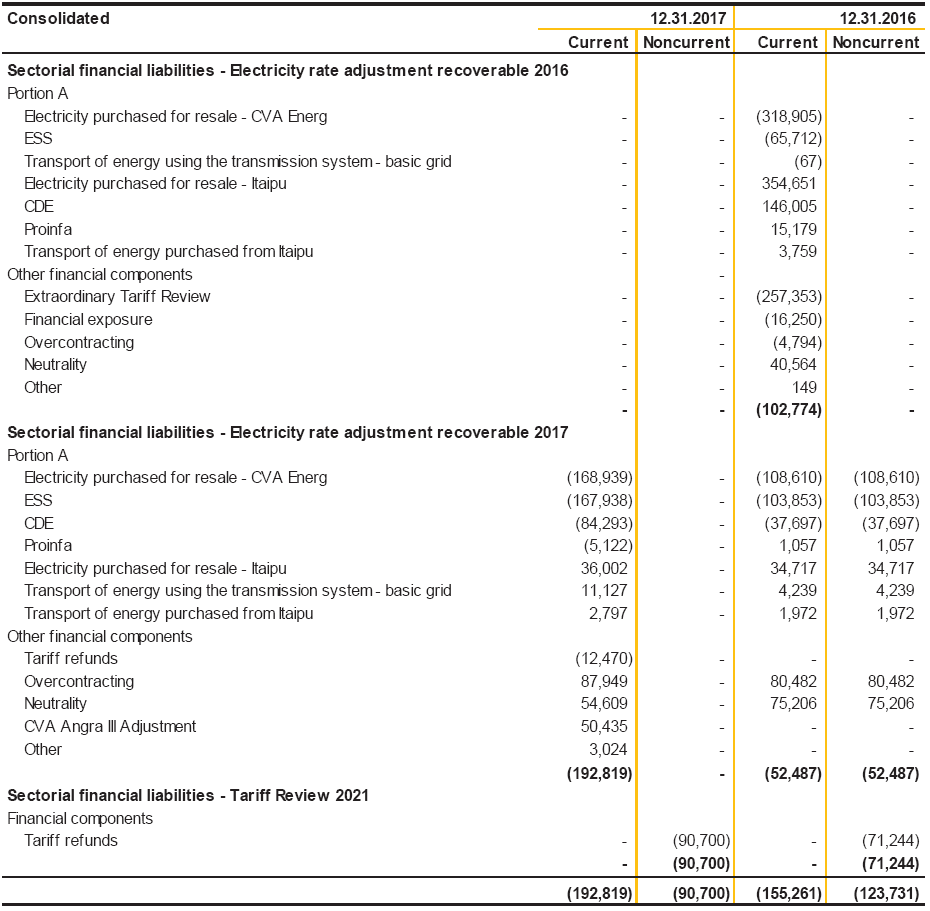
45

9.2 Changes in net sectorial financial assets and liabilities

9.2.1 Electricity purchased for resale - Itaipu
Power output from the Itaipu hydropower station is sold as quotas to utilities companies in the South, Southeast and Midwest in proportion to their markets. The amount constituted in 2017 refers to the change in the power purchase cost and foreign exchange variance, in relation to that predicted in the last tariff adjustment.
46

9.2.2 Electricity purchased for resale - CVA Energ
The balance reflects the difference between the average price of payment, related to the effects of contracting for availability (ECD), Angra and Cotas, and the average price of tariff coverage.
The CVA Energ account was offset by funds received from the Rate Tier Pooling Account (CCRBT) or Tariff Flags Account.
On January 26, 2016, ANEEL approved Normative Resolution No. 700/2016, which deals with the methodology for cases of positive balances of the Tariff Flags Account, which provides that the surplus of flags is allocated in the distributor, to be passed on to customers in the subsequent tariff processes, and may be offset in future calculations of the Tariff Flags Account, until the next tariff adjustment.
9.2.3 System Service Charges - ESS
Consist in the costs associated to thermal power dispatching for the maintenance of the system reliability and stability and whose pricing was not considered in the calculation of the PLD. This amount is paid by all agents with consumption measurement registered on the CCEE, in the proportion of the consumption subject to payment of this charge.
These charges include the refund to generation agents of the operation restriction costs, provision of ancillary services, and for reasons of energy security.
9.2.4 Energy Development Account - CDE
The balance of CDE in 2017 is the result of the lower amount of monthly payment quotas, except in this case the CDE discounts resulting from preliminary injunctions, ratified by ANEEL (Note 32.5.1), in relation to the regulatory quota in the electricity tariff.
9.2.5 Neutrality
Refers to the estimated recoverable portion of sector charges not covered by the current tariff (billed revenue) due to the decline in consumption during the period. Neutrality is assured for charges, energy, transport, financial components and unrecoverable revenues.
9.2.6 Hydrological risk
In the tariff adjustment of Copel DIS the coverage of the hydrological risks associated with plants committed to Contract of Quotas of Assured Power - CCGF for the Itaipu plant and hydropower plants whose energy was contracted within the Regulated Contracting Environment - ACR and that signed the Risk Renegotiation Term in conformity with Law 13,203/2015.
The estimated hydrological risk defined in the tariff review will be reversed in the subsequent tariff review, adjusted at the Selic rate.
47

9.2.7 Tariff refunds
ANEEL, by means of Order No. 245 of January 28, 2016, in line with the Tariff Regulation Procedures - Proret, sub-module 2.1 - General Procedures, determined that the new amounts resulting from excess demand and surplus of reagents previously recorded as special obligations should be accounted for as of January 1, 2016 as sector financial liabilities, net of taxes levied, of the regulatory percentage of 3.5% of revenue, referring to the excess demand in the transmission grid, and of the unrecoverable revenues, applying the regulatory percentage associated with the industrial consumption class.
9.2.8 Overcontracting
Corresponds to the cost of acquisition of the amount of energy overcontracting in relation to the annual supply charge, as well as the energy cost related to spot market exposure. The balance results from the sale of energy surpluses on the spot market at a price (PLD) higher than the mix of coverage.
10 Accounts Receivable Related to the Concession

10.1 Distribution concession agreement

On December 9, 2015, the Company signed the Fifth Amendment to Concession Agreement No. 46/1999, extending the concession period to July 7, 2045, in accordance with the Decision of the Ministry of Mines and Energy of November 9, 2015, based on Law No. 12,783/2013, Decree No. 7,805/2012 and Decree No. 8,461/2015.
48

Accounts Receivable Related to the Concession are measured at fair value and their collection is assured by the Granting Authority through an indemnity upon the reversal of these assets at the end of the concession period.
As a result of the positive result of the tariff review, the amount of R$104,239 was recognized in 2016, and in 2017 the amount of R$785 (complementarily to the report of the 4th Cycle) which, in addition to the application of the IPCA on the armored base, starting 2016 allowed the recognition of fair value of R$131,738 in 2016 and R$16,199 in 2017.
10.2 Bonus from the grant of concession agreements under the quota system

On January 5, 2016, Copel GeT entered into a 30-year concession agreement of HPP GPS, in accordance with Law No. 12,783/2013, with payment of the Bonus from the Grant - BO to the Granting Authority, amounting to R$574,827, as per ANEEL Invitation to Bid 12/2015.
The electric energy in 2016 was fully sold to the Regulated Contracting Environment - ACR under the Assured Power Quota System - CGF or “quota regime” and, as from 2017 to the end of the concession, in the proportion of 70% of the power on the ACR and 30% on the free environment - ACL.
The amount of the bonus for the grant was recognized as a financial asset due to the Copel GeT’s unconditional right to receive the amount paid with inflation adjustment based on IPCA and interest during the concession period.
10.3 Transmission concession agreement
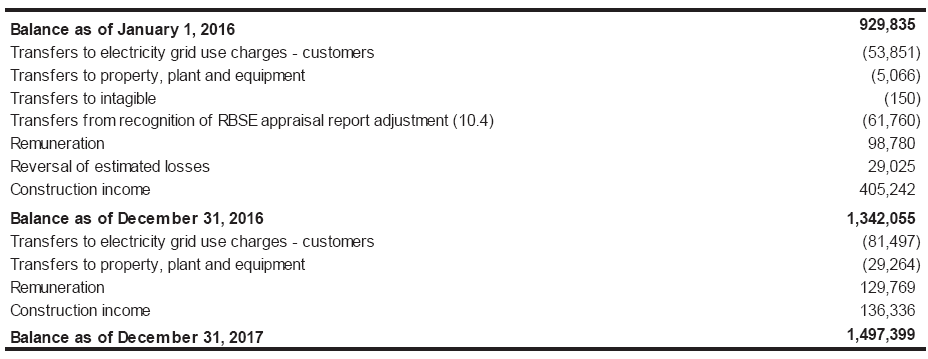
49

10.4 Remeasurement of RBSE assets

Copel GeT extended the concession agreement 060/2001, pursuant to Law No. 12,783/2013, and recognized receivables related to the electricity transmission assets of the Existing Basic Network System (RBSE) and the connecting facilities and Other Transmission Facilities (RPC) existing in May 2000 and not yet depreciated or amortized.
On April 20, 2016, MME Ordinance No. 120 was published, determining that the amounts of assets not yet depreciated and/or amortized, shall comprise the Regulatory Remuneration Base (BRR) for electricity transmission concessionaires as of the 2017 tariff review process, in order to define the Annual Permitted Revenue (APR). The Ordinance addressed issues related to updating, remunerating and period for receiving the amounts, which are regulated by ANEEL Normative Resolution No. 762/2017, by means of Public Hearing 068/2016.
On April 12, 2017, ANEEL issued Technical Note No. 61/2017 - SFF, which concluded the audit of the assets appraisal report and recognized the amount of R$667,637 as the net value of the assets at December 31, 2012. ANEEL’s board approved the inspection results on May 9, 2017, with a disallowance of R$214,663 in relation to the amount originally requested of R$882,300, the main disallowance is related to assets of Substation SF6 of Salto Caxias.
Moreover, on June 27, 2017 ANEEL published Resolution No. 2,258 establishing the Annual Permitted Revenue (RAP), for the 2017/2018 tariff cycle, considering a court decision on the injunction of April 11, 2017 related to a lawsuit filed by three business associations, which determines the deduction of the “compensation”, provided for in article 15, paragraph 2 of Law 12,783/2013.
The compensation being challenged in court, related to the cost of equity calculated for the RBSE assets from January 2013 to June 2017 temporarily reduced the RAP of this cycle from R$132,993 to R$121,267, and the amount deducted from the RAP by ANEEL in the eight tariff cycles is R$201,795.
Based on the opinion of its legal counsel, Copel GeT understands that this is a provisional decision and is not against Copel GeT’s right to receive the amounts related to RSBE assets, which are guaranteed by Law. Therefore, the receivables related to the compensation by the cost of equity considered in the receipt flow of this asset are recorded in noncurrent assets.
50

The remeasurement of RBSE asset base at December 31, 2017 totals R$1,418,370, already considering the amortization for the RAP received, and the changes in the periods were recognized in operating income.
10.5 Concession agreement - gas distribution

11 Accounts Receivable Related to Concession Compensation
The balance refers to generation assets and as a result of the expiry of the Rio dos Patos SPP, GPS and Mourão I HPP concessions. Copel GeT depreciated the plants up to the expiry dates of the concessions, and the remaining balance was reclassified to Accounts Receivable Related to Concession Compensation. Although the Granting Authority has not yet disclosed the means of remunerating these assets and there are uncertainties as to the approval of the investments made, Management believes that compensation for these assets indicates the recoverability of the recorded balance, based on the compensation methodology determined by ANEEL.
The variation in the remeasurement of the cash flow from these assets has a corresponding entry in other operating income, and was reflected in the income for 2017 in the amount of R$341 (R$8,137 in 2016).
Copel GeT submitted to ANEEL, in a timely manner, its interest in receiving the indemnifiable amount. Proof of the investments made was formalized with the regulatory agency on December 17, 2015. The new replacement value methodology was used to prepare the information, as defined in ANEEL Normative Resolution No. 596/2013.
11.1 Changes in accounts receivable related to concession compensation

51

12 Other Receivables
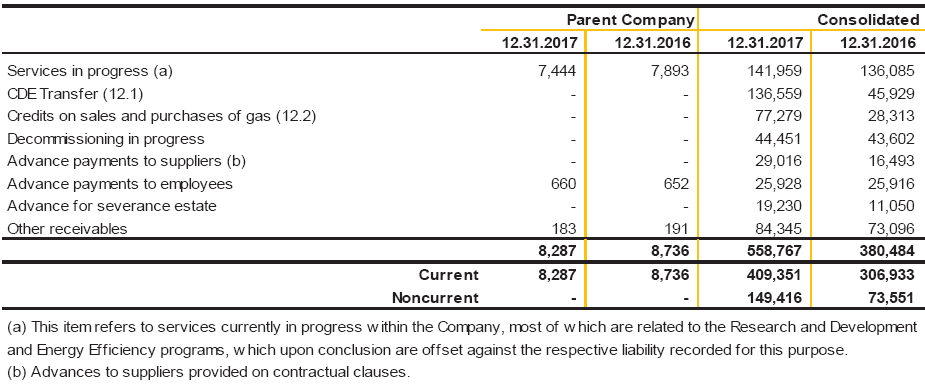
12.1 CDE Transfer
One of the main purpose of the CDE is to provide funds to subsidize discounts applied to tariffs for use of power distribution systems (Note 32.5.1).
The amount transferred to Copel DIS related to discounts on tariffs applicable to users of the public service of electricity distribution between June 2016 and May 2017, ratified by ANEEL Resolution 2,096/2016, was R$25,505 per month. This amount was changed to R$49,304 per month by Resolution 2,255 of June 20, 2017, which ratified the result of Copel DIS’s Annual Tariff Adjustment in 2017, for the period from June 2017 to May 2018.
12.2 Credits on sales and purchases of gas - Compagás
This balance refers to the gas acquisition contract with Petrobras, relating to the acquisition of contracted and guaranteed volumes, higher than those actually withdrawn and used, and contains a future compensation clause. Compagás has the right to withdraw the gas in subsequent months, and can compensate the volume contracted and not consumed. According to the contractual provisions and consumption perspectives, derived from the review of the projects and scenarios for the next years, Compagás estimates to fully offset the amounts paid in the course of its operation. Should the concession be early terminated for any reason, the agreement with Petrobras sets forth the right for sale of this asset. The expiry date of the concession is in discussion with the Concession Grantor, as described in Note 2.1.1.
In 2017, based on the new conditions for delivery and perspectives of consumption by the market, the Company reversed the accrued impairment in full for R$123,586 (Note 33.4).
52

13 Taxes
13.1 Income tax and social contribution
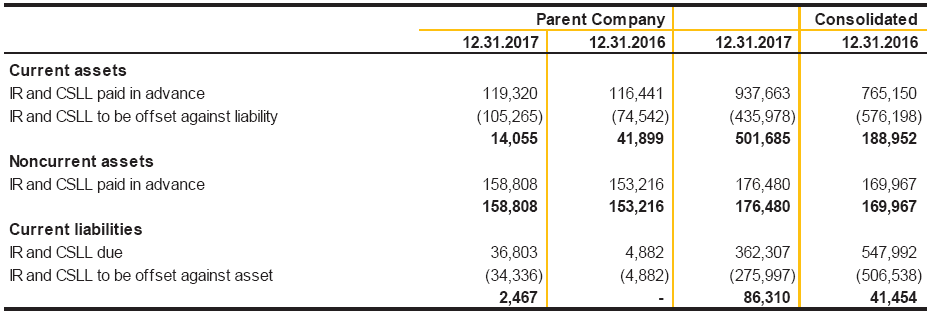
The taxation on profit comprises the income tax and social contribution calculated based on the taxable profits (adjusted profit) of each taxable entity at the applicable rates according to prevailing legislation, 15%, plus 10% on the amount exceeding R$240 per year, for income tax and 9% for social contribution.
Income tax and social contribution losses can be offset against future taxable profits, considering the limit of 30% of the taxable profit for the period, and can be carried forward indefinitely.
13.2 Deferred income tax and social contribution
The Company, based on its profitability history and the expectation of generating future taxable profits, based on its internal projections prepared for reasonable periods of time for its business, sets up a deferred tax asset on temporary differences between the tax bases.
The deferred income tax and social contribution are recognized on temporary differences between the carrying amounts of assets and liabilities in the financial statements and the corresponding tax bases used for tax calculation purposes to the extent that it is probable that there will be sufficient taxable profits against which the temporary differences can be utilized and the tax losses can be offset.
Deferred tax assets and liabilities may be netted if there is a legal right to offset the current tax assets and liabilities and they relate to the same taxing authority.
53

13.2.1 Changes in deferred income tax and social contribution
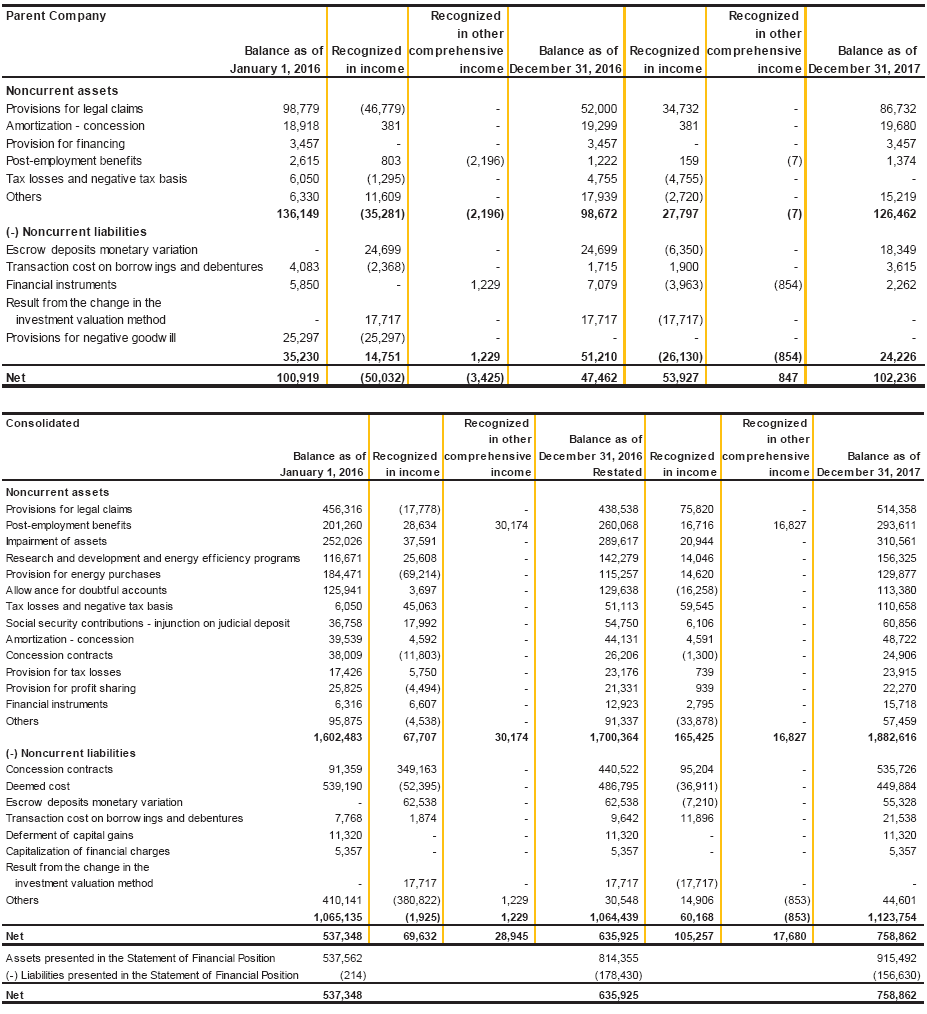
13.2.2 Realization of deferred tax assets
The realization of deferred taxes will occur according to the tax realization of the tax base. The criteria designed for realization of the main items are:
54

-Amounts set up on post-employment benefits, calculated based on the actuarial provision determined according to an actuarial valuation prepared annually by an independent actuary, will be realized according to the expenses incurred;
-Amounts set up on the provisions for litigation will be realized according to court decisions;
-Amounts set up on the provision for impairment of assets will be realized through the amortization and / or depreciation of the impaired asset;
-Amounts set up on the provision for purchase of energy will be realized in the immediately following period by the recording of the tax document of the purchase;
-Amounts set up on the provisions for R&D and PEE will be realized through the expenses incurred in the projects carried out;
-The other amounts set up will be realized according to the tax realization of each of the tax bases.
On April 12, 2018, the Company’s Supervisory Board examined and the Board of Directors approved the technical study which points out to the realization of deferred taxes:
The projected realization of the deferred tax credits is shown below:

13.2.3 Unrecognized tax credits
As of December 31, 2017, UEG Araucária did not recognize income tax and social contribution credits on tax loss carryforwards and negative bases in the amount of R$23,592 because there is at present no reasonable assurance of generation of future taxable profits sufficient to absorb these assets.
55

13.3 Other taxes recoverable and other tax obligations

Sales and services revenues are subject to value-added tax (Imposto sobre Circulação de Mercadorias e Serviços or ICMS, in Portuguese) and service tax (Imposto sobre Serviços or ISS, in Portuguese), at the applicable rates, and to the PIS (Social Integration Program) and COFINS (Contribution for Social Security Funding).
Credits resulting from non-cumulative PIS and COFINS charges are accounted for deducting the operating costs in the statement of income.
Credits arising from non-cumulative ICMS, PIS and COFINS related to the purchase of assets are presented deducting the acquisition cost of these assets.
Prepayments or amounts that can be offset are presented in current and noncurrent assets, according to their expected realization.
13.3.1 Special Tax Regularization Program - Pert
Of the total R$533,671 recognized, R$532,644 are related to the balance of Copel DIS.
56

In June 2016, the Brazilian Federal Revenue Office - RFB issued an understanding through Private Letter Ruling Cosit No. 101/2016, providing guidance that the CVA, currently classified as Sectorial Financial Assets and Liabilities, should be realized when it was recorded (accrual basis) and not through transfer to tariffs (billing basis). According to the RFB, this understanding is based on the signing of the amendment to the concession agreement in December 2014, which currently assures that any residual balance of Sectorial Financial Assets and Liabilities will be indemnified at the end of the concession.
In this context, due to the RFB’s position, which produces effects since December 2014, the Company, which taxed the CVA operations on a billing basis, assessed the benefits offered by the Special Tax Regularization Program - Pert, established by Provisional Measure - MP No., 783/2017 and regulated by Normative Instruction - IN No. 1711/2017, as well as the effect on its financial results and cash flow, decided to join the program in August 2017, thus changing the taxation regime from CVA to accrual basis.
Based on this decision, Copel DIS rectified all accessory obligations from December 2014 to July 2017.
In October 2017, Law 13,496/2017 was enacted as a result of Provisional Measure 783/2017 passed into law, which modified penalty from 40% to 50% and maintained interest rate cut at 80%.
The underpayments made in the period from December 2014 to March 2017 were included in the Pert, with a declaration to the RFB of a debit of R$557,365 (principal amount), relating to PIS, Cofins, IRPJ and CSLL. Considering the benefits of reduction of fine and interest applied on the remaining balance, after payment of 20% of the value of the consolidated debt, total amount adjusted for inflation through August 2017, program joining date, was R$685,904.

The payment of the taxes included in the Pert is made as follows:
· Cash payment of 20% of the debit (without the reductions provided for in the Pert), in 5 installments of R$33,604, payable from August 2017. From September 2017, this amount started to be adjusted for inflation at the Selic rate.
· Beginning in January 2018, the payment of the debt balance starts, in 145 installments of R$3,572. The amount of the instalment will be adjusted for inflation at the Selic rate.
Thus, the benefits earned by the Company for joining the program totaled R$154,197 relating to reduction of fine and interest.
57

Regarding overpayments made in the period from December 2014 to July 2017, considering the change of the taxation regime from CVA to the accrual basis, pursuant to Private Letter Ruling Cosit No. 101/2016, Copel DIS declared to RFB credits relating to PIS, Cofins, IRPJ and CSLL, as shown in the table below:

The amounts of these credits has been used for offsets of federal taxes and their balance will be adjusted for inflation monthly by the Selic rate.
13.4 Reconciliation of provision for income tax (IRPJ) and social contribution (CSLL)
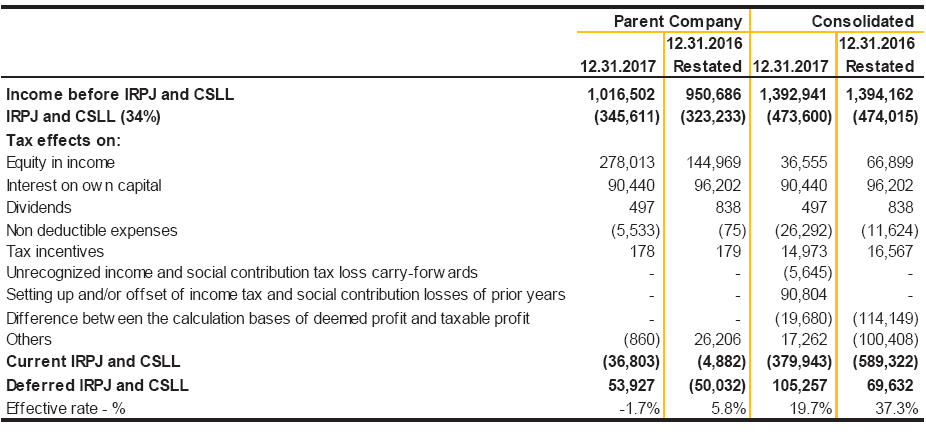
14 Prepaid Expenses

58

14.1 GSF (Generation Scaling Factor) renegotiation
During 2015, hydropower generation utilities were strongly impacted by the power generation below their physical guarantee due to the low level of the reservoirs affected by the rainfall shortage of the last years, and resulting in the need for liquidation with the CCEE, at the price of the PLD, of the deficit between the generated power and the sold power.
Hydropower generation utilities significantly affected by the low reservoir levels in recent years were benefited by the enactment of Law No. 13,203 by the Concession Authority on 12.08.2015, which allows hydropower generation companies subscribing to the Electricity Reallocation Mechanism (MRE) to reallocate their hydrological risk as from January 1, 2015.
ANEEL Regulatory Resolution No. 684 of 12.11.2015 establishes the criteria and other conditions for reallocation of hydrological risk by MRE members. In the Regulated Contracting Environment (ACR), hydrological risk was transferred to consumers against payment by the generation company of a risk premium into the Rate Tier Pooling Account (CCRBT). In the Free Contracting Environment (ACL), hydrological risk was reallocated through Reserve Capacity contracts.
On December 23, 2015, following analysis of reallocation conditions in the ACR and ACL, Copel GeT and Elejor filed a request for renegotiation of hydrological risk in ACR of HPPs Mauá, Foz do Areia, Santa Clara and Fundão, which was consented through Decisions No. 84/2016 and 43/2016.
In accordance with Hydrological Risk Renegotiation Term and previously mentioned regulations, the companies acquired the right to partially recover cost with GSF in 2015, in the amount of R$33.55 per average MW for SP100 product class, based on the risk premium contracted by them.
The amounts originally recognized on the renegotiation of the hydrological risk were as follows:

A breakdown of these items as at 12.31.2017 is presented below:

59

15 Receivables from Related Parties
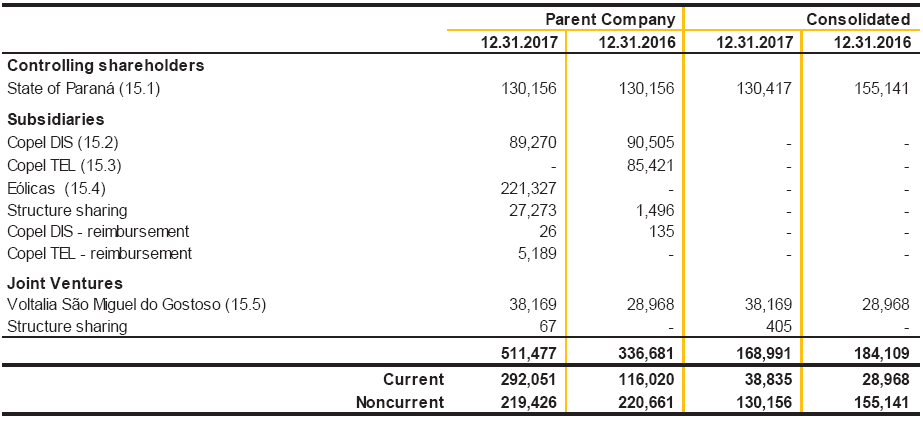
15.1 State of Paraná
15.1.1 Credit related to Luz Fraterna Program, R$115,890 (R$115,890 as of 12.31.2016)
The transfer of the receivables from the Luz Fraterna account (Note 37.a) of Copel DIS to Copel was suspended from the second half of 2015, considering Decree No. 2,789/2015, which created the possibility of using presumed ICMS (VAT tax) credits for the settlement of invoices referring to this program. In addition, State Law No. 18,875, dated 09.27.2016 authorized the State of Paraná to pay in installments the debts due and unpaid to Copel relating to services rendered up to the date of publication of said Law.
On March 23, 2018, the State of Paraná settled the balance of R$115,890.
15.1.2 Credit referring to 2014 World Cup construction work, R$14,266 (R$14,266 as of 12.31.2016)
Copel’s executive board, through the 2,119th Meeting, of July 28, 2014, approved the transfer of credit rights on costs related to mobility projects for FIFA 2014 World Soccer Cup made by Copel DIS and under the responsibility of the Paraná State government.
ANEEL agreed to the transaction through order No. 3,483/2015 and a Credit Assignment Agreement that transfers Copel DIS rights to Copel was executed.
In addition, State Law No. 18,875, dated September 27, 2016, authorized the State of Paraná to pay debts due and unpaid to Copel relating to services rendered up to the date of publication of said Law. Considering this legal provision, Management is in the negotiation phase to define the terms of the settlement of this balance.
60

15.1.3 Credit referring to Programa Morar Bem, R$261 (R$24,985 as of 12.31.2016)
Programa Morar Bem Paraná, established by Decree No. 2,845/2011, is an agreement between Paraná State, Companhia de Habitação do Paraná (Cohapar) and Copel DIS, and is managed by Cohapar. Copel DIS main attributions in this agreement are comprised of the construction of electric power distribution networks and housing project consumer unit service connections.
State Law No. 18,875, dated September 27, 2016, authorized the State of Paraná to pay in installments the debts overdue and not paid to Copel DIS relating to services rendered up to the date of publication of said Law. Considering this legal provision, the State of Paraná settled the debt on 12/18/2017. Continuing the provision of services, the balance changed to R$261, fully received in March 2018.
15.2 Copel DIS - Financing transferred - STN
The Company transferred loans and financing to its wholly-owned subsidiaries at the time of constitution in 2001. However, since the contracts for the transfers to the subsidiaries were not formalized with the financial institutions, they remain recognized in the Parent Company.
The balance with Copel DIS refers to STN financing transferred with the same levy of charges borne by the Company and shown as obligations for loans and financing at Copel DIS (Note 23).
15.3 Copel TEL - Loan
A loan agreement was signed on June 12, 2015 between Copel (lender) and Copel TEL (borrower), for the purpose of raising funds to comply with the borrower’s investment program. Initially a limit of R$20,000 was established, plus IOF and interest of 111.5% of the CDI rate, changed to R$60,000 and R$120,000 pursuant to the first and second amendments to the agreement signed on October 14, 2016 and December 15, 2016, effective until December 29, 2017. The loan was settled on August 9, 2017 and finance income of R$6,667 was recognized in 2017 (R$1,539 in 2016).
15.4 Wind farms - Loans
Loan agreements were signed on August 21, 2017 between Copel (lender) and the wind farms, as shown below:
61

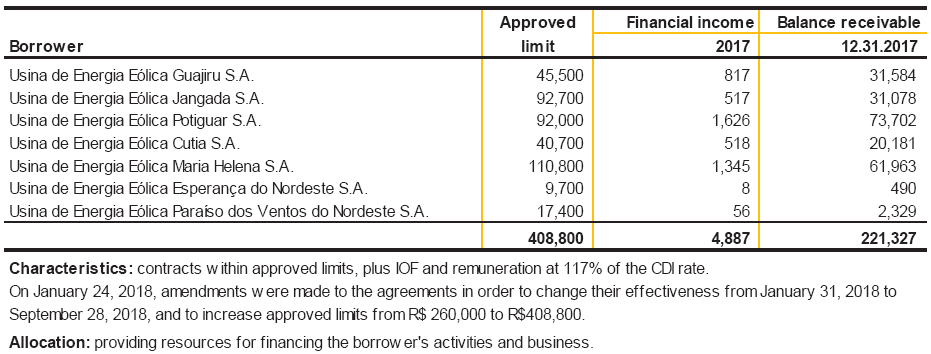
15.5 Voltalia São Miguel do Gostoso Participações S.A. - Loan
On May 14, 2015, a loan agreement was signed between Copel (lender) and Voltalia São Miguel do Gostoso Participações S.A. (borrower), with retroactive effects as from February 6, 2015, aiming at providing working capital for financing the borrower’s activities and business. The limit of R$29,400 was established, plus IOF and interest of 111.5% of the CDI. The initial term of two years was changed to February 6, 2018, the date on which the contract was settled. Of the limit approved, the borrower used R$27,950 and recognized finance income of R$3,513 in 2017 (R$3,509 in 2016).
16 Other Temporary Investments

16.1 Joining the Sanepar’s Units Program and public offering of Units
On November 17, 2017, Copel requested the conversion of shares and for joining Sanepar’s Units Program, which occurred on November 21, 2017. The units held by Copel and Copel Energia are composed by one common share and four preferred shares issued by Sanepar.
Copel, holder of 36,343,267 preferred shares issued by Sanepar, requested the conversion of 7,268,655 into common shares and the formation of 7,268,653 Units. Copel Energia, in turn, holder of 7,956,306 common shares issued by Sanepar acquired on March 13, 2017 (Note 18.5), requested the conversion of 6,365,044 into preferred shares and the formation of 1,591,261 Units.
On December 21, 2017, the bookbuilding of the secondary public offering with restricted placement efforts of Units issued by Sanepar was concluded, setting the price to R$55.20 per Unit. Copel and Copel Energia participated as sellers and sold all their Units, consequently receiving cash proceeds of R$484,608.
62

The settlement of the Restrictive Public Offering occurred on December 18, 2017. The gain from this transaction totaled R$28,650 (Note 33.6).
17 Judicial Deposits
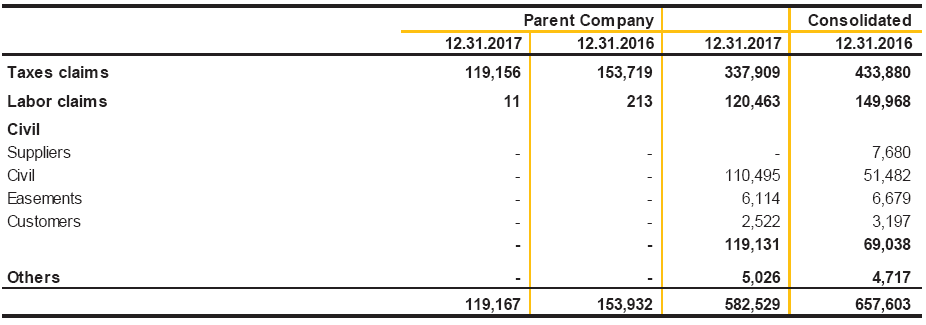
18 Investments
18.1 Changes in investments
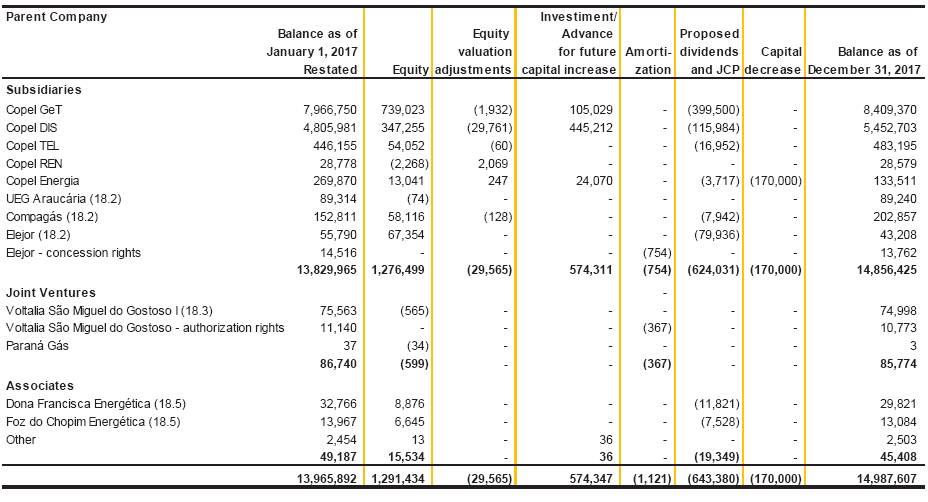
63


64

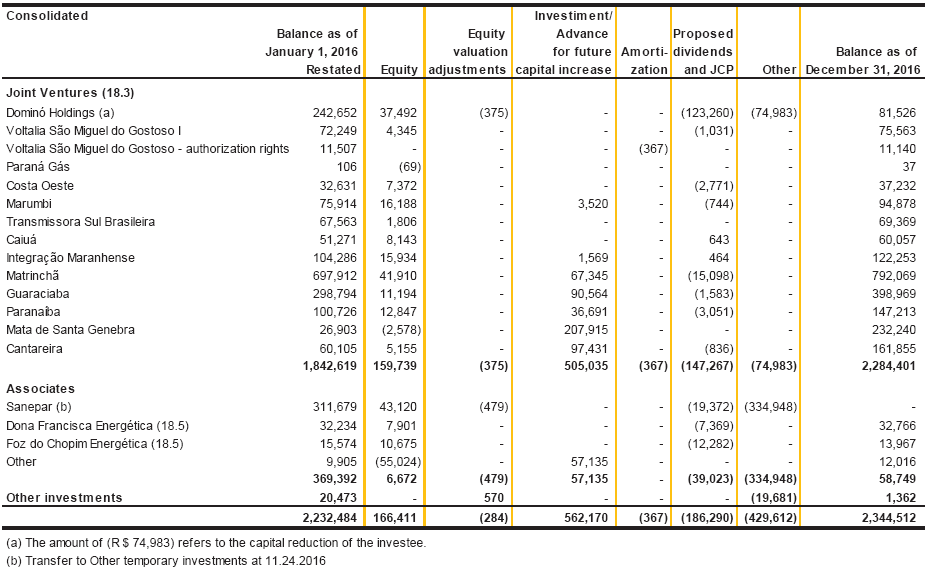
65

18.2 Subsidiaries with non-controlling interest
18.2.1 Summarized financial information
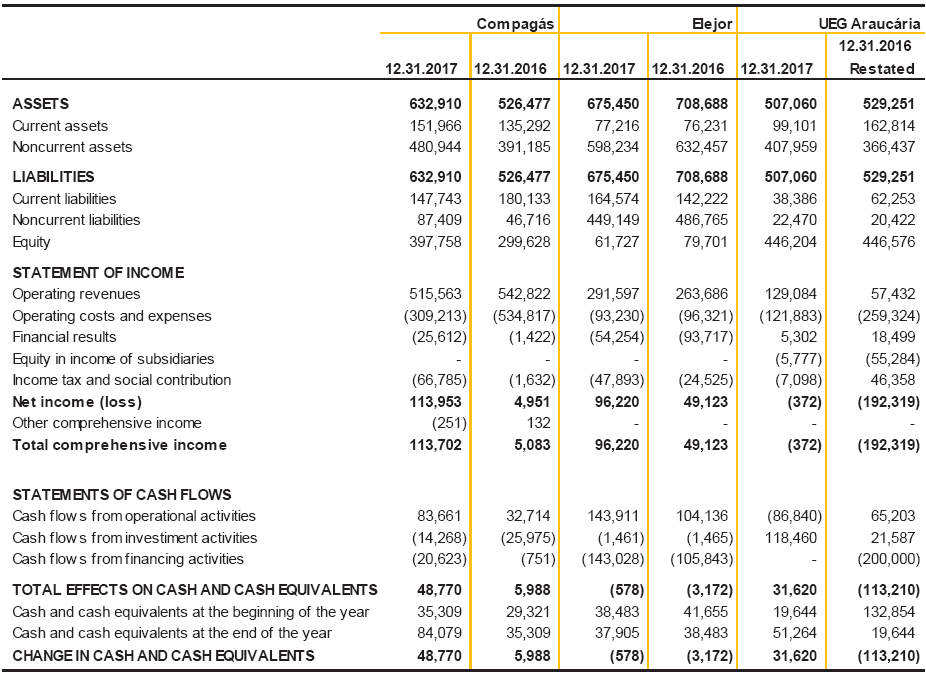
18.2.2 Changes in equity attributable to non-controlling shareholders
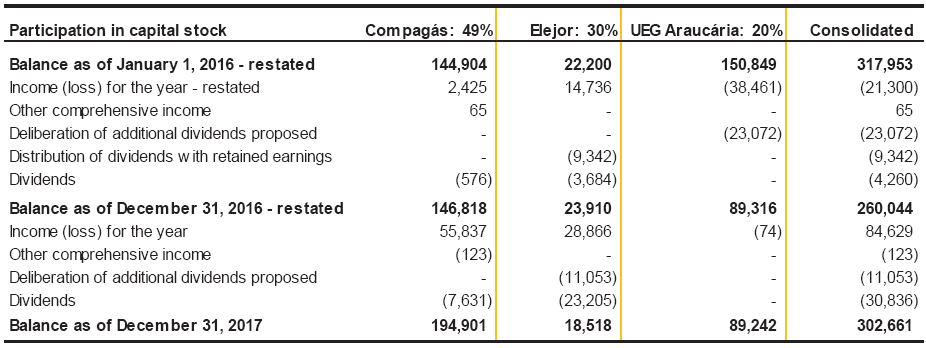
66

18.3 Total balances of the groups of assets, liabilities, net income and share in commitments and contingent liabilities of the main joint ventures
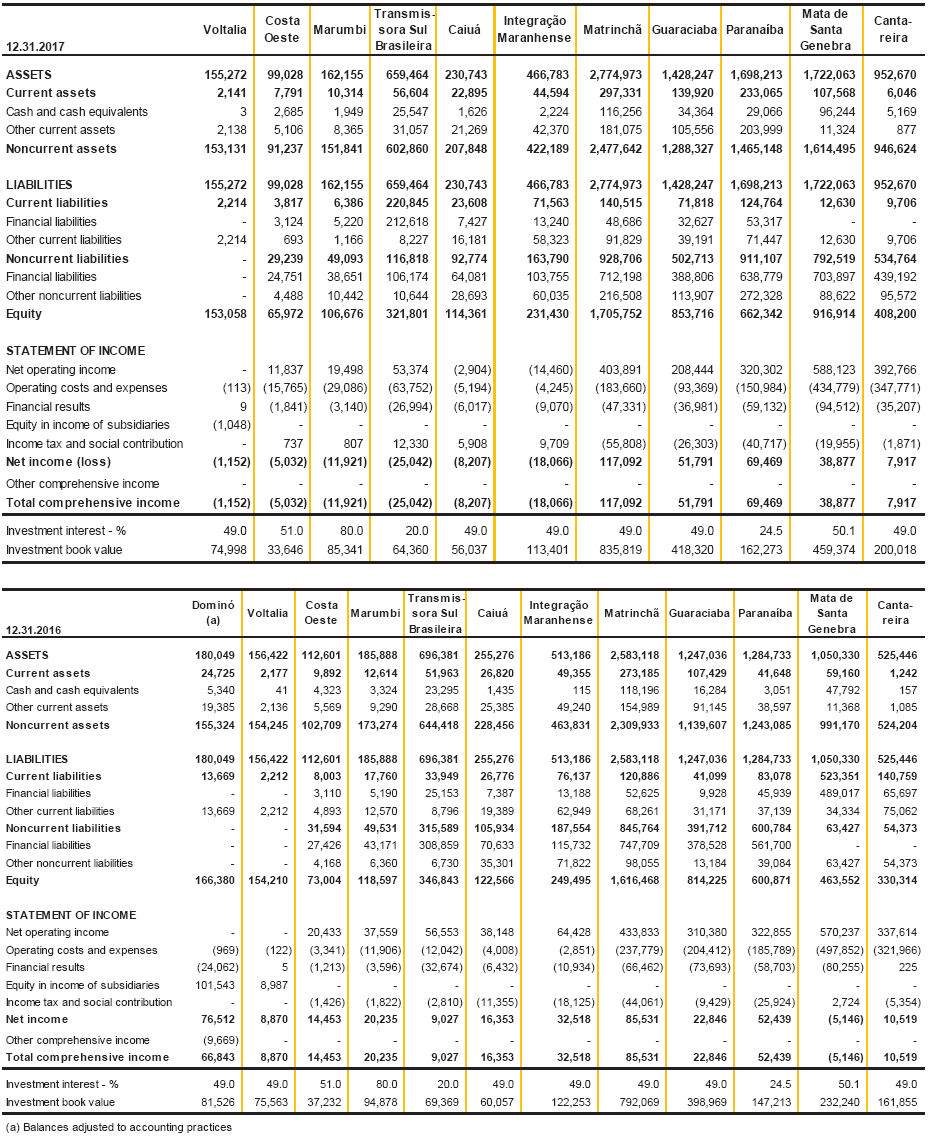
67

As at December 31, 2017, Copel's interest in the commitments assumed from its joint ventures is equivalent to R$141,744 (R$503,546 as at December 31, 2016) and in contingent liabilities is equivalent to R$38,218 (R$834 as at December 31, 2016).
18.4 Dominó Holdings S.A.
At the Extraordinary General Meeting held on March 13, 2017, the shareholders approved the capital reduction of Dominó Holding, without cancelation of shares, through the delivery of all common shares issued by Sanepar, owned by Dominó Holdings, in the proportion of its interests. As a consequence, Copel Energia became the direct holder of 7,956,306 common shares of Sanepar, measured at their fair value at R$73,361, determined based on the discounted cash flow method. These shares were settled on December 18, 2017, as per Note 16.1.
18.5 Total balances of the groups of assets, liabilities, net income and share in contingent liabilities of the main associates
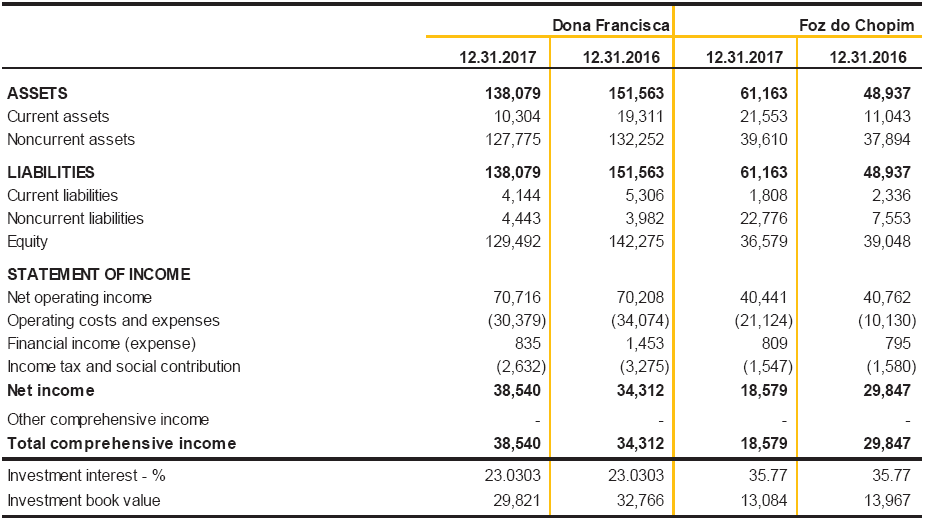
As at December 31, 2017, Copel's interest in the contingent liabilities of its associates is equivalent to R$58,194 (R$55,565 as at December 31, 2016).
19 Property, plant and equipment
The Company and its subsidiaries record assets used in administrative and commercial facilities for generation of electric power and telecommunication services in property, plant and equipment. Investments in electric power transmission and distribution and in piped gas distribution are recorded in financial assets and/or intangible assets as per CPC 04 / IAS 38, ICPC 01 and OCPC 05 / IFRIC 12 (Notes 4.3.9 and 4.6).
68

On initial adoption of IFRS, property, plant and equipment were measured at fair value with recognition of their deemed cost.
Under Articles 63 and 64 of Decree No. 41,019/1957 and Article 19 of Decree No. 2,003/1996, the assets and facilities used mostly in the generation of power are attached to these services and cannot be withdrawn, sold, assigned, or mortgaged without the prior written consent of the regulatory agency. ANEELResolution No. 691/2015, however, regulates the release of assets from the concessions of the Public Electric Power Service, granting prior authorization to release the property and other fixed assets not usable by the concession when they are destined for sale, and also determining that the sales proceeds less respective charges be deposited in a restricted bank account to be invested in the concession.
19.1 Property, plant and equipment by asset class

19.2 Changes in property, plant and equipment

69

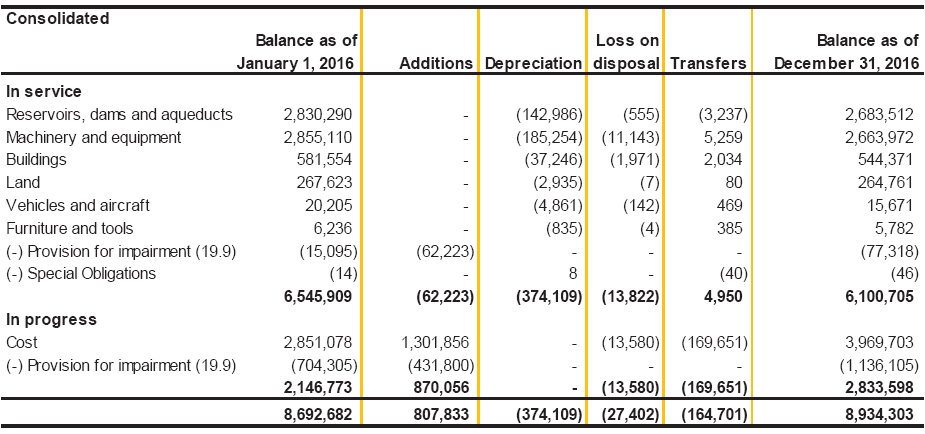
19.3 Effects on property, plant and equipment of the end date and the extension of the electric power generation concessions and the quota regime
Since September 12, 2012, with issuance of Provisional Measure No. 579, enacted into Law No. 12,783/2013, hydroelectric and thermoelectric power generation concessions may be extended, only once, at the discretion of the Granting Authority for a period of up to 30 and 20 years, respectively.
Extension of concessions for hydroelectric power generation is subject to acceptance of certain conditions established by the Granting Authority, such as: (i) change in remuneration to tariff calculated by ANEEL for each plant; (ii) allocation of the plant’s physical power and capacity guarantee shares to concessionaires and licensees of distribution utilities; (iii) submission to service quality standards determined by ANEEL; and (iv) agreement with amounts established as indemnity of assets related to the concession.
With the expiration of SHP Rio dos Patos, HPP GPS and HPP Mourão concessions, investments subject to indemnity were transferred to account “Accounts receivable related to the concession extension”, considering the right to indemnity (Note 11).
Also in relation to current regulation, the concessionaire must request the extension of the concession in advance of up to 60 months before the term end of hydroelectric power generation plants, and of up to 24 months for thermoelectric plants.
Current regulatory framework also determines that, if the concessionaire opts to extend the concession, the Granting Authority may advance the effects of the extension by up to 60 months from the final agreement term or the concession term, defining the initial tariff.
If the concession period is not extended, the Concession Grantor will open an auction or bid for a concession period of up to 30 years, considering as bid winner, the lowest tariff value and the highest offer to pay onerous grant.
70

Both in cases of early extension as new bid for a new concession term, Management understands it has an assured contractual right to receive an indemnity of the assets related to the public service concessions, based on the new replacement value (VNR), that will consider accumulated depreciation and amortization as of the date of initial operation of the facility.
Decree 9,271, published on January 25, 2018, allows the Federal Government to grant a new concession agreement for an additional 30-years period to the company winning the bid for privatization of electric power public service concession. For this purpose, the project should be privatized at least 60 months before the end of the concession. In addition, the project will have its regime changed from economic operation to Independent Power Generation and will have an amount payable for the Grant Bonus.
19.4 Average depreciation rates
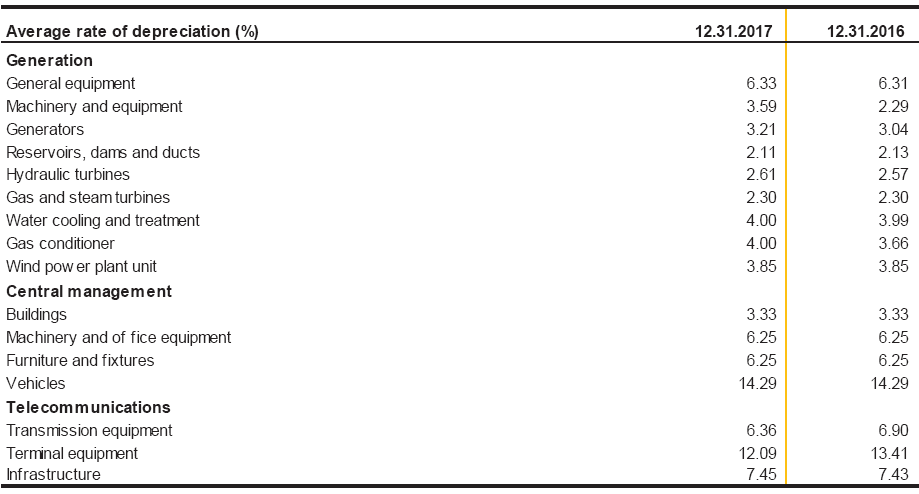
Depreciation of the assets which are part of the original project of Mauá, Colíder, Cavernoso II, Santa Clara and Fundão HPPs
Copel GeT has assets from the original project of Mauá, Colíder and Cavernoso II Hydroelectric Power Plants, and Elejor of Santa Clara and Fundão Hydroelectric Power Plant, for which the Company does not expect to receive full guarantee from the Granting Authority that it will indemnify the Company by the end of the concession period for the residual value of the assets which are part of the original project. This interpretation is based on Law No. 8,987/95 and Decree No. 2,003/96, which regulates the production of electricity by independent producers.
Accordingly, from the date these assets start operations they are depreciated at the rates set by ANEEL (Brazilian Electricity Regulatory Agency), limited to the concession period.
As established on concession agreements, subsequent investments not forecast in the original project, provided that they are approved by the Granting Authority and have not yet been amortized, will be indemnified by the end of concessions. Therefore, these assets will be depreciated at the rates set byANEEL, from the operating start.
71

19.5 Costs of loans, financing and debentures capitalized
The costs of loans, financing and debentures capitalized during 2017 amounted to R$2,297, at an average rate of 0.09% p.a. (R$7,142, at an average rate of 0.26% p.a., during 2016).
19.6 HPP Colíder
On July 30, 2010, at the ANEEL Auction of Power from New Projects 003/10, Copel GeT won the rights to the concession of the Colíder Hydroelectric Power Plant, valid for 35 years from the date of signature of Concession Agreement No. 001/11-MME-HPP Colíder, which took place on January 17, 2011.
This project will comprise a main powerhouse of 300 MW, which is enough to supply approximately one million people. The facility will take advantage of the hydroelectric potential discovered on the Teles Pires River, between the towns of Nova Canaã do Norte and Itaúba, in the northern region of the State of Mato Grosso.
The National Bank for Economic and Social Development (BNDES) approved the classification of the HPP Colíder project for financial support and the signed financing agreement amounted to R$1,041,155 (Note 23). Until December 31, 2017, the financing amount of R$975,108 was released.
Due to acts of God and force majeure, such as fire at the construction site, and public power acts that created difficulties involving environmental licenses, among other setbacks, such as delays in delivery of equipment, in electromechanical assembly services and in the construction of the transmission line of the power plant, the project timeframe was adversely affected, leading to postponement of the commercial generation of the power plant, whose first generating unit is expected to be operational by June 2018, whilst the third and last one is expected by November 2018. As a result of these events, a balance of estimated losses on impairment of assets is recorded as shown in Note 19.9.
The Colíder Hydroelectric Power Plant’s power output was sold at an ANEEL auction at a final price of R$103.40/MWh, as of July 1, 2010, adjusted according to the variation of IPCA inflation index to R$163.41 as of 12/31/2017. 125 averages MW were sold, for supply starting on January 2015, for 30 years. Copel GeT submitted an application to ANEEL to exclude its responsibility, so that the obligation to supply energy could be postponed. In a first judgment, the request was not accepted, Copel GeT filed an application for reconsideration of the decision, which was also denied on March 14, 2017. Not agreeing with the decision, Copel GeT filed again an application for reconsideration, which was definitely denied on July 4, 2017 Copel GeT filled a lawsuit in the court on December 18, 2017, requesting the reversal of the decision of the Agency, and it was granted, in April 2018, the request for the anticipation of guardianship with the preliminary effect for postponement of the supply of energy sold.
Copel GeT has complied with its commitments of energy supply as follows:
72

· From January 2015 to June 2016 - with energy surpluses not contracted in its other plants;
· From June 2016 to December 2018 - with partial reduction, in June 2016, through a bilateral agreement; and from July 2016 to December 2018, with reduction of all supply contracts of the CCEARs - Energy Trading Agreement in the Regulated Environment, through a bilateral agreement and participation in theNew Energy and Decrease Clearing Facility (“Mecanismo de Compensação de Sobras e Déficits de Energia Nova - MCSD-EN”).
On July 14, 2017, the assured power of the project was revised by MME Ordinance No. 213/SPE, going to 178.1 average MW, after full set-up.
At December 31, 2017, the expenditures incurred on HPP Colíder presented a balance of R$2,197,630.
19.7 Joint operations - consortiums
The amounts recorded under property, plant and equipment referring to the participations of Copel GeT in consortiums are shown below:

19.7.1 Consórcio Empreendedor Baixo Iguaçu - Cebi
The purpose of the consortium is to build and operate the project known as Baixo Iguaçu Hydroelectric Plant, with minimum installed capacity of 350.20 MW and physical guarantee revised to 171.3 MW. The plant is located on the Iguaçu River between the municipalities of Capanema and Capitão Leônidas Marques, and between the Governador José Richa Hydroelectric Plant and the Iguaçu National Park, in the State of Paraná.
The start of commercial operation of the three units is scheduled for the fourth quarter of 2018. The previous schedule has been changed due to the suspension of the Installation License, as per the decision of the Federal Court of the 4th Region (TRF-RS), held on June 16, 2014, that stopped the construction work as of July of that year. In March 2015, a decision authorizing the Company to resume construction work was published. However, Instituto Chico Mendes de Conservação da Biodiversidade - ICMBio imposed additional conditions for granting an environmental license to the Company, which prevented it from resuming construction work. Cebi sent IAP - Environmental Institute of Paraná the information necessary for those conditions to be met and in August 2015 the license was issued. Having obtained the IAP license, and after technical and contractual adjustments required due to the long downtime, the works were resumed on February 2, 2016.
73

On August 23, 2016, the Company signed the 2nd Amendment to the Concession Agreement with the purpose of formalizing the redefinition of the work schedule, acknowledging in favor of Cebi the exclusion of responsibility for the delay in implementing the project for a period of 756 days, which was considered as an extension of the concession period, which originally was until August 19, 2047 and became September 14, 2049. On November 7, 2017, ANEEL acknowledged through the Authorization No. 3,770 an additional period of 46 days for exclusion of responsibility relating to the recurring invasions of the construction site, between May and October 2016.
The constructions and electromechanical assembly of the powerhouse enabled the installation/positioning of important parts of the turbine-generator set, in October and November 2017. The river diversion to enable the last phase of the construction is scheduled to be carried out in May 2018.
19.8 Cutia wind farm project
The largest Copel wind farm called Cutia is under construction, and is divided into two large complexes:
· Cutia Complex: composed of seven wind farms (Guajiru, Jangada, Potiguar, Cutia, Maria Helena, Esperança do Nordeste and Paraíso do Ventos do Nordeste) with 180.6 MW of total installed capacity, 71.4 average MW of assured power, all located in the State of Rio Grande do Norte. The power that will be generated by the farms was sold on the 6th Reserve Auction that was held on October 31, 2014, at an average historical price of R$144.00/MWh, inflation adjusted according to the variation of the IPCA to R$176,64 as of December 31, 2017, and the forecast for commercial generation of these farms is scheduled for July 2018; and
· Bento Miguel Complex: composed of six wind farms (São Bento do Norte I, São Bento do Norte II, São Bento do Norte III, São Miguel I, São Miguel II and São Miguel III) with a total installed capacity of 132.3 MW, 58.1 average MW assured power, all also located in the State of Rio Grande do Norte. The power that will be generated by the farms was sold on the 20th New Energy Auction that was held on November 28, 2014, at an average historical price of R$136.97/MWh, inflation adjusted according to the variation of the IPCA to R$167,16 as of December 31, 2017. The initial forecast for commercial generation of these farms is January 2019.
The following are the relevant milestones for the execution of the works from January 2016 to December 2017. In January 2016, the environmental licenses were obtained, beginning the access road runs, bases and assembly platform of the generator set. In April 2016, construction of the Cutia Substation was started, with installed capacity of three 120 MVA transformers and twenty-six 34.0 kV circuits, two circuits for each wind farm. In October 2016, with the advanced stage of construction services in some farms, the first generator sets began to be delivered, and Torres Productive Center began operating, a structure in which precast elements that will constitute the towers of support of the wind turbines are being produced. In January 2017, the process of assembling the towers of the wind turbines began.
As a result of the review of the recoverable amount of these projects, a balance of estimated losses on impairment of assets is recorded as demonstrated in Note 19.9.
74

19.9 Estimated losses on impairment of generation segment assets
Based on previous indicators of impairment, of assumptions representing the Company management best estimates, of the methodology set forth by Technical Pronouncement CPC 01 (R1) and of measurement of value in use, a number of power plants or cash generating units of the generation segment were tested.
The calculation of the value in use was based on discounted operating cash flows over the time of concessions, maintaining the Company’s current commercial conditions. The rate used to discount the cash flows was set in light of the WACC (Weighted Average Cost of Capital) methodology and CAPM (Capital Asset Pricing Model) methodology for the generation business, considering usual market parameters.
Internal references such as the budget approved by the Company, historical or past data, updating of the timeframe of work and amount of investments for projects in course support the design of key assumptions by Company management. In the same framework, external references such as level of consumption of electric power, expansion of the economic activity in Brasil and the availability of water resources support the key information about estimated cash flows.
Worth noting is that a number of assumptions used by Company management when determining future cash flows can be affected by uncertain events, which, in its turn, may give rise to variation in results. Changes in the political and economic model, for example, may lead to upward trend when projecting country risk-rating, increasing the discount rates used in tests.
All in all, the tests addressed the following key assumptions:
· Growth compatible with historical data and perspective for the Brazilian economy growth;
· Specific discount rates (pre-tax and after-tax) for the segments tested, obtained through the methodology usually applied by the market, taking into consideration the weighted average cost of capital;
· Projected revenue in accordance with the agreements in force, without any expectation for renewal of concession/authorization;
· Expenses broken into cash generating units, projected in view of the budget approved by the Company; and
· The Company addressed all its generation projects as independent cash generating units.
75

The projects with impairment balances recorded at December 31, 2017 are the following:

The Company reviewed the recoverable amount of property, plant and equipment and, as a result of these analyses, the impairment suffered the following changes:
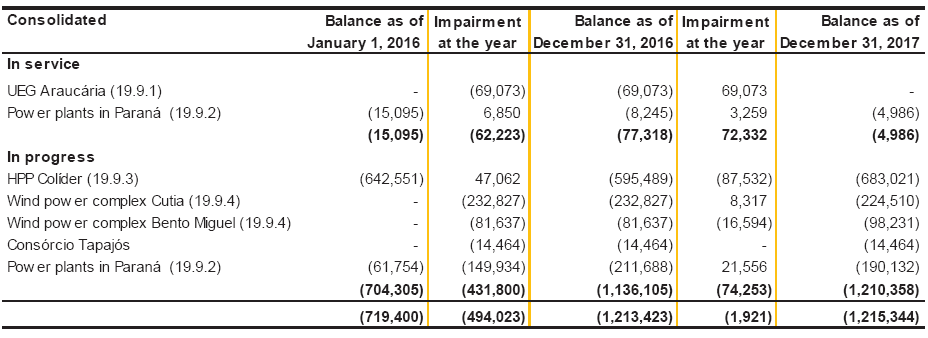
19.9.1 UEG Araucária
In 2017 the calculation of value in use considered Company assumptions and budgets, discount rate of 7.66% after tax (8.01% p.a. in 2016), which stems from the WACC methodology for the electric power generation segment, plus additional risk associated with revenue variation. The reversal noted is justified mainly by the review of the discount rate and by the Company’s revised projections as to the expected variable unit cost (CVU) and power delivery.
19.9.2 Power plants of Paraná
In 2017 the calculation of value in use of generation assets in the State of Paraná considered: (i) Company assumptions and budgets; (ii) for power plants in operation, pretax discount rate in constant currency of 8.11% (8.63% p.a. in 2016); and (iii) for power plants under modernization and/or construction, after-tax discount rate in constant currency of 5.35% p.a. (5.70% p.a. in 2016), which stem from the WACC methodology for the electric power generation segment. The reversal noted arises mainly from the review of the discount rate used.
76

19.9.3 Colíder HPP
In 2017 the calculation of value in use considered Company assumptions and budgets and after-tax discount rate in constant currency of 5.35% p.a. (5.70% p.a. in 2016), which stems from the WACC methodology for the electric power generation segment. This additional provision was recognized mainly in connection with further delays for work completion, as well as increase in CAPEX expected for completion of the project. The current estimate for go-live of the first turbine is June 2018 (in 2016 the tentative date was December 2017).
19.9.4 Cutia and Bento Miguel Wind Farms
In 2017 the calculation of the value in use considered the Company assumptions and budgets and pretax discount rate in constant currency of 7.11% (8.06% p.a. in 2016), which stems from the WACC methodology for the electric power generation segment, adjusted for the specific condition of taxation of those projects. The movements noted are justified mainly by the revision of the discount rate and by the revisions of projections, notably as to the assumption of power available for long-term sale.
As the Cutia Wind Farm is concerned, the reversal noted is justified mainly by the revision of the discount rate and by the revisions of the projected operating costs. The value of the reversal decreased by the change in the expected go-live in July 2018 (in 2016, the tentative date was October 2017).
On the other hand, as the Bento Miguel Wind Farm is concerned, the increase in the provision is driven mainly by the increase in estimated capex for the project. The amount of the provision was reduced by the change in the expectation of go-live beginning October 2018 (in 2016, the tentative date was January 2019).
19.9.5 Cash generating units with no provision for impairment
Most of power plants with no impairment have a recoverable amount above the carrying amount of the PPE. The table below presents the percentage the recoverable amount (“VR”) exceeds carrying amount (“VC”) of PPE, calculated as follows: (recoverable amount / carrying amount -1). Also, the Company performed a sensitivity analysis, increasing the discount rate by 5% and by 10% for impairment risk assessment for each power plant. Based on such analysis, the sole project with an impairment risk is the Voltalia Wind Farm, as follows:
77

20.1 Distribution concession agreement
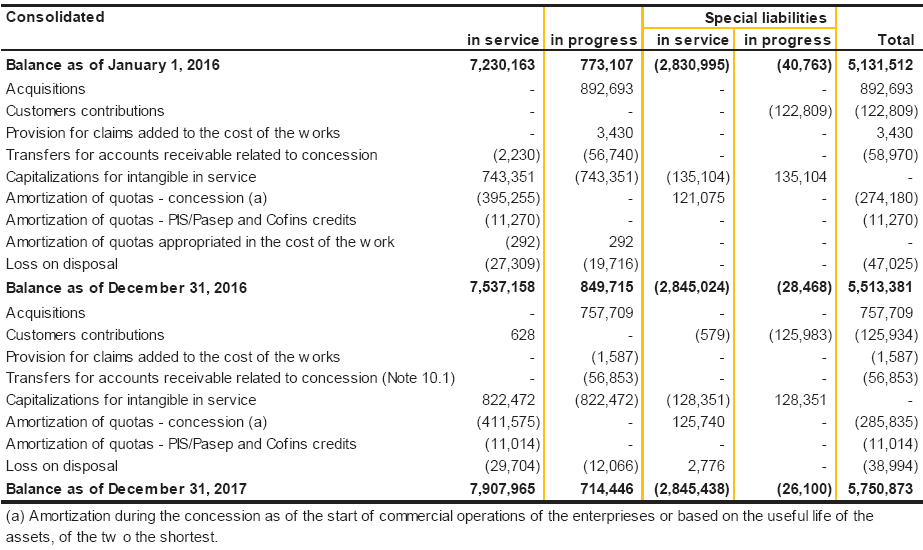
In accordance with ICPC 01 (R1) / IFRIC 12 - Accounting concessions, the share of infrastructure that will be used during concession was recorded in intangible assets, composed of the assets of the electricity distribution, net of interests of consumers (special obligations).
Special liabilities comprise customers’ contributions, Federal Government grants, federal, state, and municipal funds, and special credits assigned to the investments in facilities related to a concession.
The amortization of the special liabilities is calculated using the average rate of depreciation of assets that comprises the infrastructure, and the balance of special liabilities contained in intangible assets will be fully amortized over the concession period.
Special obligations are not financial liabilities or shareholder’s credits.
79

20.2 Generation concession agreement
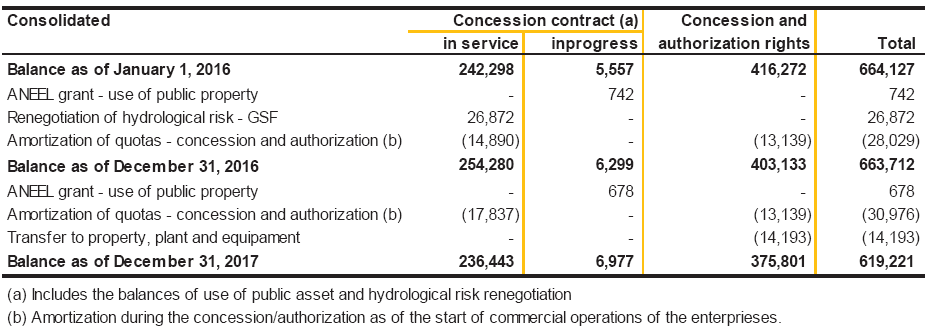
20.3 Concession agreement - gas distribution
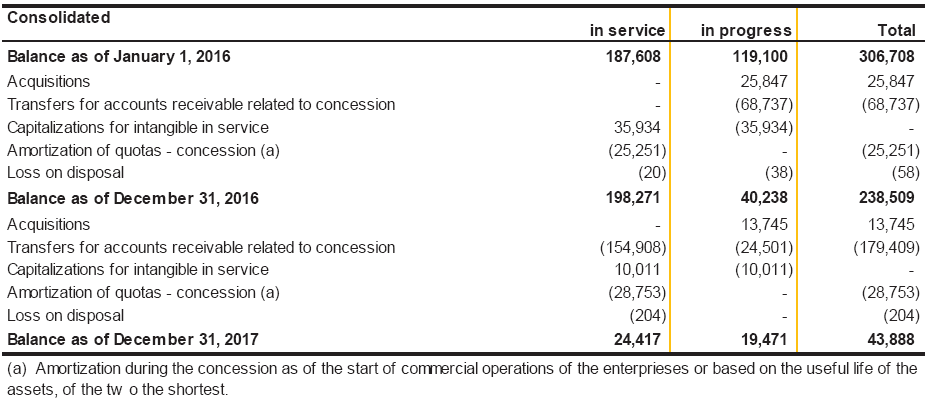
80

20.4 Other intangible assets
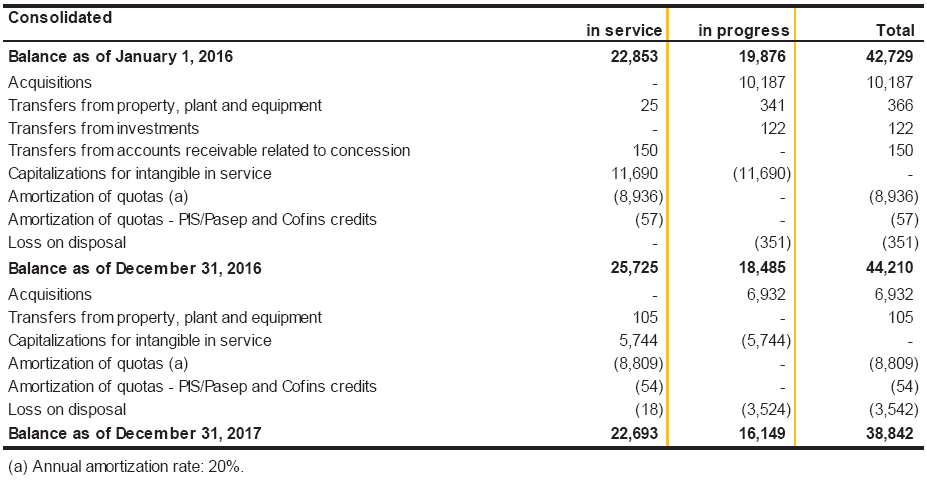
20.5 Costs of loans, financing and debentures capitalized
The costs of loans, financing and debentures capitalized during 2017 amounted to R$4,497, at an average rate of 0.25% p.y. (R$7,608, at an average rate of 0.41% p.y. during 2016).
21 Payroll, Social Charges and Accruals
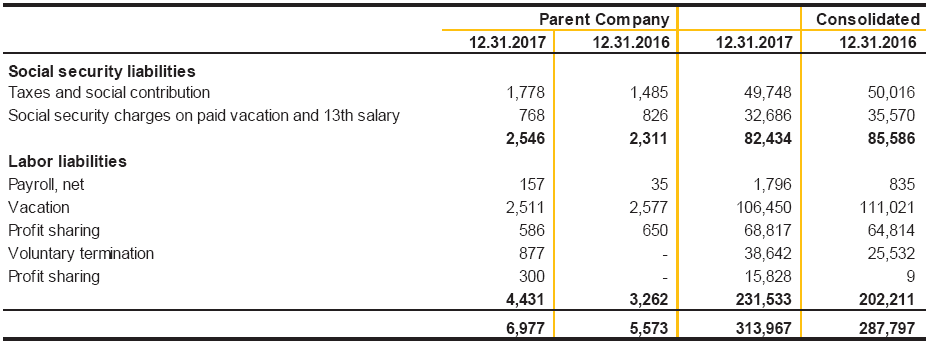
81

22 Suppliers

82

23 Loans and Financing
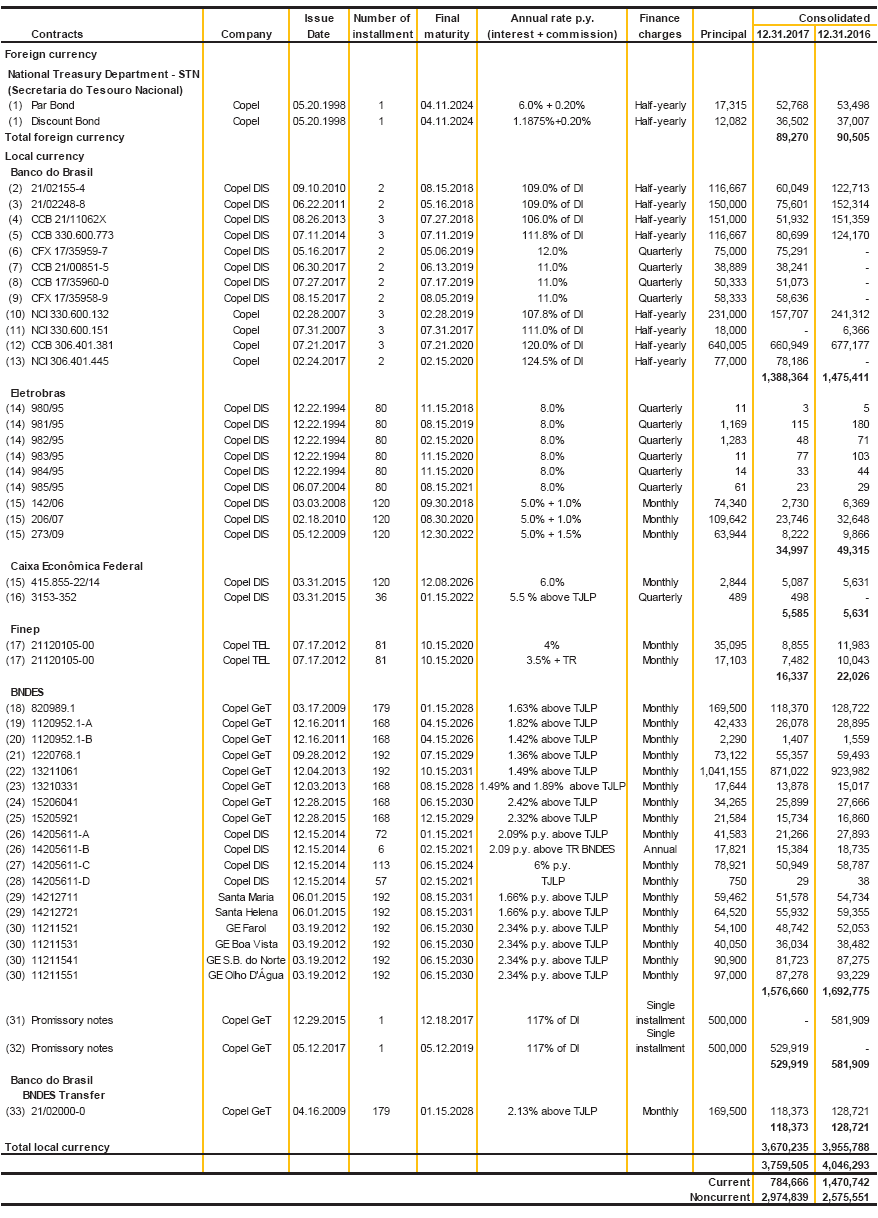
83

23.1 Collateral and escrow deposits - STN
Guarantees provided in the form of Par Bonds for R$44,548 (R$42,988 at December 31, 2016), and Discount Bonds in the amount of R$31,117 (R$30,086 at December 31, 2016), to be used to repay amounts of principal corresponding to STN contracts, when these payments are due on April 11, 2024. The amounts are updated by applying the weighted average percentage changes of United States Treasury Zero Coupon bond prices, by the share of each series of the instrument in the portfolio of collateral for principal, provided in the context of the Brazilian Financing Plan from 1992.
23.2 Breakdown of loans and financing by currency and index

23.3 Maturity of noncurrent installments

85

23.4 Changes in loans and financing
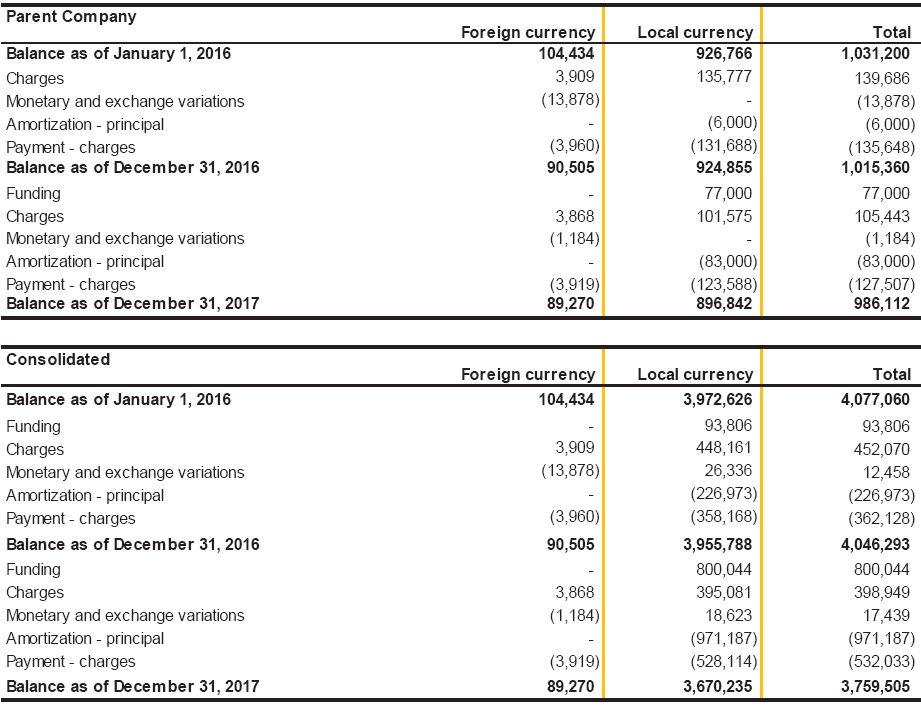
23.5 Covenants
The Company and its subsidiaries signed loan and financing agreements containing covenants that require economic and financial ratios to remain within pre-determined parameters, requiring annual fulfillment and other conditions to be observed, such as not promote any alteration to the Company’s shareholdings in the capital stock of subsidiaries that would alter control without prior consent. Failing to fulfil these conditions may lead to accelerated debt repayment and/or fines.
At December 31, 2017, all the conditions agreed had been fulfilled.
86

The financial covenants contained in the loan and financing agreements are presented below:
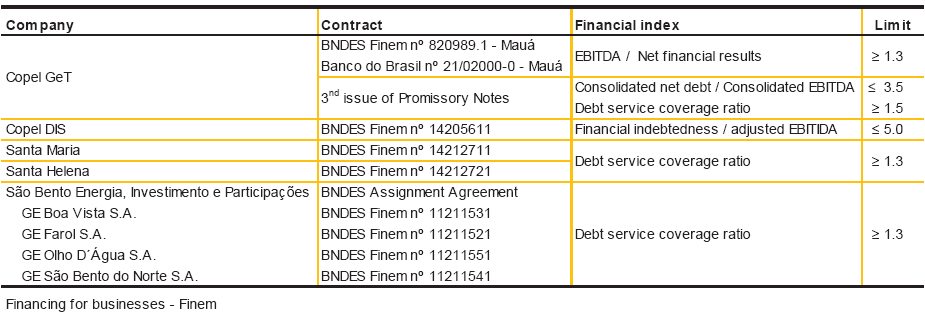
87

24 Debentures

88

24.1 Maturity of noncurrent installments

24.2 Changes in debentures
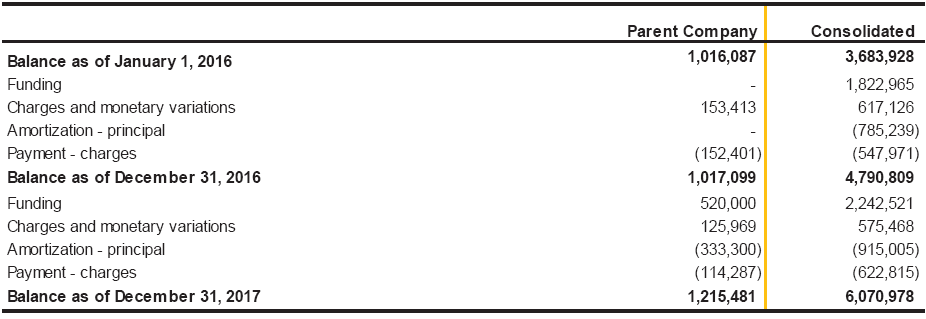
24.3 Covenants
Copel and its subsidiaries issued debentures containing covenants that require certain economic and financial ratios to be kept within pre-determined parameters, requiring annual fulfillment and other conditions to be observed, such as not promote any alteration to the Company’s shareholdings in capital stock that would alter control without prior consent from the debenture holders; not paying out dividends or interest on capital if it is in arrears in relation to honoring any of its financial obligations or not keeping the financial ratios as determined without prior written consent of the debenture holders. Failing to fulfil these conditions may lead to accelerated redemption of debentures and regulatory penalties.
At December 31, 2017, subsidiary Ventos de Santo Uriel failed to meet the Debt Service Coverage Index - ICSD of 1.3. However, at December 29, 2017 the Company received a letter from BNDES with reference AE/DEENE2 No. 93/2017, waiving it from fulfillment of the obligation to meet the ICSD for 2017.
Except for the previously exposed, at December 31, 2017, all financial ratios had been fulfilled.
The financial covenants contained in the debenture agreements are presented below:
89

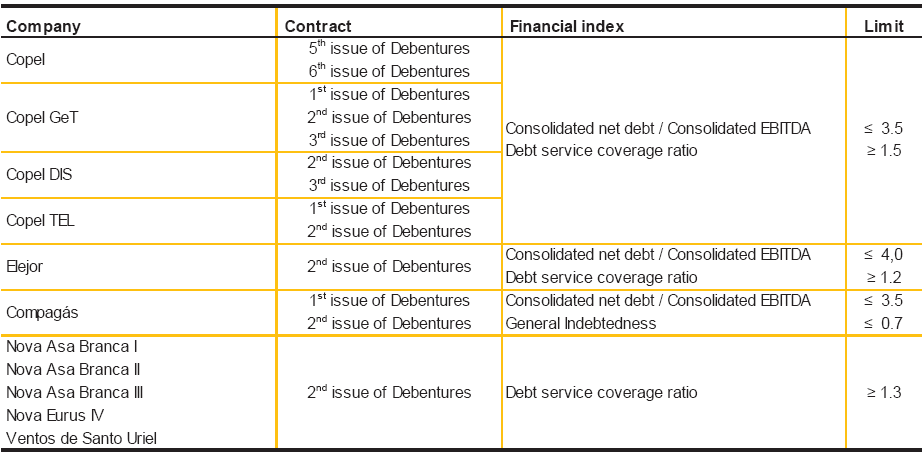
25 Post-employment benefits
The Company and its subsidiaries sponsor private retirement and pension plans (Unified Plan and Plan III) and Healthcare Plan for medical and dental care (“ProSaúde II” and “ProSaúde III” Plans) for their active employees and their dependents. The lifetime sponsorship of the Healthcare Plan for retirees, pensioners and legal dependents is only applied to “Prosaúde II” plan participants.
The amounts of these actuarial obligations (contributions, costs, liabilities, and/or assets) are calculated annually by an independent actuary at year end.
The benefits plan assets are valued at market values (mark-to-market).
The amount of the net assistance liability is recognized at the present value of the actuarial liability, less the fair value of the plan assets.
The adoption of the projected credit unit method adds each year of service as the source of an additional benefit unit, adding up to the calculation of the final liability.
Other actuarial assumptions are used which take into account biometric and economic tables in addition to historical data from the benefits plans, obtained from the manager of these plans, Fundação Copel de Previdência e Assistência Social.
Actuarial gains or losses caused by changes in assumptions and/or actuarial adjustments are recognized in other comprehensive income.
25.1 Benefit Pension Plan
The Unified Plan is a Defined Benefit plan - BD in which the income is predetermined, according to each individual’s salary. This plan is closed plan for new participants since 1998.
90

The Plan III is a Variable Contribution plan - CV, being the only plan available for new participants.
The costs assumed by the sponsors for these plans are recognized according to the actuarial valuation prepared annually by independent actuaries in accordance with CPC 33 (R1) and correlated to IAS 19 (R1) and IFRIC 14. The economic and financial assumptions for purposes of the actuarial valuation are discussed with the independent actuaries and approved by the sponsor’s management.
25.2 Healthcare Plan
The Company and its subsidiaries allocate resources for the coverage of healthcare expenses incurred by their employees and their dependents, within rules, limits, and conditions set in “ProSaúde II” and “ProSaúde III” Plans’ regulations. Coverage includes periodic medical exams in both plans and is only extended to all retirees and pensioners for life in the “ProSaúde II” plan.
25.3 Statement of financial position and statement of income
Amounts recognized in liabilities, under Post-employment Benefits, are summarized below:

Amounts recognized in the statement of income are shown below:

91

25.4 Changes in post-employment benefits

25.5 Actuarial valuation in accordance with CPC 33 (R1)
25.5.1 Actuarial assumptions
The actuarial assumptions used to determine the amounts of liabilities and costs for 2017 and 2016 are shown below:

25.5.2 Number of participants and beneficiaries

92

25.5.3 Life expectancy from the average age - Annuity Table AT-2000 (in years)

The average age of inactive participants of the healthcare and pension plans of the Company and its subsidiaries is 64.4 years.
25.5.4 Actuarial evaluation
Based on the review of the assumptions, the values of the Unified Plan and Plan III as of December 31, 2017 amounted, respectively, surplus of R$481,678 and R$86,487, while the position at December 31, 2016, was, respectively, R$527,723 and R$228,396. The current applicable legislation does not permit any significant reduction in contributions or reimbursements to the Company based on the current surplus in this plan. For this reason, the Company did not record assets on its December 31, 2017 balance sheet that reflect any such right to reduce contributions or refund surplus or other amounts.

The Company and its subsidiaries made adjustments to their assistance liabilities through the actuarial report issued on December 31, 2017, when an actuarial gain of R$46,506 was recorded in other comprehensive income.
25.5.5 Changes in actuarial liabilities

93

25.5.6 Changes in actuarial assets

25.5.7 Estimated costs
The estimated net periodic plan costs (gains) for 2018 for each plan are shown below:

25.5.8 Sensitivity analysis
The following tables feature a sensitivity analysis, which shows the effect of a one percent increase or decrease in the assumed rates of change in care costs, in the aggregate of the cost of service and cost of interest components of the net care costs and the accumulated post-employment benefit obligation.

94

25.5.9 Benefits payable
The estimated benefits to be paid by the Company and its subsidiaries in the next five years and the total benefits for the following fiscal years are shown below:

25.5.10 Asset allocation and investment strategy
The asset allocation for the Company and its subsidiaries pension and healthcare plans at the end of 2017 and the allocation goal for 2018, by asset category, are shown below:

Below are the limits set by the Fund management:

As of December 31, 2017 and 2016, the pension plan assets included the following securities issued by Copel:

95

25.5.11 Additional information
The Company and its subsidiaries made contributions to Plan III (variable contribution plan) for all active employees at December 31, 2017 and December 31, 2016 in the amounts ofr R$80,727 and R$75,679, respectively.
26 Customer Charges Due

27 Research and Development and Energy Efficiency
In accordance with Law No. 9,991/2000, concessionaires and licensees of electric power generation and transmission are required to allocate annually the percentage of 1% of their net operating regulatory revenue to research and development of the electricity sector, and the electric power distribution concessionaires must segregate this same percentage into the research and development and energy efficiency programs of the electricity sector, according to ANEEL Normative Resolutions No. 504/2012 and 556/2013, and updated by Sub-module 5.6 - Research and Development - R&D and Energy Efficiency - EE Approved by RN ANEEL No. 737/2016.
27.1 Balances recognized for investment in Research and Development (R&D) and the Energy Efficiency Program (EEP)
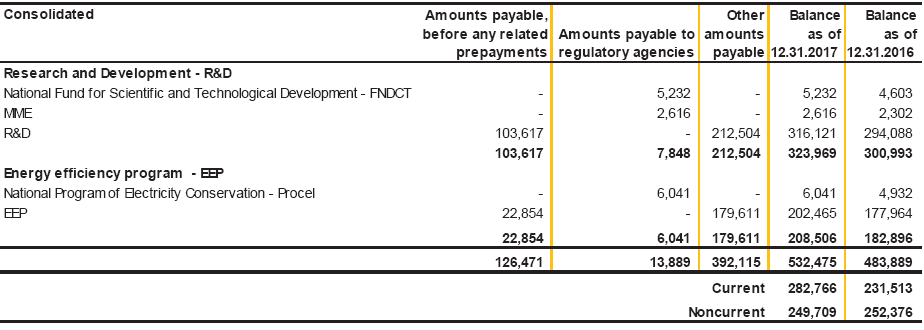
96

27.2 Changes in R&D and EEP balances
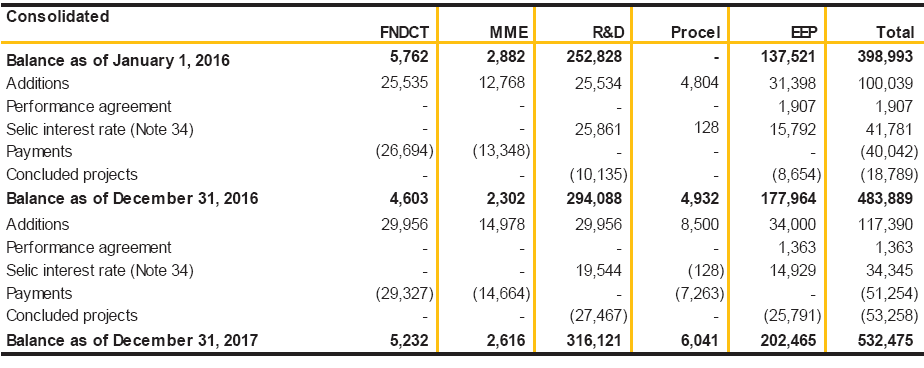
28 Accounts Payable Related to Concession
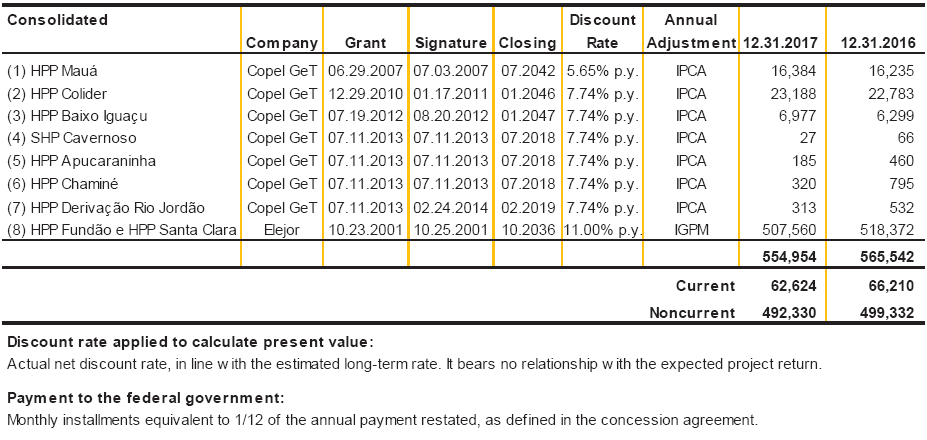
28.1 Nominal value and present value of accounts payable related to concession

97

28.2 Changes in accounts payable related to concession

29 Other Accounts Payable
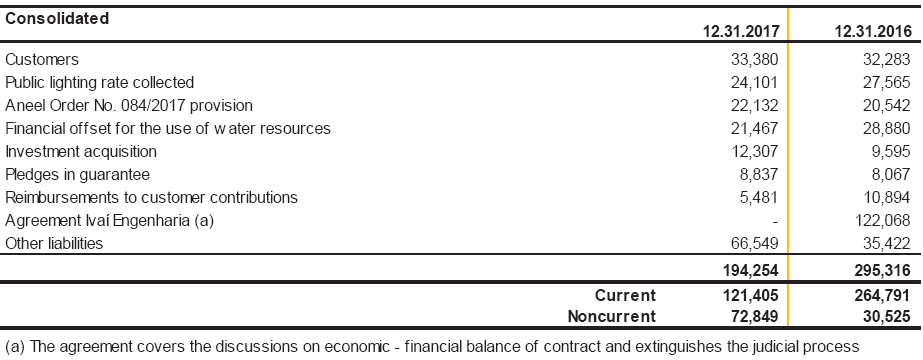
30 Provisions for Legal Claims
The Company and its subsidiaries are defendants in various judicial and administrative proceedings before different courts. Based on assessments made by the Company’s legal counsel, Management makes provisions for actions in which losses are rated probable, thus meeting the criteria for recognition of provisioning described in Note 4.8. to the financial statements at December 31, 2017.
The Company’s management believes that, at the time of preparation of financial statements, it is not practicable to provide information regarding the expected timing of any cash outflows resulting from these legal actions in which the Company and its subsidiaries are involved, due to the slow pace and unpredictability of Brazilian legal, tax and regulatory systems, and since final resolution of the proceedings for which a provision has been registered depends on the conclusions of court proceedings. Therefore, this information is not being provided.
98

30.1 Provisions for legal claims
30.1.1 Changes in provisions for litigation in actions rated as probable losses

99

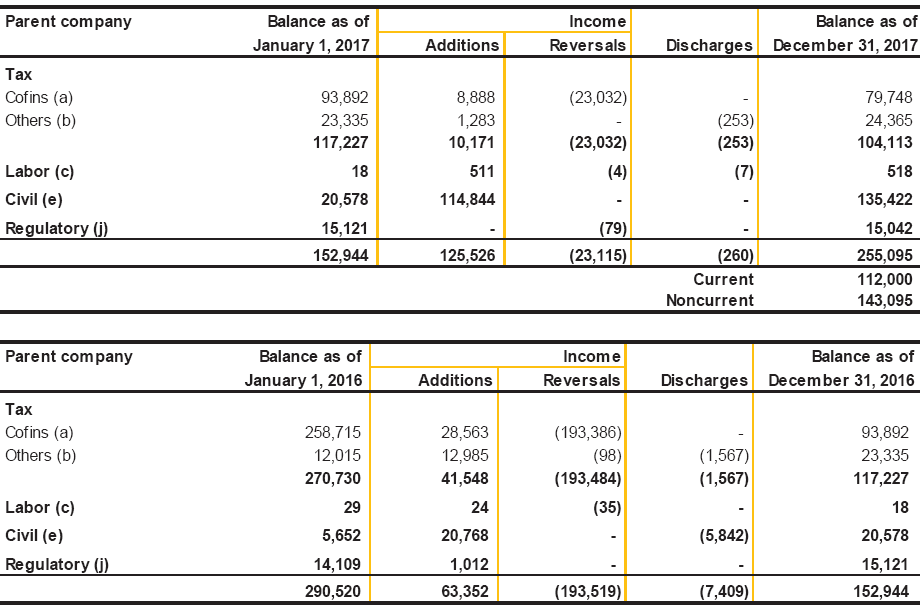
30.1.2 Description of nature and/or details of the principal actions
a) Contribution for Social Security Funding (COFINS)
Plaintiff:Federal Tax Authority
Cofins payables and respective interest and fines from August 1995 to December 1996 due to the termination of a judicial decision that had recognized the Company’s exemption from Cofins.
Current status:awaiting judgment.
b) Other tax provisions
Actions relating to federal, state and municipal taxes, fees and other charges: The principal action is described below:
Defendant: Federal Tax Authority
By the case 5037809-14.2015.4.04.7000, Copel GeT required payment in installments of the balance owed on the annual adjustment of corporate income tax (IRPJ) and social contribution (CSLL) for the fiscal year 2014. The Federal Tax Authority consolidated the amount and applied the maximum fine. An injunction was filed against this decision since the Federal Tax Authority failed to obey the limit established in legislation.
Current status: awaiting judgment of the Special Appeal. On December 31, 2016, the amount of R$24,230 was transferred to Other Tax Liabilities (Note 13.3).
100

c) Labor
Labor claims comprise claims filed by employees and former employees of Copel and its subsidiaries in connection with the payment of overtime, hazardous working conditions, transfer bonuses, salary equality/reclassification, and other matters, and also claims by former employees of contractors and third- parties (secondary responsibility) involving indemnity and other matters.
d) Employee benefits
Labor claims comprise claims filed by retired former employees of the Company and its wholly owned subsidiaries against the Copel Foundation, which will have consequential impact on the Company and its wholly owned subsidiaries, since additional contributions will be required.
e) Civil and administrative claims
Actions involving billing, irregular procedure, administrative contracts and contractual fine, indemnity foraccidents with the electric power grid or vehicles.
The balance also contains the amount being discussed by arbitration and under secrecy and confidentiality, in the discovery phase, without no decision being handed down.
The main lawsuits are as follows:
Plaintiff: Tradener Ltda. Estimated amount: R$115,559
Class action No. 588/2006 has already been rendered final and unappealable, and the ruling recognized as valid commissions payable by the Company to Tradener. In the civil public action No. 0000219- 78.2003.8.16.0004, filed by the Prosecution Office, a decision has also been rendered ruling on the absence of irregularities in the electric power purchase agreement. Therefore, Tradener brought recovery lawsuits, seeking to receive its commissions.
Current status:Case record 0005990.22.2012.8.16.0004 - the Company was ordered to pay the amount of R$107,955, which is the value updated by the (INPC/IBGE) from the maturity of the commissions, plus default interest of 1% per month, as of the date of notification (October 31, 2012), as well as attorneys’ fees. The Company filed an appeal against this decision, however, on November 8, 2016, by majority votes, the Court dismissed the appeal. Copel filed a request for Amendment of Judgment, which was partially granted to resolve obscurity, although without changing the result of the appeal. Copel filed a Special Appeal with the Superior Court of Justice.
Plaintiff: Compensation to third parties Estimated amount: R$92,663
Lawsuit for compensation of supposed loss to the plaintiff due to work and implementation of the hydroelectric project. Low court judgment declaring the lawsuit has no grounds and being appealed by the grounded claim of the plaintiff, and the amount of damages should be determined subsequently.
Current status: in the phase of closing of case.
101

f) Easements
Lawsuits are filed when there is a difference between the amount determined by Copel for payment and the amount claimed by the owner and/or when the owner's paper title may not be registered (probate proceedings are underway, properties have no registry number, etc.).
They may also involve third-party interventions for adverse possession, whether from owners or occupants of contiguous properties or even in cases of properties where right of way easements is required to preserve limits and boundaries of these areas.
g) Expropriations and property
Lawsuits are filed challenging expropriation when there is a difference between the amount determined by Copel for payment and the amount claimed by the owner and/or when the owner's paper title may not be registered (probate proceedings are underway, properties have no registry number, etc.).
Possessory case actions include those for repossession of property owned by the concessionaire. Litigation arises when there is a need to repossess properties invaded or occupied by third parties in areas owned by the Company. Cases may also arise from intervention in third-party adverse possession, or owners or occupants of contiguous properties or even in cases of properties to preserve limits and boundaries of expropriated areas.
h) Consumers
Lawsuits seeking compensation for damages caused in household appliances, lawsuits claiming damages for pain and suffering caused by service interruption and lawsuits filed by industrial consumers challenging the lawfulness of the increase in electricity prices while Plano Cruzado (anti-inflation plan) was in effect and claiming reimbursement for the amounts paid by the Company.
i) Environmental
Class actions whose purpose is to obstruct the progress of environmental licensing for new projects or to recover permanent preservation areas located around the hydroelectric power plant dams unlawfully used by private individuals. If the outcome of the lawsuits is unfavorable to the Company, management estimates only the cost to prepare new environmental studies and to recover the areas owned by Copel GeT.
They also contemplate the “Termos de Ajuste de Conduta -TAC”, which refers to the commitments agreed upon and approved between the Company and the competent bodies for noncompliance with any condition contained in the Installation and Operation Licenses. As they are considered liabilities, these amounts are recorded as "obligations" in current and noncurrent liabilities and the balancing items in property, plant and equipment (construction cost).
j) Regulatory
The Company is challenging, both at the administrative and judicial levels, notifications issued by the Regulatory Agency of alleged violations against regulations. The principal action is described below:
102

Plaintiffs: Companhia Estadual de Energia Elétrica - CEEE and Dona Francisca Energética S.A.
Estimated amount: R$49,397
Copel, Copel GeT and Copel DIS are challenging lawsuits filed against ANEEL's decision No. 288/2002 involving these companies.
Current status:awaiting judgment.
30.2 Contingent liabilities
30.2.1 Classification of actions rated as possible losses
Contingent liabilities are present obligations arising from past events for which no provisions are recognized because it is probable that an outflow of resources embodying economic benefits will be required to settle the obligation. The following information concerns the nature of the Company’s contingent liabilities and potential losses arising thereof.

30.2.2 Description of nature and/or details of the principal actions
a) Tax
Actions relating to federal, state and municipal taxes, fees and other charges in which the Company challenges their applicability, calculation bases and amounts due to be collected. The main lawsuits are as follows:
Plaintiff: Social Security National Institute (INSS) Estimated amount: R$325,750
Tax claims against Copel related to social security contribution on assignment of manpower (lawsuit No. 5003583-56.2010.404.7000); it is worth emphasizing that the case has already been judged favorably to the Company at two court levels, awaiting judgment by the Superior Court of Justice (STJ).
Current status:awaiting judgment.
103

Plaintiff: Social Security National Institute (INSS) Estimated amount: R$27,845
Tax collections against Copel consisting of social security contribution imposed on the assignment of labor (NFLD - 35.273.876-6). The case has been at Carf (Brazilian Administrative Tax Court) for judgment since 2010. The assessment of risk as possible is due to the existence of several legal arguments to defend the Company, particularly (a) the fact that no services were provided and no labor was assigned and (b) the fact that service providers classified into the Simples (lower taxation) category are not required to withhold that contribution.
Current status: awaiting judgment.
Plaintiff: State Tax Authority (SEFAZ) Estimated amount: R$69,528
Copel DIS received tax deficiency notice 6.587.156-4 from the State of Paraná for allegedly failing to pay ICMS (VAT) tax on the ‘metered demand’ line in the electricity bills issued to a major consumer between May 2011 and December 2013.
Copel DIS maintains its illegitimacy to appear in the taxable position of this tax assessment, since it was not included in the judicial process, cannot suffer the effects of the judicial decision pronounced in it.
b) Labor
Labor claims comprise claims filed by employees and former employees of Copel and its subsidiaries in connection with the payment of overtime, hazardous working conditions, transfer bonuses, salary equality/reclassification, and other matters, and also claims by former employees of contractors and third- parties (secondary responsibility) involving indemnity and other matters.
c) Employee benefits
Labor claims comprise claims filed by retired former employees of the Company and its wholly owned subsidiaries against the Copel Foundation, which will have consequential impact on the Company and its wholly owned subsidiaries, since additional contributions will be required.
d) Civil
Actions involving billing, irregular procedure, administrative contracts and contractual fine, indemnity for accidents with the electric power grid and vehicles.
The balance also contains the amount being discussed by arbitration and under secrecy and confidentiality, in the discovery phase, without no decision being handed down.
The main lawsuits are as follows:
104

Plaintiff: Mineradora Tibagiana Ltda. Estimated amount: R$156,398
Action claiming compensation for alleged losses when this mining company was involved in the construction of the Mauá plant by the Energético Cruzeiro do Sul consortium in which Copel GeT has a 51% stake. The action challenges the validity of the mining permit granted by Mineradora Tibagiana for the Mauá job site and the indemnifying effects arising thereof.
Current status:action awaiting judgment in lower court.
Plaintiffs: franchises of the Agency / Copel store Estimated amount: R$54,114
Filing of two individual claims against Copel Distribuição regarding the franchise contracts of Copel branches/stores, with the main petition claiming an extension of the term of the contract and secondary petition to recognize the existence of a sub concession, with transfer of the services provided and full pass- through of the fees, amongst other amounts, currently have appeals awaiting trial.
Current status: awaiting judgment.
e) Regulatory
The Company is challenging, both at the administrative and judicial levels, notifications issued by the Regulatory Agency of alleged violations against regulations. The main lawsuits are as follows:
Plaintiff: ANEEL�� Estimated amount: R$18,922
Copel DIS filed an appeal against a decision by ANEEL's Director-General under Resolution No. 3,959 from December 8, 2015 imposing an inefficiency penalty on Copel DIS due to over-contracting for use of the distribution system (MUSD) with the National Power Network Operator (ONS), obtaining an injunction to suspend the requirement of such penalty.
Current status:awaiting judgment.
Plaintiff: Energia Sustentável do Brasil S.A. - ESBR Estimated amount: R$729,609
ESBR brought Ordinary Action No. 10426-71.2013.4.01.4100 against ANEEL in the federal courts of Rondônia, the decision on which: (i) excludes liability for the 535-day schedule overrun in the construction of the Jirau Hydropower Station; (ii) declares any obligations, penalties and costs imposed on ESBR as a result of the schedule overrun to be unenforceable, and (iii) annuls ANEEL Resolution No. 1,732/2013, which recognized a schedule overrun of only 52 days.An appeal has been brought by ANEEL, in progress at the TRF of the 1st Region.
The practical outcome of the decision is that, by exempting ESBR, it exposed the distribution utilities with which it had concluded regulated power trading contracts (CCEARs) including Copel DIS to the spot market and spot prices during the period.The reason is that electricity trading rules require that all electricity consumed be covered by a contract.
105

The risk of loss in this case is rated ‘possible’, considering the amount of R$729,609, on December 31, 2017. If the actions are judged unfavorably, the amount will be classified as Sectorial Financial Asset to be recovered through tariff rates.
Current status:awaiting judgment.
31 Equity
31.1 Capital
Capital consists of common and preferred shares. Each common share entitles its holder to one vote in the general shareholders’ meetings. Preferred shares do not have voting rights and have two classes “A” and “B”.
According to Article 17 and following paragraphs of Federal Law No. 6,404/76, dividends paid to preferred shares must be at least 10% higher than those paid on common shares.
Class “A” preferred shares have priority in the reimbursement of capital and in the distribution of minimum dividends of 10% p.y. (non-cumulative), calculated based on the capital represented by this class of shares.
Class “B” preferred shares have priority in the reimbursement of capital and the right to the distribution of dividends, calculated as 25% of adjusted net income, pursuant to the corporate legislation and to the Company’s by-laws, calculated proportionately to the capital represented by the shares of this class. Dividends for Class “B” have priority only over the common shares and are only paid out of the remaining profits, following payment of priority dividends of class “A” shares.
The paid-in share capital is R$7,910,000. The different classes of shares (with no par value) and main shareholders are detailed below:
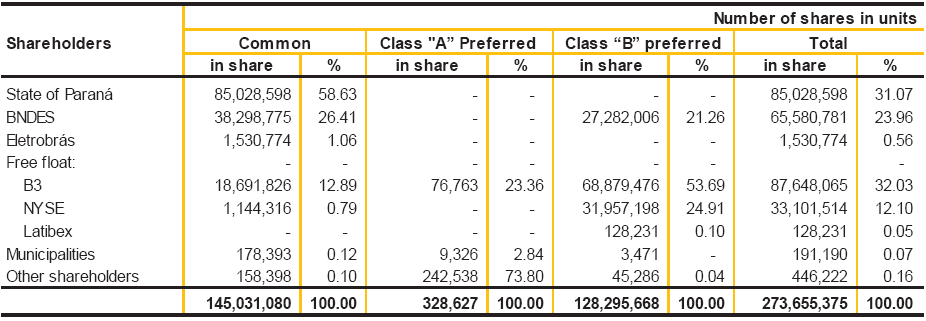
106

31.2 Equity valuation adjustments
Fair values of fixed assets - deemed costs - were recognized on the first-time adoption of IFRS. The account “Equity value adjustments” was the balancing item of this adjustment, net of deferred income tax and social contribution, including under the equity method. The realization of such adjustments is recorded in the retained earnings account, to the extent of the depreciation or possible write-off of the valued items.
Adjustments arising from the changes in fair value involving financial assets available for sale, as well as actuarial gains and losses, are also recorded in this account.
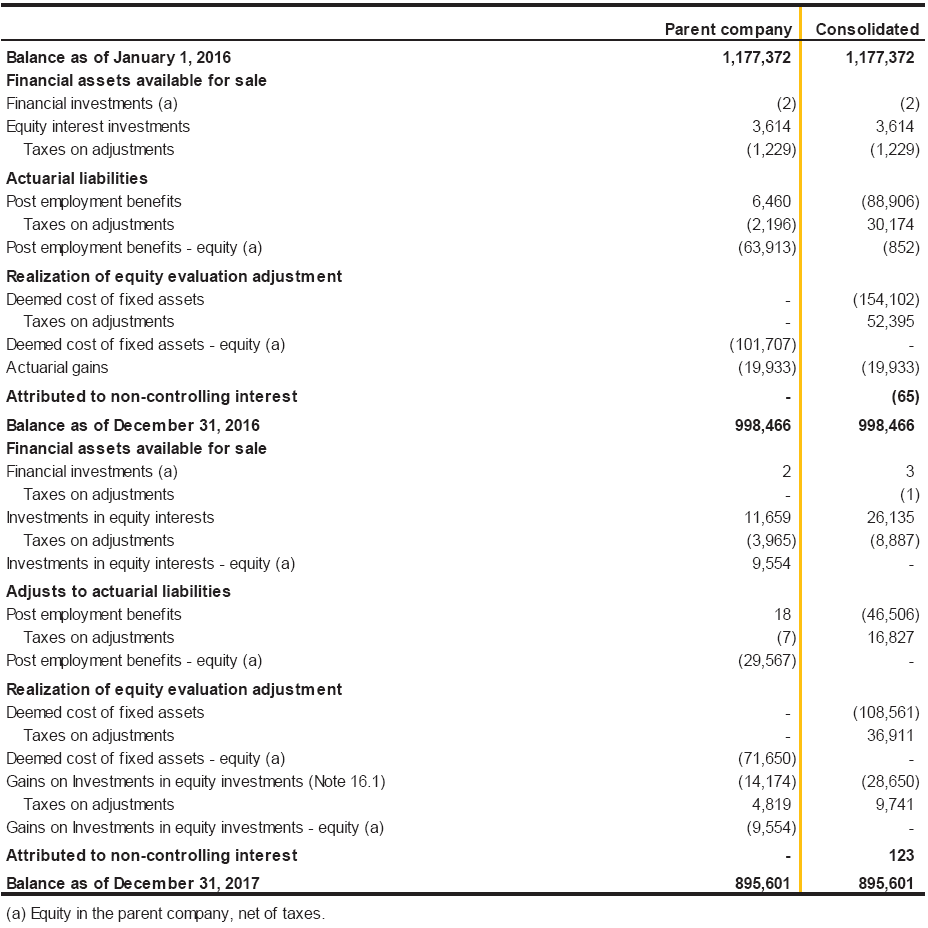
107

31.3 Legal reserve and profit retention reserve
5% of the net income for the year is allocated to the legal reserve, before any other allocation, limited to 20% of capital.
The profit retention reserve is designed to cover the Company's investment program, according to Article 196 of Law No. 6,404/1976. It is funded by retaining any remaining net profit after legal reserve constitution and interest on capital and dividends proposition.
31.4 Proposed dividend distribution
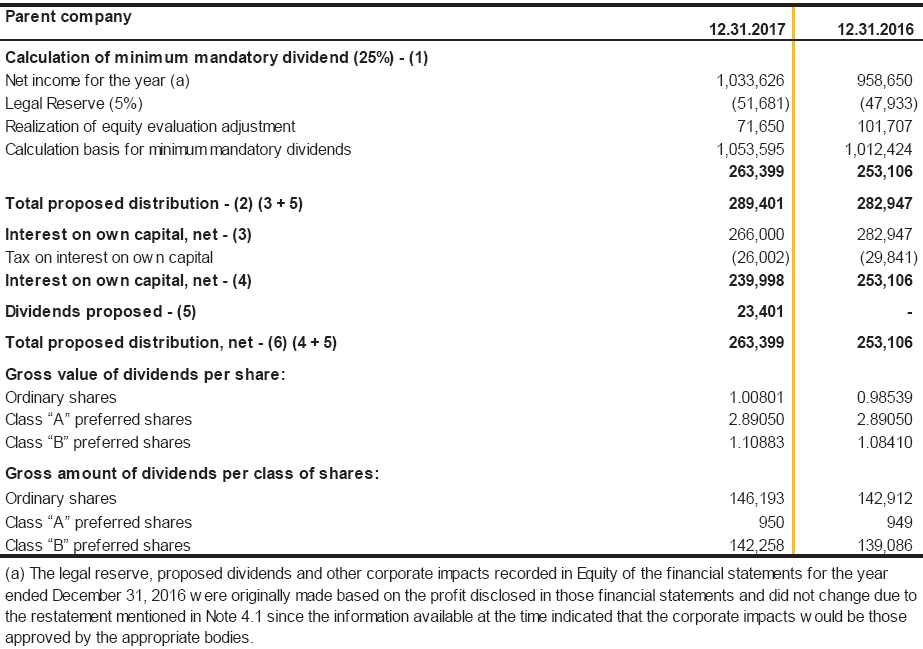
In accordance with legal and statutory requirements in effect, the basis for calculating the minimum mandatory dividends is obtained from the net income for the year, less the portion that will fund the legal reserve. However, Management decided to include in this basis the amount related to the realization of the equity value adjustments, specifically to compensate the effects coming from the increase of the depreciation expense arriving from the adoption of the new accounting standards. This procedure reflects the policy to distribute dividends to Company’s shareholders, which will be effective during the realization of the entire asset/liability valuation adjustments account.
The distribution of the minimum mandatory dividend is recognized as a liability in the Company’s and its subsidiaries financial statements at year-end.
108

The tax benefit of interest on capital is recorded in the statement of income in the moment of its recognition in accounts payable.
31.5 Earnings per share - basic and diluted
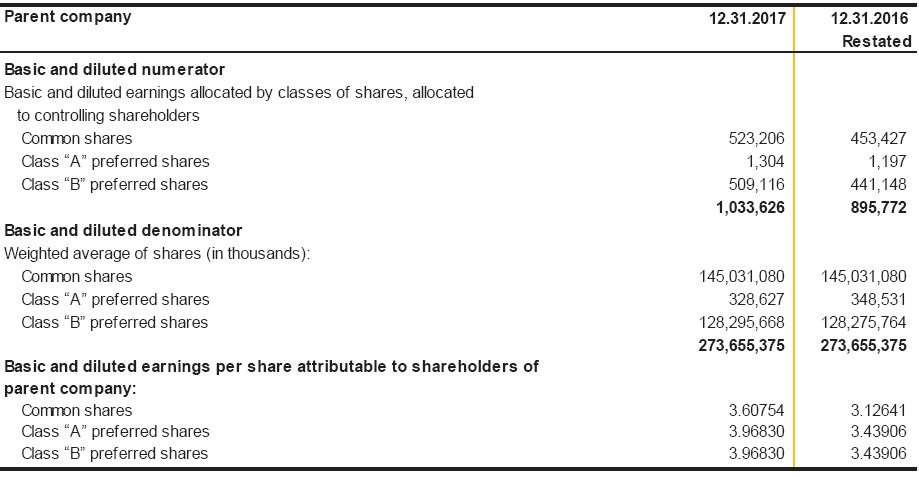
109

32 Net Operating Revenue
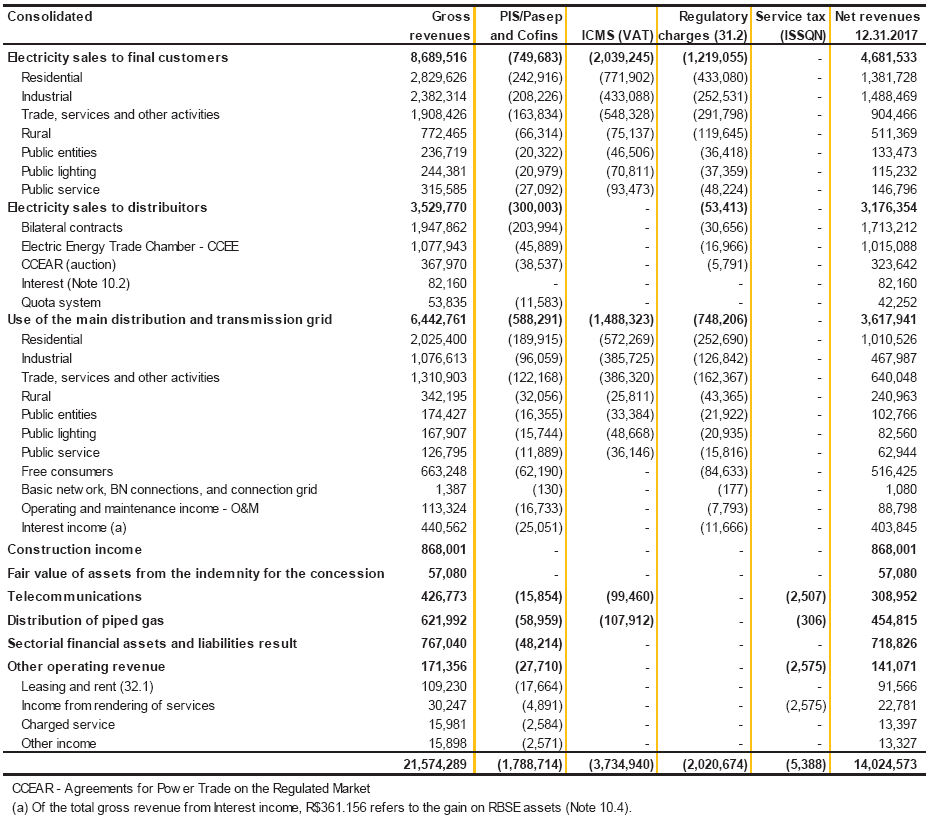
110

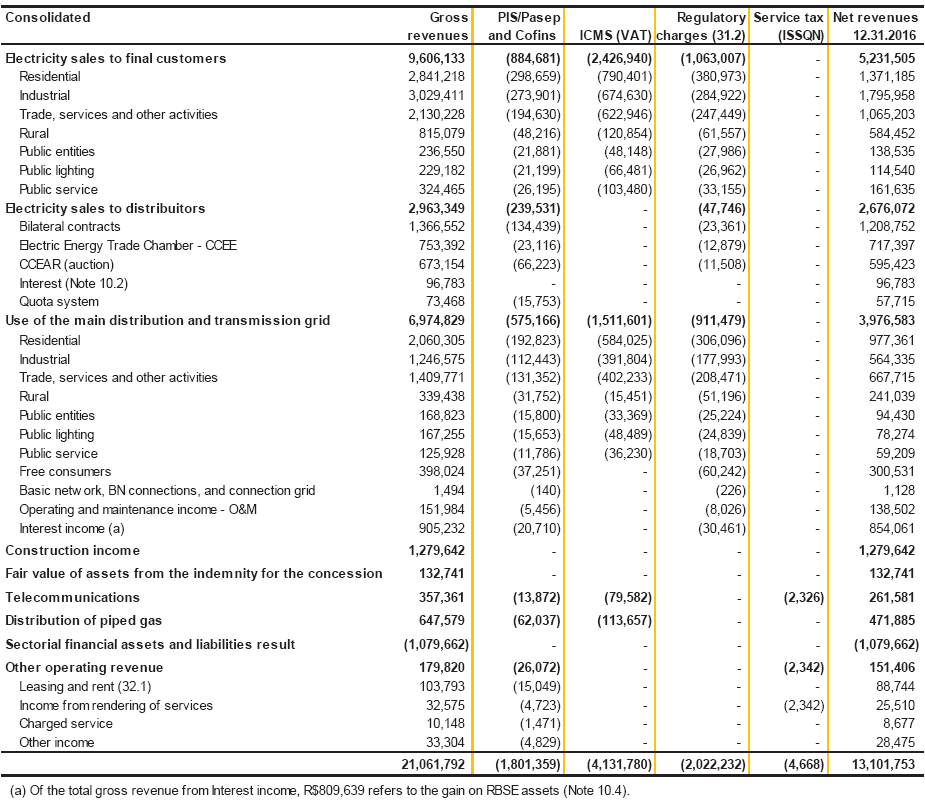
32.1 Leasing and rent
32.1.1 Revenues from leases and rentals

32.1.2 Receivables from non-cancelable leases

111

32.2 Regulatory charges

32.2.1 Energy Development Account - CDE
The primary objectives of the Energy Development Account (CDE) created by Law No. 10,438/2002 and amended by Law No. 12,783/2013, are: (i) universalization of the electric power service; (ii) subsidy to the low income residential subclass; (iii) Fuel Consumption Account - CCC; (iv) amortization of financial operations associated with the compensation upon the reversal of concessions or to meet the purposes of moderateness of tariffs; (v) competitiveness of the power produced by national mineral coal in the areas served by interlinked systems; (vi) competitiveness of the power produced by wind sources, small hydroelectric power plants, biomass, natural gas and other renewable sources; (vii) subsidy for tariff discounts to the distributors due to the loss of revenue from discounted granted on tariffs of use of electric power systems; (viii) administrative funding grants for management of CDE, CCC and RGR by CCEE; and (ix) compensation to the rural electrification cooperatives, concessionaires or permission holders by the tariff impact from the reduced density of load in relation to the supplying concessionaire.
CDE’s quotas were originally defined based on the CCC figures for the 2001 Interconnected Systems, the values of which were adjusted annually starting in 2002 in proportion to the market growth of each agent, and in 2004 also by the IPCA. As of Law 12,783/2013, the system is changed and quotas are defined based on the resources needed to achieve its purposes and other revenues related to the CDE. The CDE charge incorporates:
i) annual quota of “CDE-Uso”: this quota is allocated to the financing of the objectives of the CDE, set forth in its annual budget, defined by the Federal Government, as provided in §§ 2 and 3 of art. 13 of Law 10,438/2002, with wording given by Law No. 12,783/2013.
ANEEL Resolution No. 2202/2017 defined the CDE-Uso quota, in the monthly amount of R$53,329 as of January 2017. However, as of February of the same year, the monthly amount of the quota was changed to R$61,159, established by ANEEL Resolution No. 2,204/2017;
ii) annual quota “CDE - Energia” (ACR account): this quota is intended for the discharge of credit operations contracted by CCEE in the management of the Regulated Contracting Environment - ACR Account, in compliance with Decree No. 8,222/2014, and pursuant to ANEEL Normative Resolution No. 612/2014.
The purpose of the ACR Account is to cover costs relating to involuntary spot market exposure and the costs of thermal power dispatching in 2014.
112

Resolution No. 1,863/2015 defined the value of the CDE quota (ACR Account) at R$46,638, as of June 2015. Beginning June 2016, by means of Resolution No. 2,004/2015, the amount of the quota was updated to R$49,362. In April 2017, the quota was reduced to R$37,907 until March 2018, and from April 2018 to March 2020, the quota will be R$49,362, as approved by Resolution No. 2,231/2017. These installments are updated annually, in accordance with the conditions contracted by CCEE for each of the loans made with the participating financial institutions; and
iii) annual quota CDE-Energia: destined to the return of the resources received by the distribution concessionaires, from January 2013 to January 2014, to cover costs relating to involuntary spot market exposure and the hydrological risk of the plants contracted on a regime of quotas, and the costs of thermal power dispatching for reasons of energy security, in compliance with Decree 7,895/2013 and Decree 8,203/2014.
From June 2016 to May 2017, the monthly amount of the CDE-Energia quota was established at R$18,947 by ANEEL Resolution No. 2,077/2016. From June 2017, the monthly quota was changed to R$20,138, by Resolution No. 2,204/2017.
Preliminary injunctions
As a result of preliminary injunctions in favor of the Brazilian Association of Large Industrial Consumers and Free Consumers - Abrace, and of the National Association of Energy Consumers - Anace and other associates, which challenge at court the tariff components of CDE-Uso and CDE-Energia, ANEEL, through Resolutions 1,967/2015, 1,986/2015 and 2,083/2016, ratified the tariff calculation deducting these charges from associates of those entities, as long as the preliminary injunctions granted in Judicial Proceedings No. 24648-39.2015.4.01.3400 and No. 0069262-32.2015.4.01.3400 / 16th Federal Court are in effect.
On the other hand, by the preliminary injunction in favor of Abradee, the associated distributors are guaranteed the right of non-transfer, deducting from the portion of CDE-Uso and CDE-Energia the amounts not collected due to the effects of the preliminary injunction. This deduction, which covers all preliminary injunctions, was approved by ANEEL by Order No. 1,576/2016.
Moreover, in compliance with the preliminary injunction granted in the Judicial Proceedings No. 0028882 -30.2016.4.01.3400 of the 2nd Federal Court, ANEEL, through Order No. 2,634/2016, ratified, regarding the 2016 tariff process, new Tariffs for Use of Distribution Systems - Tusd for Abrace members, effective as of June 29, 2016 for as long as the effects of the preliminary injunction relief remain. In addition to the Abrace and Anace associates, other companies have also obtained favorable injunctions, with publication of new tariffs.
113

By means of Resolution No. 2,255 of 6/20/2017, Article 14, the tariff components of the Energy Tariff (TE) in R$/MWh, which must be applied in compliance with the injunctions granted in lawsuits that remain for the 2017 tariff process. As shown in table 11 to this Resolution, the customer units included in injunctions 0069262-32.2015.4.01.3400, of the National Association of Energy Consumers - Anace, and No. 0028996- 66.2016.4.01.3400, of the Labor Union of Cement Industry - SNIC, currently totaling 7 customer units, will continue to benefit from the reduced tariffs.
Accordingly, Copel DIS has been carrying out the deduction of the payment of the CDE quota from the unbilled amounts resulting from these injunctions, thus not impacting the distributor’s result. The differences between the rate coverage for this charge and the amount actually paid, from the beginning of the preliminary injunction to December 2017, represent the amount of R$111,912 for CDE Uso and R$14,105 for CDE Energy.
32.3 Copel DIS periodic tariff adjustment
The annual tariff adjustment, which occurs between tariff reviews, is approved by ANEEL based on a formula defined in the concession agreement and on regulations established in Proret, which consider for unmanageable costs (Portion A) the variations incurred in the period and for manageable costs (Portion B) the IPCA variation, adjusted by applying the Factor X.
ANEEL’s Resolution No. 2,255 of June 20, 2017 approved the result of Copel DIS Annual Tariff Review and authorized a 5.85% average adjustment to be perceived by consumers, consisting of: -0.73% related to the inclusion of financial components; 1.07% from updating Portion B; 2.78% from adjusting Portion A; and 2.73% reflecting the withdrawal of the financial components from the previous tariff process.
This adjustment was fully applied to Copel DIS tariffs as of June 24, 2017.
33 Operating Costs and Expenses

114

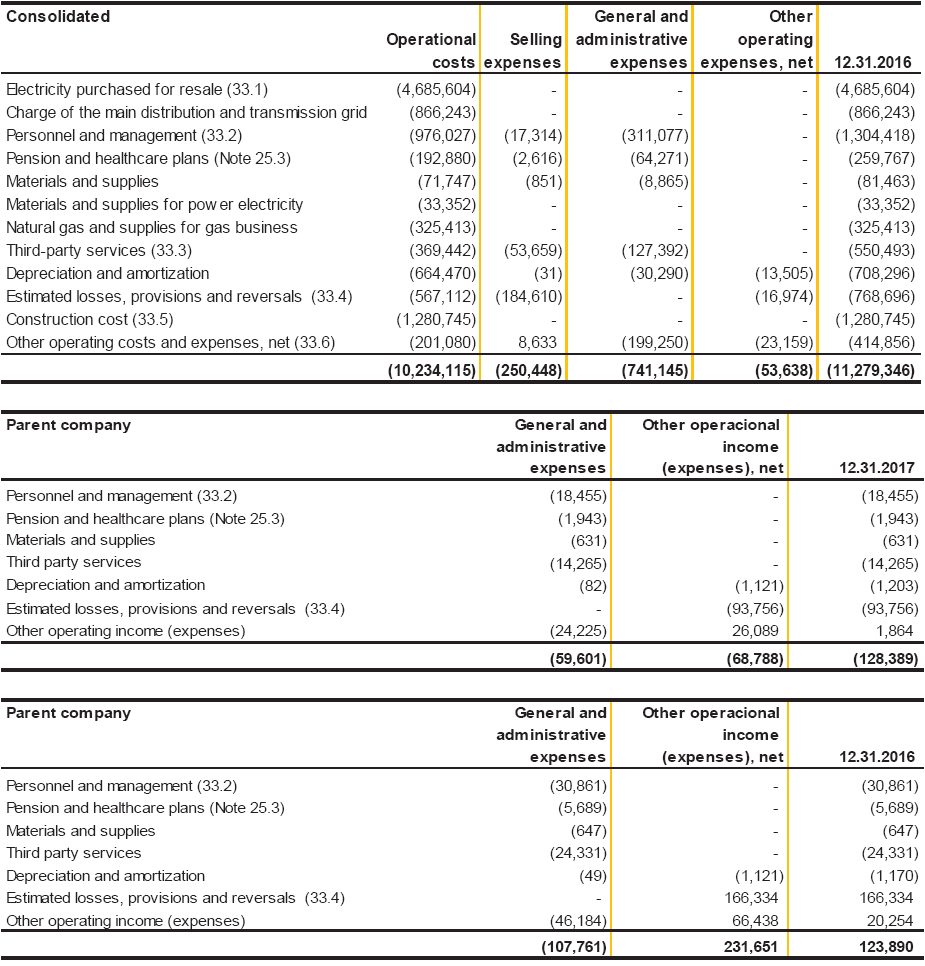
33.1 Electricity purchased for resale

115

33.2 Personnel and management

33.3 Third party services

33.4 Estimated losses, provisions and reversals

116

33.5 Construction cost

33.6 Other operating costs and expenses, net

33.6.1 Leases and rents

33.6.2 Commitments from non-cancelable leases and rents

117

34 Financial Results
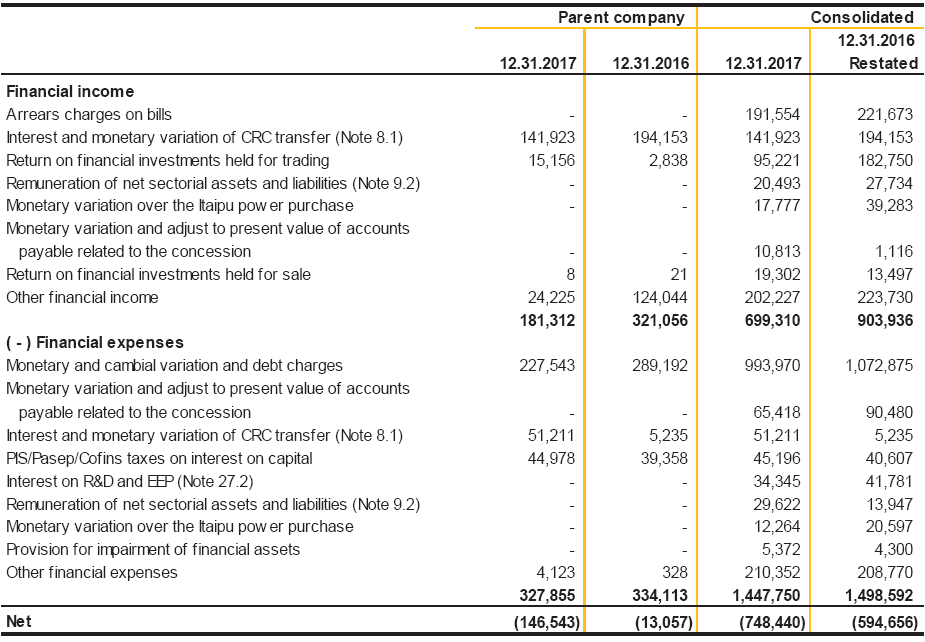
35 Operating Segments
Operating segments are business activities that generate revenues and incur expenses, whose operating results are regularly reviewed by the executive boards of the Parent Company and subsidiaries and by key strategic decision makers responsible for allocating funds and assessing performance.
35.1 Products and services from which we generate revenues from the reportable segments
The Company operates in reportable segments identified by management, through the chief officers of each business area, taking into consideration the regulatory environments, the strategic business units, and the different products and services. These segments are managed separately, since each business and each company requires different technologies and strategies.
In 2017 and 2016, all sales have been to customers within Brazilian territory, as well as all noncurrent assets are located in national territory.
The Company and its subsidiaries did not identify any customer who individually accounts for more than 10% of total net revenues in 2017.
118

The Company evaluates the performance of each segment based on information derived from accounting records.
The accounting policies of the operating segments are the same as those described in Note 4.
35.2 The Company’s reportable segments
The reportable segments of the Company, in accordance with CPC 22/IFRS 8 are:
Power generation and transmission (GET) - this segment comprises the generation of electric energy from hydraulic, wind, and thermal projects (GER) and the transport and transformation of the power generated by the Company, and the construction, operation, and maintenance of all power transmission substations and lines (TRA). For managers, the assets and liabilities of the generation and transmission segments are shown on an aggregate basis while their result is shown separately;
Power distribution (DIS)- this segment comprises the distribution of electric energy, the operation and maintenance of the distribution infrastructure, and related services.
Telecommunications (TEL) - this segment comprises telecommunications and general communications services.
GAS- this segment comprises the public service of piped natural gas distribution.
Power sale (COM)- this segment comprises the sale of electric energy, and related services; and
Holding Company (HOL) - this segment comprises participation in other companies.
35.3 Assets per reportable segment
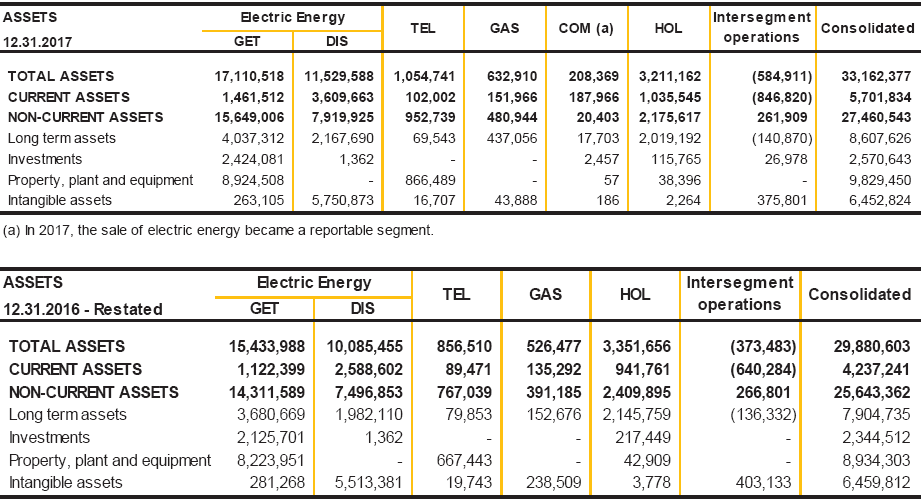
119

35.4 Statement of income per reportable segment
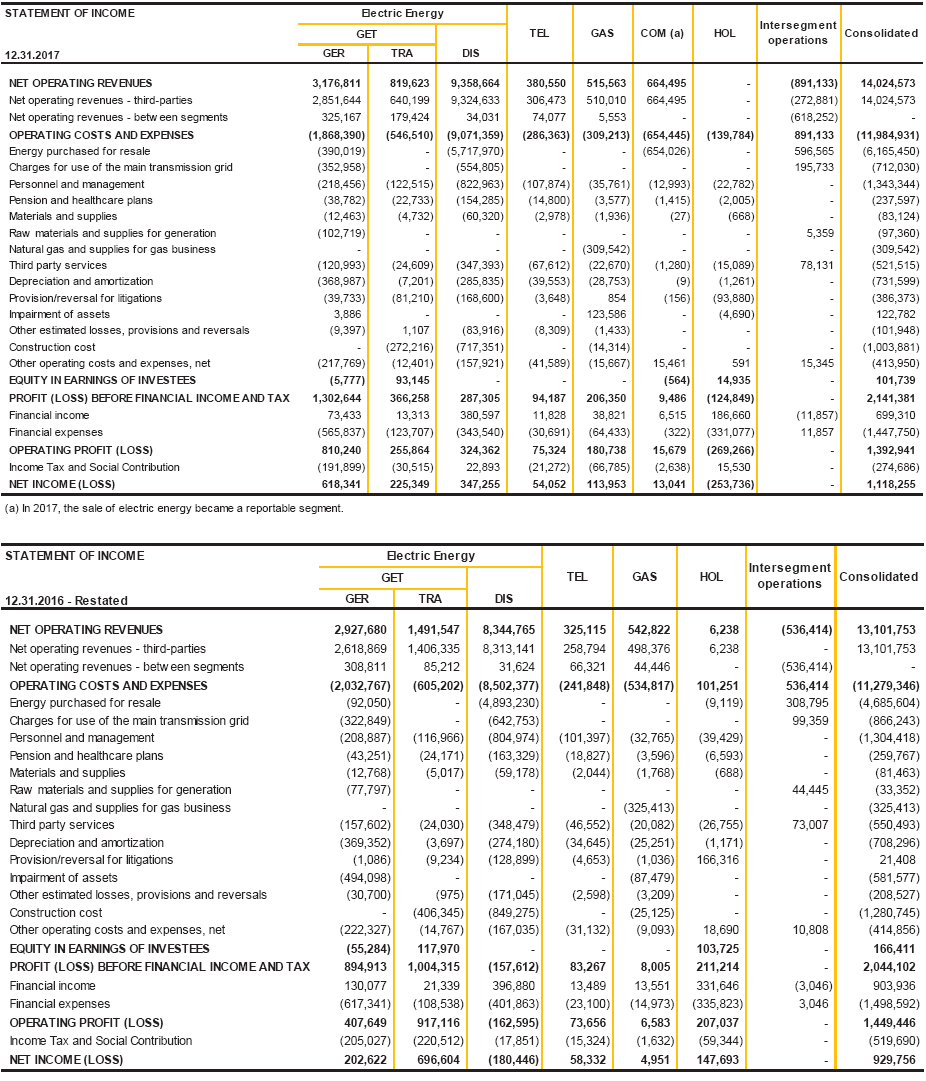
120

35.5 Additions to noncurrent assets by reportable segment
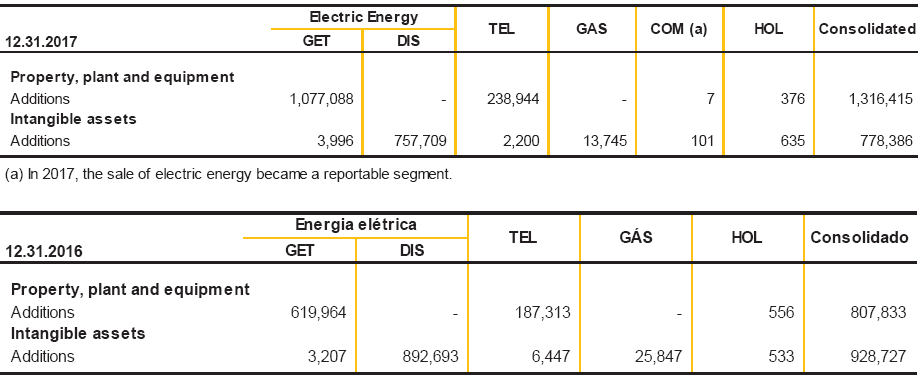
121

36 Financial Instruments
36.1 Categories and determination of fair value of financial instruments
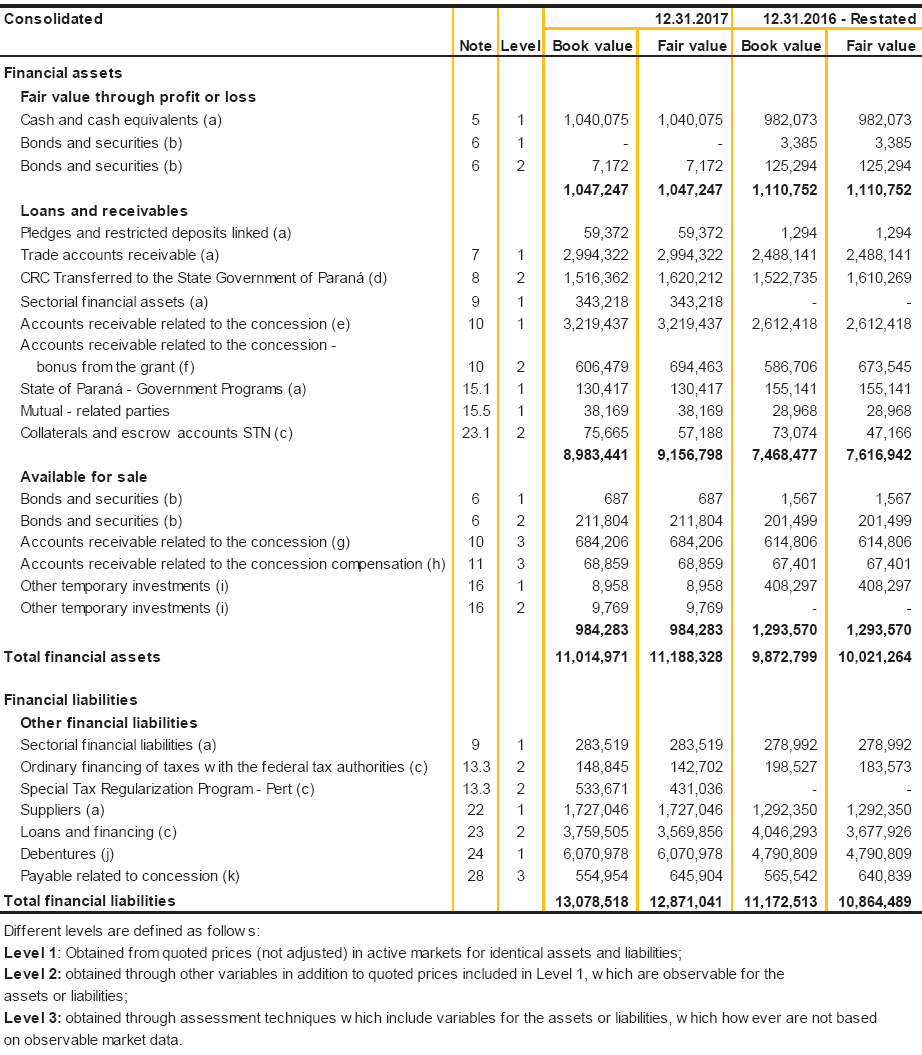
Determining fair values
a) Equivalent to their respective carrying values due to their nature and terms of realization.
122

b) Calculated according to information made available by the financial agents and to the market values of the bonds issued by the Brazilian government.
c) Calculated based on the cost of the last issue by the Company, 126.0% of the CDI for discount of the expected payment flows.
d) The Company based its calculation on the comparison with a long-term and post-fixed National Treasury Bond (NTN-B) maturing on August 15, 2024, which yields approximately 4.47% p.y. plus the IPCA inflation index.
e) Criteria and assumptions disclosed in note 4.3.9. to the financial statements for the year ended December 31, 2017.
f) Receivables related to the concession agreement for providing electricity generation services under quota arrangements at their fair value calculated by expected cash inflows discounted at the rate established in ANEEL auction notice 12/2015 (9.04%).
g) Criteria and assumptions disclosed in Note 4.3.9 to the financial statements for the year ended December 31, 2017. The changes in 2017 are shown in Note 10.1.
h) The fair values of generation assets approximate their book values, according to Note 4.3.10. to the financial statements for the year ended December 31, 2017.
i) Calculated according to the price quotations published in an active market, for assets classified as level 1, and determined in view of the comparative assessment model for assets classified as level 2.
j) Calculated from the Unit Price quotation (PU) for December 29, 2017, obtained from the Brazilian Association of Financial and Capital Markets (Anbima), net of financial cost to amortize.
k) Real net discount rate of 8.11% p.a., in line with the Company’s estimated rate for long-term projects.
36.2 Financial risk management
The Company's business activities are exposed to the following risks arising from financial instruments:
36.2.1 Credit risk
Credit risk is the risk of the Company and its subsidiaries incurring losses due to a customer or financial instrument counterparty, resulting from failure in complying with contract obligations.
123

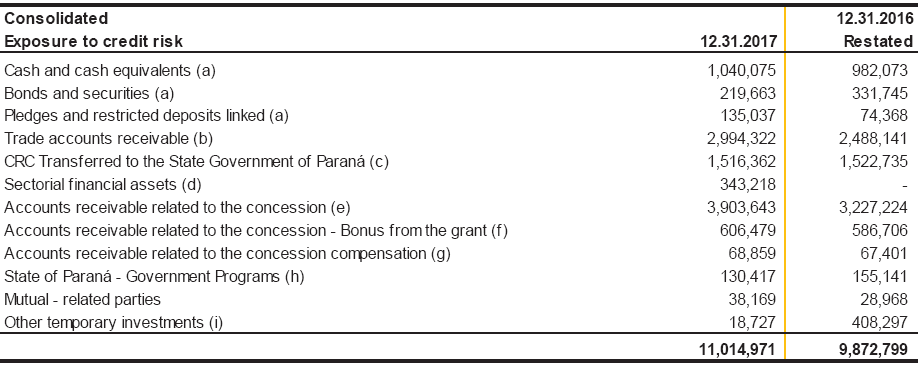
a) The Company’s Management manages the credit risk of its assets in accordance with the Group's policy of investing virtually all of its funds in federal banking institutions. As a result of legal and/or regulatory requirements, in exceptional circumstances the Company may invest funds in prime private banks.
b) The risk arises from the possibility that the Company might incur in losses resulting from difficulties to receive its billings to customers. This risk is closely related to internal and external factors of Copel. To mitigate this type of risk the Company manages its accounts receivable, detecting customer groups that pose the greatest risk of default, cutting off energy supplies and implementing specific collection policies.
c) Management believes this credit risk is low because repayments are secured by funds from dividends.
d) Management believes this risk is very low because these contracts assure an unconditional right to be paid in cash by the concession Granting Authority at the end of the concession period for any infrastructure investments not recovered through tariffs.
e) Management believes this risk is very low because these contracts assure an unconditional right to be paid in cash by the concession Granting Authority at the end of the concession period for any infrastructure investments not recovered through tariffs by the end of the period, specifically for the transmission business, since RAP is guaranteed revenue that does not involve demand risk.
For investments made in infrastructure and that were not recovered through tariff until the end of the concession, the agreements assure the right to receive cash until the end of the concession to be paid by the Granting Authority.
124

For the amount relating to RBSE assets existing on May 31, 2000, ANEEL published Normative Resolution 589/2013, which defines criteria for calculating the New Replacement Value (VNR). Given that on April 20, 2016, through MME Ordinance 120, the Granting Authority defined the means and period for receiving this asset regulated by. ANEEL Normative Resolution 762/2017, Management considers the risk of this credit to be low, even considering the injunctions that temporarily reduced the RAP receivable, regarding the cost of equity determined in RSBE’s assets from January 2013 to June 2017, as described in Note 10.4.
f) Management considers the risk of this credit to be very low, as the contract for the sale of energy by quota guarantees the receipt of an Annual Generation Revenue - RAG guaranteed which includes the annual amortization of this amount during the concession term.
g) For the generation concession assets, ANEEL published Normative Resolution 596/2013, which defines criteria for calculating the New Replacement Value (VNR), for indemnity purposes. Although the Granting Authority has not yet disclosed the means of remunerating these assets and there are uncertainties as to approval or ratification of investments made in this respect, Management believes that compensation for these assets indicates the recoverability of the recorded balance.
h) Management believes this credit risk is very low because these are specific programs together with the State Government to highlight the Luz Fraterna program (Note 37.a).
i) The risk arises from the possibility that the Company might incur losses resulting from the volatility on the stock market. This type of risk involves external factors and has been managed through periodic assessment of the variations occurred in the market.
36.2.2 Liquidity risk
The Company's liquidity risk consists of the possibility of insufficient funds, cash or other financial asset to settle obligations on scheduled dates.
The Company manages liquidity risk relying on a set of methodologies, procedures and instruments applied for a permanent control over financial processes to ensure a proper management of risks.
Investments are financed by incurring medium and long-term debt with financial institutions and capital markets.
Short-, medium- and long-term business projections are made and submitted to management bodies for evaluation. The budget for the next fiscal year is annually approved.
Medium and long-term business projections cover monthly periods over the next five years. Short-term projections consider daily periods covering only the next 90 days.
The Company permanently monitors the volume of funds to be settled by controlling cash flows to reduce funding costs, the risk involved in the renewal of loan agreements and compliance with the financial investment policy, while at the same time keeping minimum cash levels.
125

The following table shows the expected undiscounted settlement amounts in each time range. Projections were based on financial indicators linked to the related financial instruments and forecast according to average market expectations as disclosed on the Central Bank of Brazil's Focus Report, which provides the average expectations of market analysts for these indicators for the current year and the following year. From 2021, 2020 indicators are repeated through the forecast period.
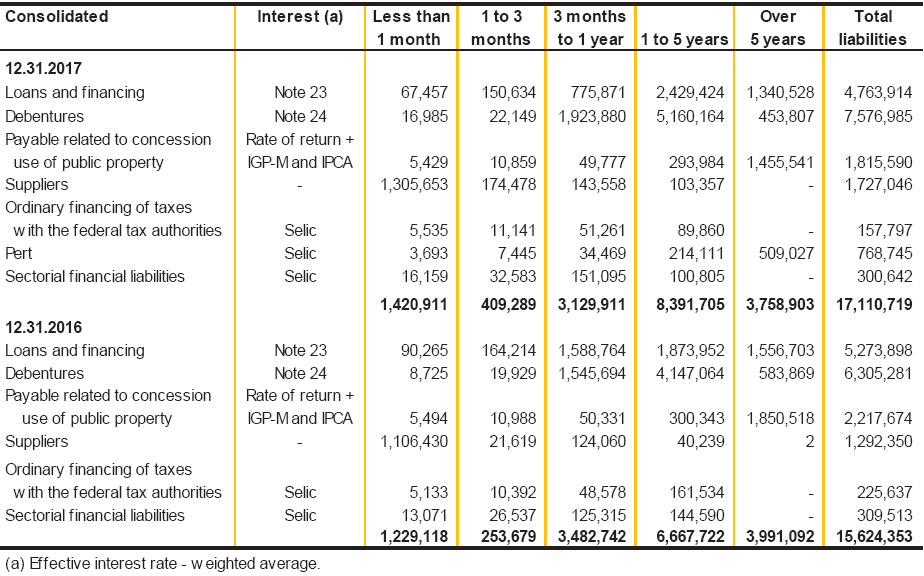
As at December 31, 2017, Copel recorded a negative net working capital of R$59,385 in Parent Company (R$371,351 as at December 31, 2016) and R$408,079 in the Consolidated (R$1,418,795 as at December 31, 2016). The Company's Management has been monitoring the liquidity and taking actions to balance the short-term financial capacity, preserving the Company's investment programs, as well as seeking debt extension, as described in Note 36.3.
As disclosed in Notes 23.5 and 24.3, the Company and its subsidiaries have loans and financing agreements and debentures with covenants that if breached may have their payment accelerated.
126

36.2.3 Market risk
Market risk it is the risk that fair value or the future cash flows of a financial instrument shall oscillate due to changes in market prices, such as currency rates, interest rates and stock price. The purpose of managing this risk is to control exposures within acceptable limits, while optimizing return.
a) Foreign currency risk (US Dollar)
This risk comprises the possibility of losses due to fluctuations in exchange rates, which may reduce assets or increase liabilities denominated in foreign currencies.
The Company’s foreign currency indebtedness is not significant and it is not exposed to foreign exchange derivatives. The Company monitors all relevant exchange rates.
The effect of the exchange rate variation resulting from the power purchase agreement with Eletrobras (Itaipu) is passed on to customers in Copel DIS's next tariff adjustment.
The exchange rate risk posed by the purchase of gas arises from the possibility of Compagas reporting losses on the fluctuations in exchange rates, increasing the amount in Reais of the accounts payable related to the gas acquired from Petrobras. This risk is mitigated by the monitoring and transfer of the price fluctuation through tariff, when possible. Compagas monitors these fluctuations on an ongoing basis.
Sensitivity analysis of foreign currency risk
The Company has developed a sensitivity analysis in order to measure the impact of the devaluation of the U.S. dollar on its loans and financing subject to exchange risk.
The baseline takes into account the existing balances in each account as of December 31, 2017 and the probable scenario assumes a variation in the exchange rate - end of period (R$/US$3.30) based on the median market expectation for 2018 reported in the Central Bank’s Focus report of February 2, 2018. For the scenarios 1 and 2, deteriorations of 25% and 50%, respectively, were considered for the main risk factor for the financial instrument compared to the rate used in the probable scenario.

127

In addition to the sensitivity analysis required by CVM Resolution No. 475/2008, the Company evaluates its financial instruments considering the possible effects on profit and loss and equity of the risks evaluated by Company management on the reporting date for the financial instruments, as recommended by CPC 40 (R1) Financial Instruments. Disclosure. Based on the equity position and the notional value of the financial instruments held as of December 31, 2017, it is estimated that these effects will approximate the amounts stated in the above table in the column for the forecast probable scenario, since the assumptions used by the Company are similar to those previously described.
b) Interest rate and monetary variation risk
This risk comprises the possibility of losses due to fluctuations in interest rates or other indicators, which may reduce financial income or financial expenses or increase the financial expenses related to the assets and liabilities raised in the market.
The Company has not engaged in transactions with derivatives to cover this risk, but it has continually monitored interest rates and market indicators, in order to assess the potential need for such transactions.
Sensitivity analysis of interest rate and monetary variation risk
The Company has developed a sensitivity analysis in order to measure the impact of variable interest rates and monetary variations on its financial assets and liabilities subject to these risks.
The baseline scenario takes into account the existing balances in each account as of December 31, 2017 while the ‘probable’ scenario assumes balances reflecting varying indicators as follows: CDI/Selic - 6.75%, IPCA - 3.94%, IGP DI - 4.50%, IGP-M - 4.56% and TJLP - 6.75%, estimated as market average projections for 2018 according to the Focus Report issued by the Central Bank of Brazil as of February 2, 2018, except TJLP that considers the rate set by the National Monetary Council for the first quarter of 2018.
For the scenarios 1 and 2, deteriorations of 25% and 50%, respectively, were considered for the main risk factor for the financial instrument compared to the rate used in the probable scenario.
128

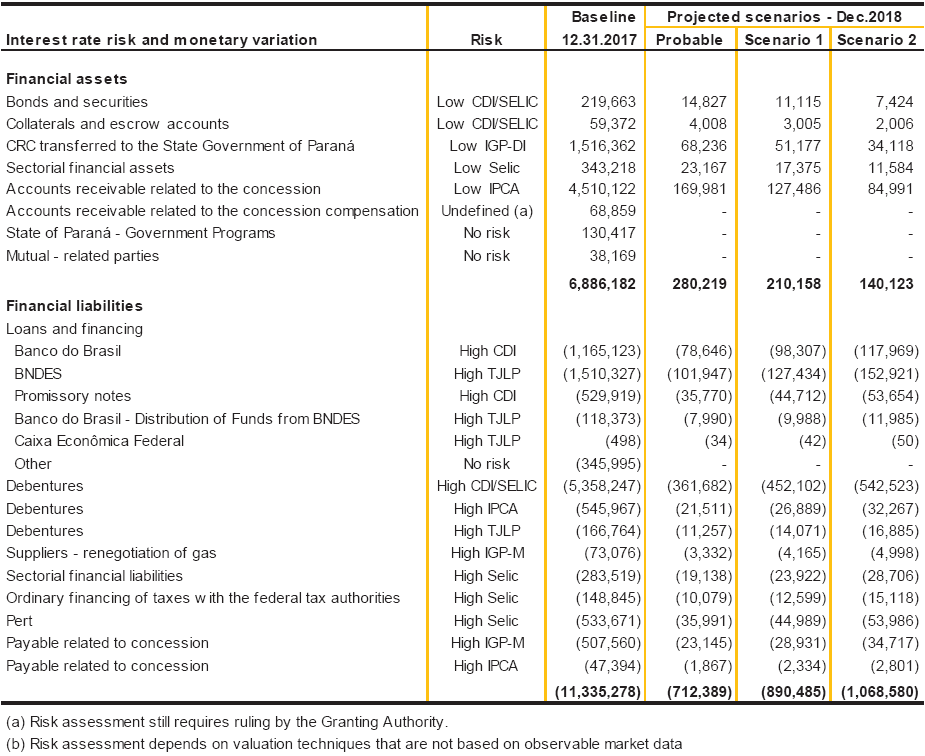
In addition to the sensitivity analysis required by CVM Resolution No. 475/2008, the Company evaluates its financial instruments considering the possible effects on profit and loss and equity of the risks evaluated by Company management on the reporting date for the financial instruments, as recommended by CPC 40 (R1) Financial Instruments. Based on the equity position and the notional value of the financial instruments held as of December 31, 2017, it is estimated that these effects will approximate the amounts stated in the above table in the column for the forecast probable scenario, since the assumptions used by the Company are similar to those previously described.
36.2.4 Electricity shortage risk
Approximately 64% of installed capacity in the country currently comes from hydroelectric generation, as informed by the Generation Information Bank of ANEEL, which makes Brazil and the geographic region in which we operate subject to hydrological conditions that are unpredictable, due to non-cyclical deviations of mean precipitation. Unsatisfactory hydrological conditions may cause, among other things, the implementation of comprehensive programs of electricity savings, such as rationalization or even a mandatory reduction of consumption, which is the case of rationing.
129

From 2014, the reservoirs of the Southeast/Midwest, North and Northeast regions have been subject to adverse climate situations, leading agencies responsible for this industry to adopt water resources optimization measures to guarantee full compliance with load.
The economic crisis that the country is going through has had a significant impact on the consumption of electricity, practically stagnating its growth in the last 4 years, being decisive to avoid a greater difficulty in the full service of the market.
Regarding short-term risk, the Electric Power Industry Monitoring Committee - CMSE has been reporting a balance between energy supply and demand, and indices have been kept within safety margins. The same position is adopted by ONS regarding the risk of deficit in the medium term, as stated in the 2018-2022 Energy Operation Plan.
Although dam storage levels are not ideal, from the standpoint of regulatory agencies, when combined with other variables they are sufficient to keep the risk of deficit within the safety margin established by the National Energy Policy Council - CNPE (maximum risk of 5%) in all subsystems.
36.2.5 Risk of GSF impacts
The Energy Reallocation Mechanism (MRE) is a system of redistribution of electric power generated, characteristic of the Brazilian electric sector, which has its existence by the understanding, at the time, of the need for a centralized operation associated with a centrally calculated optimum price known as PLD. Since generators have no control over their production, each plant receives a certain amount of virtual energy which can be compromised through contracts. This value, which enables the registration of bilateral contracts, is known as Physical Guarantee - GF and is also calculated centrally. Unlike PLD, which is calculated on a weekly basis, GF, as required by Law, is recalculated every five years, with a limit of increase or decrease, restricted to 5% by revision or 10% in the concession period.
The contracts need to be backed. This is done, especially, through the allocation of power generated received from the MRE or purchase. The GSF is the ratio of the entire hydroelectric generation of the MRE participants to the GF sum of all the MRE plants. Basically, the GSF is used to calculate how much each plant will receive from generation to back up its GF. Thus, knowing the GSF of a given month the company will be able to know if it will need to back up its contracts through purchases.
Whenever GF multiplied by GF is less than the sum of contracts, the company will need to buy the difference in the spot market. However, whenever GSF multiplied by GF is greater than the total contracts, the company will receive the difference to the PLD.
The low inflows recorded since 2014 as well as problems with delays in the expansion of the transmission system have resulted in low GSF values, resulting in heavy losses for the companies holding MRE participating hydroelectric projects.
For plants with contracts in the Free Contracting Environment - ACL, the main way to manage the low GSF risk is not to compromise the entire GF with contracts, approach currently adopted by Copel.
130

For the contracts in the ACR, Law 13,203/2015, allowed the generators to contract insurance of the load, by means of payment of a risk premium. Copel adopted this approach to protect contracts related to energy produced by Mauá, Foz do Areia, Santa Clara, Fundão, Baixo Iguaçu and Cavernoso II Thermoelectric Plants.
For the distribution segment, the effects of the GSF are perceived in the costs of the contracts for availability, as well as in the costs associated with quota of Itaipu, of Angra and the plants whose concessions were renewed in accordance with Law 12,783/2013. This is a financial risk, however, since it guarantees the neutrality of energy purchase expenses through a tariff transfer.
36.2.6 Risk of non-renewal of concessions - generation and transmission
Currently, the extension of generation, transmission and distribution concessions covered by Articles 17, 19 and 22 of Law No. 9,074/1995 is governed by Law 12,783/2013. However, extension is permitted after express acceptance of conditions of that Law, such as: i) distribution and transmission revenue determined according to criteria established by ANEEL; ii) submission to service quality standards defined by ANEEL; (iii) change from price remuneration to tariff calculated by ANEEL for each plant; and (v) allocation of plant energy and capacity physical guarantee shares to concessionaires and permission holders of distribution public utilities.
Concessions of hydroelectric power generation, electric power transmission and distribution may be extended at the discretion of the Concession Grantor, one single time, for a period of up to 30 years. However, for concessions of thermoelectric power generation, extension period is limited to 20 years. Decree 9,187 of November 1, 2017 regulates the extension of the thermoelectric power generation concessions set forth in Law 12,783.
Current regulation also defines that the concessionaire should request extension of concession of up to 60 months before the final contract date or after granting of concessions to hydroelectric power generation and electric power transmission and distribution plants, and of up to 24 months for thermoelectric plants.
It was also defined that, if the concessionaire opts to extend its concession, the Concession Grantor may advance effects of extension by up to 60 months counted as of contract or grant date, and may also define initial tariff or revenue.
On March 24, 2017 Copel GeT filed with ANEEL its intention to extend the granting of the Figueira Hydroelectric Plant generation concession, emphasizing, however, that it will sign the necessary contracts and / or amendments only after knowing and accepting the contractual terms and the rules that will govern any process related to the extension of the grant. For the other plants of Copel GeT with concessions ending within a term of ten years, the deadlines for the Company to inform about the extension or not of the generation concessions are shown below:
131


These five plants represent a Physical Guarantee of an average 620.69 MW.
The Company will make analyses in the future to decide on whether or not concessions should be extended in view of conditions imposed by the Concession Grantor, aiming at preserving its profitability levels.
In case extension is not brought forward, the Concession Grantor will open a tender bid process for concessions of the auction or competition type, for up to 30 years, considering, for tender bid judgment, the lowest tariff value and the highest offer to pay grant bonus.
Copel GeT does not have any transmission concession ending in the next ten years.
36.2.7 Risk of non-renewal of concessions - distribution of electricity
On December 9, 2015, pursuant to the term of Concession Agreement amendment No. 46/1999 of Copel DIS, concession was extended, provided that quality and efficiency parameters for provision of distribution services are met, measured by indicators that consider duration and frequency of service interruptions (DECi and FECi) and efficiency in the Company’s economic and financial management.
The fifth amendment to the concession agreement imposes indexes of economic and financial efficiency and quality. Failure to comply with the indexes for two consecutive years or any limits at the end of the first five years will result in the termination of the concession (clause 18, subclause 1), observing the agreement terms, specifically the right to full defense and reconsideration. Non-compliance with the global electricity supply quality indicators (DEC and FEC) for two consecutive years or three times in five years, depending on ANEEL’s regulation, may limit the payment of dividends or interest on capital (clause 2, subclause 8), while the breach of the economic and financial sustainability indicators may require a capital contribution from the controlling shareholders (clause 13, subclause 4). From the sixth year following the signing of the agreement, the breach of quality criteria for three consecutive years or of economic and financial management criteria for two consecutive years will result in the opening of an expiration process (clause 12, subclause 14), causing the end of the concession.
132

The following table sets out the targets set for Copel DIS in the first five years of the renewal:

36.2.8 Risk of non-extension of the gas distribution concession
As presented in Note 2.1.1, the expiration date of the gas distribution concession of the subsidiary Compagás is under discussion with the concession grantor.
In the event of non-extension of the concession, Compagás will be entitled to compensation for investments made in the last 10 years prior to the end of the concession at their depreciated replacement value, according to the contractual clause.
36.2.9 Risk of overcontracting and undercontracting of electricity
In the current regulatory model, the agreement for purchase of electric power by distributors is regulated by Law No. 10,484/2014 and Decree No. 5,163/2004, which determine that distributors must purchase the volume required to serve 100% of their market through auctions on the Regulated Contacting Environment - ACR.
The contracting of the total output available in the market is verified by observing the period comprising the calendar year, and the difference between the costs remunerated by the tariff and those actually incurred on the power purchase are fully passed on to captive consumers as long as the Distributor presents a contracting level between 100% and 105% of its market. However, if distributors determine contracting levels lower or higher than the regulatory limits, there is the assurance of neutrality if it is identified that such violation derives from extraordinary and unforeseen events that are not manageable by the buyer.
In the last years, the distribution segment has been exposed to a general overcontracting scenario, as most companies determined contracting levels higher than 105%. Considering that several factors that have contributed to this situation are extraordinary and unavoidable by the distributors, such as the involuntary allocation of physical guarantee quotas and the broad migration of consumers to the free market, the ANEEL and the MME implemented a series of measures aiming at the migration of overcontracting. Between the years 2015 and 2016, we highlight:
133

• Normative Resolution No. 700/2016, which regulated the recognition of involuntary overcontracting arising from the reallocation of assured power quota of plants renewed pursuant Law 12,783/2013;
• Normative Resolutions No. 693/2015 and 727/2016, which regulated the New Energy and Decrease Clearing Facility (“Mecanismo de Compensação de Sobras e Déficits - MCSD-EN”), for the contracts arising from new generation projects, which enabled the reallocation of energy between distributors and generators; and
• Normative Resolution No. 711/2016, which established criteria and conditions for bilateral agreements between distributors and generators, under the temporary, total or partial reduction in the contracted power, permanent reduction, however partial, and also the contractual restriction.
In 2017, there were changes in the regulation for sale of electric energy, established by Decree 5,163/2014. On August 22, 2017, Decree 9,143/2017 was published, which, among other measures, changes Decree 5,163/2014, recognizing: i) the involuntary contractual exposures arising from the migration of special consumers to the free market, provided that the evaluation of the maximum effort by distributors is considered by ANEEL; and ii) the contractual right to the reduction of existing power auctions, by the amounts related to the migration of special consumers to the free market. Eligible contracts are those arising from power auctions held after June 2016, pursuant to Normative Resolution No. 726/2016.
On November 30, 2017, ANEEL initiated Public Hearing 70/2017, aiming at obtaining support for the regulation of mechanism for sale of contractual surplus, by free market distributors, pursuant to Law 13,360/2016, specifically to free consumers, sellers, generators and self-producers. The discussions will continue in 2018, but there is already an expectation that the mechanism can be used as an important tool for managing contracting by distributors.
Copel DIS underwent an overcontracting scenario in 2017, which required mitigation measures. All tools available were used to manage the contracting, seeking to meet the requirement to put forth its maximum effort to adjust its contracting level to regulatory limits. In this context, the distributor:
a) returned fully, in monthly MCSD, the amounts of energy not contracted by potential free consumers and distributors;
b) established agreements with generators for contract reduction, entering into bilateral agreements in accordance with Normative Resolution No. 711/2016;
c) reported its surpluses, in Free Changes and New Energy MCSD, related to exceeding amounts of energy of physical guarantee quotas and not contracted by special consumers. There were three New Energy MCSD processes during 2017, where the participation of Copel DIS in these mechanisms was essential to mitigate part of the energy overcontracted during the period.
134

In accordance with current market data, Copel DIS projected to end 2017 with a contracting level of 105.8%. Nevertheless, if the involuntary overcontracting is not recognized, Copel DIS should receive a bonus arising from the sale of the amount that exceeds the regulatory limit higher than 105% of PLD, whose amounts, mainly in the second half of 2017, exceeded their average purchase price.
36.2.10 Gas shortage risk
This risk involves potential periods of shortage of natural gas supply to meet the Company’s gas distribution and thermal generation business requirements.
Long periods of gas shortage could result in losses due to lower revenues by subsidiaries Compagas and UEG Araucária.
The natural gas supply contract between Brazil and Bolivia is effective for twenty years, ending in 2019. In the event of non-renewal of this contract, currently centralized at Petrobras, the direct consumers or state distributors shall negotiate directly with Transportadora Brasileira Gasoduto Bolívia-Brasil (TBG).
On the other hand, the volume of natural gas produced in the pre-salt has increased. The Brazilian’s current net output is 67 million m³/day and with growing trend.
In addition to the gas from Bolivia and from the pre-salt, there is the alternative of importing the Liquified Natural Gas (LNG). Currently Petrobras has tree regasification stations with total capacity of 41 million m³/day.
There are still projects of new regasification stations in all Brazilian regions, and the stations located in the South have capacity to meet the consumption of this region of the country.
In the international market, the natural gas price has remained stable, indicating a balance between supply and demand.
In this scenario, the natural gas shortage risk can be considered low.
36.3 Capital management
The Company seeks to maintain a strong capital base to maintain the trust of investors, creditors and market and ensure the future development of the business. Management also strives to maintain a balance between the highest possible returns with more adequate levels of loans and the advantages and the assurance afforded by a healthy capital position. Thus, it maximizes the return for all interested parties in its operations, optimizing the balance of debts and equity.
For this, we have the example of utilization of third-party capital in the Company's activities and, at the same time, search for the extension of the debt profile and improvement of the Net Working Capital - CCL, in the operation carried out recently, described in Note 41.2.
135

The Company monitors capital by using an index represented by adjusted consolidated net debt divided by adjusted consolidated EBITDA (Earnings before interest, taxes, depreciation and amortization), for the last twelve months. Corporate goal established in strategic planning provides for maintenance of index below 3.5 while any expectation of failing to meet this target will prompt Management to take steps to correct its course by the end of each reporting period.
As of December 31, 2017, the index performed is shown below:

36.3.1 The equity indebtedness is shown below:

136

37 Related Party Transactions
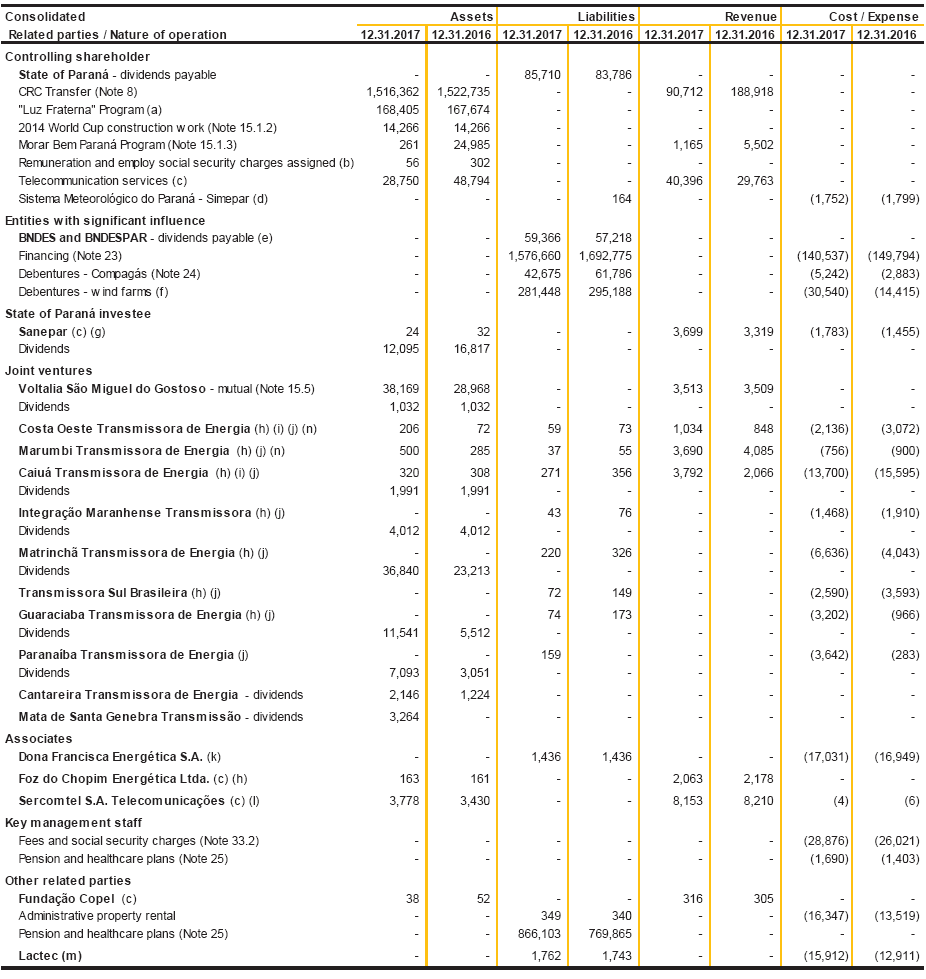
a) The Luz Fraterna Program, created under Law No. 491/ 2013 and No. 17,639/2013, allows the State Government to pay for the electricity bills of low income families in Paraná - which have duly applied for the program - provided their consumption does not exceed 120 kWh a month. This benefit is available to residential customers with single-phase connections, rural customers with single-phase connections or two-phase connections with circuit breakers of up to 50 amperes. Applicants must not have more than one electricity bill under their names and must not have any pending debts to the Company.
137

In the balance at December 31, 2017, the amount of R$115,890, recognized in the Parent Company, was settled, as described in Note 15.1. Of the remaining balance, recognized in Copel DIS, R$43,384 was settled on March 23, 2018.
b) Reimbursement of wages and social charges for employees transferred to the Paraná State Government. The balances shown are net of allowance for loan losses in the amount of R$1,193 as of December 31, 2017 (R$1,749 as of December 31, 2016).
c) Revenue of Copel TEL from telecommunications services and lease of equipment and infrastructure.
d) The Meteorological System of Paraná - Simepar is a supplementary unit of the Independent Social Service Paraná Technology, linked to the State Department of Science, Technology and Higher Education. Simepar had contracts with Copel, effective until November 6, 2017, for services of weather forecast, meteorological reports, ampacity analysis, mapping and analyses of winds and atmospheric discharges.
e) BNDES is the parent company of BNDES Participações S.A. - BNDESPAR, which has significant influence over Copel (Note 31.1).
f) BNDES and BNDESPAR acquired all the debentures issued by the subsidiaries Nova Asa Branca I, Nova Asa Branca II, Nova Asa Branca III, Nova Eurus IV and Ventos de Santo Uriel (Note 24).
g) Basic sanitation provided by Sanepar.
h) Charges for the use of the Transmission System and revenue from operating and maintenance contracts and rendering of engineering services with Copel GeT.
i) Copel DIS has transmission system connection contracts (CCT) with two companies - Costa Oeste Transmissora de Energia and Caiuá Transmissora de Energia - expiring upon the termination of the distribution or transmission concession, whichever occurs first.
j) Copel DIS maintains a Contract for the Use of Transmission System (Cust) with ONS and power transmission concessionaires whose object is the contracting of Transmission System Use Amount (Must). Contracting is permanent and is regulated by ANEEL Normative Resolution No. 666/2015. Amounts are defined for four subsequent years, with annual reviews.
k) Power purchase and sale agreement signed by Dona Francisca Energética and Copel GeT, expiring on March 31, 2025.
l) Light pole sharing agreement, signed between Sercomtel S.A. Telecomunicações and Copel DIS, expiring on December 28, 2018.
138

m) The Institute of Technology for Development (Lactec) is a Public Interest Civil Society Organization (OSCIP), in which Copel is an associated. Lactec has service and R&D contracts with Copel GeT and Copel DIS, which are subject to prior or later control and approval by ANEEL. The asset balances refer to Energy Efficiency and R&D programs, recorded under current assets, in service in progress, until the respective projects are concluded, pursuant to ANEEL.
n) Personnel cost-sharing agreement entered into with Copel and its subsidiaries.
The values resulting from operating activities of Copel DIS with related parties are billed at the rates approved by ANEEL.
37.1 Guarantees and endorsements awarded to related parties
Sureties and guarantees granted by Copel to its subsidiaries for financing and debentures are informed in Notes 23 and 24.
Copel provided financial guarantees, in the form of corporate bond, for power purchase agreements made by Copel GeT, in the total amount of R$3,645 and made by Copel Energia, in the amount of R$49,584.
Sureties and guarantees granted by Copel and Copel GeT for financing, debentures and insurance contracts of joint ventures are shown below:
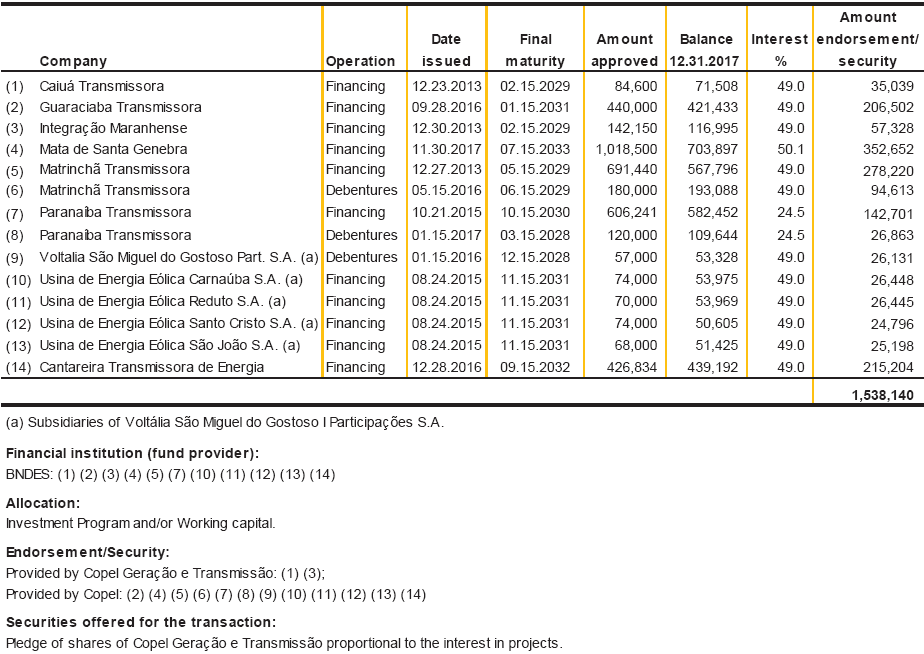
139


38 Commitments
Commitments related to long-term contracts not yet incurred, and therefore not recognized in the financial statements, are as follows:

39 Insurance
Details by risk type and effectiveness date of the main policies can be seen below.
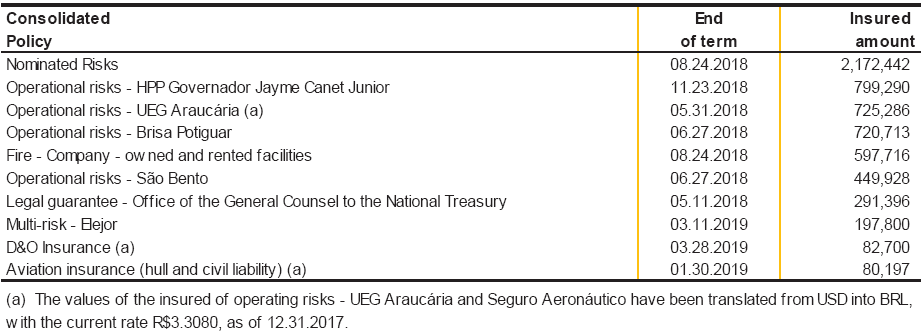
In addition to the related insurance, the Company and its subsidiaries contract other insurance policies with lower values, such as: general civil liability, payment guarantee, several risks, national and international transportation and life insurance.
140

The guarantee insurance contracted by the subsidiaries, joint ventures and associates have Copel and/or Copel GeT as guarantor, within the limits of their participation in each project.
40 Additional Information to the Statement of Cash Flows
40.1 Non-cash transactions
The balance of other temporary investments increased significantly in its movement due to the transfer from investments - jointly-controlled enterprises. Such increase arose from the accounting reclassification of Sanepar’s common shares, owned by Copel Energia, assessed at R$73,361, in accordance with NE No. 18.4.
As presented in Note 19.2, the additions to property, plant and equipment reached R$1,318,336. Of this amount, R$123,268 represent the portion of installment purchases not settled through the end of the year. Such amount also comprises R$14,122 related to capital increases paid up through projects, in special purpose entities controlled by Cutia Empreendimentos Eólicos S.A.
In turn, as mentioned in Notes 20.1, 20.3 and 20.4, the additions to intangible assets totaled R$778,386. Of this amount, R$30,312 is equivalent to the installment of term purchases and has not yet been paid until the end of the year.
The mentioned transactions did not involve cash and, for this reason, are not being presented in the statement of cash flows.
41 Subsequent Events
41.1 Cantareira Transmissora de Energia S.A.
On February 3, 2018 transmission line Estreito - Fernão Dias (500 kV) became operational one month in advance of the expected go-live. This project is owned by SPE Cantareira (49% Copel GeT).
The line, initially expected to become operational in March 2018, is 342 kilometers long and runs through the states of São Paulo and Minas Gerais, and more than 29 cities. The project will allow a further exchange of power, contributing to the operating security and reliability of the national electric system.
41.2 Debentures
On January 19, 2018 Copel completed the 7th issue of simple non-convertible unsecured debentures in a single series, for public distribution, pursuant to CVM Ruling 476/2009, in the total amount of R$600,000. The Company issued 600,000 debentures, with a par value of R$1 each, maturing within three years from the date of issue and amortization, in two annual installments - on January 15, 2020 and on January 15, 2021. The debentures will earn interest of accumulated variation of 119.0%, of daily average rates of Interbank Deposits - DI. Funds raised will be used to strengthen the issuer’s capital structure.
141

41.3 Surety provided to related parties
Copel provided surety for issue of debentures of jointly-controlled project Cantareira Transmissora de Energia on January 9, 2018. The Company issued 100,000 non-convertible debentures at a par value of R$1, in the total amount of R$100,000, with final maturity on August 15, 2032, amortization and interest in 28 bi-annual installments beginning February 15, 2019. Debentures will earn bi-annual interest corresponding to the change in IPCA, plus surtax of 6.9094% p.a. Funds raised will be used to implement the project.
41.4 UEG Araucária - Execution of gas agreement
On January 31, 2018 a fuel supply agreement was entered into by and between Petróleo Brasileiro S.A. - Petrobras and UEG Araucária Ltda. The agreement will be effective until December 31, 2018 and provides for supply of up to 2,190,000 cubic meters of natural gas a day, with no take-or-pay requirement.Therefore, UTE Araucária is again available to the National Interlinked System - SIN and can be delivered at ONS discretion. Gas will be distributed by Compagás.
41.5 Revision of physical guarantee
The Concession Grantor revised the Physical Guarantee of the following power plants through MME Ordinance 178 of May 3, 2017 with effects from January 1, 2018:

41.6 Recognition of tax credit
On February 14, 2018 the Brazilian Federal Revenue Office recognized tax credit for the restated amount of R$80,226 in favor of the Company regarding the discussion of tax levy on Pasep from July 1988 to July 1995, in connection with the effects of Federal Senate Resolution 49, of October 9, 1995, which suspended the effects of Decree-Laws 2,445/1988 and 2,449/1988, deemed to be unconstitutional by the Federal Supreme Court.
142

41.7 Promissory Notes
On May 11, 2018, Copel GeT carried out the fourth issuance of Promissory Notes, for public distribution according to CVM Instruction No. 566/2015, Law No. 6,385/1976, CVM Instruction No. 476/2009 and other legal and regulatory applicable resolutions. Were issued 100 Promissory Notes, with par value of R$6,000, in the total amount of R$600,000. and maturity at 11.11.2018. The Promissory Notes will earn interest corresponding to the accumulated variation of 114.5% of the daily average rates of the Interbank Deposits - DI. A Copel corporate guarantee was provided for this transaction. The amounts raised will be used in refinancing the debts and reinforcement of working capital of Copel GeT.
143
| Deloitte Touche Tohmatsu Rua Pasteur, 463 - 1º andar - cj. 101 e 103 e 5º andar Bairro Batel 80250-080 - Curitiba - PR Brasil |
| Tel: + 55 (41) 3312-1400 Fax:+ 55 (41) 3312-1470
www.deloitte.com.br |
INDEPENDENT AUDITOR’S REPORT
INDEPENDENT AUDITOR’S REPORT ON THE
INDIVIDUAL AND CONSOLIDATED FINANCIAL STATEMENTS
To the Board of Directors and Shareholders of
Companhia Paranaense de Energia - COPEL
Opinion
We have audited the accompanying individual and consolidated financial statements of Companhia Paranaense de Energia - COPEL (“Copel” or “Company”), identified as Parent Company and Consolidated, respectively, which comprise the balance sheet as at December 31, 2017, and the statement of profit and loss, statement of comprehensive income, statement of changes in equity and statement of cash flows for the year then ended, including a summary of significant accounting policies.
In our opinion, the individual and consolidated financial statements referred to above present fairly, in all material respects, the individual and consolidated financial position of Companhia Paranaense de Energia - COPEL as at December 31, 2017, and its individual and consolidated financial performance and its individual and consolidated cash flows for the year then ended in accordance with accounting practices adopted in Brazil and International Financial Reporting Standards (“IFRSs”) issued by the International Accounting Standards Board (“IASB”).
Basis for opinion
We conducted our audit in accordance with Brazilian and International Standards on Auditing. Our responsibilities under those standards are further described in the“Auditor’s Responsibilities for the Audit of the Individual and Consolidated Financial Statements” section of our report. We are independent of the Company and its subsidiaries in accordance with the relevant ethical requirements in the Code of Ethics for Professional Accountants and the professional standards issued by the Brazilian Federal Accounting Council (“CFC”), and we have fulfilled our other ethical responsibilities in accordance with these requirements. We believe that the audit evidence we have obtained is sufficient and appropriate to provide a basis for our opinion.
Deloitte refers to one or more entities of Deloitte Touche Tohmatsu Limited, a private limited liability company established in the United Kingdom ("DTTL"), its network of member firms, and related entities. The DTTL and each of its member firms are legally separate and independent entities. DTTL (also called "Deloitte Global") does not provide services to customers. See www.deloitte.com/about for a more detailed description of the DTTL and its member firms. Deloitte offers auditing, consulting, financial advisory services, risk management and tax consulting services to public and private clients from a wide range of industries. Deloitte serves four out of five Fortune Global 500®-listed organizations through a globally connected network of member firms in more than 150 countries, bringing global-class capabilities, visions, and high-quality services to address the most complex business challenges. To learn more about how the approximately 225,000 Deloitte professionals positively impact our customers, connect with us through Facebook, LinkedIn and Twitter. © 2018 Deloitte Touche Tohmatsu. All rights reserved. |
144

Enphasis of Matter
Restatement of the financial statements at December 31, 2017
On April 12, 2018, we issued a qualified audit report on the Company's individual and consolidated financial statements, which are being restated. As described in notes 3.1 and 4.1 to the financial statements, the financial statements at December 31, 2017 and 2016 have been amended and are being restated to reflect new accounting adjustments on investment in exclusive investment fund of the indirect subsidiary UEG Araucária Ltda. in the respective amounts of R$19,270 thousand and R$19,270 thousand as of December 31, 2017 and 2016, in addition to allocating R$103,986 thousand of the total adjustment of December 31, 2016 to the result of 2015. Our opinion has no qualification.
Key audit matters
Key audit matters are those matters that, in our professional judgment, were of most significance in our audit of the financial statements of the current period. These matters were addressed in the context of our audit of the individual and consolidated financial statements as a whole, and in forming our opinion thereon and, accordingly, we do not provide a separate opinion on these matters.
Investment in exclusive investment fund on subsidiary UEG Araucária Ltda.
As mentioned in note 4.1 to the financial statements, the Company’s management identified that the indirect subsidiary UEG Araucária Ltda. maintains funds in the Multimarket Investment Fund, which holds share units in other investment funds, which in turn holds investments in a private company whose main asset is a real estate development. Management decided to engage external consultants to conduct an independent investigation, and the Company, considering the nature of such investment, the independent reports obtained and the current stage of the investigations, concluded on the need to establish a provision for devaluation of this investment in the amount of R$156,187 thousand, in addition to the reclassification of the remaining amount of this investment to the noncurrent assets, resulting in the restatement of the financial statements, as previously described in the emphasis paragraph. We consider the issue as a key audit matter, given the materiality of the amounts involved, the complexity of the investigations and the high degree of judgment exercised by Management regarding the analysis of the economic substance, classification and valuation of that investment.
In order to respond to this key audit matter, our procedures included, among others: (a) evaluation of the design, implementation and effectiveness of the relevant internal controls on the analysis of the economic substance of that investment, its classification and its accounting measurement; (b) evaluation of the criteria used to identify and measure the value of the investment in the Índico Fund; (c) involvement of our valuation specialists to assist us in analyzing the discounted cash flow model and the assumptions and methodologies used by COPEL Management to determine the provision for investment impairment, specifically the discount rate and the sales assumptions and costs to be incurred, arising from real estate projects to be developed by UEG Araucária Ltda .; (d) test of the assumptions and judgments used by management in the development of these estimates; (e) follow-up of our forensic experts in research to assist us in evaluating the work carried out by COPEL's Administration with the assistance of independent investigators in order to assess the conditions under which such investment was made by the Índico Fund; (f) analysis of the evidence related to the estimates made by management; and (g) evaluation of whether the disclosures in the financial statements made by management are appropriate.
Based on the auditing procedures described above, we consider that the measurement and classification of the assets related to the Índico Fund, in addition to the segregation between current and noncurrent assets, carried out by the Company, as well as the respective disclosures, are adequate in the context of the financial statements taken together. It should also be noted that during the investigation process, it was identified that this investment occurred in disagreement with COPEL's investment policies, mainly regarding the monitoring ofnon-wholly-owned subsidiaries, the nature of the investment and its liquidity, consequently, significant control deficiencies were identified by us, which resulted in a change in our assessment of the nature and extent of our substantively planned procedures in order to obtain adequate and adequate audit evidence.
145

Revenue recognition
As described in notes 4.9 and 32 to the financial statements, the revenue of the Company and its subsidiaries mainly derives from the generation, transmission, distribution and sale of electricity. This matter was considered a key audit matter, given the complexity in the capture, processing and recording of transactions, the dependence on information technology systems and the respective internal controls involved in the Company’s and its subsidiaries’ revenue recognition process.
Our audit procedures to address this key audit matter included, but were not limited to: (a) assessing the design, implementation and effectiveness of the Company's and its subsidiaries' internal control activities related to Management’s process to measure the amount of revenue to be recognized in the financial statements; (b) involvement of our information technology experts to evaluate the systems and the computerized environment used for revenue recognition; (c) testing, on a sample basis, of the occurrence, completeness and accuracy of the revenues recognized by Copel and its subsidiaries, as well as whether they were accounted for in the appropriate period, based on the estimate prepared by Management, including the evaluation of unbilled revenue estimate; (d) testing, on a sample basis, of the accuracy of invoice generation; (e) testing, on a sample basis, of subsequent receipt of invoices; and (f) evaluation if the disclosures made by Management in the financial statements are appropriate. As a result of these procedures, deficiencies in internal control related to the approval processes of certain manual entries were identified, which have changed our assessment regarding the nature, timing and extent of our initially planned substantive procedures in order to obtain sufficient appropriate audit evidences related to sales revenue.
Based on the audit procedures described above, we consider that the capture, processing, recording and related disclosures on the Company’s and its subsidiaries’ revenue recognition are appropriate in the context of the financial statements taken as a whole.
Provision for impairment of property, plant and equipment
As disclosed in notes 4.7 and 19.9, the Company and its subsidiaries annually carry out an analysis of impairment indicators and, if necessary, carry out measurements of the recoverable amount, in order to conclude on the need for a provision for impairment of property, plant and equipment. This matter was considered as a key audit matter due to the high degree of judgment used by Management to measure the provision for impairment, which requires the use of technical knowledge and the history of the operations of the Company and its subsidiaries, and the performance of projections of future results, in order to measure the value in use of such assets.
Our audit procedures to address this key audit matter included, but were not limited to: (a) assessing the design, implementation and effectiveness of the relevant internal controls over the asset impairment analysis; (b) evaluation of the criteria used to identify and measure the recoverable amount of the cash-generating units of the Company and its subsidiaries; (c) involvement of our financial valuation experts to assist us in assessing the adequacy of the model used by Management to measure the recovery of assets (discounted cash flow), specifically with reference to the discount rate and adequacy of the valuation model; (d) assessment of the key business assumptions used in the discounted cash flow model, more specifically those related to projected revenue, estimated costs and costs for completion of projects still under construction; and (e) assessment whether the disclosures made by Management in the financial statements are appropriate. As a result of these procedures, deficiencies in internal control related to the approval processes of certain manual entries were identified, which have changed our assessment regarding the nature, timing and extent of ourinitially planned substantive procedures in order to obtain sufficient appropriate audit evidence related to the provision for impairment.
146

Based on the audit procedures described above, we consider that the measurement of the provision for impairment of property, plant and equipment made by Management, as well as the related disclosures, are appropriate in the context of the financial statements taken as a whole.
Provision for tax, civil, labor and environmental risks
As disclosed in notes 4.8 and 30, the Company and its subsidiaries are defendants in a number of lawsuits related to civil, tax, labor and environmental matters. This matter was considered a key audit matter because of the high judgment necessary to determine loss estimates, to measure the provision for losses and to prepare the necessary disclosures for the financial statements, requiring the use of technical and historical knowledge of the Company and its subsidiaries and the analysis of applicable and individualized jurisprudence of lawsuits by Management.
Our audit procedures to address this key audit matter included, but were not limited to: (a) assessing the design, implementation and effectiveness of relevant internal controls over contingencies, specifically in determining the likelihood of loss and measuring the provision for risks; (b) testing, with the assistance of our IT experts, the IT controls and systems used by Management and its outside legal counsel to control and assess the existing risks; (c) testing the completeness and accuracy of the database used by Management to determine the likelihood of loss and measure the provision for risks; (d) independent confirmation with the outside legal counsel and lawyers handling the cases regarding the classification of the likelihood of loss for the Company and its subsidiaries, including the amount involved; (e) evaluation of the assumptions and judgments used by Management in the development of these estimates, including the analysis of contradictory evidence; and (f) evaluation of whether the disclosures made by Management in the financial statements are appropriate. As a result of the performance of these procedures, deficiencies in internal control related to the processes of identification of the judicial risks related to civil, fiscal, labor and environmental discussions were identified which changed our evaluation regarding the nature, timing and extent of our initially planned substantive procedures, in order to obtain sufficient appropriate audit evidence regarding the provision for risks.
Based on the audit procedures described above, we believe that the provision for risks set up by Management, as well as the related disclosures, are appropriate in the context of the financial statements taken as a whole.
Companhia Paranaense de Gás - Compagas: term of concession and other relevant transactions
As described in notes 2.1 and 12.2 to the financial statements, Companhia Paranaense de Gas - Compagás (“Compagas”), controlled by Copel, has a concession to operate the public services of piped gas distribution in the State of Paraná. This was considered a key audit matter because of the high degree of judgment necessary to determine the impacts arising from the Complementary Law of the State of Paraná No. 205, published on December 7, 2017, bringing a new interpretation regarding the expiration of the concession, which will occur on January 20, 2019. Previously, considering that the subsidiary has a concession agreement signed with the Granting Authority, which determines July 6, 2024 as the date for the expiration of the concession term, Compagas considered that date for the evaluation of balances related to infrastructure assets and contracts related to the concession agreement in the financial statements. The publication of this Complementary Law generated an impact on several accounting records of the subsidiary Compagás, mainly in the accounts of concession financial assets, intangible assets and credits in gas purchase and sale operations, and consequently impacted Copel's individual and consolidated financial statements.
147

This matter was considered of significance for our audit, due to the high degree of judgment and complexity in the determination of factors and assumptions by Management, linked to the process of measuring the concession financial assets, intangible assets and credits in operations of purchase and sale of gas, as well as the materiality of the amounts involved.
Our audit procedures to address this key audit matter included, but were not limited to: (a) assessing the design, implementation and effectiveness of Copel and Compagas' internal control activities related to the calculation of concession financial asset, intangible assets and credits in purchase and sale of gas; (b) test of the assumptions used in the calculation of the concession financial asset prepared by the Company's management; (c) obtaining calculation spreadsheets prepared by the Company's management to compare with the records made in the accounting system, with the appropriate classification of the concession financial asset (trade receivables) and intangible assets and segregation between current and non-current assets; (d) testing of the recalculation, made by the Company's management, of the concession financial assets, intangible assets and credits in the gas purchase and sale operations considering the end of the concession in 2019; and (e) evaluation of whether the disclosures in the financial statements made by Management are appropriate.
Based on the audit procedures described above, we consider that the measurement of concession financial asset, intangible assets and credits in purchase and sale of gas, as well as the segregation between concession financial assets and intangible asset and segregation between current assets and noncurrent assets, carried out by Compagas’ management, as well as the related disclosures, are appropriate in the context of Copel's financial statements taken as a whole.
Other matters
Restatement of the corresponding amounts - January 1, 2016
The examination of the individual and consolidated balance sheet, as of January 1, 2016 (derived from the financial statements for the year ended December 31, 2015), restated as a result of the matters described in note 4.1.1, was conducted under the responsibility of other independent auditors, who issued an audit report with no qualifications dated May 14, 2018.
Statements of value added
The individual and consolidated statements of value added for the year ended December 31, 2017, prepared under the responsibility of the Company's management and presented as supplementary information for IFRS purposes, were submitted to audit procedures performed in conjunction with the audit of the Company's financial statements. For the purposes of forming our opinion, we evaluated whether these statements are reconciled with the financial statements and accounting records, as applicable, and if their form and content are in accordance with the criteria defined in technical pronouncement CPC 09 - Statement of Value Added. In our opinion, except for the possible effect of the matter described in the“Basis for Qualified Opinion”section of our report, these statements of value added have been properly prepared, in all material respects, according to the criteria set forth in this technical pronouncement and are consistent with individual and consolidated financial statements taken as a whole.
Other information accompanying the individual and consolidated financial statements and the independent auditor’s report
Management is responsible for such other information, which comprises the Management Report.
Our opinion on the individual and consolidated financial statements does not cover the Management Report and we do not express any form of audit conclusion thereon.
148

In connection with the audit of the individual and consolidated financial statements, our responsibility is to read the Management Report and, in so doing, consider whether it is materially inconsistent with the financial statements or with our knowledge obtained in the audit or otherwise appears to be materially misstated.
If, based on the work we have performed, we conclude that there is a material misstatement of the Management Report, we are required to report that fact. We have nothing to report on this subject.
Responsibilities of management and those charged with governance for the individual and consolidated financial statements
Management is responsible for the preparation and fair presentation of the individual and consolidated financial statements in accordance with accounting practices adopted in Brazil and the International Financial Reporting Standards (IFRS), issued by the International Accounting Standards Board (“IASB”), and for such internal control as Management determines is necessary to enable the preparation of financial statements that are free from material misstatement, whether due to fraud or error.
In preparing the individual and consolidated financial statements, Management is responsible for assessing the Company’s ability to continue as a going concern, disclosing, as applicable, matters related to going concern and using the going concern basis of accounting unless Management either intends to liquidate the Company and its subsidiaries or to cease operations, or has no realistic alternative but to do so.
Those responsible with governance are responsible for overseeing the Company’s and its subsidiaries’ financial reporting process.
Auditor’s responsibilities for the audit of the individual and consolidated financial statements
Our objectives are to obtain reasonable assurance about whether the individual and consolidated financial statements as a whole are free from material misstatement, whether due to fraud or error, and to issue an auditor’s report that includes our opinion. Reasonable assurance is a high level of assurance, but is not a guarantee that an audit conducted in accordance with Brazilian and International Standards on Auditing will always detect a material misstatement when it exists. Misstatements can arise from fraud or error and are considered material if, individually or in the aggregate, they could reasonably be expected to influence the economic decisions of users taken on the basis of these financial statements.
As part of an audit in accordance with Brazilian and International Standards on Auditing, we exercise professional judgment and maintain professional skepticism throughout the audit. We also:
• Identify and assess the risks of material misstatement of the individual and consolidated financial statements, whether due to fraud or error, design and perform audit procedures responsive to those risks, and obtain audit evidence that is sufficient and appropriate to provide a basis for our opinion. The risk of not detecting a material misstatement resulting from fraud is higher than for one resulting from error, as fraud may involve collusion, forgery, intentional omissions, misrepresentations, or the override of internal control.
• Obtain an understanding of internal control relevant to the audit in order to design audit procedures that are appropriate in the circumstances, but not for the purpose of expressing an opinion on the effectiveness of the internal control of the Company and its subsidiaries.
149

•
• Evaluate the appropriateness of accounting policies used and the reasonableness of accounting estimates and related disclosures made by Management.
• Conclude on the appropriateness of Management's use of the going concern basis of accounting and, based on the audit evidence obtained, whether a material uncertainty exists related to events or conditions that may cast significant doubt on the ability of the Company and its subsidiaries to continue as a going concern. If we conclude that a material uncertainty exists, we are required to draw attention in our auditor’s report to the related disclosures in the individual and consolidated financial statements or, if such disclosures are inadequate, to modify our opinion. Our conclusions are based on the audit evidence obtained up to the date of our auditor’s report. However, future events or conditions may cause the Company and its subsidiaries to cease to continue as a going concern.
• Evaluate the overall presentation, structure and content of the individual and consolidated financial statements, including the disclosures, and whether the individual and consolidated financial statements represent the underlying transactions and events in a manner that achieves fair presentation.
• Obtain sufficient appropriate audit evidence regarding the financial information of the entities or business activities within the Group to express an opinion on the consolidated financial statements. We are responsible for the direction, supervision and performance of the group audit and, consequently, for the audit opinion.
We communicate with those charged with governance regarding, among other matters, the planned scope and timing of the audit and significant audit findings, including any significant deficiencies in internal control that we identify during our audit.
We also provide to those charged with governance a statement that we have complied with the relevant ethical requirements, including independence requirements, and communicate all relationships or matters that could considerably affect our independence, including, when applicable, the related safeguards.
From the matters communicated with those charged with governance, we determine those matters that were of most significance in the audit of the financial statements of the current year and are therefore the key audit matters. We describe these matters in our auditor’s report unless law or regulation precludes public disclosure about the matter or when, in extremely rare circumstances, we determine that a matter should not be communicated in our report because the adverse consequences of doing so would reasonably be expected to outweigh the public interest benefits of such communication.
Curitiba, May 14, 2018
DELOITTE TOUCHE TOHMATSU Auditores Independentes | Fernando de Souza Leite Engagement Partner |
150

SUMMARY OF THE STATUTORY AUDIT COMMITTEE’S ANNUAL REPORT
2017
Introduction
The Statutory Audit Committee - CAE of Companhia Paranaense de Energia - Copel, on June 30, 2017, was composed of three members, Board Members, independent under the Sarbanes-Oxley Act.
At the 168th Annual Meeting of the Board of Directors - CAD, on July 13, 2017, five members for this Committee were elected under the terms of the Bylaws.
With the resignation, on August 25, 2017, of Mr. Luiz Henrique Tessuti Dividino of the position of member of the CAE, the Committee now has four members.
At the 174th Annual Meeting of the CAD, on January 23, 2018, Mr. Marco Antônio Barbosa Cândido was elected to the Statutory Audit Committee of Copel, and this Collegiate has five members, who sign the agreement.
The CAE reports to the Board of Directors, to which it is directly linked, and has its characteristics, composition, functioning and competencies established in specific Internal Regulations.
The CAE met twenty times in 2017, three of them jointly with the Supervisory Board, to analyze the Company's financial statements, with the presence of the Independent Audit and Internal Audit to address matters within its scope of action and analysis of others of its competence.
The Independent Auditors, currently Deloitte Touche Tohmatsu Auditores Independentes - Deloitte, are responsible for auditing the financial statements and must ensure that they adequately present the Company's equity and financial position, in accordance with accounting practices adopted in Brazil, the rules of the Brazilian Securities and Exchange Commission (CVM), already adapted to international accounting standards, and the rules issued by the National Electric Energy Agency - ANEEL and the National Telecommunications Agency - Anatel.
In the exercise of the regulatory activities of the Statutory Audit Committee, among others, the following stand out:
a) Monitoring of the Confidential Communication Channel;b) Follow-up of Internal Audit activities and verification of their recommendations;c) Establishment of procedures for the performance of the Statutory Audit Committee;d) Analysis of the process of hiring an independent consulting firm to provide services;e) Engagement of other services that may be provided by independent auditing firms that are auditing the Company's financial and accounting statements;f) Approval of the work plan of the Internal Audit 2017/2018;g) Transfer of operation and management of the Confidential Communication Channel to the Board of Governance, Risk and Compliance - DRC;h) Analysis of significant matters addressed by the Independent Audit, Deloitte;i) Presentation of preliminary information on the annual financial statements - financial year 2016;j) Analysis of presentation on Cybersecurity;k) Analysis and deliberation on the 2016 Annual Management Report, Balance Sheet and other Financial Statements for the year 2016;l) Analysis of the proposal of the Board of Executive Officers for the allocation of the profit for the year 2016 and for payment of the participation related to the integration between capital and labor and incentive to productivity;m) Analysis and approval of the annual report of the Statutory Audit Committee - 2016;n) Deliberation on Purchase and Sale agreements between Related Parties Copel Comercialização S.A. and Copel Geração e Transmissão S.A .;o) Approval of the Policy on Transactions with Related Parties and Conflicts of Interest;p) Copel's participation in the Transmission Auction 05/2016-ANEEL; q) Analysis of the Report on Internal Controls of the Independent Audit, Deloitte;r) Approval for the execution of loan agreements between Copel (Holding) and Specific Purpose Entities (SPEs) of the Cutia Wind Complex;s) Preliminary Analysis of Report 20-F - 2016;t) Review of accounting policies, practices and principles used by Copel in the preparation of the accounting and financial statements;u) Review of alternative methods of accounting treatment, related to accounting and financial information;v) Definition of the new dynamics of evaluation and monitoring of the Company's risk exposure;w) Approval of the Report 20-F-2016;x) Updating of the Integrated Corporate Risk Management Policy - NPC 0104;y) Review of the Interim Financial Statements - ITR 2nd quarter of 2017;z) Analysis of information on the form of taxation of sectoral assets and liabilities;aa) Analysis and approval of the Report on Activities of the Statutory Audit Committee - 1st half of 2017;bb) Definition on the form of taxation of sectoral assets and liabilities -Offsetting and Variation of Tranche A account - CVA,and possibility of joining the Special Tax Regularization Program - PERT;cc) Analysis of information of Independent Audit Deloitte on the schedule and work plan for the third quarter of 2017;dd) Analysis of the Copel Foundation's presentation on the pension plans sponsored by Copel;ee) Analysis of the presentation on the Incentivized Termination Program (PDI) in force at the Company;ff) Approval of the Corporate Risk Integrated Management Policy;gg) Follow-up of the Corporate Integrity Coordination Work - CIC - Corporate Risk Management;hh) Authorization to conclude fuel supply contracts for UEG Araucária Ltda. - UEGA until December, 31, 2018;ii) Follow-up of the work related to the review of the Financial Statements - ITR 3rd Quarter / 2017;jj) Analysis of presentation on Internal Audit notes on the topic "Legal" and manifestation on the subject by the Legal and Institutional Relations Department;kk) Analysis of presentation on Internal Audit notes on the topic "delays in construction" and manifestation on the subject by Copel Geração e Transmissão S.A .;ll) Analysis of the report on the financial investments of UEG Araucária Ltda. - UEGA;mm) Provision of a real guarantee under the financing agreement to be signed between the National Bank for Economic and Social Development - BNDES and SPE Mata de Santa Genebra Transmission S.A .;nn) Deliberation on contractual addendum of gas supply concluded between UEG Araucária Ltda. - UEGA and Petróleo do Brasil S.A. - Petrobras;oo) Authorization for contracting of public offer with restricted efforts of corporate promissory notes by UEG Araucária Ltda. - UEGA;pp) Review of the Interim Financial Statements - ITR 3rd quarter of 2017;qq) Approval of the calendar of meetings of the Statutory Audit Committee in 2018; andrr) Analysis of the presentation of the criteria for classifying contingencies and information regarding the Company's provisions and the actions being taken to improve legal proceedings.
151

During 2017, the Statutory Audit Committee evaluated, together with the Corporate Integrity Coordination - CIC and the Internal Audit - AUD, with the support of the Independent Audit, Deloitte, the systems of internal controls and risk management, with the objective of ensuring its effectiveness and the quality of the reporting processes that are used by management to support its decisions.
In the analysis of the Committee, the form and actions adopted to monitor these systems at Copel (Holding) and its subsidiaries, in their relevant aspects, are well established and adequately directed, and no relevant exceptions have been detected that could impact them. However, this Committee recommended, with respect to affiliates and / or subsidiaries, that the monitoring of those companies be expanded and that control systems consistent with those of Copel (Holding) be strengthened.
The CAE has accompanied the suggested observations and recommendations on the Company's internal controls pointed out by the auditing firm Deloitte Touche Tohmatsu Auditores Independentes in its comment letter through periodic reports of CIC and AUD to this Collegiate.
The Statutory Audit Committee transmitted to the Board of Executive Officers and to the Board of Directors, through periodic reports, the decisions made at a meeting through the Electronic resolutions sent to the areas responsible for the actions to be taken, which emphasize the improvement of certain internal controls and the risk management of the Company, as well as follow-up of the actions arising from the work of the Internal Audit.
The Statutory Audit Committee related in 2017 to the independent auditing firm Deloitte Touche Tohmatsu Auditores Independentes, emphasizing the considerations about the results of its work and its opinions regarding the financial statements and financial reports.
Based on these exams and the information provided by Deloitte, the Committee attests to the objectivity and independence of the Independent Auditors, since it did not identify situations that could affect them. It also positively evaluates the structure of the Company's Internal Audit as well as the quality of its technical and managerial staff and the results presented by its work.
152

In 2017, meetings were held with the Supervisory Board and also with the Independent Auditors, with the purpose of discussing the aspects considered relevant in the preparation of the accounting and financial statements for the closing of the fiscal year in question.
During the preparation of the Quarterly Information for the period ended September 30, 2010, the CAE became aware of the facts duly recorded in detail in Note 4.1.1, which is an integral part of the financial statements for the closing of the fiscal year 2017. Due to this fact, the CAE recommended to the Board of Directors the hiring of a specialized company to investigate the event, which was approved by that Collegiate.
It also participated in the discussions with the Board of Executive Officers and independent auditors at which time it was concluded that adjustments to the Financial Statements of prior years were required, also duly reported in the above mentioned explanatory note and in the Independent Auditor's Report.
During the year under review and within our competencies, we are not aware of other occurrences, in particular, noncompliance with regulations, absence of controls, fraud, act or omission on the part of Management that could pose risks to Copel's business or affect the credibility of its accounting and financial stements.
This Committee also examined the Quarterly Information (ITR) (parent company and consolidated) for the fiscal year 2017 and, according to the information and clarifications provided, considered that the financial statements, in their relevant aspects, were duly presented.
It should be noted that a copy of the suporting documentation of the matters resolved by the Statutory Audit Committee during 2017, described in this report on the activities of this Collegiate, is filed electronically at Copel's SEC Secretariat of Corporate Governance and remains available for consultation.
Curitiba, April 12, 2018
/s/ Mauricio Schulman Chairman | /s/ Olga Stankevicius Colpo |
/s/ Leila Abraham Loria | /s/ Rogério Perna |
/s/ Marco Antônio Barbosa Cândido | |
153

SUPERVISORY BOARD’S OPINION ON THE RESTATED ANNUAL MANAGEMENT REPORT
FOR THE YEAR 2017 AND THE RESTATED FINANCIAL STATEMENTS FOR THE YEARS 2017, 2016 AND 2015 AND ON THE OFFICERS’ PROPOSAL FOR ALLOCATION OF THE PROFIT FOR 2017
The undersigned members of the Supervisory Board of Companhia Paranaense de Energia - Copel, within their legal and statutory duties and responsibilities, have examined the Restated Annual Management Report for the year 2017 and the Financial Statements for the years 2017, 2016 and 2015, which comprise the balance sheet and the respective statements of income, comprehensive income, changes in equity and cash flows, as well as the related explanatory notes and the Officers’ Proposal for Allocation of the Profit for 2017. The minutes were received and analyzed individually by the Directors and discussed previously with management and independent auditor. Based on the work performed during the year, the analyses carried out, in the accompaining of the discussions on internal controls and their impact on the financial statements, in the clarifications provided by Management and the Independent Auditors, and also considering the Report of the Auditor Deloitte Touche Tohmatsu Auditores Independentes on the Restated Individual and Consolidated Financial Statements for the years 2017 and 2016, issued with no qualifications, as well as the Report of the Auditor KPMG Auditores Independentes on the Restated Individual and Consolidated Financial Statements for the year 2015, issued with no qualifications, the board members state that they were not aware of any fact or evidence that is not reflected in the referred Financial Statements in accordance with Brazilian stantards and that said statements are in a position to be referred to the General Shareholders' Meeting resolution.
Curitiba, May 14, 2018
/s/
GILMAR MENDES LOURENÇO | /s/
LETÍCIA PEDERCINI ISSA MAIA |
/s/
MAURO RICARDO MACHADO COSTA | /s/
ROBERTO LAMB |
154

CAPITAL BUDGET PROPOSAL
In conformity with CVM Instruction 480/2009, in effect since January 1, 2010, below we present the capital budget proposal for 2018, approved at the 173rd annual meeting of the Board of Directors of Companhia Paranaense de Energia, held on December 13, 2017, as well as the origin of the funds.
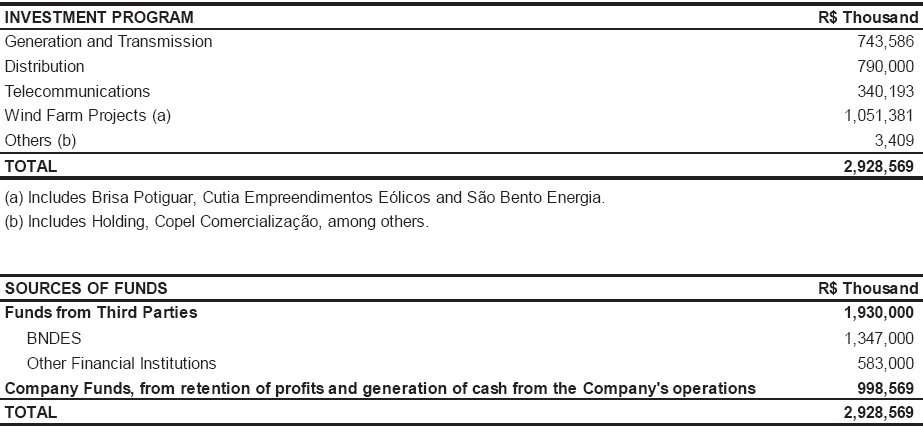
155

STATEMENT
By this document, the Chief Executive Officer and the other directors of Companhia Paranaense de Energia - COPEL, mixed capital corporation, with registered office at Rua Coronel Dulcídio nº 800, Curitiba - PR, enrolled in the National Registry of Legal Entities (CNPJ / MF No. 76.483.817/0001-20) for the purpose of the provisions in items V and VI of article 25 of CVM Instruction 480/2009, state that:
(I) they have reviewed and discussed and agree with the opinions expressed in the audit report of Deloitte Touche Tohmatsu Auditores Independentes related to the financial statements of Copel for the year ended December 31, 2017, restated in May 14, 2018; and
(II) they have reviewed and discussed and agree with the financial statements of Copel for the year ended December 31, 2017, restated in May 14, 2018.
Curitiba, May 14, 2018
/s/
Jonel Nazareno Iurk
Chief Executive Officer
/s/
Adriano Rudek de Moura
Chief Financial and Investor Relations Officer
/s/
Harry Françóia Júnior
Chief Legal and Institutional Relations Officer
/s/
José Marques Filho
Chief Business Development Officer
/s/
Vicente Loiácono Neto
Chief Governance, Risk and Compliance Officer
156


























































































